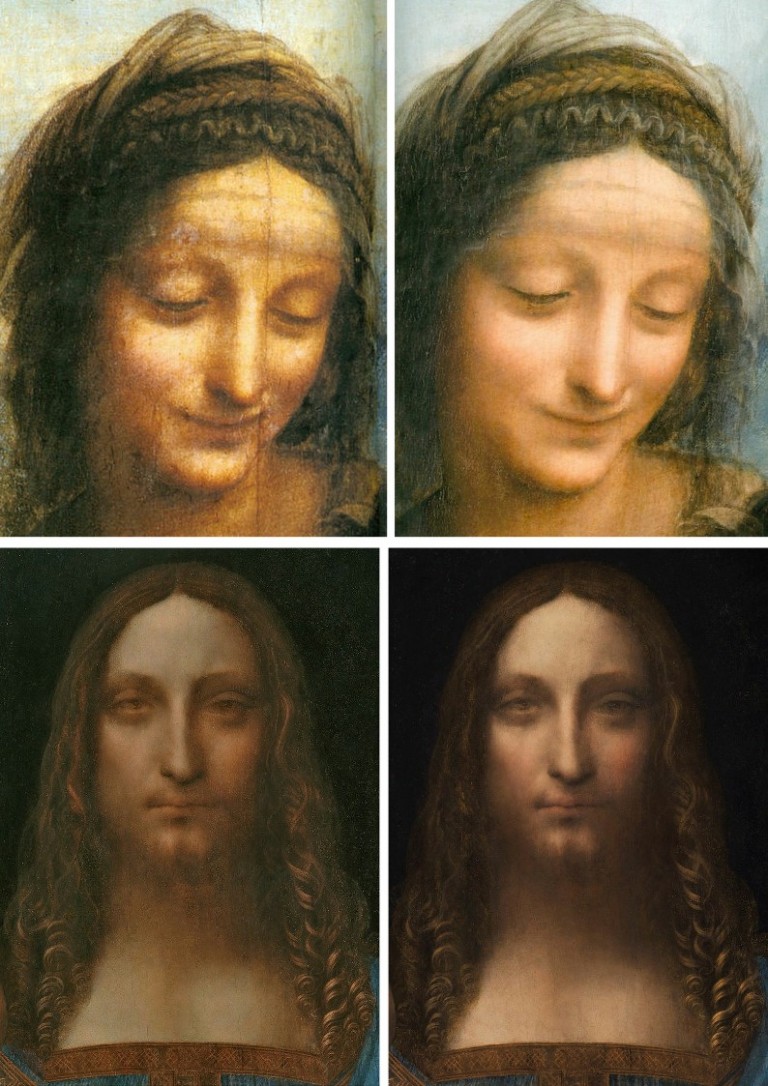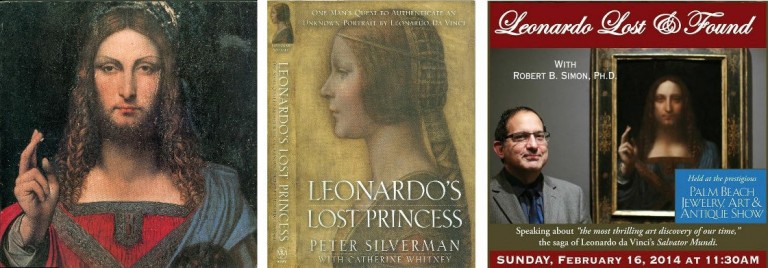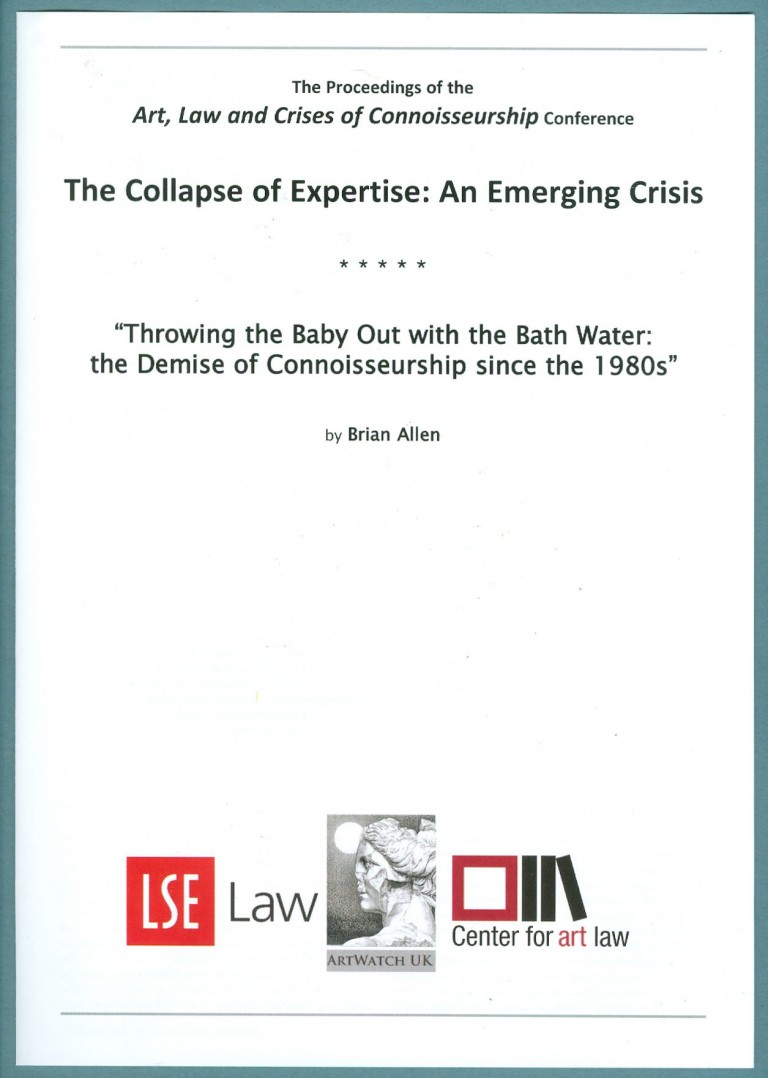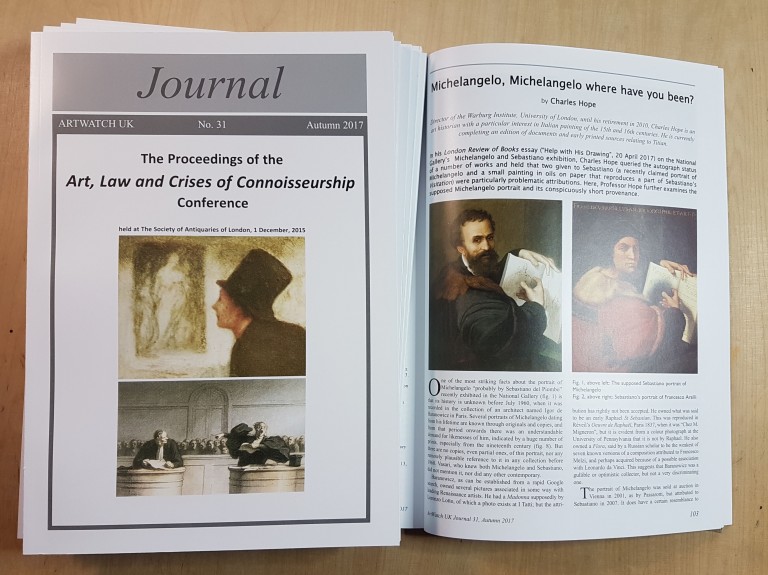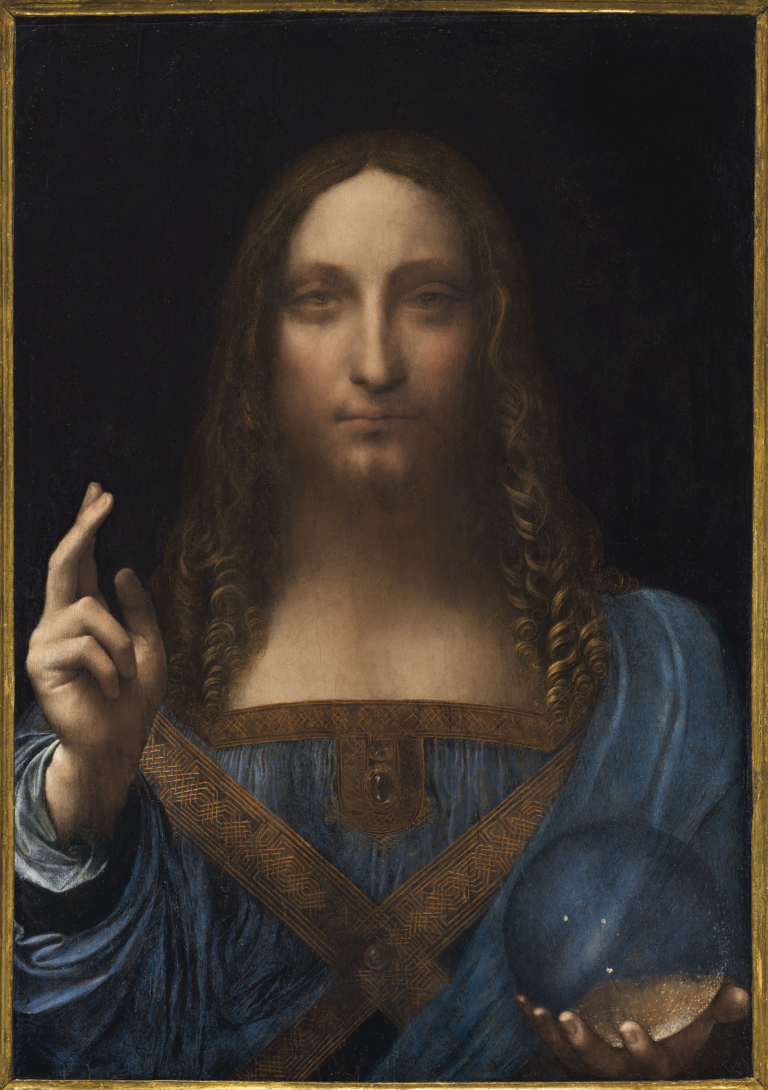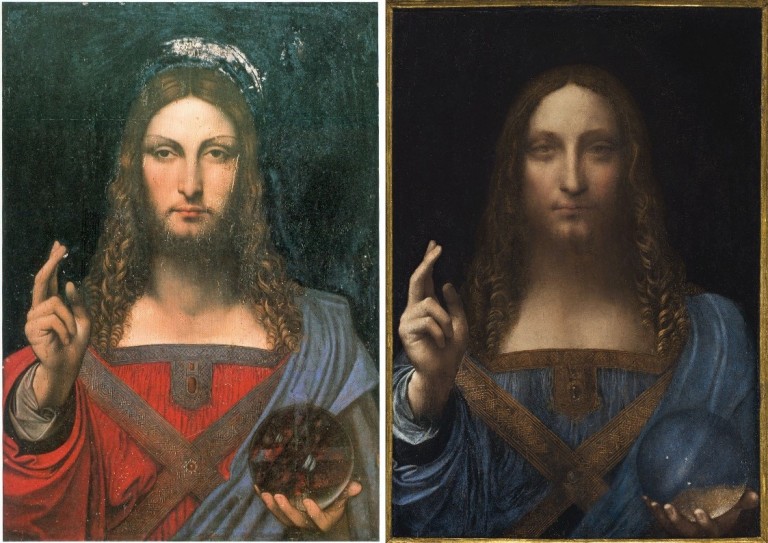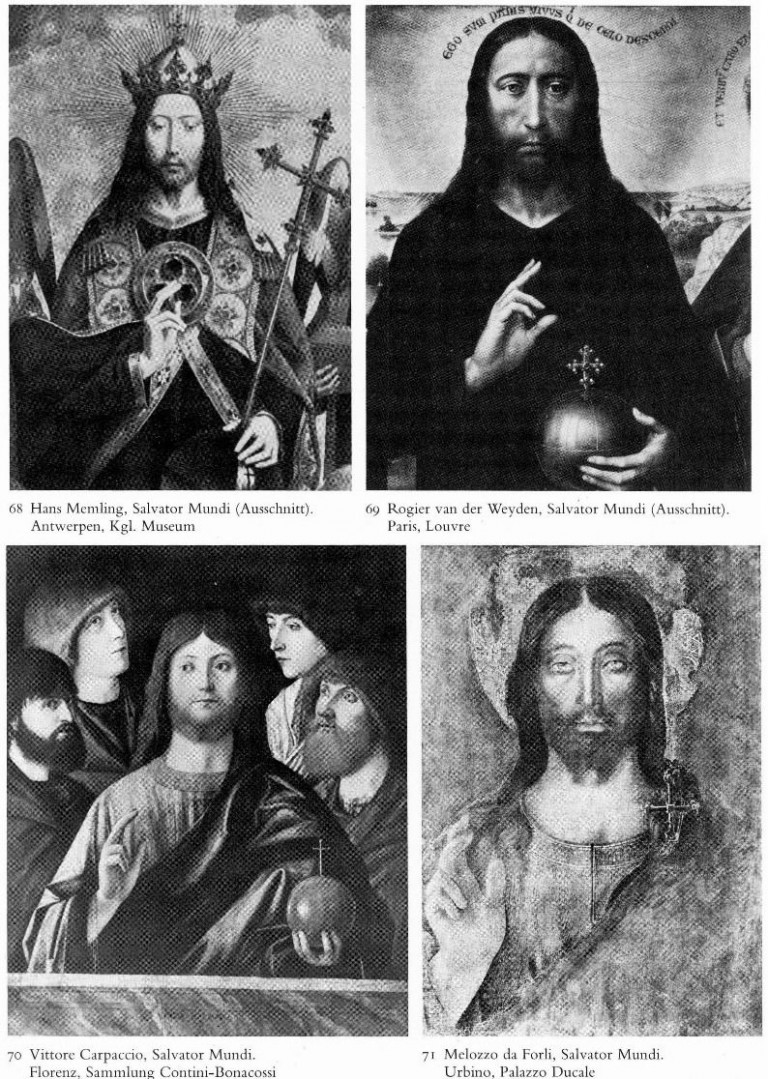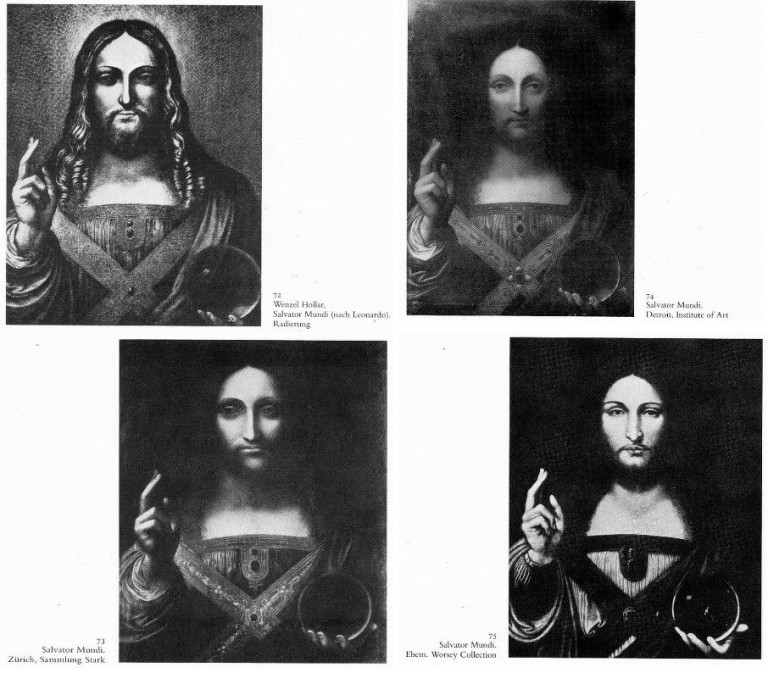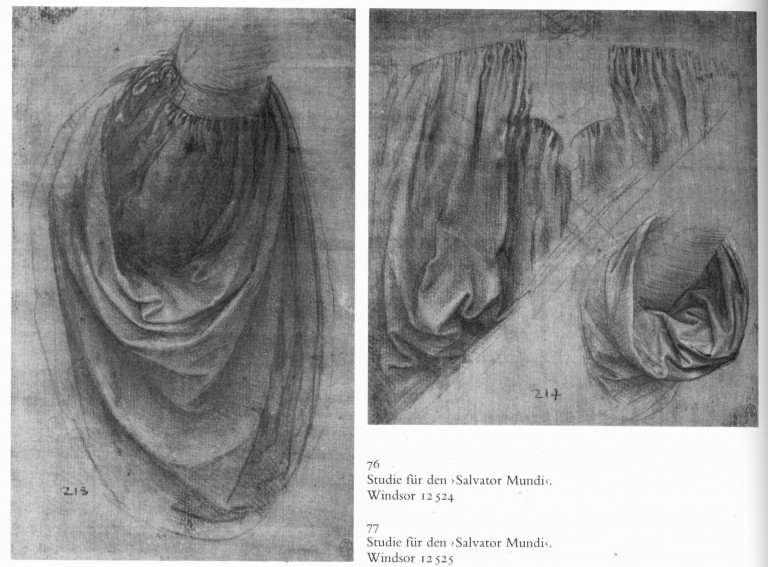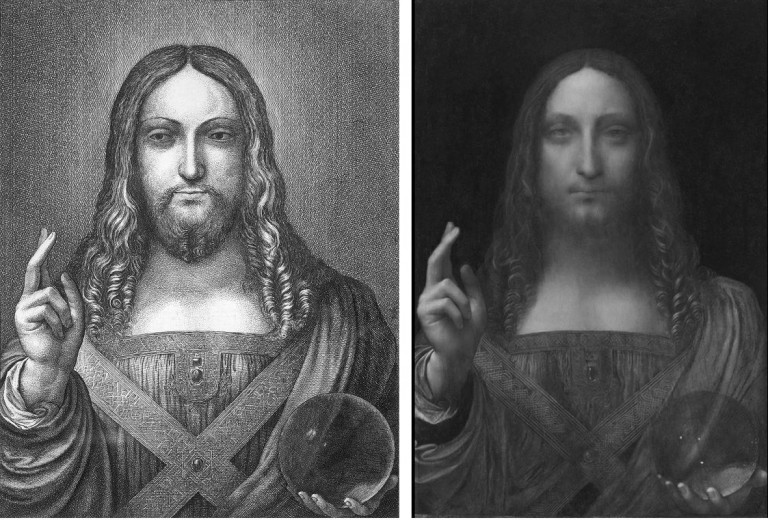Exhibition: Sargy Mann, Late Paintings
A most remarkable exhibition is running until March 10th at the Royal Drawing School (19–22 Charlotte Road, London EC2A 3SG).
Can a blind man paint? We would not ask if a blind man could think or feel. Sargy Mann saw, felt and thought when sighted. In a sighted painter, thinking and feeling are intensified by habit, by professional engagement and by sheer practice. By the concentrated act of painting, thoughts and feelings are imprinted, stored and collated in the mind and thereby provide templates and springboards for further artistic skirmishes. Mann showed through failing and eventual complete loss of sight that art is driven by minds; that powers honed through a lifetime’s practice are primarily imaginative, conceptual and, by no means, exclusively sight-dependent; that even a catastrophic loss of visual powers cannot thwart artistic will; that an artist’s mind is supreme.
Sargy Mann (1937-2015) continued painting for the last ten years of his life after becoming completely blind. We know that an artist can draw with his eyes shut; can draw unseen objects from memory; can draw non-existent imagined objects. Rodin made drawings without taking his eyes off moving figures so as to fix their transient, momentary essentials by a felt but, at the moment of execution, unobserved drawing. A newspaper illustrator once had to make drawings of actors in character during opening-night performances. Because being seen drawing would have constituted an offensive distraction, he carried a short pencil and a small sketchbook in a jacket pocket and drew, hand-in-pocket, as he looked, recording and fixing features in his mind’s eye. Afterwards, he was able to produce finished caricatures for publication from his un-seen but physically recorded observations and notations. We know, of course, that composers can write music when deaf. We have long known that artists have adapted variously to declining levels of sightedness. As Degas lost sight he turned from the depiction of figures to plastic realisations of them – but, then, he had also once claimed that he would have preferred to make his fabulous dancer drawings in monochrome and had only added pastel colours to encourage their sales.
This exhibition of a blind man’s late paintings testifies to a remarkable artist and artistic intelligence no less than to a tenacious and courageous spirit. Mann’s works, writings and lectures can be seen in an excellent dedicated archive but, if at all possible, this handsome sensitively arranged exhibition should not be missed. In it, the viewer can stand before the often large canvases and in, as it were, the very space which Mann had occupied when painting his spatially and pictorially arranged figures as if seen from nature when in fact deduced from tactile/spatial awareness and recollected experiences. It must have been the case that Mann was proceeding in many respects as before when sighted – certainly, there had always been a strong “mapping” organising and orchestrating imperative in Mann’s painting as well as his highly attuned receptivity to light-generated colours and surfaces, as can be seen in figs. 2 and 3 below.
One might have imagined that with the complete loss of sight, engagement with the transient, perpetually shifting consequences and effects of light would, of necessity, have atrophied. Not so. With Mann, in a most unprecedented and unexpected development, as the figures became more classically affirmative, self-contained and monumental, so too, the colour chords intensified to a remarkable vibrancy and forcefulness as seen below at Figs. 4 and 5. This is not an exhibition to miss but it does close on the tenth of this month.
CODA
Sargy Mann (above) was an early and long-supportive member of ArtWatch. His exceptionally acute art critical intelligence and conceptual adroitness was well in evidence when, in 2000 with already failing sight, he produced the cautionary essay below on the shoals and perils of restoring drawings:
Michael Daley, Director, 7 March 2019
The Louvre Museum’s bizarre charge of “fake information” on the $450 million Salvator Mundi
The Louvre Museum in Paris has attacked one of its own named Leonardo restoration consultants – Jacques Franck – with professional disparagement and an allegation of having conveyed “fake information”.
Above, Fig. 1: Left, the Louvre Abu Dhabi Salvator Mundi as when taken in 2005 (still sticky from a recent treatment) to the New York studio of the restorer Dianne Dwyer Modestini; right, as when taken in 2008 by one of the consortium of owners, Robert Simon, to the National Gallery in London for a covert viewing by a small group of Leonardo specialists.
Above, Fig 2: Left, the Louvre Abu Dhabi Salvator Mundi as exhibited in the National Gallery’s 2011-12 exhibition Leonardo da Vinci – Painter at the Court of Milan; right, as seen at the end of Modestini’s restoration programmes in 2017 at Christie’s, New York.
Whenever vicious personal attacks are made by institutions on experts, two things should always be considered: what, precisely, is being said; and, what has been left unsaid. The Louvre’s Trumpian “Fake information” slur on Franck was made by its press officers in response to a report by Dalya Alberge in the Sunday Telegraph (“Paris Louvre ‘will not show’ world’s most expensive painting amid doubts over authenticity”) that the Leonardo painting technique specialist, Jacques Franck, has been told by high level politicians that the Louvre Abu Dhabi Salvator Mundi will not be included in the Paris Louvre’s forthcoming Leonardo exhibition and that Louvre staff “know that the Salvator Mundi is not a Leonardo”.
Jacques Franck’s role as advisor to the Louvre’s Leonardo restorations
In attempts to defuse and refute Franck’s (honest) testimony, the museum’s press officers have also scattered red herrings and sown misinformation. To the Mailonline (“Is the world’s most expensive painting a FAKE?”) they claimed that:
“M. Franck was part of the scholars who have been consulted 7 or 8 years ago for the restoration of the Saint Ann.
“He is not currently working on the Leonardo da Vinci exhibition and has never been curator for the Louvre.
“His opinion is his personal opinion, not the one of the Louvre.”
It should go without saying that when called by the Louvre to give technical advice, Franck’s expert views are his own and not those of the museum – why else would he be being called in? No one had claimed that Franck is a Louvre curator. No one had claimed he is working on the Louvre’s forthcoming Leonardo exhibition. So, contrary to appearances, nothing was being refuted. However, on the extent and frequency of his contributions, it would seem that the Louvre’s officials have misinformed the museum’s spokeswomen who have in consequence scattered seriously misleading accounts around the press.
Contrary to their claims to the press, Franck’s association with the Louvre had not ended in 2011-12 after the controversial restoration of Leonardo’s the “Virgin and Child with St Anne” – see Endnote 2 and Figs. 8, 9 and 10. In 2014 his advice was sought by the Louvre when it planned to restore Leonardo’s portrait of the Belle Ferronnière (see Figs. 3 and 4 below). Vincent Pomarède was the Head of Paintings at the time, he had launched the project but before the restoration began he was appointed principal Assistant to the Louvre Museum’s Chairman. He was replaced by Sébastien Allard as Head of Paintings, who became ipso facto, as is the usual custom in the Louvre, the Chair of the scientific advisory committee, while Pomarède retained a prominent role in that committee, partly on account of having promoted the project when Head of Paintings, and also on account of being close to the Louvre’s own Chairman. At this stage he decided that Franck’s contribution was officially that of his special “private adviser” during “all the time that restoration would last”.
Two years later, in 2016, when the cleaning of Leonardo’s Saint John-the-Baptist started, Franck was asked jointly with Ségolène Bergeon Langle, the former head of Conservation in the Louvre (and a legendary figure of the French museums’ restoration), to supply “all remarks and advice” to the then new head of Paintings, Sébastien Allard, on joint visits to see the painting with him in the conservation studio.
The Paris Louvre’s inscrutable position on the Abu Dhabi Salvator Mundi
The case against Franck, as offered by the Louvre press office on 18 February to the Art Newspaper (“’We want Salvator Mundi’ for Leonardo blockbuster, Louvre says”) rested on two claimed statements of fact: that “the Musée du Louvre has asked for the loan of the Salvator Mundi for its October exhibition and truly wishes to exhibit the artwork”; and, that “the owner has not given his answer yet.”
Those claims are utterly perplexing. As the Art Newspaper noted, the Louvre’s statement suggests that the painting is not, after all, owned by the Louvre Abu Dhabi museum, but by a single individual, widely believed to be Mohammed bin Salman, the Crown Prince of Saudi Arabia. Can that really be the case? If so, when did the Paris Louvre make a direct request to him to borrow his painting for its big celebratory 2019 Leonardo exhibition? The terse but vague Louvre phrase “has asked” gives no indication of the timing of the request but the Louvre was understood, like the Royal Academy, to have requested such a loan in the immediate aftermath of the Salvator Mundi’s triumphant $450 million sale in November 2017. Was that earlier request renewed, or is it the sole and original request to which the Paris Louvre press office now refers? Either way, the question arises: What grounds has the Crown Prince given to the Paris Louvre museum for withholding his permission to borrow the Salvator Mundi?
Curatorial Dogs that have not barked
Could it be that the Paris Louvre does still wish to include the Abu Dhabi Salvator Mundi (it would be immensely politically embarrassing for it to exclude the Abu Dhabi Louvre Museum painting from this year’s long-planned Leonardo extravaganza) but is no longer prepared to describe the painting in its own catalogue and literature as it was described first in the National Gallery exhibition of 2011-12 and later by Christie’s at its 2017 sale – namely, as a Salvator Mundi that “was painted by Leonardo da Vinci [and that] is the single original painting from which the many copies and student versions depend”? If, however, as today’s press officers imply but do not expressly state, the curators and the director of the Louvre really do presently consider the Abu Dhabi painting to be precisely as described in Christie’s’ sale literature, why was no one with curatorial authority at the museum prepared to make that claim publicly and within the official response to Franck’s cited contrary testimony? For that matter, has any Paris Louvre curator ever supported the Salvator Mundi’s Leonardo ascription in written scholarly form?
At the same time, is it not also possible that the Salvator Mundi’s individual owner or the Louvre Abu Dhabi museum – whichever presently pertains – will not accede to a loan request on anything less than an assurance from the Paris Louvre that, if included in the major Leonardo anniversary exhibition, it will be categorised as an entirely and unquestionably secure autograph Leonardo prototype painting? If such possibilities are not the case, what exactly has been the cause of the fifteen month-long stand-off between Paris and Abu Dhabi and the cause of the latter’s failure to exhibit the painting – or, even, to disclose its whereabouts? As for the present ownership, after the work was auctioned in November 2017, Abu Dhabi’s Department of Culture and Tourism released a statement saying it had acquired the work for the new Louvre Abu Dhabi museum.
The Louvre Abu Dhabi Salvator Mundi’s undisclosed whereabouts
The Abu Dhabi museum was scheduled to launch the Salvator Mundi last September but it cancelled its own event with no explanation. It had been widely expected that the Louvre Abu Dhabi would announce plans to exhibit its Salvator Mundi on the 10 February 2018 official visit of the French Prime Minister, Edouard Philippe, who toured the Louvre Abu Dhabi Museum on Saadiy island in the Emirati capital, specifically to launch the French-Emirati “Year of Cultural Dialogue” in the company of Shiekh Hamed bin Zayed Al Nahyan, CEO of Abu Dhabi Investment Authority. But once again, the world’s most expensive painting made a no-show on a no-explanation: the Minister and the CEO both declined to answer any questions about the unexplained decision not to exhibit the painting in Abu Dhabi. (See “A day in the life of the new Louvre Abu Dhabi Annexe’s pricey new Leonardo Salvator Mundi ” and Fig. 5 below.)
Above, Fig. 5: The French Prime Minister, Edouard Philippe (centre) poses with Shiekh Hamed bin Zayed Al Nahyan (right), CEO of Abu Dhabi Investment Authority, during inauguration of BNP paribas Abu Dhabi Global market Branch on February 10, 2018, as photographed by Karim Sahib for AFP and featured in Art Daily’s “The Best Photos of the Day” on February 11, 2018.
Whatever the problem was on those two earlier occasions, it is clear on the Paris Louvre’s press office’s latest statements that that blockage remains in place – just as the whereabouts of the painting itself remain undisclosed fifteen months after the painting was sold for a world record price. The essential question therefore remains outstanding: Why will the Abu Dhabi Louvre museum neither exhibit its own Salvator Mundi painting nor agree to lend it to the Paris Mother-Museum? In truth, the issue here is not one of fake information by critics of the attribution, but of a bizarre combined refusal by two museums and/or a prince to explain their own repeatedly aborted-actions and prolonged failures to reach an agreement or disclose information.
If Franck’s sources are correct in claiming that the Paris Louvre Museum has lost confidence in the Salvator Mundi as an autograph Leonardo, then an explanation for the present perplexing state of affairs offers itself: there exists today a perfect state of mutual paralysis as the Louvre wishes to avoid an international, inter-governmental embarrassment by including the Abu Dhabi Salvator Mundi painting but not as an accredited autograph work; while the owner(s) will gladly lend it but not as an attributed work of Leonardo’s studio.
The present manifest disinclination of the Louvre’s own officers and curators to make any personal declaration of confidence in this Salvator Mundi’s Leonardo attribution is encountered also among almost all of the painting’s original dozen or so Christie’s-cited supporters. If, as the Paris Louvre’s press officers claim, the Abu Dhabi painting really does retain the confidence of both the museum’s own curatorial staff and the dozen or so scholars identified as supporters by Christie’s ahead of the sale, as an autograph work of Leonardo, they would all seem to share a funny way of not-showing it. As things stand, and as we were reported as saying in the 17 February Sunday Telegraph, “What we now have is effectively an un-dead painting – no one believes in it; no one will say where it is; no one can lay it to rest.”
Endnote 1:
Experience shows that on matters of art restoration Louvre press office claims are sometimes best taken with a pinch of salt. In 2010 we carried a report of a covert second repainting at the Louvre of a face in a Veronese painting – see “A spectacular restoration own-goal: undoing, re-doing and (on the quiet) re-re-doing a Veronese masterpiece at the Louvre Museum.”
Above, Figs. 6 and 7: However good their intentions, however avowedly “ethical” their professional codes, restorers, like forgers (who are often themselves restorers or ex-restorers), cannot avoid leaving personal imprints and those of their cultural milieus in their repainting. The more ambitious the aspirant, the more deficiencies of artistic reading and anatomical understanding can be imposed on mute works of art. The Louvre Veronese restorer above seemed in thrall to the pneumatic forms and miniaturised features of Botero. That such eccentric aesthetic predilections should ever have been institutionally authorised would augur badly for the Mona Lisa herself in a Louvre Museum today where the curators are bingeing on radical restorations as they play catch-up with the technological adventurism long-encountered in British and American museums.
In June 2010 when the arts journalist Dalya Alberge asked for explanations of this second covert and unrecorded repainting of the Veronese face, the Louvre press officer stated that the restoration had consisted of the painting being merely “scrubbed up” (“bichonnée” – a term normally used for very light interventions such as dusting or retouching a minor scratch unnoticed in the museum etc). That the museum’s official description bore little connection with the pictorial truth of the situation can be seen at glance above at Figs. 6 and 7 and here:
“Louvre masterpiece by Veronese ‘mutilated’ by botched nose jobs”.
Endnote 2:
On the Paris Louvre’s controversial restoration of Leonardo’s the “Virgin and Child with St Anne”, see:
“The Louvre Leonardo Restoration Committee Resignations”;
“What Price a Smile? The Louvre Leonardo Mouths that are Now at Risk”;
“Another Restored Leonardo, Another Sponsored Celebration – Ferragamo at the Louvre…”;
“Rocking the Louvre: the Bergeon Langle Disclosures on a Leonardo da Vinci restoration”.
Above, Figs. 8, 9 and 10: Top and centre, a detail of the Louvre’s “Virgin and Child with St Anne”, before restoration, left; after restoration, right. Above a detail of the Abu Dhabi Salvator Mundi, as exhibited at the National Gallery in 2011, left, as sold at Christie’s in 2017.
In the above three sequences we can see the principal twin consequences of “restoration” procedures: with a bona fide Leonardo masterpiece (top and centre) values are diminished and degraded. With a not-Leonardo, above, we see attempts to move a painting further towards a modern conception of what bona fide Leonardos look like. The outcomes – degradation or falsification – can occur on the same work. There are more restorers than ever before in history and they are ceaselessly working and re-working a finite pool of old master paintings which resemble themselves less and less. Pontormos and Giorgiones alike increasing resemble coloured drawings.
Michael Daley, Director, 22 February 2019
The Leonardo Salvator Mundi Part I: Not “Pear-shaped” – Dead in the water
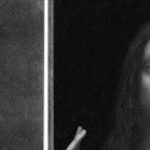
The attribution of the world’s most expensive painting – the $450 million Louvre Abu Dhabi Salvator Mundi – has collapsed under the combined weights of two scholars’ findings and the picture’s own artistic and art historical implausibility. Having disappeared immediately after its world-record sale at Christie’s, New York, in November 2017, this Leonardo-in-hiding is also mired in allegations of a joint involvement in the sale by presidents Trump and Putin. The toxic proximity of those two heads of state is a matter of intense national political concern in the United States where high-level official investigations are underway – as are a number of legal actions concerning auction house buyer/seller conflicts of interest. As those disputes play out, we consider the workings of today’s art historical and art market interface.
THE ART CRITICAL CONTEXT
In the 1990s we claimed common failures of connoisseurship in bad restorations and misattributions but thought the latter less serious because potentially correctable. That distinction is dissolving as increasingly many upgrading attributions are made on the back of “improving” restoration transformations. Generally speaking, connoisseurship shortcomings are evident in failures to detect outright fake old masters and in too-ready acceptances of elevated restoration-enhanced school works. Purpose-made fakes are closely related in their fabrications to the painted “recoveries” of supposedly original authentic appearances on stripped-down pictures. (See “A Restorer’s Aim – The fine line between retouching and forgery”.) The fakery of artificially distressed new paint and false painted craquelure is common to routine restorations; to restoration-assisted upgrades; and, to outright fakes. On the additional, extraordinary rise of the “painted-in” insinuation of computer-generated virtual reality into old master pictures, see “The New Relativisms and the Death of ‘Authenticity’” and Fig. 4 below.
Above, Fig. 2: Top row, the Metropolitan Museum’s Duccio Madonna and Child, as seen in 1904 and in 2004 (when sold for c. $50 million); above, the Leonardo Salvator Mundi as seen in c. 2005 and in 2017 (when sold for $450 million).
Above, Fig. 3: Top row, the present Louvre Abu Dhabi Salvator Mundi painting as seen in 1912 and when sold in November 2017. Bottom row: as at the same dates but showing some intermediary restoration states.
Attributions, like restorations, are made in socio-cultural contexts. Here, we examine the marketing of the upgraded Salvator Mundi with reference to the marketing of a picture that had received a spectacular upgrading a century earlier – the Metropolitan Museum’s 2004 acquisition of a tiny Duccio Madonna and Child. In both cases we see elevations of studio works that had first emerged at the beginning of the 20th century and were converted through restorations into claimed major autograph works. In both cases, when viewed dispassionately and art critically, the upgraded works are seen to stand anomalous within their allotted oeuvres. In both cases, the elevations thwarted the articulation of potentially more fruitful and better informed art historical narratives.
In studying the two cases we encounter errors of connoisseurship that rest on plain failures to look; failures to discern; and failures to make use of the sharpest art critical tool in the connoisseur’s tool box – the humble photo-comparison. This methodological abstemiousness can seem wilful and perverse as much as neglectful – some disavow photo-testimony outright as a critical tool. In the visual arts, and with today’s greatly enhanced photographic means of reproduction and transmission, there can no excuse for advocates’ declining to provide visual demonstrations of claims made in support of attributions or restorations.
THE PROBLEMS OF SCHOLARLY ADVOCACY ON THE MARKET
Where once a respected scholar might have proposed an attribution in an academic journal or forum in anticipation of critical responses, today, at the high end of the art market, teams of professional supporters are assembled one-by-one behind the scenes prior to some Big Media Announcement of a “discovered” masterpiece. Within such procedures, successive scholars’ invitations to appraise works are inescapably compromised by awareness of already committed supporters. At a certain point of accumulated critical mass it can be felt a) tempting to join and/or b) professionally unwise to dissent openly. A sense can grow that nothing will be permitted to count as evidence against that which has been collectively endorsed, and that any opposition will incur a risk of being dubbed a “hostile” party. At the low end, the trade euphemism for the many restoration-enhanced upgrades is “a sleeper”.
RECENT ARTWATCH WARNINGS AND ENGAGEMENTS
ArtWatch warnings on the Salvator Mundi’s Leonardo attribution: 1) On 11 November 2011 we pointed out (letter, the Times, Fig. 5 above) that the Salvator Mundi painting then on exhibition as a Leonardo at the National Gallery, and that is now the Louvre Abu Dhabi picture, lacked a sophisticated optical effect copied in 1650 by Wenceslaus Hollar from a painting then thought to be a Leonardo. 2) On 19 October 2017, nearly a month ahead of the 15 November sale of the Salvator Mundi at Christie’s, New York, we objected (in the Guardian) that the painting was inconsistent with Leonardo’s depictions of figures; that it lacked the sophisticated optical effects copied by Hollar; and, that there was insufficient evidence to support a Leonardo attribution. 3) On 14 November 2017, the day before the Salvator Mundi sale at Christie’s, New York, we warned that the provenances compiled by the National Gallery in 2011 and Christie’s in 2017 were unsupported, inflated and overly-reliant on then (and still) unpublished researches of one of the work’s first owners – see “Problems with the New York Leonardo Salvator Mundi Part I: Provenance and Presentation”.
CHRISTIE’S MARKETING OF A SALVATOR MUNDI AS A “MALE MONA LISA” AND AN EARLIER CASE
Above, top, Fig. 6: Left, Loïc Gouzer, co-chairman of Americas post-war and contemporary art at Christie’s stands next to “Untitled” by Jean-Michel Basquiat during a Christie’s, New York, press preview; right, the Salvator Mundi when sold as a Leonardo at Christie’s, New York, on 15 November 2017 – the last time it was publicly seen. (It is presently rumoured to be in a Freeport storage depot in Switzerland.)
Gouzer, who is leaving Christie’s, had claimed: “Young people look at Leonardo the same way they look at Basquiat.”
The day after Christie’s 15 November 2017 sale of the $450million Salvator Mundi, Thomas Campbell, former director of the Metropolitan Museum of Art, observed that the “eye-popping” price was no surprise in a market where “speculation, marketing and branding have displaced connoisseurship as the metrics of value”.
Todd Levin, an art adviser, told the New York Times: “This was a thumping epic triumph of branding and desire over connoisseurship and reality.” (See “How Salvator Mundi became the most expensive painting ever sold at auction”.)
George Goldner, former chairman of drawings and prints at the Metropolitan Museum, has said the allure of the Salvator Mundi “has nothing to do with art and everything to do with money,” and that “If you were to spend $450m on a rare car or diamond and put it on display, a lot of people would come to see it. If the Salvator Mundi had sold for $20m, nobody would go. Any painting that sells for $450m will attract crowds for a while. Then, all of a sudden, people won’t care anymore”.
THE METROPOLITAN MUSEUM DUCCIO MADONNA AND CHILD
Above, Fig. 7: Three views of the Metropolitan Museum’s Duccio Madonna and Child
Goldner is right of course – who queues now to see the Met’s famous “Duccio” (Fig. 7, above) which, like the Leonardo Salvator Mundi, emerged at the beginning of the 20th century with no history? The then recently restored Duccio had been launched by Berenson’s wife (Mary Logan) and a protégé (Frederick Mason Perkins) in 1904 at a time when Florence was “a factory of forgers”, according to Federico Zeri, and with modern wire nails embedded under its ancient and battered gilded gesso. By further coincidence, both pictures arrived at the beginning of this century after long absences (1949 to 2004 for the Met Duccio, 1958 to 2005 for what is now the Louvre Abu Dhabi Salvator Mundi-in-storage.)
In hindsight, the sale of the $50 million Duccio in 2004 served Christie’s as a model for that of the Salvator Mundi. The task in both cases was to market as an absolutely secure blue chip autograph old master, a work that had arrived very late in the historical day, without provenance, and from within a large group of related but artistically diverse pictures. Both works were successfully presented by Christie’s, on substantial expert authority, when, on a full art critical and documentary interrogation, neither can safely be so regarded.
Although we still cannot examine the Salvator Mundi’s unpublished technical literature, with the Duccio we can (thanks to earlier generous assistance from Keith Christiansen, the John Pope-Hennessy Chairman of European Paintings at the Met) examine that picture’s part-published technical literature and the under-reported means by which it had emerged from an antiques shop a century earlier and was, after restoration, instantly attributed to Duccio by its owner. As with the Salvator Mundi, there is no record of such a work having been produced by Duccio and no attempt has been made either to demonstrate that the Met picture was an original prototype for the many other versions of the type or to acknowledge the many historic variants themselves. Instead, five modern forgeries of the Berenson-upgraded Duccio are cited by Christiansen on grounds that they “testify to its prestige.”
THE MET DUCCIO CONTROVERSY LITERATURE:
The case for the Metropolitan Duccio has been put principally by Keith Christiansen in: the Fall 2005 Metropolitan Museum of Art Bulletin (“Recent acquisitions”, p. 15 – “among the most important single acquisitions of the last two decades”); an October 2007 Apollo article, “The Metropolitan’s Duccio” – which was described as “the first full account”; the Summer 2008 Metropolitan Museum of Art Bulletin – “Duccio and the Origins of Western Painting”; also in 2008, a special Met re-printed publication, Duccio and the Origins of Western Paintings.
The case against was put by Professor James Beck in the last chapter of his 2006 book From Duccio to Raphael – Connoisseurship in Crisis, and by Michael Daley who, after corresponding with Christiansen over the attribution, published three articles in the Jackdaw magazine between November 2008 and March 2009: “GOOD BUY DUCCIO?”; “BUYER BEWARE”; “TOXIC ATTRIBUTIONS?”
FURTHER SALVATOR MUNDI AND MET DUCCIO CONNECTIONS: MARKETING THE ATTRIBUTIONS
As with the Salvator Mundi, Christie’s marketed the painting as a “Last Chance to Buy a Duccio”. Christiansen is listed by Christie’s as one of the Salvator Mundi’s supporters, as also is the Met’s chief picture restorer, Michael Gallagher, and as was Christiansen’s predecessor as paintings’ chairman, the late Everett Fahy.
When purchased, the Met Duccio had never been technically analysed. This long out-of-sight work was only subjected to technical analysis by the Met after acquisition and after challenges to its authenticity had been made by Beck and other scholars. As with the Louvre Abu Dhabi Salvator Mundi, the subsequent technical examination reports were not published or made available to independent scholars.
GUSH, ACQUISITIONS, SUSCEPTIBLE VIEWERS, SYCOPHANCY AND ABSENCES OF “STYLE CRITICISM”
Like Robert Simon on the Salvator Mundi, Keith Christiansen is a life-long devotee of the artist in question. His accounts of the Met Duccio have inclined towards the rhapsodic while eschewing direct engagement with style criticism. He recalls being struck on his first (2004) encounter with the Duccio at Christie’s, London, that “Like a poem or a piece of music, a great work of art – even a very small one – it has the power to cast a spell over susceptible viewers, to draw them into the world of its creator. For a few moments we were silent, each of us registering our impressions… Ever since, almost forty years ago, I first stood before the Maestà in the Museo dell’Opera del Duomo in Siena, I have been haunted by Duccio’s singular gift for suggesting an ineffable, sacred presence in his depictions of the Virgin and Child, and it is this quality that first struck me – except that in this small picture there is an intimacy in the relation of mother to child that is quite different from what one finds in the artist’s public altarpieces, and the face of the Virgin is touched by a haunting melancholy even more poignant than I remembered from his larger public paintings…I knew the picture from old black and white photographs in books on Sienese painting and the two principle monographs on Duccio and his followers…There are few works of art I longed to see more than this small but astonishing picture…[which] would have been at the top of anyone’s wish list for acquisition…”
With big acquisitions museums take hyperbole and heroising gush to be in institutional order. The Met Duccio was by far the museum’s costliest ever and for a while it sparked an ecstatically uncritical hysteria. A New York restorer/dealer, Marco Grassi, for example, likened the picture’s emergence to the discovery of a manuscript score for a Mozart quartet. The world had earlier missed the chance to see it, he wrote (New Criterion, February 2005), because it was “on its way to London to be offered for sale, privately, through Christie’s.” But then, the happiest of endings:
“The Stoclet Duccio – we can now proudly call it ‘the Metropolitan Duccio’ – is an astonishing achievement…the artist places the Virgin at a slight angle to the viewer, behind a fictive parapet. She gazes away from the Child into the distance while He playfully grasps at Her veil. One must appreciate that every aspect of this composition represents a departure from pre-existing convention. With these subtle changes, Duccio consciously developed an image of sublime tenderness and poignant humanity, almost an echo of the spiritual renewal that St. Francis of Assissi had wrought only a few decades earlier…If, adding ‘strength to strength’ is a judicious policy in building collections, then, with the addition of the Duccio, its rewards will be particularly bountiful for the Metropolitan…And so, the Metropolitan’s recent arrival now rules supreme in this exalted company, and surely this could not have happened were it not for the outstanding quality of the museum’s curatorial resources. Chief Curator Everett Fahy and Associate Curator Keith Christiansen of the Department of European Paintings, in addition to Laurence Kanter, Curator of the Lehman Collection, constitute, together, a particularly prestigious concentration of scholarly expertise in the field in earlier Italian painting. No other museum can boast of a more distinguished team. One suspects that they, more forcefully and convincingly than anyone, made the case for the Metropolitan’s prodigious expenditure, and their advocacy merits our gratitude and applause…”
The celebration of “every aspect a departure” within an oeuvre is an inherently problematic and art-critically dangerous intoxication.
HOW A DREAM WISH MATERIALISED
Above, Fig. 8: Left, the Director of the Metropolitan Museum of Art, Philippe de Montebello contemplating the museum’s Duccio Madonna and Child (after its acquisition); centre, a fragment of an infra-red image of the painting, as published in Apollo in 2007; right, an x-ray of the framed Metropolitan Duccio panel, also as published in Apollo and showing the modern wire nails that no one had noticed or acknowledged.
Christiansen described how the Duccio picture was drawn to his attention in Danny Danziger’s (endlessly fascinating) 2007 Museum – Behind the Scenes at the Metropolitan Museum of Art:
“Nicholas Hall of Christie’s, with whom I have been friends for many years, phoned me up and said ‘I would like you to have lunch with me; there is something I’d like to show you.’ During the meal he slipped me a transparency, and I looked at it. It was a painting that had not been seen by any of the major Duccio specialists for fifty years…”
What could possibly go wrong? Nothing, Christiansen clearly thought: “…it had been in the Stoclet family and out of circulation. ‘Fantastic, how about the price? I asked. He told me. OK, I said, ‘I will deal with that later.’ And then we finished lunch.” Note, re frequently disparaging art world dismissals of photo-testimony, first, a curator had committed to the cause of a work he had never seen on sight of a single photograph; second, the Met’s director, Philippe de Montebello, would also become hooked on the painting through that photograph; third, that for over half a century, professionally-speaking, the picture’s Berenson-made attribution had been sustained on photo-testimony alone. Christiansen would later put it like this: “In 1949, [the then owner of the Duccio, the financier Adolfe] Stoclet and his wife died within a short time of each other. The collection was divided among their children, but access to it was increasingly difficult and there was even uncertainty as to whether the Duccio had been sold. The result was that a generation of scholars had to formulate their opinions on the basis of photographs, of which, fortunately, extremely good ones had long been available.”
THE CIRCUMSTANCES CONCERNING THE WITHDRAWAL FROM THE 2003 SIENA EXHIBITION
In Calvin Tomkins’ 11 July 2005 New Yorker article “The Missing Madonna”, it is said that the Met’s then head of European paintings, the late Everett Fahy, visited the Stoclets’ house in Brussels in 2002 to negotiate with of one the relatives for the Duccio’s loan (later rescinded) to the 2003 exhibition in Siena. Fahy may possibly have been the first scholar to see the painting in over fifty years. Tomkins reports Fahy saying that the picture “still hung then where it had always had, in Adolphe Stoclet’s private studio”. Christiansen later reported (Apollo 2007) that “Stoclet did not hang his gold ground pictures in this modern [Josef Hoffmann-designed house] setting but kept them in a large cupboard, taking them out, one by one, on Sunday afternoons or on the occasion of a visit of a guest such as Berenson.” Kenneth Clark had been the source of the cupboard storage claim. Fahy noted, “Everything the Stoclets collected was something you could put in your hand, small and precious”. Small, but not always precious. As Frances Vieta established (and Beck acknowledged in his 2006 connoisseurship book), Stoclet had owned two little Duccios, one of which proved to be a modern forgery in 1989. It, too, had been attributed to Duccio by Berenson’s protégé, Frederick Mason Perkins, who, along with Berenson’s wife, Mary Logan, had also upgraded the Met Duccio Madonna and Child, and two hugely expensive sculptures bought by Helen Frick that were also subsequently exposed as modern forgeries. Berenson himself had been taken in by half a dozen or so modern forgeries. The Cleveland Museum had been taken, too, but recovered when it identified modern wire nails and paints in a “Sano di Pietro” and declared it a fake. Before the Met picture had been first upgraded to Duccio by its owner, some had thought it a Sano di Pietro. The Cleveland Museum downgraded another Sano di Pietro to a school work when it – like the Met picture – was found to contain azurite not ultramarine. “With attributions”, Fahy held, “it’s not the number of people who agree with you, it’s the quality of their judgments.” The Louvre Abu Dhabi Salvator Mundi had, reportedly, been unsuccessfully offered to Christie’s in 2005.
The Met picture, having narrowly missed a public viewing in the 2003 Siena exhibition for Duccio and his followers, suffered further non-visibility when Christie’s put the newly-emerged work into a private sale among just three major museums: the dollar-rich Getty Museum, which had balked at the asking price; the Louvre, which was said to be working on getting the money for the (then and still not-disclosed) asking price; and the Metropolitan Museum. Under this private sale arrangement it is possible that barely more than a dozen experts had seen the painting before it was sold to the Met and thereafter was trumpeted as an unquestionably autograph seminal and revolutionary work in the history of Western painting – and all this, as mentioned, ahead of a technical examination. The avoidance of public scrutiny during the sale seems to have occurred by design, not accident. Calvin Tomkins, whose New Yorker disclosures have not, so far as we know, been challenged, added:
“Although the ‘Madonna and Child’ was well-known in art-historical circles as the only one of Duccio’s dozen or so surviving paintings to remain in private hands, its whereabouts had been uncertain since the death, in 1949, of its last registered owner, the Belgian collector Adolphe Stoclet. In fact the picture never left the Stoclet House in Brussels. Stoclet and his wife… had willed the house to their son, Jacques, whose widow held onto it until her death in 2001. Soon after that, her heirs, (four daughters) who are very high on anonymity, agreed to lend it to an important exhibition in Siena, Duccio and his school…a few weeks before the opening in 2003, the painting was withdrawn. This coincided with rumours of an impending sale, which turned out to be true.
“Although everyone involved in the transaction is bound by omertà, it is known that both Sotheby’s and Christie’s, the principal auction houses, engaged in lengthy and fiercely competitive negotiations with the heirs, and Christie’s eventually won the prize. ‘The family was very keen that the painting go to a public museum or institution,’ according to Nicholas Hall, international director of Christie’s Old Masters department. This was one reason that the family decided upon a private ‘treaty’ sale, in which the auction house and the seller determine the price and then offer the work to selected potential buyers, rather than letting it take its chances at public auction; another reason was that a private sale is more private. ‘We got it by putting a significantly higher valuation on the painting than anyone else – by multiples – based on its being the last Duccio in private hands and its being so impeccably preserved,’ Hall told me. Hall himself never met the sellers. ‘The contract document must have been four inches thick, and it was the most rigidly controlled transaction I’ve ever been involved in,’ he said…”
CHRISTIE’S LAVISH PRESENTATION LITERATURE
Tomkins reported that, in addition to the transparency, Nicholas Hall had given Christiansen the “lavish presentation booklet that Christie’s had prepared for prospective buyers”. On whose imprimatur or on what scholarly authority had that booklet been prepared? How many people got to see it? When Christie’s auctioned the Salvator Mundi, the publicly-disseminated provenance was frankly acknowledged to have derived from the National Gallery’s 2011 catalogue entry; the restorer’s 2012 report; and, through their declared joint indebtedness, to the (still today) unpublished researches of one of the original 2005-2012 consortium of dealer/owners.
A COURTIER FLATTERS?
When Christiansen left his lunch with his old friend at Christies, he wondered what to do next about the tiny work he considered “probably the most important early Italian picture that could ever come on the market”. Should he call his director who was on vacation in Canada? He decided to wait: “and then I went into his office and said, ‘I am duty bound to show you this,’ and then I showed him the transparency. I casually said to him, ‘You know, Philippe, you deserve this picture. Tom Hoving had his [1970 $5.5 million Velazquez] Juan de Pareja, Rorimer had his Rembrandt [“Aristotle Contemplating the Bust of Homer” for $2.3 million in 1961]; I don’t see why you shouldn’t have this towards the end of your career’.”
Christiansen continued (to Danziger): “My director fortunately is a person who loves old master paintings, who grew up with old master paintings and worked as a curator in this department and does not need to be told much. He was completely riveted by it. He asked me the price while he kept looking at it, and then he said, ‘I don’t see how we can get it…’ But that, I imagine, was also when the wheels began to turn in his head, because when I left, I thought there was a real possibility.” In the heady post-acquisition days of November 2004 Christiansen recalled to Carol Vogel in the New York Times that when the director was first shown the photograph “it took him about 30 seconds to say ‘We really have to have this’”.
At the same time, Tomkins had made clear why de Montebello might have gagged on the price. The Getty Museum (which has been bitten by fakes) had already turned it down: “reportedly, because of the price. This struck Christiansen as ironic because the price was so clearly predicated on the fifty-five million dollars that the Getty had agreed to pay, two years earlier, for Raphael’s small, perfectly preserved Madonna of the Pinks.” That little Raphael in the mint of condition had, like the even littler Met Duccio, lost its original back when, for some reason it was polished by its artist/restorer/dealer/smuggler owners. When the cradle was removed from the back of the by-then Met Duccio, it was found to have been scraped down to the bare wood, on which was written an ascription to…a member of Duccio’s school. Like the Salvator Mundi, the little Raphael was one of many versions of the subject – there are over fifty-five Madonna of the Pinks. James Beck remarked in his 2006 connoisseurship book: “I find it appropriate to claim, given the situation as has already been sketched, there is no chance whatever that the Northumberland painting is an original Raphael.” But for sure, within a couple of weeks of seeing the photograph, de Montebello, Christiansen and the Met’s chief restorer, Dorothy Mahon, flew to London to see the Madonna and Child armed with a magnifier and a UVF lamp to spot retouches.
BUY FIRST LOOK AFTERWARDS
The next morning, after a couple of hours of inspection at Christie’s in London with Christiansen and Mahon, de Montebello made a quick and high offer (without Board authorisation). It was immediately accepted by Christie’s but under the terms of this “private treaty sale” the picture could not be removed from Christie’s to undergo examinations at the Met and be presented to the Board’s Acquisitions Committee for appraisal and possible approval, as was customary. This was because, as Christiansen put it, “the picture wasn’t leaving Christie’s until the whole deal was finished”. Why so – and why accepted by the Met when such a huge sum was at stake? Had this condition been stipulated by owners who seemingly had developed cold feet about the picture being seen for the first time in over half a century in the context of a show on Duccio and his followers?
In his 1993 memoir Making the Mummies Dance Thomas Hoving recalled that when he went to Christie’s in London in 1970 (with the then head of restoration, Hubert von Sonnenberg, Everett Fahy, and a Board member, Ted Rousseau), the chairman of the auction house, Sir Peter Chance – “the very symbol of upper-class culture neatly folded around commerce” – explained “The condition’s perfect…the picture will not be cleaned up for the sale. Lord Radnor forbids it. He is also against anyone…examining it…scientifically. But no matter, we all matriculated into connoisseurs without all these fashionable instruments, if I may say so, Dr. von Sonnenberg.” (Hoving was bemused when Sir Peter put the price at “approaching the two million guinea mark” – a guinea being a pound, plus a shilling: “While Sotheby’s always conducted their sales in pounds, Christie’s favoured the more pretentious guinea.” In those days the joke was that at Christie’s gentlemen pretended to be salesmen while at Sotheby’s salesmen pretended to be gentlemen. In today’s globalised ownership-fluxing art world it might prove impossible to slide a cigarette paper between them.)
That Velazquez painting truly was one of the greatest portraits ever to come to market – and, in some part it was so because it had probably not been touched in a century and a half. When the Met staffers revisited the next day, von Sonnenberg held the picture against the window when the guard left the room and discovered that it had never been lined – hence the extraordinary vigour and sparkle of the brush work. As soon as Hoving and von Sonnenberg took possession it was sent secretly to Wildenstein’s – not to the Met itself – and there it went straight under the conservation chemical cosh on a claim of dirty varnish-removal but, in reality, in conformity with the museum’s imperious proprietary and aesthetic imperatives. (See “Discovered Predictions: Secrecy and Unaccountability at the Metropolitan Museum of Art, New York” and “Why is the Metropolitan Museum of Art afraid of public disclosures on its picture restorers’ cleaning materials?”) Even before it might become “The Metropolitan Velazquez” the portrait became a Met-treated painting and no one else at the museum, let alone its paying public, ever got to see the great masterpiece in its unadulterated state. To his credit Rorimer had earlier confessed (privately) to Alexander Eliot that the Met’s restorers had ruined its Rembrandts – and those poor paintings were not alone:
Above, Figs. 9 and 10: Details of the Met’s Goya portrait of the young Manuel Osorio Manrique de Zuñiga who died before he was eight years old. As seen before cleaning (left) and after cleaning (right).
In July 2005 Philippe de Montebello explained to Calvin Tomkins (New Yorker): “It’s the single most important purchase during my twenty-eight years as director – It’s my ‘Juan de Pareja’, it’s my ‘Aristotle.’” De Montebello later explained in the Summer 2008 Met Bulletin that he had moved so fast on an unexamined work because he felt authorised by:
“the assurance that comes from the trust I have learned to place in the curators and conservators of this great institution…As I held the picture in my hands, enraptured by its wonderful quality…I was treated all the while to Keith’s impassioned scholarship…it was particularly Keith’s precise and learned assessment of the picture that allowed me to consider the acquisition an imperative.”
(For a fuller account of de Montebello’s decision to buy, see CODA below.)
Immediately after spending nearly $50million on the unexamined Duccio at Christie’s in London, Christiansen, de Montebello and Mahon went to see the National Gallery’s Duccio triptych The Virgin and Child with Saints. Christiansen recalled (as reported in Danziger, 2007): “After about two hours at Christie’s we all walked down to the National Gallery where they have a very rare and beautiful Duccio triptych, which is simply marvellous – a touchstone of Duccio’s work – and we all felt that ‘ours’ was every bit as fine and in certain respects, more intimate and direct.” The following year, in a foreword to the 2008 Summer Met. Bulletin Christiansen elaborated:
“…we decided to walk the few blocks to the National Gallery, which owns a portable triptych by Duccio that has long been a cornerstone of its superb collection of early Italian paintings. The triptych is a work of extraordinary beauty and impeccable craftsmanship. Duccio struck a slightly different key than in the picture we had been examining, placing greater emphasis on the regal bearing of the Virgin. The motif of the Child playing with his mother’s veil is further developed, so that Christ unfurls a rich cascade of folds. But these enhancements came at the expense of the simple dignity and touching humanity of the small panel we had seen at Christie’s. In short, we felt that we had before us the opportunity of acquiring a painting that was on a par with one of Duccio’s most admired and best-preserved works, a painting that represented the artist at the very height of his powers.”
Michael Daley, Director, 6 February 2019
In Part II we consider why the Met team might have been advised to view the National Gallery Duccio triptych (and its dossiers) before visiting Christie’s and buying on the spot.
CODA:
Martin Gayford accompanied Philippe de Montebello on a walk around the Metropolitan Museum, as recorded in his 2014 book RENDEZ-VOUS WITH ART. In his chapter “The Case of the Duccio Madonna”, Gayford wrote: “We ended up sitting on a bench near perhaps Philippe’s most celebrated acquisition: a small exquisite Madonna and Child by the 14th century Sienese master, Duccio. It remains the most expensive single object ever purchased by the museum. So how, I asked, did he make the momentous decision to buy it?” De Montebello replied:
“When the Duccio was on offer, I had, as Director, to decide whether the picture was worth the huge sum I would have to raise to acquire it. To arrive at this decision, I had to wear several hats all at once: one of these was that of an informed art lover, the French ‘amateur’, and in that role focus on the seductive and lyrical lines, the harmony of the colours, the felicitous choreography of the hands and feet, the wonder of the human contact coincident with a certain respectful detachment in the depiction of figures, that are, after all divine. I also had to don my art historian’s hat and note that this Duccio was one of the very first pictures that mark the transition from medieval to Renaissance image making. It represented a key moment, a break from hieratic Byzantine models to a more gentle humanity.
“To be more specific, and it is more than just a recondite detail, look at how the parapet at the bottom connects the fictive, sacred world of the painting with temporal one of the viewer. This important observation – among others – was made by the curator Keith Christiansen as we were examining the picture in London. This led him to conclude that Duccio must have seen the Giotto frescoes in Assisi depicting the life of St. Fancis, where the illusionistic framework, including the parapet, relates the narrative scenes to the architecture of the church.
But Martin, you want to know the truth? All those considerations were largely irrelevant when the time came to decide whether to spend in the region of $45 million on the work. For this, I needed my museum director’s hat. The quantitative assessment had to be based on different criteria. First and foremost were the old-fashioned notions of quality, craft and skill. Did the work sing? Did it stop me in my tracks and did it then hold my attention? Was I reluctant to turn away from it too quickly?
“However, in my mind, the question of relative importance and quality was always pushing itself forward. That the work was beautiful and admirably well painted was not enough. It needed also to be very important, exceptional in every way, and extremely rare. If there had been three or four others similar to this one it would have meant that this picture should command a lower price.
“Then there was the question of what the price of this panel should be in comparison with one of the missing predella panels from Duccio’s Maestà in Siena were it to come up for sale. This is because the Madonna was and is a self-contained, independent and devotional image; it doesn’t belong to a larger work, the wholeness of it is part of its beauty and impact. The entire story is there in that one painting. That, too, added to its value.
“Then, as curators, we also needed to be concerned with the physicality of the work. After all, this object, which can be held in the hand, has weight and a certain thickness, and is vulnerable to the vagaries of time. Part of what drove me to buy the Duccio was the fact that for close to an hour I did hold it in my hands, that I did turn it around, looking at the back, sensing its weight, measuring its thickness. It had a corporeal reality that was almost, to use a paradox, mystical.
“No longer bound by image alone, as one would be when looking at a photograph – or even from a distance – I then focussed on the deep burn marks at the bottom of the frame, obviously made by votive candles, confirming that this was indeed a devotional picture. Just a few additional details resulted from close examination, not the least of which was that the picture was in impeccable condition, a rare thing when it comes to Trecento gold ground pictures, as most works have suffered greatly over time, mostly I’m afraid at the hands of restorers.
If you are a student of art, just think of the Jarves collection at Yale, where many of the pictures, early renaissance works, are now a near total ruin. We were also able to confirm that this was indeed not an incomplete work, a wing of a Diptych for example, there is a hole at the top indicating that the picture was hung from a hook.
“Then, of course, came the issues of the provenance or ownership history, an important preoccupation of art historians, for what it may reveal about the work. While it obviously began life as a devotional picture, made for an unknown patron, it eventually ended up in the hands of two major European collectors: Count Grigory Stroganoff at the end of the 19th century, and later the Belgian financier Adolphe Stoclet, in his Brussels house, which is a masterpiece of the Wiener Werkstätte. Also, the Duccio had been lent to the great Sienese exhibition of 1904 where it was highly praised; indeed one art historian Mary Logan (Bernard Berenson’s wife), deemed it the single finest work in the exhibition.
In addition, and not a minor factor in gauging the price, was the knowledge that there would most probably never be another Duccio for sale, as this was the only work of his known to exist outside of a museum. I also knew – which is why I made a quick and high offer – that the Louvre, the other major museum that did not have a Duccio, was after it as well and was going to make a real effort to buy it.
“So some competitive nerve was struck, and thus the need for pre-emptive action. While it may not have been conscious, I think that there is no question that a part of me wanted my institution to own that Duccio – over and above its importance to the proper representation of the development of Sienese art in the Trecento – simply to have it as yet another major work that would confirm the stature of the Met.
“At this point, the sum of all the above, which occurred in a rush of sensory and intellectual responses, led to an important psychological factor, which should not be underestimated in such cases: it is that of the curator/acquisitor experiencing what is a quasi-libidinal charge (you might even call it lust, albeit of a high order); the irrepressible need to win; to have taken the object of desire. You can’t get away from that. We are all human beings. Institutions are not just made of stone, glass and steel, they are run by people. It is absurd to try to maintain and project total objectivity.
“As a result of all these considerations, these thoughts, observations, calculations and feelings, as well as the confidence I gained from learned colleagues, the Met boasts this masterpiece of Trecento painting, while the Louvre, with its outstanding collection of Italian paintings, is still, and may forever be, lacking a Duccio. This actually saddens me, and I hope that a fine Duccio does turn up someday, from somewhere, and they can get it.”
Two troubled Leonardos
Two supposed Leonardos are now in difficulties. The Salvator Mundi, sold for half a billion dollars just over a year ago, hasn’t been seen since. In France, the Saint Sebastian drawing saved for the nation was not bought and has now been put back on the international market.
In the Guardian today (“An £18m saint…but is Sebastian drawing really by Leonardo?”) Dalya Alberge reports that the Leonardo scholar Martin Landrus believes the recently discovered and attributed ink drawing of a Saint Sebastian that is being offered by the Tajan auction house is not entirely – or, rather, is mostly not by Leonardo. Dr. Landrus was struck by poor ink drawing “nervously traced” over “much lighter lines that may have been autograph”. Possibly so, but ink lines studiously executed over faint guidelines made in erasable materials like chalk, charcoal or pencil in what would appear to be a quickly executed inventive study (as opposed to a drawing made from an already posed life model) are also encountered in pastiche inventions made by third parties.
The possibility should also be considered that this newly-emerged Saint Sebastian (above right) is a “portmanteau” drawing composed from elements borrowed or adapted from bona fide Leonardo drawings such as the Saint Sebastian ink study (above left) in the Hamburger Kuntshalle. In questions of attribution, differences or inconsistencies weigh more heavily than similarities and correspondances. Both drawings above are made of ink over fainter drawing. Both are of Saint Sebastian tied to a tree. However, notwithstanding the subject’s extreme plight, the Hamburg figure is a clear adaptation of a classical figure: the raised shoulder is placed above a stretched torso contour, while the lower shoulder is placed above a raised hip with the inescapable consequence that the torso’s contour is compressed and bunched (see the comparison with a real figure below). Throughout the Hamburg drawing the lines are spare, elegant and sometimes almost notational – see the way the centre line that begins under the rib cage shifts into alignment with the plane of the abdomen which is set in opposition to that of the chest. There is no such clarity and figural acuity in the newly-emerged drawing even though it contains considerably more drawn marks. Where the Hamburg drawing has three differently placed heads (two inked and one in chalk or pencil) all are individually compatible with the body, while in the Tajan auction house drawing the single head is snapped and twisted back in almost broken fashion and there are two radically conflicting poses in the torso below it. In one of these both arms are tied behind the tree in a manner that leaves the true left shoulder dropped below that of the right. In the alternative version the situation is reversed: the true left arm has been pulled up as if tied to a higher branch but this dramatic change of design and anatomical orientation carries no consequences for the rest of the figure: the abdomen remains untidily anatomically bunched. The true left breast remains dropped below that of the right, even though the true left shoulder has been rotated both upwards and backwards. It is hard to believe that so great a draughtsman as Leonardo could have confined such a radical shift of positioning to a single discrete part of a figure. As well as anyone Leonardo understood the manner in which bodies combine “architectural” structures with fluidity, mobility and grace. By contrast, it is easy to imagine how someone wishing simply to compose a study in the manner and style of a Leonardo sketch/design might commit such solecisms.
(For discussion of the rising tide of discovered works by great old masters, see our 15 December 2016 post “Leonardo and the Growing Sleeper Crisis”.)
Michael Daley, 17 November 2018
The pear-shaped Salvator Mundi
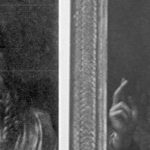
Things have gone very badly pear-shaped for the Louvre Abu Dhabi Salvator Mundi. It took thirteen years to discover from whom and where the now much-restored painting had been bought in 2005. And it has now taken a full year for admission to emerge that the most expensive painting in the world dare not show its face; that this painting has been in hiding since sold at Christie’s, New York, on 15 November 2017 for $450 million. Further, key supporters of the picture are now falling out and moves may be afoot to condemn the restoration in order to protect the controversial Leonardo ascription.
Above, Fig. 1: the Salvator Mundi in 2008 when part-restored and about to be taken by one of the dealer-owners, Robert Simon (featured) to the National Gallery, London, for a confidential viewing by a select group of Leonardo experts.
Above, Fig. 2: The Salvator Mundi, as it appeared when sold at Christie’s, New York, on 15 November 2017.
THE SECOND SALVATOR MUNDI MYSTERY
The New York arts blogger Lee Rosenbaum (aka CultureGrrl) has performed great service by “Joining the many reporters who have tried to learn about the painting’s current status”. Rosenbaum lodged a pile of awkwardly direct inquiries; gained a remarkably frank and detailed response from the Salvator Mundi’s restorer, Dianne Dwyer Modestini; and drew a thunderous collection of non-disclosures from everyone else. A full year after the most expensive painting in the world was sold, no one will say where it has been/is or when, if ever, it might next be seen. (See “Leonardo Canards: Conservator Dianne Modestini Debunks Doubts Over the Elusive ‘Salvator Mundi’”.)
After the Salvator Mundi’s recent no-show at Abu Dhabi Louvre, concerns and rumours have grown exponentially. (See our “Two developments in the no-show Louvre Abu Dhabi Leonardo Salvator Mundi saga” and “How the Louvre Abu Dhabi Salvator Mundi became a Leonardo-from-nowhere”.)
AN ENDURING SUPPORTER
Throughout this protracted no-show, Professor Martin Kemp, the most high profile art historical advocate of the painting’s Leonardo attribution, has offered assurances. Immediately ahead of the November 2017 sale he made a promotional video for Christie’s, New York, that was specifically designed to combat our and other warnings, warnings that he now characterizes in his self-valedictory memoir Living with Leonardo as “misinformation appearing in the press”. The Times reported on 28 August: “‘looking at the whole science’ including the rock crystal sphere that Christ was holding and the depth of field convinced [Kemp, that] ‘with Leonardo you have this wonderful body of context, of extra evidence…it is rock solid, it is damaged but rock solid’.” Kemp frequently fuses appeals to rock solid scientific evidence with art critical hyperbole. For example, to the owner of the supposed Leonardo drawing “La Bella Principessa”, he said of a partial finger print:
“This is yet one more component of what is as consistent a body of evidence as I have ever seen. I will be happy to emphasize that we have something as close to an open and shut case as is ever likely with an attribution of a previously unknown work to a major master. As you know, I was hugely sceptical at first, as one needs to be in the Leonardo jungle, but now I do not have the slightest doubt that we are dealing with a work of great beauty and originality that contributes something special to Leonardo’s oeuvre. It deserves to be in the public domain.”
So far as we know, that supposed Leonardo drawing (which the National Gallery excluded from its 2011-12 Leonardo show) remains unsold in one of Yves Bouvier’s freeports. Kemp recently assured the world that wonderful things are in train for the Salvator Mundi next year. Against his bullishness, the picture’s long-serving restorer, Dianne Dwyer Modestini, has now disclosed to Rosenbaum: “I have no idea about the future of the painting. No one does. Not the French, not Martin Kemp. I assume the people from Abu Dhabi know something, but they are not talking to anyone, not even the French.”
Rosenbaum had tried the Louvre, Paris:
“I thought the venerable French museum would at least be able to answer my question regarding its own exhibition plans, but Sophie Grange of the Louvre’s press office said only this: ‘It is too early, one year ahead, to communicate on the list of the loans for the Louvre exhibition. Concerning Louvre Abu Dhabi, they communicate themselves about their own collection.’ Grange advised me to get in touch with Faisal Al Dhahri at Abu Dhabi’s Department of Culture and Tourism—one of the three officials whom I’d already attempted to contact several times, to no avail. I think this is called: ‘Getting the Run-Around.’”
THE GOOD THINGS TO COME
Kemp may have had in mind the forthcoming 2019 Louvre exhibition to mark the 500th anniversary of the artist’s death but no one at the Paris Louvre will now confirm that the Abu Dhabi Louvre Salvator Mundi will be included. Is Paris about to spurn Abu Dhabi’s $450 million acquisition? Failure to include the work next year would risk humiliating the United Arab Emirates (who paid something like Euros 400 million for the right to exploit the Louvre title – roughly the cost of one big yacht) when French foreign policy dictates every deployment of soft cultural power to gain influence in that traditionally Anglophile quarter.
…AND THE UNKOWN UNKNOWNS
Why are so many players so silent on this painting? Why is the art world being kept in this state of darkening paralysis? Some background might help explain the jitters. The art market greatly fears the pending trial in New York between Sotheby’s and the Russian collector Dmitry Rybolovlev who seeks $380 million from the auction house for an alleged conspiracy to defraud him through his own adviser, Yves Bouvier. In 2013 Sotheby’s brokered a private sale of the Salvator Mundi for $80 million to Bouvier, the owner of a string of “tax-efficient” freeports – his Geneva facility alone reputedly holds $100 billion of art. The consortium of vendors claimed that a non-disclosure agreement made with Sotheby’s preventing them from disclosing the picture’s origins. Bouvier immediately sold the painting on (“flipped” in art trade parlance) to Rybolovlev for $127.5 million – an undisclosed mark-up of $47.5 million, with Sotheby’s, reportedly, pocketing $3 million as an agent’s fee. The Swiss police authorities recently detained Rybolovlev for questioning due to “reported allegations of corruption and ‘influence peddling.’ Rybolovlev is allegedly tied to Philippe Narmino, the former justice minister in Monaco, who retired last year after he was accused of working under the influence of the Russian collector in his fraud case against Bouvier…” Earlier, Rybolovlev had filed a complaint against Bouvier in Monaco. The latter was arrested on charges of fraud and money laundering and released on $10 million bail. Bouvier is now reported to be in Singapore. With Rybolovlev furious at being over-charged in 2013, the consortium of vendors who sold indirectly to him for $80 million are thought to remain aggrieved at being short-changed by $47.5 million on the picture’s value and having been pre-emptively blocked from action by a Sotheby’s law suit. Sotheby’s are reportedly seeking assistance from Christie’s in a separate legal fight with a dealer over the sale of a demonstrably and now scientifically-confirmed fake Frans Hals…
THE ART AND ATTRIBUTION STAKES
Unsavory art market churning must not swamp the serious art and attribution concerns at stake with this Salvator Mundi. Modestini’s reported statement to Rosenbaum merits close reading. Her first concerns are the painting’s physical condition, well-being and whereabouts:
“It’s supposed to have been in Switzerland, but I’m not quite convinced, because a conservator who was asked to make a condition report more than a month ago still hadn’t seen it as of last Monday [22 Oct. 2018]. I’m rather worried because although it was framed in a microclimate, it is not a long-term solution. I’m pretty sure it left Christie’s in mid-May. Then it disappeared. It never went to Abu Dhabi… However, the panel is badly damaged and exceptionally reactive to changes in RH [relative humidity]. It needs to be at not less than 45% RH, even though it has some protection because it’s in a microclimate created by sealing it up in an envelope of Marvelseal —a standard technique.”
Modestini’s second concern is professional and personal:
“The Abu Dhabi announcement [that it had postponed display of the painting] had nothing to do with the nonsense about its being 85% by Dianne Modestini and the rest by [Bernardino] Luini. [The Luini theory, advanced by Leonardo scholar Matthew Landrus, was reported by Dalya Alberge in the Guardian and picked up by Smithsonian Magazine, among others.]”
Above, Fig. 3: Left, the Salvator Mundi as restored in 2008; right, a National Gallery painting attributed to Bernardino Luini.
A GREAT FALL-OUT?
It is understandable that Modestini should be sensitive and defensive – no professionally conscientious person enjoys criticism. Following our demonstrations of the extent to which the painting changed appearances at her hand (albeit on the advice of and with support from a high-ranking group of art historical experts) between 2005 and 2017, there are now signs that art historical advocates of the Salvator Mundi may be preparing to disavow the successive restorations to protect the credibility of their attribution. Consider Jonathan Jones’ recent (15 October) account in the Guardian – “The Da Vinci mystery: why is his $450m masterpiece really being kept under wraps?”
Jones, who was the embedded journalist-of-choice within the National Gallery’s conservation department when its version of the Virgin of the Rocks was being restored, bluntly contends that it might have been better if the Salvator Mundi had not been restored at all:
“Surely it would have been more true to the greatest artist who ever lived to let his timeworn masterpiece speak to us directly. Is the Louvre Abu Dhabi taking a closer look? I think it should.”
In this maneuvre, Jones seems to draw support from Martin Kemp, who, along with a few other select experts, had been invited by the National Gallery’s incoming director, Nicholas Penny, to the confidential 2008 viewing of the Salvator Mundi when part repainted, as at Fig. 1:
“When the painting was cleaned, it turned out that Christ had two right thumbs… ‘Both thumbs,’ says Kemp of the raw state, ‘are rather better than the one painted by Dianne.’”
Kemp will likely have known that Modestini had painted out the restoration-exposed second thumb on the advice of Luke Syson, the curator of the National Gallery’s 2011-12 Leonardo exhibition in which Kemp had been set to have some curatorial input until, as he puts it: “it was later decided that all the curation should be conducted in-house”. Modestini acknowledged Syson’s guidance in her (2014) published account of her restorations preceding the painting’s appearance in the National Gallery’s 2011-12 Leonardo exhibition. Syson, who went to the Metropolitan Musem, New York, has recently been appointed director of the Fitzwilliam Museum, Cambridge. It is possible that had Kemp been co-curator, the National Gallery Leonardo show would have included a second Kemp-supported Leonardo upgrade, the “La Bella Principessa” drawing. In any event, an emboldened Jones has now challenged Robert Simon, one of the original consortium of dealer-owners: “Why didn’t he leave the painting in its raw yet beautiful state after it was stripped down? Wasn’t that an incredible object in itself?” Simon stood firm:
“We considered leaving it, considered more limited restoration, as well as a more extensive one…In the end we decided to do what we felt was best for the picture…we felt that bringing it back to life as much as possible was the way to go.”
Jones reports Simon’s annoyance with criticisms of the restoration – he absolutely rejects the possibility of any artistic “falsehood” being introduced. “I found [Thomas Campbell’s] comments both ill-informed and offensive. ‘Inpainting’ is the right way to describe what has happened here – retouching restricted to areas of loss. In the restoration no original paint was covered.”
(When the picture was sold in November 2017 Thomas Campbell, the former director of the Metropolitan Museum, presciently tweeted that he hoped the anonymous buyer who had just paid $450m “understands conservation issues” and had “read the small print”.)
WHAT WAS DONE IN THE SALVATOR MUNDI RESTORATIONS
The claim never to have over-painted is universally asserted by restorers. While no code of restoration “ethics” sanctions painting over surviving original paint, the profession’s philosophical pieties constantly conflict with observable visual facts. We have previously shown that if you juxtapose halves of the two Salvator Mundi faces, as seen in 2011-12 at the National Gallery and at Christie’s in November 2017 (see Fig. 7 below), there is a mismatch: scarcely any passages of painting run across the halves. As the photo-records below testify, this version of the many Leonardesque Salvator Mundis has enjoyed two distinct identities in seven years and three in ten years. We discuss the unreported covert transition from the second to the third below.
DISPARAGING PHOTO-TESTIMONY
Modestini and Kemp are united on one point: both hold that restorers cannot be held to account by photo-comparisons of the alterations they make to works of art. The claim is untenable – how else might appraisals of restorations be made given that pre-restoration appearances are consumed in restorations? Both the restorer and the art historian further contend that photographs are inherently unreliable because susceptible to malicious manipulation. Modestini offers this variation on that ancient restoration slur:
“I have refrained from commenting on some of the recent articles about the restoration. However, in light of the fact that no one can now see the actual painting, various digital images are standing in for the original, all of which can be manipulated any way one wants and are a sort of falsification of the original.”
That is unworthy. First, why would anyone maliciously tamper with images to make false claims of non-existent injuries that could easily be exposed by the photographic record? How long did it take to expose the Trumpian White House’s tampering with film footage of a journalist’s attempt to retain a microphone? Second, does Modestini mean to imply that the clear photographically recorded differences between the painting’s 2011 and 2017 states are the combined result of malicious critics and auction house promotional manipulations? Modestini’s citation of the second plank of the traditional Restorers’ Defence – that all photographs of paintings are inherently untrustworthy and misleading – is scarcely more credible:
“It is very difficult to photograph any painting accurately, this one especially, because of the many thin layers, subtlety of skin tones, delicacy of transitions etc. Most paintings have three dimensions, not two. That affects our perception of them. I hardly recognize the image that now passes for the ‘Salvator Mundi.’ The photo lamps or strobes (in the case of the Christie’s images) produce a simulacrum of the actual painting, more vivid, sharper, snazzier, if you will, than the actual battered image that I restored as carefully as I could, trying not to invent anything. These flashy images cannot include the nuances and problems created by the three dimensionality of the corrugated surface and are being compared with an only slightly more accurate scan of a good 8×10 transparency of the cleaned state, which was more honest.”
That last image (here at Figs. 5-10) has been published with a drum roll by Jones in the Guardian as if a proof of Leonardo’s hand when it had been published by Modestini in 2014 (albeit small and in printed not online form). Although a considerable improvement on earlier versions (as published by us) it does not tell a different story. On the Jones premise, will Modestini now produce equally high-resolution photographs taken before and after each of her various interventions (2005-08; 2008-11; post 2012 and pre-2017)? If she insists that all photographs are inherently untrustworthy and easily falsifiable, will she explain why so many photographs of paintings are made and published and why they never carry visual health warnings? Are all photographs previously made for restorers’ own restoration reports now deemed to be unreliable testimony?
THE ART CRITICAL UNDERPINNING OF THE SALVATOR MUNDI’S CHANGING APPEARANCES
We incorporate below the Guardian’s newly released high definition photograph of the painting when cleaned but not-yet repainted within the public record of Modestini’s restorations and then consider Kemp’s scientific/art theoretical input into the restoration in the light of certain accounts in his new memoir, Living with Leonardo – Fifty Years of Sanity and Insanity in the Art World and Beyond. But first, the changes to the painting:
Above, Fig. 4: Left, the photograph of the Salvator Mundi painting when in the Cook collection and judged to be a work of Bernardino Luini; right, the former Kuntz family and then Basil Clovis Hendry Sr. estate painting, as in the 2005 St. Charles Gallery catalogue.
Above, Fig. 5: Left, a screen grab of the Salvator Mundi as when taken, still sticky from a previous restoration in 2005 to Dianne Modestini’s New York studio; right as in 2007 in the newly released high-resolution photograph following cleaning and repairs to the panel but before any retouching, infilling or repainting. Will Modestini publish a photograph of the painting as presented to her in 2005?
Above, Fig. 6: Left, the Salvator Mundi as in 2006/7 (in high-resolution) after cleaning; right, as in 2011 as exhibited as a Leonardo at the National Gallery, London, and after much repainting – some of which was distressed and contained false, painted lines of cracking in emulation of aged paint cracks.
Above, Fig. 7: Left, the Salvator Mundi as in 2006/7 (in high-resolution) after cleaning; right, as in 2017 when sold at Christie’s, New York, after further covert restoration.
Above, Fig. 8: Left, the head of the Salvator Mundi as in 2006/7 (in high-resolution) after cleaning; right, the head in a split screen compilation showing the appearance in 2011 on the left and in 2017 on the right.
Above, Fig. 9: Top, a detail of the Salvator Mundi’s eyes as in 2006/7 after cleaning and before repainting (and as published by Modestini in 2014); above, left, the face, in 2011, and, right, as in 2017.
Above, Fig. 10: Top, a detail of the new high resolution photograph, as published online by the Guardian; centre, the corresponding detail as published by Modestini in 2014, the previously best detail of the cleaned and not-yet repainted eyes; above, eyes by Leonardo and Bronzino. The lower images are surely instructive here? The Salvator Mundi was hyped by Christie’s, New York, as an iconic thing – a “Male Mona Lisa”. Martin Kemp holds that it was painted by Leonardo after he had painted the Mona Lisa and that he had deliberately put the face “out of focus” so as create spiritual mysteriousness on the one hand and an illusion of spatial depth and recession in an emphatically flat (and heavily cropped composition) on the other. If we look at these images art critically we can safely make a number of factual, verifiable observations – and these are not “subjective”. First, although the high-resolution photograph is superior as a photograph to the lower resolution image, as published in a book, it does not tell a materially or artistically different story – in both we can see the extent of losses and the fact the treatment of the eyes is neither identical nor consistent. In particular we can see that the treatment of the heavy flattening upper eye lid on the right is sharply (and badly) drawn, while that on the left is softer and almost undoubtedly abraded. Modestini somehow equalized the effect of the eyes while leaving the implausible severity of drawing found in the lid of the eye on the right. Neither eye in this painting is remotely comparable with the Mona Lisa’s eyes where softness of effect has been achieved without loss of sculptural lucidity or anatomical veracity. These differences are ones of quality more than of style. The creases formed by the meeting of the soft flesh of the upper lids with the more taught flesh of the brow is more sharply drawn in the Bronzino but it is also drawn with greatly more acuity and finesse than the eye on the right of the Salvator Mundi. Much of the great benefit photography brings to art historical scholarship lies in the ease with which detailed style comparisons can be made. In an age of high quality and electronically transmissible photography, if you are going to claim Leonardo you really should take the opportunity to demonstrate Leonardo.
Above, Fig. 11: A succession showing the picture and two details, with the first each time, as in 2011 and, second, as in 2017. The question raised by Modestini is the extent to which the differences shown above are products of Christie’s own “more vivid, sharper, snazzier” images of the 2017 state or of her own repainting. It can safely be said that repainting must substantially account for the differences because changes have been made to the design of forms as can be seen here in the comparison of the details of the shoulder drapery. It would be helpful if all parties to the post 2005 “conservation treatments” would publish full accounts of them accompanied by the best available photo-records.
MARTIN KEMP’S THEORETICAL AND SCIENTIFIC INPUT
On the very day when the Salvator Mundi went on exhibition at the National Gallery (9 November 2011) Kemp published an article, “Art History: Sight and salvation” in Nature magazine. In it, he made a number of significant contentions/observations: 1) that although connoisseurship still has a role to play, it involves “subjective criteria that should long ago have been superseded as the key tool of attribution”; 2) that art historical evidence can be supplemented by “the scientific”, of which there are two kinds – technical examinations of pictures’ component material parts, and scientific evidence that is “particular to Leonardo”; 3) that the Salvator Mundi bears such witness in two regards: it “plays with depth-of-field problems. None of the contours is absolutely sharp, but the blessing hand and the tips of the fingers cradling the orb are discernibly clearer than the features of Christ’s face. The rapid lack of clarity in depth serves to give space to what would other-wise be a quite flat image.”
What is striking in the above series of comparisons is the extent to which Modestini has apparently added force and clarity to the hands and globe in the foreground. The globe, for example, has been emphatically darkened towards its circumference and lightened at its centre between 2011 and 2017. Modestini partially accounted for these changes in 2014: “The rock crystal orb, symbolizing the cosmos, was painted with practically nothing, thin glazes and scumbles which unfortunately have been abraded, especially along the top of the wood grain. Originally the illusion must have been magical since simply toning down the lighter areas with translucent watercolor glazes rendered it convincing.”
In Living with Leonardo Kemp discusses the two thumbs and, there, had praised Modestini’s “painstaking and diplomatic filling in of lost areas with readily soluble paint”. Kemp reports that after viewing the picture at the National Gallery in 2008 “Robert and I corresponded during the course of that summer and autumn.” There can be little doubt that differences between the painting’s appearance, when first taken to London (Fig. 1), and later in 2011 when exhibited in London (Fig. 2) are considerable. Even more dramatic are the differences between 2011 and 2017. The question, then, is under what or whose ambition or programme, were Modestini’s changes made? Was she and/or the owners in thrall to Kemp’s quasi-photographic depth-of-field thesis? We know from her own account that she made a number of artistic changes to the painting with a view to increasing spatial force:
“I repainted the large missing areas of in the upper parts of the painting with ivory black and a little cadmium red light, followed by a glaze of rich warm brown, then more black and vermilion. Between stages I distressed [how?] and then retouched the new paint to make it look antique. The new color freed the head, which had been trapped in the muddy background, so close in tone to the hair and made a different, altogether more powerful image.”
Note: these are only the changes that were made between 2007 and 2011. There has been no account of the subsequent restorations. If we look at the top of the split-image of the face at Fig. 8, we can see that the hair immediately to the right of the parting had become much darker by 2017 while the flesh tones in the forehead and nose had become lighter. No account of these changes has been published.
REFRACTIONS OR PENTIMENTI?
To return to Kemp’s 2011 Nature article, where he made this account:
“The other optical effect is unique to this painting, both in Leonardo’s work and in the Renaissance more generally. The orb is not the standard globe of the world. It is translucent and glistens internally with little points of light. These are not the spherical bubbles found in glass, but are the kind of cavity inclusions (small gaps) that appear in some specimens of rock crystal and calcite. Leonardo, we know, was considered an expert in such semi-precious materials. It seems that he observed the double refraction produced by calcite. The Heel of Christ’s hand exhibits two distinct contours, not in this case due to a change of mind.” [Emphasis added.]
That could not be clearer, could it? In Kemp’s characteristically adroit fusion of the technical and the spiritual, the superseding of traditional subjective practices of connoisseurship by newer, more astute technically and scientifically-informed analysis might seem well demonstrated – but how are such formulations to be evaluated? Must scholars without scientific backgrounds simply defer to the supposed superiority of science-loaded art historical scholarship – if told, on cited geological authority, that a material is so and so and, therefore uniquely gives rise to such and such effects, (that is, if calcite, then be on the lookout for its double refractions) who might query or dissent? Seven years later, in Living with Leonardo, Kemp retells his story on the significance of the orb and its near magical optical properties as a concrete embodiment of Leonardo’s mind, but with a twist: “The most satisfying aspect of my own research concerned my hunch that the globe was made of rock crystal”; he had “toyed with the idea that the double image of the heel of Christ’s right hand might be the result of the double refraction characteristic of rock crystal; but the optics would not work. The apparent doubling is almost certainly another pentimento [i. e. change of mind in the design – emphasis added].”
Thus, without a blush, Kemp offers a new diametrically opposite rationale: with this orb Leonardo “was not making a ‘portrait’ of an actual sphere, nor was he following all its optical consequences to their logical conclusions.”
Without mention of Hollar’s testimony, a pragmatic explanation is offered for an intellectual flip: “the optics” were put to the test and it was found by due and diligent research that they “would not work”. By “would not work” Kemp suggests that his efforts with a real crystal orb to replicate the kind of refraction he had earlier claimed to recognise in the double image of the hand holding the orb had been unsuccessful. But might there not have been another reason for dropping the earlier refracted hand thesis? As mentioned, Kemp’s Nature article appeared on the day the National Gallery’s Leonardo exhibition opened, 9 November 2011. On 11 November, a correspondent asked in the Times why no optical deflections were evident in Christ’s globe. The next day the Time’s carried our letter (Fig. 12, below) pointing out that in an etched copy by Wenceslaus Hollar of the original but now lost Leonardo Salvator Mundi the drapery seen through the orb had been deflected.
For the National Gallery this was politically awkward: if Hollar had copied an optically sophisticated, characteristically Leonardesque, effect from a painting then attributed to Leonardo that was not present in the painting on exhibition as the original Leonardo from which Hollar had made his copy, this could only mean that Hollar’s copy had, in fact, been made from another painting. Worse, on a careful visual reading of the relationships between the etching and the Salvator Mundi painting in the exhibition, there were further grounds for drawing the same conclusion: Hollar’s Christ was stouter and heavily bearded; his face was long and it tapered inwards from the level of the eyes, it did not widen, chipmunk-like towards the jaw; the eyes looked slightly to our left, not directly at the viewer; a radiant halo-like light emitted from Christ’s head; the transparent orb had gathered light around its circumference – and not grown darker, as in the painting…
This problematic visual mismatch must have compounded political problems: the gallery’s decision to exhibit a proposed Leonardo of little provenance and no art historical or technical literature and that was in the hands of a group of dealers (and therefore, inevitably, on the market) was institutionally questionable and certainly controversial. It became the more so when at least four Leonardo scholars challenged the attribution of the painting. Kemp, at that point, was hoist on his own scientific petard. Where the gallery had claimed in its catalogue entry on the painting that “There could be no doubt that this is the picture that was copied by Hollar”, it was now evident that it could not have been – and without that claimed connection, the picture’s supposed provenance collapsed from one in which it had passed down to us first through the French royal family in Leonardo’s day and then to the English royal family in the 17th century… to one that only began in England in 1900 when it had emerged from no acknowledged source, with no history and only as a painting given to Luini. How would the gallery respond to this very public correspondence and challenge? How would Professor Kemp respond? The National Gallery made no reply to the letters in the Times perhaps judging silence to be a better defence than open art critical engagement. Professor Kemp, too, was silent in the public prints, so far as we know.
Above, Fig. 12: Two ArtWatch UK letters to the Times.
Seven years later, while the National Gallery remains silent, Kemp, in Living with Leonardo, now writes with patronising verve and confidence to a new position:
“We should remember that Leonardo was drawing on his knowledge of rock crystal to devise a large sphere [the former ‘orb’ or ‘globe’] for Christ to hold – he was not making a ‘portrait’ of an actual sphere, nor was he following all of its optical consequences to their logical conclusion. I have been asked on more than one occasion why the drapery behind the sphere is so little affected by what is, in effect, a large magnifying lens. The answer, in a word, is decorum; that is to say, pictorial good manners…Leonardo’s endowing of Christ with a rock crystal sphere was not just a case of optical and geological cleverness for the sake of it…”
Perhaps not, but then why not introduce into the discussion the visual/artistic fact that Hollar had copied a deflection of curved forms of drapery when seen through a curved transparent body symbolising the cosmos? Would a copyist have invented an optical distortion in a painting he believed to be an autograph Leonardo? In journalism, as supposedly in science, facts are held sacred and opinions somewhat less so. Are awkward facts expendable in science-rich art history? Properly considered, Hollar’s testimony is an important event in the history of scientific engagement in art – just as it had been in Holbein’s use of an optic to correct the anamorphosis in the foreground skull of The Ambassadors in the National Gallery – as a scholar had proposed in the 1970s and I had corroborated in the 1990s. How long will such testimony remain institutionally and professionally un-personned?
SOME FURTHER UNADDRESSED, PHOTOGRAPHICALLY RECORDED ARTISTIC FACTS:
Above, Fig. 13: Left, a section of drapery in the Louvre Abu Dhabi Salvator Mundi when exhibited at the National Gallery in 2011-12; right the Modestini-changed section of drapery when sold at Christie’s New York in 2017.
Above, Fig. 14: Left, Hollar’s 1650 engraved copy of a Salvator Mundi attributed to Leonardo that shows deflected folds of drapery within the transparent orb; right, the Abu Dhabi Louvre Salvator Mundi as seen at the National Gallery at the time of the above correspondence in the Times. The double edge of the hand holding the orb had been left in place on the then Kempian view that it demonstrated Leonardo’s sophisticated optical knowledge. Had that double image been judged a pentimento it would, like that encountered on the thumb of the raised true right hand, likely have been painted out by Modestini on the advice of the National Gallery curator, Luke Syson.
Above, Fig. 15: Changes made to the Salvator Mundi’s orb and adjacent draperies as seen respectively (from left to right) in 2008, 2011 and 2017.
Above, Fig. 16: Left, the 1650 Wenceslaus Hollar etched copy of a Salvator Mundi painting; right, the Abu Dhabi Louvre Salvator Mundi, as seen in 2017 with changed draperies. In the Hollar we can how the central, highlighted fold of drapery is deflected from its convex path into a concave formation as it runs through the centre of the orb and between the aligned double and single light reflections. We can see how the heel of the copied hand was smaller and deflected towards the circumference of the orb; right, in the Louvre Abu Dhabi painting (third state) we can see how Modestini had darkened the circumference of the orb and brightened the interior. It is simply inconceivable that as skilled a copyist as Hollar could have drawn his orb from this, now Louvre Abu Dhabi painting.
Above, Fig. 17: Top, two diagrams showing differences of design and modeling between the 1650 Hollar copy, left, and, right, the Louvre Abu Dhabi Salvator Mundi as sold in 2017. The three reflected highlights in the Hollar orb are aligned in accord with the picture’s top-left down light source which is evident throughout the painting that Hollar copied. The three unaligned white spots in the Louvre Abu Dhabi picture were attributed by Modestini to “reflections on the sphere to an outside source, but since many of the original glazes have perished, even when toned down, they float with context.” Above, a glass sphere owned by the author that shows the pushing of light towards the circumference, as copied by Hollar.
Above, Fig. 18: The author’s glass sphere. Where Martin Kemp failed to locate a double refraction in a small rock crystal orb, we demonstrated, as above, that when parallel straight lines (as here in the white gap between two photocopy diagrams) are viewed through a glass orb they are deflected into curves.
THE HOLLAR GLOBE’S BETTER FIT WITH THAT FOUND IN THE DE GANAY SALVATOR MUNDI<
In our previous post the painter Hikaru Hirata-Miyakawa showed through the three graphics below that in addition to all the above problems with the suggestion that the Hollar engraved copy had been made from the Louvre Abu Dhabi picture, the globe copied by Hollar bears a much closer relationship to the globe found in another Leonardesque painting, the so-called de Ganay Salvator Mundi, than to the globe seen in the Louvre Abu Dhabi Salvator Mundi.
Michael Daley, 12 November 2018
Lest we forget
Frances Moreton, Director of the War Memorials Trust, writes: “Our war memorials remind us not just of those who lost their lives but the consequences of conflict and the importance of preserving these memorials to ensure that future generations learn from the experiences and sacrifices of those we remember.”
6 November 2018
Hyping museum-restoration wrecks
Today museums seem as likely as not to be closed for “re-development”. Even small “time-capsule” artists or collectors home/museums, like Leighton’s, are fair game. Closures present loan opportunities and the National Gallery has snaffled some Courtauld Gallery Impressionist plums.
The hyped plum-of-plums in the National Gallery’s four star (- the Guardian gives five) Courtauld Impressionists from Manet to Cezanne blockbuster is the Courtauld Gallery’s Renoir, La Loge (as above). Today, bigging-up such restoration-damaged masterpieces seems to constitute museum world chic, as we discussed in March 2014 in “From Veronese to Turner, Celebrating Restoration-Wrecked Pictures”. At that date the most blatant hype was bestowed on a borrowed Turner seascape in which one of the picture’s two steamboats had been scrubbed away in the restoration wash, as seen below:
The above detailed comparison of Turner’s Rockets and Blue Lights (Close at Hand) to Warn Steamboats of Shoal Water shows (top) a 19th century photograph – by courtesy of Christie’s – and the painting (above) as flaunted in the National Maritime Museum’s 2013-14 Turner and the Sea exhibition. Sinking a boat and turning its belching black coal smoke into a waterspout might be thought as clinching a demonstration of restoration injury as could ever be encountered. However, that early photograph had been preceded by a large chromolithographic copy (see below) that had even better recorded Turner’s original second boat and distressed crew, and therefore gives a truer indication of the magnitude of artistic injury.
Some art critics alert to words might have noticed that the picture was described by Turner to contain “steamboats” – not a single boat – but, if so, none paid heed. Seemingly taking their collective lead from a Tate press release to an earlier Turner exhibition that had proclaimed this wreck-of-wrecks to be “One of the stars of the show”, it having “recently undergone major conservation”, the critics gushed in unison with their four and five-star reviews and the Maritime Museum was able to flood the world with posters and reviews (as below) celebrating this most-wrecked Turner seascape:
“…this show contains some of the most extraordinary passages of painting ever applied to canvas. Its centrepiece, the recently restored Rockets and Blue Lights… is an unbelievable vision of swirling blue, orange and white light thrusting through fog” [Daily Telegraph]; “Easily the most stunning picture in the show is Rockets and Blue Lights…The canvas has been given a restorative makeover…Turner’s brushwork is revealed in all its glory” [the Independent]; “Most splendid…is the dramatic and recently restored Rockets and Blue Lights, a picture so spectacular, that like the shadowy group of figures on the foreshore, you can only stare and wonder” [the Times].
We sometimes wonder.
That was then. Today the much hyped wreck-of-the-moment in the National Gallery/Courtauld Impressionist bonanza is none other than the latter’s own “iconic” Renoir, La Loge – as below:
We had examined this specimen in an August 2012 post: “Reviews: Taking Renoir, Sterling and Francine Clark to the Cleaners”.
In the comparison above we showed a detail (left) of the painting as seen as seen in 1921 in Georges Rivière’s Renoir et Ses Amis next to the painting (right) as in the Courtauld catalogue of 2008 at Fig. 5. The two reproductions were of very unequal quality but, even so, the permitted comparisons were alarming: both ears are now fully exposed, where before only one had been; the background had been darker; the eyebrows had been less symmetrical; the flower at the bosom had been more distinct, and so on…
In the comparison above, the reproductions were better matched. That on the left came from a plate in Anthea Callen’s 1978 book Renoir; that on the right from the Courtauld’s 2008 catalogue. Here, in the earlier state, we see firmer modelling in the jaw; stronger drawing and modelling in the mouth; a stronger flower and bow below; and, again, a more subdued background. What might account for these differences? Our money would be on a “restoration” ahead of the 2008 exhibition – perhaps one of those restorations that are presented as discovery-yielding technical research… In any event, we can presumably all see that something happened in the thirty years between 1978 and 2008 to cause the paint on the chin to start to cracking – as can better be seen in the comparison below:
In our 2012 post we had shown a similar outbreak of cracking that attended the National Gallery’s restoration of Renoir’s “The Umbrellas”, as shown in details below. We observed that if the heavily cracked appearance of Renoir’s “La Loge” might be thought a poor advertisement for the Courtauld Institute’s own conservation training programme, what confidence should the emergence of massive cracking in the cleaned face of a principal figure in a major Renoir give in the National Gallery ’s cleaning policies?
With the National Gallery restoration there can be no casting of doubt on the photographic records: these images – above and below – are taken directly from the gallery’s own excellent photo-records of the painting that were made immediately before and immediately after the restoration in question – as photo-testimony, this is as good as it gets.
What conclusion can be drawn? We see above, as below, sudden outbreaks of cracking in two different and previously well-preserved Renoir portraits held in two prestigious London galleries. If these injuries are not consequences of restoration or conservation “treatments”, how might they have arisen? As things stand, the evidence of our eyes can only tell us that pictures are not safe in London museums. Must we further conclude that the museum staffs themselves simply fail to notice injuries and are therefore not up to the job? Or, that they feel so institutionally-protected as to be under no obligation to give account for injuries to the works they hold in trust for the nation? There has to be some explanation – and it is now, perhaps, time for it to be given?
Michael Daley, 31 October 2018
Whiter than right
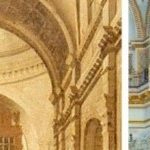
Robin Simon, editor of the British Art Journal and Honorary Professor of English at University College, London, has visited Chartres Cathedral and condemned its present restoration on a Facebook post and in a tweet:
“Just visited Chartres and I am appalled at the misguided ‘restoration’ that is covering the old stone walls in paint, with false pointing, creating a bland and uniform interior where the articulation of the architecture is crudely diminished. The history of the walls, of the building itself, is lost beneath a futile attempt to return the building to some imagined date in the distant past. What makes it much, much worse is the presence of bright electric lighting at crossing, choir and east end that destroys the effect of the greatest stained glass ever made, which used to cast the most wonderful haunting blue light throughout what was a uniquely ethereal interior. The magnificent chiefly 17th-century carved choir screen that wraps around the high altar end is also being whitewashed and the figures painted white, which is diminishing the three-dimensionality of these dramatic groups fully carved in the round. They now, remarkably, look flat, and have a smooth slimy surface with much of the miraculous crispness of the carving and detail lost.”
Robin Simon @robinsimonbaj:
“Just seen #Chartres #cathedral shocking #restoration. Walls painted, false pointing, glaring lights ruining blue light of glass, 17C carved choir screen flattened by white paint. State vandalism, arrogant architects, wrong-headed’experts’. Sign the petition https://bit.ly/2AmSRmN”
10:15 AM – 22 Oct 2018
Above, Fig. 1: Chartres Cathedral, with repainted vaulting in the choir contrasting with the existing nave and transepts in the foreground, Chartres, France, as published on July 11, 2012 in the New York Review (Photo: Hubert Fanthomme/Paris Match via Getty Images)
We have repeatedly attacked this restoration and on 16 December 2014 (“Chartres Cathedral Make-Work Scheme”) reported that this restoration had first been challenged in May 2012 by Alasdair Palmer in the Spectator – see his “Restoration tragedy” which began:
“Should old buildings look old? Or should they be restored to a condition where they look as if they could have been put up yesterday? Those questions are raised in a particularly pertinent form by the work going on at one of the most beautiful and inspiring of all old buildings: Chartres cathedral in France.
“Most of Chartres cathedral dates from between 1194 and 1230, when the bulk of the colossal stone structure, with its nearly 200 stained-glass windows and thousands of sculptures, was built. The extraordinary speed of its construction means that Chartres has an architectural and decorative unity that is unique among surviving cathedrals, most of which took a hundred years or more to complete, and were then altered drastically over the succeeding centuries.
“Chartres has suffered from the inevitable indignities inflicted by time. The paint with which the medieval artists originally covered the statues and the walls faded and flaked off within a few generations. Centuries of burning wax candles covered the interior with a thick layer of black soot. But Chartres remains far closer to the original building than almost any other medieval cathedral. The biggest effect of the intervening centuries since 1230 has been the accretion of the patina of age. A sense of the passing of time is part of the experience of looking at Chartres. The stone, the glass, the sculpture — it all looks very old, and its age is part of its fascination and its mystery.
“Or at least, it is in those parts of Chartres cathedral that have not yet been cleaned by the latest restoration project. It isn’t in those parts where the restorers have finished their work, for they look brand-new. There’s no patina of age here: there are only clean and bright surfaces.
“Is that an improvement? The restorers insist that it is…”
On 14 December 2014 Martin Filler, an architectural historian of Columbia University, New York, protested against the aims and consequences of such restorations in the New York Review (“A Scandalous Makeover at Chartres”):
“In 2009, amid a rising wave of other refurbishments of medieval buildings, the French Ministry of Culture’s Monuments Historiques division embarked on a drastic, $18.5 million overhaul of the eight-hundred-year-old cathedral. Though little is specifically known about the church’s original appearance—despite small traces of pigment at many points throughout the interior stonework—the project’s leaders, apparently with the full support of the French state, have set out to do no less than repaint the entire interior in bright whites and garish colors that are intended to return the sanctuary to its medieval state. This sweeping program to ‘reclaim’ Chartres from its allegedly anachronistic gloom is supposed to be completed in 2017.
“The belief that a heavy-duty reworking can allow us see the cathedral as its makers did is not only magical thinking but also a foolhardy concept that makes authentic artifacts look fake. To cite only one obvious solecism, the artificial lighting inside the present-day cathedral—which no one has suggested removing—already makes the interiors far brighter than they were during the Middle Ages, and thus we can be sure that the painted walls look nothing like they would have before the advent of electricity.”
Although the Chartres interior had initially been painted Filler noted that:
“…the exact chemical components of the medieval pigments remain unknown. The original paint is thought to have flaked off within a few generations and not been replaced, so for most of the building’s eight-century history it has not been experienced with painted surfaces. The emerging color scheme now allows a direct, and deeply disheartening, before-and-after comparison.”
Above, Fig. 2: left, Chartres cathedral stone work in its pre- and post-restoration conditions; right, the view looking SE in Chartres cathedral showing painted and unpainted areas adjacent to each other.
THWARTING A THREAT TO CHARTRES CATHEDRAL’S STAINED GLASS WINDOWS
As well as making a historically falsifying transformation of the interior, the funding of the restoration was itself exposing the ancient stained glass windows to needless risks. On 18 February 2016, Florence Hallett (“Chartres’ Flying Windows”) protested against plans to fly part of the cathedral’s stained glass to the United States as a fund-raising quid pro quo for support given by the American Friends of Chartres:
“While the cost of the controversial repainting of the cathedral’s interior has been met by the French state and donors including Crédit Agricole, Caisse Val de France et Fondation, and MMA assurances, the restoration of the cathedral’s famous glass has been funded in part by the American Friends of Chartres (AFC), an organisation that works ‘to raise awareness in the United States of Chartres Cathedral and its unique history, sculpture, stained glass, and architecture and their conservation needs.’
“Based in Washington, the AFC has ambitious plans to fund the restoration of the cathedral’s windows and sculptures. In 2013 it announced on its own site, and via the crowd-funding website razoo.com, that in return for funding the restoration of the Bakers’ Window (two lancets and a rose in the nave), the 13th-century glass would travel to a US museum. Indeed, the still extant webpage makes explicit the nature of the exchange, proclaiming: ‘American Friends of Chartres INVITES YOU to Restore and Bring to the United States a 13th-Century Stained Glass Window for Museum Exhibit’.”
Hallett’s specific challenge to the American Friends on the foolhardy plan to fly ancient stained glass windows to the United States seemed to have proved a successful deterrent. As we reported in a footnote:
“STOP PRESS: At 17.33 today, in answer to an email of 14 February, Florence Hallett was notified by the American Friends of Chartres that:
‘The exhibit of Bay 140 which had been envisaged will not take place because of cost reasons. And, to answer your question, of course all the proper authorizations from the French Ministry of Culture and other authorities had been secured by the DRAC-Centre Val de Loire, which had been nominated by the Ministry of Culture to execute the project. All the arrangements for the exhibit of Bay 140 would have been contractually arranged between the DRAC on behalf of the French authorities and the cultural institution that would have exhibited the window. American Friends of Chartres would not have been part of these contractual arrangements.’ ”
Above, Fig. 3: Top, a section of the Belle Verrière windows at Chartres. Above, a potential means of transport for early 13th century glass
If you owned or were the guardian of such ancient precious glass painting, would you pack it onto an aeroplane and dispatch it across an ocean to another continent? If “yes” you would be able to claim precedents: the ecclesiastical authorities at Canterbury cathedral sent the entire surviving six parts of an original cycle of eighty-six ancestors of Christ, once one of the most comprehensive stained-glass cycles known in art history, on a museum tour around the United States. (See “How the Metropolitan Museum of Art gets hold of the world’s most precious and vulnerable treasures”. )
Florence Hallett is the architecture and monuments correspondent at ArtWatch UK and visual arts editor at theartsdesk.com
Robin Simon gave the ninth annual ArtWatch International James Beck Memorial Lecture – “Never trust the teller trust the tale” – on 7 November 2017 at the Society of Antiquaries of London, in Burlington House, Piccadilly, London.
Alasdair Palmer has written frequently on art restoration for the Spectator and the Sunday Telegraph – see “Restoration tragedies” 26 August 2012.
Martin Filler is a prominent American architecture critic and a fellow of the American Academy of Arts and Sciences.
WHO PROFITS?
The various strongly made cases against the Chartres Cathedral restoration project, rest in essence on the folly of attempting to replicate a speculative incompletely-informed notion of how an interior might have appeared many centuries ago when brand new. At Chartres this particular exercise is not only wrong-headed, it is, as Alasdair Palmer pointed out five and a half years ago, especially egregious: this attempted replication of an original state is inflicting a peculiarly brutal and unforgivable expunging of an ancient building’s historically lived evolving appearance. “Brutal”, because having been uniquely executed as a distinct artistically integrated whole this cathedral’s precious fabric had thereafter survived in uniquely unmolested form. Here was a building whose monumental lucidity might be considered a match for the timeless Parthenon. Here was a building which, unlike the Parthenon today, had not become a cadaver on a test bed for aggressively invasive conservation methods; which retained its forms and, even, an especial ancient illumination – one that, as Robin Simon attests, had once “cast the most wonderful haunting blue light throughout what was a uniquely ethereal interior”. Gone. And all in exchange for an $18million building contract that is already running over schedule and will, no doubt, end over budget.
When faced with incomprehensibly barbaric mistreatments of old art and monuments we must ask not only “why?” but “who profits?” The last is no slur. It is a necessary step towards explanations for otherwise inexplicably perverse cultural actions. It is indisputably the case that such high-prestige art and architecture restorations generate much employment, purchases of materials, scaffolding etc. – and that they can greatly enhance professional reputations. None of those consequences is necessarily wrong or bad in itself but due acknowledgement of them should constitute a component part of any calculus of appraisal of restorations or proposed restoration campaigns. It is concerning that in today’s rapidly accelerating restoration boom, material/professional interests are looming ever-larger as it proves increasingly easy to raise funds for large-scale building projects made on the back of the culturally-loaded, ethically coercive, names of “conservation” and “restoration”.
We have shown that it is European Union policy to increase activity in the arts sphere as a means of generating jobs in compensation for those being lost to less moribund economies: “I am especially happy to highlight the importance of culture to the European Union’s objective of smart, sustainable and inclusive growth. At a time when many of our industries are facing difficulties, the cultural and creative industries have experienced unprecedented growth and offer the prospect of sustainable, future-oriented and fulfilling jobs.” See “Why is the European Commission instructing museums to incur more risks by lending more art?” and “The European Commission’s way of moving works of art around”.)
We know that the Chartres project has been part funded by the French Government. In this climate, greatly more vigilance and disclosure are now urgently required. No such project should ever be sprung on the world again. Monumentally dramatic proposals should be examined widely publicly and well in advance of the scaffolders moving in.
ASSORTED CONSERVATION RATIONALES
Above, Fig. 4: Left, the original interior of St Paul’s Cathedral as recorded in an undated but apparently 18th century painting that is owned by The Worshipful Company of Goldsmiths, at which date Sir Christopher Wren’s original painted finish comprised of three coats of warmly tinted oil paint that had been stipulated, according to Wren’s son, “not just for beautifying, but to preserve and harden the stone” still survived.
It was only disclosed during the recent under-researched stripping of the interior of St. Paul’s that Wren’s oil painted surface had contained lead white, ochre and black pigments so as to produce precisely the warm “stone colour” found in other Wren churches. Above, right, we see the new dazzling white surfaces of the building’s interior and its sculptures when illuminated by one of new electric chandeliers installed during the restoration because, as Martin Stancliffe, the cathedral’s then 17th Surveyor to the Fabric, put it, “the heart of my vision for the interior [was] to clean it and relight it”.
It is striking not only how frequently programmes have proceeded on artistically/art-historically injurious premises, but also how very contrary the aims of those various programmes can be. Where at Chartres cathedral attempt is being made to replicate a far-distant hypothesized original decorative scheme, at St Paul’s Cathedral, London, as Florence Hallett established, a major project to transform an interior was made on a reverse (and equally perverse) artistic/historical agenda. At St Paul’s, with a much more modern documented and visually recorded building, a programme was implemented to expunge the last traces of the original architect’s initial (and easily replicable) decorative programme with aesthetically falsifying – and, in the event, health-threatening – consequences even though the originally applied tinted oil paint was a known quantity, having survived intact in protected places.
In London too, much money was quickly raised but here it was spent stripping an interior down (with chemically-invasive materials never before used inside an occupied, still functioning cathedral) to create an a-historical modernist whiteness rather than to retain surviving traces or fully replicate the known original historic surface decoration. In consequence, not only has a powdery surface of stripped-down raw stone been exposed, but an already misleading appearance was subjected to the very greatly amplified artificial lighting that is shown above and was first established by Florence Hallett’s investigations: “Cleaning St. Paul’s Cathedral”, ArtWatch UK Journal 17, Winter, 2002; and “The supposedly ‘model’ restoration of St. Paul’s Cathedral”, ArtWatch UK Journal 18, Spring/summer 2003. Online, see Michael Daley: “Brighter than Right, Part 1: A Modernist Makeover at St Paul’s Cathedral” (1 June 2011) and “Brighter than Right, Part 2: Technical Problems of Protection, Health and Safety at St Paul’s Cathedral” (5 July 2011).
Above, Fig. 5: Left, a conservator removing a latex “cleansing pack” from a carved head at St Paul’s Cathedral, as published on the cover of Conservation News in May 2002. The journal reported that the latex was left on the surface for “one to four days” and that after its removal the stone was cleaned with “damp sponges and bristle brushes”. Right, a carved head at St Paul’s after being cleaned with water and bristle brushes. (Photography by Peter Smith/Jarrold Publishing.)
The chemical stripping-down of the cathedral’s interior surfaces to a novel whiteness was in accordance with an idée fixe of the 17th Surveyor to the Fabric, not of Sir Christopher Wren. In a 2005 programme note to a service held in honour of the restoration’s donors (“How the glory of St Paul’s was restored”), Mr Stancliffe declared that “the heart of my vision for the interior [was] to clean it and relight it”. In the Times of 10 June 2004 he announced his “pretty controversial” intention to introduce “six huge chandeliers” to flood the interior with artificial light. A year later he told the Guardian “we have installed new chandeliers and more lights” and expressed specific satisfaction on “seeing our initial vision gloriously realised.”
Above, Figs. 6 and 7: Top, the blotchy appearance of the stripped-down stone surfaces. Above, a simple, quick demonstration of the present dangerously powdery surfaces.
The brightness of this “restoration” was achieved at great aesthetic and material cost. As shown above, the surfaces have been left without patina and remain disfiguringly blotchy even after cosmetic attempts to mitigate the grosser consequences of the standardised indiscriminate cleaning method (see below). As for the supposed “conservation” purposes of this multi-million pounds programme, the interior’s now powdery surfaces are more vulnerable to environmental pollution and fluctuations of temperature and humidity than at any time in the building’s history. That the originally oil-paint protected surface of this limestone has been left as powdery as chalk was easily demonstrated by brushing the above sleeve against it.
CHECKS? BALANCES? TOOTHLESS WATCHDOGS?
Approval for the use of an experimental cleaning method on the interior of a publicly occupied and in-service cathedral had been given by The Cathedrals Fabric Commission for England in November 1999 following (claimed) earlier approvals by a bevy of heritage watchdogs: English Heritage; SPAB (The Society for the Protection of Ancient Buildings); The Victorian Society; and The Georgian Group. It is not possible to establish the precise chemical basis on which formal approval was given by the Cathedrals Fabric Commission for England because, in breach of good conservation practices, the three technical parts of the eight part submission document were withheld on grounds of commercial confidentiality. For information on technical matters we had to rely on the cathedral’s own fluctuating (and often self-contradicting) accounts; on our correspondence with the 17th Surveyor to the Fabric, which he terminated in March 2003; and on documents obtained by cathedral employees whose health was adversely affected by the restoration.
The cleaning agent used on St Paul’s interior was an experimental, technically undisclosed, adaptation of a commercial product. In both its composition and effects, it earned censure from leading conservation experts (see below). It was a commercially available, latex rubber poultice laced with a mix of chemicals that were said to comprise an agent specifically tailored to be similar to the mild alkalinity of St. Paul’s Portland stone – that is, it was a special version of the “Arte Mundit” water-based paste manufactured by the Belgian company FTB Restoration. The instigator/director of the restoration, the architect and the 17th Surveyor to the Fabric at St Paul’s Cathedral, admitted (at a lecture on October 21st 2003) to having slim knowledge of matters chemical and of having devolved – “entrusted” – responsibility for the application of the new paste to the conservators of the firm Nimbus who themselves were learning on the job while the cathedral remained in full commercial and ecclesiastical use.
Professor Richard Wolbers, conservation scientist and solvents expert at the Winterthur Museum and Gardens, University of Delaware Art Conservation Department, was highly critical of a number of technical features of the programme and reiterated his fear that the authors “seem to have taken a poorly characterised material, a latex paste, and modified it with the addition of a considerable amount of EDTA – largely as an adaption in their minds, I suppose, of one of the main ingredients in the Mora’s AB57 cleaning system.”
(The Mora AB57 method was the notorious cocktail of EDTA, sodium and ammonium, detergent and other ingredients in a paste that was twice applied and twice washed off Michelangelo’s Sistine Chapel ceiling paintings. We have chronicled the artistically disastrous consequence of stripping all organic material from the ceiling plaster. Within a generation the newly-exposed bare plaster had been secretly re-restored to remove powdering of the plaster, and then, in part-compensation, it was massively relit with coloured LED lights – see “The Sistine Chapel Restorations: Part I ~ Setting the Scene, Packing Them In” and “The Twilight of a God: Virtual Reality in the Vatican”.)
John Larson, the then Head of Sculpture and Inorganic Conservation at the Conservation Centre, National Museums and Galleries on Merseyside, said that applications of moulding materials had contributed so much damage over the past 200 years that museums around the world “have now banned” their use, and that the application of liquid latex by brush or spray “has a dramatic effect on porous material such as stone…as it dries latex shrinks and clings tenaciously to the surface.” The effect of pulling it off the stone “exerts strong mechanical forces on the surfaces when the stone is carved and deeply undercut, as shown on the cover of Conservation News.” (See Figs. 5, 6 and 7 above.)
Above, Fig. 8: Left, sculptures at St. Paul’s being cleaned by steam jets; right, a detail showing the sculptures in the ambulatory of Chartres Cathedral on 11 July 2012. (Photograph by courtesy of Hubert Fanthomme/Getty Images.)
All horrible restorations are horrible in their own ways. Steam cleaning sculpture is considered an acceptable “conservation technique” even though it is visually deadening and leaves marble surfaces resembling white granular sugar and greatly more exposed to environmental pollution and fluctuations of humidity and temperature. We have witnessed conservators at the Metropolitan Museum of Art, New York, painting dead white steam-cleaned Greek marble carvings with water colours. One, when asked what he was doing, replied that he was “putting back the patina” destroyed by the cleaning. That, presumably, is why the Greek sculptures at the MET now sport a uniformly tasteful biscuit-coloured “patina” regardless of their age and geographical origins. As seen above, at St Paul’s Cathedral the all-white, sans-patina effect found favour and sculptures were left as raw-white as the building itself. At Chartres, however, the new visually deadening whiteness of the sculptures is the product of yet another method and philosophy. The sculptures are not being stripped down to the innate interior whiteness of the stone but are having a white skin of paint superimposed – before also being further brightened by artificial lights. The aesthetic, psychological and spiritual consequences of this practice at Chartres can be seen above right where just a few years ago the not-yet “restored” figures in the ambulatory still shared our common spaces. There, among us, touchable and as if alive, they had for centuries acted their roles in a drama greater than Shakespeare’s – one that, millennia ago, had been played for real on earth and, for believers, at God’s will for our benefit. Their once miraculously constructed living tableaus and endlessly changing chiaroscuro are now, as Robin Simon has so poignantly described, flattened and left with “a smooth slimy surface with much of the miraculous crispness of the carving and detail lost.”
Even now, it is not too late to save an unmolested portion of this cathedral for future generations who would otherwise never be aware of the loss and adulteration: a petition – and an invitation to comment – beckons at a touch.
Michael Daley, 30 April 2018
CODA:
Today, 30 April 2018, Electronics Weekly reports that the lighting firm Osram has announced it has won a contract to light St. Peter’s in Rome: “‘We won worldwide recognition for the LED lighting system we installed in the Sistine Chapel’, said Osram Licht CEO Olaf Berlien. ‘We are very excited about this new opportunity to demonstrate our skills as a provider of complex, large-scale lighting solutions by conducting the lighting project in St. Peter’s.’” The report does not say how much Osram will be paid to light St. Peter’s (and, thereby, showcase its own products) but it does give further information on the lighting installed in the Sistine Chapel “The aim was to light the paintings so they appear to be lit by sunlight…Researchers went so far as to incorporate the current thinking of historians – that Michelangelo mixed paints in daylight rather than under candlelight or the light of torches, and therefore needed a cooler over-all colour temperature to get the best view of them today”. Michelangelo, of course, painted in the light of the chapel and for the chapel’s then sources of lighting. Indeed, when the ceiling was stripped down with the Moras’ AB57 chemical cocktail, art historian apologists for the garish colours that emerged contended that Michelangelo had had to make his colours so intense in order for his painting to read through the gloom of the chapel. As Professor Kathleen Weil-Garris Brandt of New York University and a Vatican spokesman for the restoration, put it in Apollo in December 1987: “Michelangelo…painted the ceiling in the knowledge that his forms would have to carry in the daylight or in the golden glow of candles and oil lamps. That’s one reason why his [restored] colours are so bright. Now that they are being revealed, the anachronistic spotlights only distort the appearance of the frescoes. In fact, the strong artificial lighting of cleaned areas of the Ceiling originally contributed to the false impression which disturbed critics of the conservation project.” In other words, now that the original colours of Michelangelo had been recovered, the chapel’s strong artificial lighting was surplus to aesthetic requirements. Why, then, was Osram recently invited to create a system of lighting for those (controversially) restoration-intensified colours that mimics the power of direct sunlight? For St Peter’s, Osram have a different agenda: “the lighting will be adjustable to suit different occasions, and will ‘accentuate the properties of the materials used and the building itself, highlighting the plasticity of the structure, its marbles and its architecture.'”
Christie’s recent sale of a stolen painting
In our 11 October post (“Two developments in the no-show Louvre Abu Dhabi Leonardo Salvator Mundi saga”) we suggested that new-style confidential legal conflict-resolution procedures might favour the big guys over the little guys – who “necessarily will forfeit their strongest card: the capacity to raise institutionally embarrassing press coverage”.
Just two days after that post, Mailonline carried a report that demonstrated the hard cash value that press coverage of grievances can unlock: “Painting stolen a week after being valued at £20,000 on Antiques Roadshow 30 years ago turns up at auction by Christie’s – who sell it to the astonishment of the disgruntled original owners”.
The Mailonline reports that the 1874 painting in question, Portrait of Mary Emma Jones, by Emma Sandys, had been stolen a week after the BBC show – in which its experts had valued it at £20,000 – was broadcast in January 1988. Christie’s, who sold the painting for £62,500 in July this year is now said by Mailonline to be involved in tense negotiations with the former owner’s daughter and to be “allegedly trying to buy the silence of the family from whom it was stolen by making an offer of £10,000 in exchange for them surrendering their claim and signing a confidentiality agreement.”
The family have rejected the offer as too low, according to the Times and Christies say that they won’t release it until a settlement can be reached.
Christie’s gushing catalogue entry said no more on the provenance than that the picture had been “recently rediscovered” and was “the property of a private collector”. This was the pre-sale lot essay in full:
“Emma Sandys was the sister of Frederick Sandys (1829-1904), whose luscious portraits in the Rossettian mould served as inspiration to his younger sibling. Although Emma’s work is similar in style and in the strength of its design, she established herself on her own professional terms, exhibiting at the Royal Academy, The Society of Lady Artists, and various Norwich galleries, thereby attracting patrons from amongst the local aristocracy. While images of women predominate in Pre-Raphaelite paintings, the wider artistic circle included many talented female artists, such as Emma, Elizabeth Siddal, Marie Stillman and Evelyn de Morgan, each of whom sustained successful artistic careers.
“Recently rediscovered, the present lot depicts Mary Emma Jones, Emma’s sister-in-law, who modelled for many of Frederick’s works including Perdita (Lloyd Webber Collection) and Proud Maisie (Victoria & Albert Museum). The oil painting appears to be based on a chalk drawing by Frederick from circa 1873, now in the Birmingham City Art Museum (see B. Elzea, Frederick Sandys (1829-1904), p. 249, no. 3.48) One of the characteristics of the oeuvre of the Sandys siblings was the sharing and repetition of models, studio props and costumes, as well as a similarity in technique which has often led to confusion over attribution between the siblings. Portrait of Mary Emma Jones bears all the hallmarks of Emma’s mature style, and shows the level of sophistication the genre achieved during the 1860s and 1870s.
“We are grateful to Betty Elzea, author of the monograph on Frederick Sandys, for confirming the attribution of the present lot.”
Under “Other information” and “Pre-Lot Text” was found the description “THE PROPERTY OF A PRIVATE COLLECTOR”. That was all. So, no names, no dates, no theft, no nothing.
Once again, we can only repeat our 2014 contention that “As things stand, it can be safer to buy a second-hand car than an old master painting” (“Art crime”, Letter, the Times, 13 August 2014) and renew the call we made in that letter for governments to make it a statutory requirement that vendors should “disclose all that is known and recorded about the provenance and the restoration treatments of works of art”. How else might auctioneers be persuaded to supply a proper log book with their goods?
Michael Daley – 14 October 2018
Two developments in the no-show Louvre Abu Dhabi Leonardo Salvator Mundi saga

The art world is like no other. It goes its own way. It makes (and sometimes breaks) its own declared rules. Politicians scarcely dare touch it. Lawyers do well on it. It is often averse to disclosure and transparency and it is always full of surprises: since our 18 September post, there have been two spectacularly dramatic developments concerning the marketing and the appearance of the (still un-exhibited) Louvre Abu Dhabi Salvator Mundi, which work appeared from nowhere in 1900 and has now rocketed from a $750 appraisal to a $450 million sale and elevation to the Louvre in barely a decade.
How? The most effective way to improve a picture’s standing and value is to change its appearance in the names of “conservation” and “restoration” – the sanctified procedures that facilitate the “discoveries” on which new evaluations may stand. In effect, restored works are new works that have shed old selves and reputations, thereby inviting re-appraisals in a new milieu. In technical parlance “conservation” is the overall process of transformation commonly described in quasi-medicalese as a “treatment” following state-of-the-art “diagnostic” technical analysis. The term “restoration” got a very bad reputation: when this Salvator Mundi was being downgraded from Luini to a Boltraffio copy, picture restorers had been dubbed “picture rats”. It is now confined to describing the late stages of conservation where conservator/restorers pick up brushes and paint towards the “recovery” of art historical authenticity. With this particular Leonardo upgrade, the changes of appearance were protracted and under-reported. Even less examined or reported were the picture’s geographical art market origins.
In “How the Louvre Abu Dhabi Salvator Mundi became a Leonardo-from-nowhere” we noted failed attempts by journalists, authors and researchers to identify the auction at which the Salvator Mundi had reportedly been sold for $10,000 to a “consortium” – which is not a “ring” – of buyers who had bid by proxy in 2005. How, in the world’s most technically advanced society in our digitalised era could records of a public auction and an auction house itself disappear? We asked of the picture:
“How had it been listed? Who sold it? When? Where? Many have searched and no one has found answers but this serially redone as-if-from-nowhere work has been sold twice already – with a different face of Christ each time – for a total of over half a billion dollars”
We noted that despite its unverifiable origins, this Salvator Mundi had been showcased as a Leonardo by the National Gallery in 2011-12 and then sold privately the following year by Sotheby’s for $80 million to the owner of a string of freeports who immediately sold it on to a Russian oligarch for $127 million. That sale was made under a nondisclosure agreement which, somehow, was back-dated by the vendors to include the identity of the auction house from where the picture had been bought eight years earlier. In 2017 after further (covert) restoration it was sold by Christie’s, New York, for $450 million. We asked if the initial 2005 opacity on ownership had passed through the National Gallery and into the art market because, on 9 October 2011, the Sunday Times had reported:
“For a few weeks in London you will be able to see the Salvator Mundi (Saviour of the World) up close. It might be your only chance. Much of the painting’s history remains obscure. Its ownership is a closely guarded secret. Robert Simon, a New York art dealer, is representing the owner or owners – the official line is it is a ‘consortium’. Why all the secrecy? ‘It’s just privacy and security’, says Simon, ‘One doesn’t want people knocking on the door.’”
PERSISTING ART MARKET OPACITY
Six years later, by courtesy of super-diligent investigations by both a newspaper and the author of a forthcoming book on the Louvre Abu Dhabi Salvator Mundi, many answers have emerged on the 2005 sale (see below). At the same time, a long-running legal dispute over the manner of the Salvator Mundi’s 2013 New York private sale has flared into a legal action against Sotheby’s in the U.S. As Bloomberg and The Art Newspaper report (“Billionaire Slaps Sotheby’s With $380 Million Lawsuit”; and “Russian billionaire Rybolovlev sues Sotheby’s for $380m in fraud damages”), it is claimed in a New York lawsuit that the Salvator Mundi’s 2013 buyer, Yves Bouvier, had been materially assisted by Sotheby’s in what Rybolovlev describes as the “largest art fraud in history” by acquiring paintings at lower prices than he represented before selling them to Rybolovlev at unduly marked up rates, fraudulently pocketing millions for himself.
Rybolovlev’s widely reported legal action in New York against Sotheby’s, New York, for $380 million of damages, specifically charges the auctioneers with having knowingly and intentionally bolstered the plaintiff’s “trust and confidence in Bouvier and rendered the whole edifice of fraud plausible and credible” by brokering certain sales and inflated valuations.
Above, Fig. 1: Reports of the Rybolovlev v. Sotheby’s action carried by the Times and the Daily Telegraph on 3 October 2018.
SOTHEBY’S DEFENCE
The Antiques Trade Gazette reports that Bouvier’s legal representatives declined to comment on the latest case (“Sotheby’s refutes $380m fraud claim filed in New York court”). Where Rybolovlev had believed Bouvier to be negotiating with sellers on his behalf in return for a commission, Bouvier’s legal representatives claimed that because there had been no written agreement appointing Bouvier as an agent to Rybolovlev, their client had “acted as an independent seller transacting at arm’s length with Rybolovlev”. However, as the Art Newspaper reports, in addition to spectacularly large mark-ups, Bouvier was indeed charging Rybolovlev a commission fee: “some of the works in question include Gustav Klimt’s Wasserschlangen II (1904) which Bouvier bought in 2012 for $112m before selling it to Rybolovlev for $183.8m plus $3.6m in commission”. The Art Newspaper also reported earlier pre-emptive auction house moves to stymie Rybolovlev:
“Sotheby’s jointly sued Rybolovlev with Bouvier in Geneva in 2017 in order to block a lawsuit the Russian oligarch was planning to file in the UK. Since then, however, Rybolovlev has been granted the use of confidential documents from Sotheby’s to build his case by a New York court. The complaint filed in Manhattan on Tuesday yesterday likely stems from this development, though the documents remain publicly undisclosed.”
This is a case of potentially enormous importance in a trade that was traditionally conducted on gentlemanly agreements within a single country but now increasingly straddles borders around the globe. If, for example, the U.S. courts should find in favour of Rybolovlev, would the consortium of vendors who sold privately for $80million in 2013 under a non-disclosure agreement (only to see the painting resold immediately for $127 million), also have a case against Sotheby’s, New York? Certainly, as Professor Martin Kemp alludes in his latest book, Living with Leonardo, a sense of grievance resides in that quarter:
“In November 2016, an article in The New York Times reported the latest developments: three ‘art traders’ (Robert Simon, Warren Adelson and Alexander Parrish) were disconcerted to find that painting was ‘flipped’ by Bouvier for $47.5m more than their selling price. Was Sotheby’s a knowing party to the resale? The auction house claimed that it was not, taking pre-emptive legal action to block any law suit by the ‘traders’…”
THE FORMERLY UNDISCLOSED 2005 AUCTION HOUSE SALE
Previously, we have chided Kemp for seeming to make light of the fact that no visual record existed of the picture either when sold at Sotheby’s, London, for £45 in 1958 or at some untraceable place in the U. S. in 2005:
“Given that we do not know the identity of the 2005 vendor or the venue of the sale and given the still sticky varnish then present on the New York/Abu Dhabi Salvator Mundi, it could be useful to establish the identity of the previous owner who might well have information on previous restorations and photo-records of the painting from 1958 onwards.”
The next day (19 September 2018), The Wall Street Journal reported its discovery of the 2005 sale location (“How a $450 Million da Vinci Was Lost in America —and Later Found”). The hugely informative article by Denise Blostein, Robert Libetti and Kelly Crow, raises further questions – but first, it also carries an important reproduction of the painting when framed and on offer in 2005. This new image can now be set in its historic context.
THE SALVATOR MUNDI’S EXTENDED, EVER-MORPHING, VISUAL NARRATIVE:
Above, Fig. 2: A detail from the catalogue to the 9-10 April 2005 sale at the St. Charles Gallery auction house, New Orleans, showing a work to be sold from the estate of a Baton Rouge business man Basil Clovis Hendry Sr.
It is clear – even on the small scale, low-resolution catalogue photograph above – that the painting’s appearance had changed considerably at some point (or points) after the earliest known photograph when in the Sir Francis Cook collection (Fig. 3, below, left). Unfortunately, the 2005 vendor has yet to speak and we do not know whether any changes to the painting had been made while in the Cook collection, or by Sotheby’s (London) ahead of the 1958 sale to “Kuntz”, or by the Kuntz family and relatives at some point between 1958 and 2005.
Above, Fig. 3: Left, the photograph of the painting when in the Cook collection and judged to be a work of Bernardino Luini; right, the former Kuntz family and then Basil Clovis Hendry Sr. estate painting, as in the 2005 St. Charles Gallery catalogue.
With this new photo-record the extent of successive restoration transformations in the painting’s 1900 to 2017 journey from a Luini to a $450 million Leonardo can better be appreciated.
In Fig. 4, above, in the top row we see, successively: 1) the c. 1900 Cook collection photograph; 2) the 2005 New Orleans sale catalogue photograph; 3) the painting as when taken in 2005 (still sticky from some recent activity) to the New York studio of the restorer Dianne Dwyer Modestini; and, 4) the 2007 record of the painting after it had been stripped and had its panel repaired. Aside from areas of total paint loss, how much of the original paint surface had been lost? If hardly any at all, as was once claimed, why so much subsequent repainting? If the original surface had been much-abraded, was due acknowledgement made of the extensive subsequent artistic changes on a single restorer’s judgements and painting? (The brushes used for this extended repainting were offered on Ebay but failed to sell.) Had all bidders in 2017 been aware of the extent to which the restorer distressed her own extensive new painting so as to confer a spurious impression of antiquity to it? (See below.) How many who bid for this painting in Sotheby’s and Christie’s sales were aware of the ratio of old to new paint?
In the second row above at Fig. 4, we see successively: 5) the painting in 2007 after Modestini’s first campaign of restoration repainting and when about to be taken to London for examination at the National Gallery by a select group of Leonardo experts who had been sworn to confidentiality; 6) the painting in 2011 after its second campaign of restoration and as exhibited at the National Gallery for the first time as a Leonardo in the gallery’s Leonardo da Vinci – Painter at the Court of Milan exhibition; and, 7) in November 2017, as sold at Christie’s New York, for $450 million after a further (covert) campaign of restoration in which the globe and the draperies at Christ’s left shoulder were radically changed.
It is not known whether the painting had been restored in 2012-13 after the National Gallery exhibition and before the opaque private sale at Sotheby’s, New York. In December 2017 (after the painting had been sold for $450 million) Christie’s, New York, acknowledged that the work had undergone further restoration by Dianne Modestini ahead of the November 2017 sale (see Dalya Alberge, “Auctioneers Christie’s admit Leonardo Da Vinci painting which became world’s most expensive artwork when it sold for £340m has been retouched in last five years” and our “The $450m New York Leonardo Salvator Mundi Part II: It Restores, It Sells, therefore It Is”.)
THE STRIPPING-DOWN AND REPAINTING METHOD USED ON THE LOUVRE ABU DHABI PAINTING:
“The initial cleaning was promising especially where the verdigris had preserved the original layers. Unfortunately, in the upper parts of the background, the paint had been scraped down to the ground and in some cases to the wood itself. Whether or not I would have begun had I known, is a moot point. Since the putty and overpaint were quite thick I had no choice but to remove them completely. I repainted the large missing areas in the upper part of the painting with ivory black and a little cadmium red light, followed by a glaze of rich warm brown, then more black and vermilion. Between stages I distressed and then retouched the new paint to make it look antique. The new colour freed the head, which had been trapped in the muddy background, so close in tone to the hair, and made a different, altogether more powerful image. At close range and under a strong light the new background is obvious, but at only a slight remove, it closely mimics the original…Most of the retouching was done with dry pigments bound with PVA AYAB. Translucent watercolours, mainly ivory black and raw siena, were used for final glazes and to draw [false age-] cracks…”
The above account of the repainting was delivered at a conference in the National Gallery, London, during the 2011-12 Leonardo in Milan exhibition, by Dianne Dwyer Modestini. It was later published as “The Salvator Mundi by Leonardo da Vinci rediscovered History, technique and condition” in 2014 in “Leonardo da Vinci’s Technical Practice – Paintings, Drawings and Influence”, ed. Michel Menu, Paris. It covers only the first six years of restoration up to 2011 and the National Gallery exhibition. So far as we know, no accounts have been given of the subsequent restoration work.
THE WENCESLAUS HOLLAR ETCHING PROBLEM
When this particular Leonardesque Salvator Mundi was included in the National Gallery’s Leonardo da Vinci – Painter at the Court of Milan exhibition and catalogue it was, as previously shown, presented as the original autograph Leonardo prototype for all of the other versions. In support of that claim, this version was held to have been a Leonardo painting in the collection of Charles I that had (probably) passed down from the French royal descendents of King Louis XII, who, it was suggested against contrary evidence, had commissioned Leonardo to produce the picture. As previously seen, it is now counter-claimed – again on no evidence – that although the painting had not passed down through the French royal family, it had been appropriated by Charles I from the Hamilton collection. In addition to the disintegrating provenance that buttressed the Leonardo endorsements of the National Gallery, Sotheby’s, and Christie’s between 2011 and 2017, there remains the plain visual objection that the Louvre Abu Dhabi painting is simply not consistent with Hollar’s 1650 etched copy of a Salvator Mundi painting then taken as a Leonardo.
Above, Fig. 5: Successively, from the left: 1) Wenceslaus Hollar’s 1650 engraved copy of a painting believed to be a Leonardo; 2) the 1900 Cook collection painting when attributed to Luini; 3) the former Cook painting when offered for sale in 2005 from the Hendry estate; 4) the former Cook/Hendry painting when restored by Modestini and exhibited in the National Gallery’s 2011-12 Leonardo show; 5) the painting in 2017 when further restored by Modestini and sold by Christie’s, New York.
SECOND TIME LUCKY
The Cook/Kuntz/Hendry painting is not the first of the score or so Leonardo school Salvator Mundis to be attributed to Leonardo himself. As previously discussed, the so-called de Ganay Salvator Mundi (below, left) was attributed to Leonardo in 1978 and 1982 and it enjoyed a greatly more plausible French lineage.
Above, Fig. 6: Successively from the left: 1) the de Ganay Salvator Mundi; 2) the Hollar 1650 etching; 3) the Cook/Kuntz/Hendry Salvator Mundi which emerged without history in England in 1900.
The compositions of neither painting above are entirely consistent with that of the Hollar copy but the de Ganay version comes closer in a number of crucial respects: its Christ has much greater sculptural presence and pictorial lucidity; its (true) left shoulder drapery has a more angular, less rounded configuration; its long, downwards-tapering, heavily bearded face is an altogether more prominently assertive feature within the painting (- and clearly was not designed to sink into the kind of “out-of-focus” aerial recession as characterised and applauded by Martin Kemp who takes this quasi-photographic effect as a confirmation of Leonardo’s hand in the Abu Dhabi picture); and, on a small but highly expressive detail, the corners of the mouth are more upturned.
As previously discussed, there is only one respect in which the Abu Dhabi picture is more compatible with the Hollar: the hand and globe are equally tightly tucked into the bottom right-hand corner of the composition. As shown previously and below at Fig. 7, within that local coincidence, nothing approaches a “fit” between the Hollar and Abu Dhabi images.
In the three-part diagram above, a tracing of the Abu Dhabi picture’s figure (black line) and format (red box) is laid over the Hollar etching in three different positions.
In the diagram, above left, the traced outline of the Abu Dhabi painting is positioned over the Hollar image so as to align their respective and distinctive right-hand edges. That edge is a critical consideration because it had not been cut down (as the left-hand edge has been) and it shows that the painting’s author ineptly ran out of space when painting the truncated thumb that sticks out at a right angle from the hand holding the globe. This feature is utterly anomalous. Had this painting been Leonardo’s own prototype for all other versions, why had no one copied it?
In this arrangement we can see that although the globe in the Hollar is larger than that in the Abu Dhabi picture, their circumferences coincide at one point. However, when so-aligned, everything else is misaligned. If the fingers of the blessing hand are aligned, as in the second overlay, above, centre, there is also a correspondence with the outline of the tops of the heads. In the overlay above right, where the respective left-hand edges are aligned, everything is misaligned.
Above, Fig. 8: Left, the de Ganay Salvator Mundi as published in 1982; right, the Louvre Abu Dhabi Salvator Mundi as sold in November 2017.
In addition to earlier comments on the de Ganay and Abu Dhabi globes, we reproduce four self-explanatory graphics below that show the hand/globe configuration in the de Ganay picture to accord more closely with the Hollar etching configuration than does that of the Louvre Abu Dhabi painting. These illustrations are the work of a Japanese painter, Hikaru Hirata-Miyakawa, who has long-engaged with Leonardo’s painted images. He writes:
“Regarding the comparison of Hollar’s etching to the Louvre Abu Dhabi Salvator Mundi and de Ganay Salvator Mundi, I have juxtaposed them using Photoshop. I have found that, as with the positions of the left hand, the shape and areas of reflections on the Hollar and the de Ganay globes are quite similar. Whereas, the Abu Dhabi globe does not show any reflection of the light source at all – except for the three white dots that remind me of the tiny holes for holding bowling balls. To make the comparisons I confined the images strictly to the globe and its supporting hand. While it was necessary to adjust the image sizes to make clear comparisons, I have not changed any ratios – the width and height ratio is intact and no manipulation was made to the images.”
PRESENT POSITIONS ON THE LOUVRE ABU DHABI SALVATOR MUNDI IN THE WAKE OF RECENT DISCLOSURES:
1 There is nothing to confirm that Wenceslaus Hollar’s 1650 etched copy of a Salvator Mundi painting was made from the Louvre Abu Dhabi picture.
2 There is no evidence that the painting sold in 1651 from the estate of Charles I as “A peece of Christ done by Leonardo” was either the painting copied by Hollar in 1650 or the painting acquired by the Louvre Abu Dhabi in 2017.
3 There is no evidence to support suggestions that the painting in Charles I’s collection is the painting later acquired for the Sir Francis Cook collection in 1900.
4 There is no evidence to support suggested claims that the painting in Charles I’s collection had been in French royal collections, let alone commissioned from Leonardo by Louis XII as suggested in the opening of Christie’s, New York, 2017 provenance:
“(Possibly) Commissioned after 1500 by King Louis XII of France (1462-1515) and his wife, Anne of Brittany (1477-1514), following the conquest of Milan and Genoa, and possibly by descent to Henrietta Maria of France (1609-1669), by whom possibly brought to England in 1625 upon her marriage to King Charles I of England (1600-1649)…”
5 No one has ever explained why Leonardo might have painted a prominently raised hand of Christ with two fingers that are artistically compatible with those of the Mona Lisa and three other digits that are ill-drawn, un-anatomical and consistent with no Leonardo work.
6 We do not know what, if any, provenance was provided by Sotheby’s, New York, when what is now the Louvre Abu Dhabi picture was sold privately in 2013 to Yves Bouvier. The contractual nature of Bouvier’s relationships to Sotheby’s and to the collector Dmitry Rybolovlev has yet to be determined by the courts of law in New York.
7 We now know, thanks to the Wall Street Journal, that the auction house in New Orleans at which the New York consortium/Rybolovlev/Louvre Abu Dhabi Salvator Mundi was reportedly sold in 2005 for $10,000 on a $1,200-1,800 estimate (after being privately appraised for the vendor at $750) was the St. Charles Gallery branch of the New Orleans Auction Gallery in New Orleans. The New Orleans Auction Gallery reportedly went into bankruptcy proceedings and later came under new ownership as the New Orleans Auction Gallery. The Wall Street Journal reports that the director of marketing and public relations at the present New Orleans Auction Gallery has said that the new company has no records from the previous company of the same name and that: “We are not associated with that company at all”. This means that there was no possibility for the 2005 vendor to bring an action for negligence against the earlier New Orleans Auction Gallery. It means that there is presently no way of identifying/verifying/establishing who was the proxy for the consortium said to have bought the Louvre Abu Dhabi picture for $10,000 in 2005. If this is the case today, what was the situation in 2011-12 when the picture was exhibited at the National Gallery; in 2013 when Sotheby’s, New York, sold the picture privately to the fast-flipping Bouvier; and in 2017 when the picture was sold publicly by Christie’s, New York? If answers cannot be given to such questions, could anyone today challenge our 2014 contention that “As things stand, it can be safer to buy a second-hand car than an old master painting” (“Art crime”, Letter, the Times, 13 August 2014)?
THE OTHER LEONARDO-FROM-NOWHERE
In 1998 a drawing was put on the market by Christie’s, New York, as: “German School, early 19th century” and “the property of a lady”. When, some years after the sale, the work was said in the press to be a Leonardo worth $150-200 million (as the so-called “La Bella Principessa”) on fingerprint evidence (- see “PROMOTING THE DRAWING THAT CAME FROM NOWHERE”) the lady concerned disclosed her identity and brought an action for damages against the auction house on what was then only a claimed valuation on a proposed attribution, not a market-established sale. Only then was it learnt what the first buyer, a New York dealer, had not known: the vendor, Jeanne Marchig, was the widow of Giannino Marchig who was the drawing’s only owner and a painter/restorer (of Leonardo, among others) who had been an intimate of Bernard Berenson, helping him to conceal his collection from the Germans during the War. When the drawing’s second purchaser, the collector/dealer, Peter Silverman, and the Leonardo specialist, Professor Martin Kemp, trawled the Berenson archives together in search of a reference to the drawing they drew a blank. That drawing remains without history outside of the artist/restorer’s studio and, physically, it remains, as far as we know, unsold in a Swiss freeport. Such is precisely the kind of information to which potential buyers should rightfully be privy.
On the Salvator Mundi, the Wall Street Journal has said: “Mr. Simon says he has been unable to disclose details of the 2005 sale because of a nondisclosure agreement he signed when he sold the painting in 2013.” In the April 6 Antiques and Arts Weekly, Dr Robert Simon was asked: “Can you say where you found Leonardo’s ‘Salvator Mundi’?” He replied:
“Alex and I acquired the painting at an estate auction in the United States, but we’ve never divulged the location of the auction. We were not permitted to, according to the terms of the confidentiality agreement we signed at the time we sold the painting.”
Whatever purpose might have been served by the 2013 nondisclosure agreement with Sotheby’s, the painting’s origins had been unclear even before it was exhibited as a Leonardo at the National Gallery in its 2011-12 Leonardo in Milan exhibition. In the National Gallery’s 2011 catalogue entry it was said only that the Salvator Mundi was from a “Private collection”. In October 2011, the Sunday Times reported: “Luke Syson [the show’s curator] is one of the few people who knows who owns the picture. ‘We couldn’t exhibit it otherwise. It’s not being wafted to us in a brown envelope.” (Kathy Brewis, “Leonardo? Convince Me”, the Sunday Times, 9 October 2011.) Brewis wondered about the ownership and whether the National Gallery was taking a risk putting the painting on display, “so soon after its authentication”. A month afterwards the mystery of ownership remained. In the Times (“It’s kind of scary – I wrapped it in a bin liner and jumped into a taxi with it”, 12 November 2011), Ben Hoyle reported:
“Robert Simon has always hero-worshipped Leonardo da Vinci. When the New York art historian was 15 and a small-scale art dealer, he made a ‘pilgrimage’ to the artist’s birthplace in Vinci, in Tuscany. In his 20s he almost wrote his doctoral thesis on Leonardo’s followers, but was dissuaded by the immensity of the task. So when some old friends in the art world came to Mr Simon six years ago with a crudely restored picture that they had bought, he wondered if he was getting carried away when he started to speculate that it might be by one of the great man’s apprentices…He now has a stake in the picture as ‘sweat equity’ for the work he has done on it…”
Whatever the precise arrangements of ownership with the 2005 acquisition, it must be asked why the National Gallery agreed to participate in this public secrecy on a painting whose (contested) Leonardo ascription was being supported by the gallery’s director, by one of its curators and by one of its trustees.
A FURTHER THREAT TO ART WORLD TRANSPARENCY
The present lack of transparency is likely to increase with the growing practice of settling international art market disputes not through open courts but behind closed doors with lawyers working with conflicted parties on mutually confidential “mediations” or “arbitrations”. In London on 3 October 2018, an international art lawyers’ symposium on the resolution of art world and cultural heritage disputes was jointly organised by the School of International Arbitration (SIA), Queen Mary University of London, and the Switzerland and Singapore-based arbitration and mediation centre of the World Intellectual Property Organisation (WIPO). The event was (generously) hosted in Park Lane by Wilmer Cutler Pickering Hale and Dorr LLP, America’s second biggest law firm which is famed for its federal government connections and which employs over a thousand lawyers worldwide. A former partner, Robert Mueller, is Special Counsel to the investigation into Russian interference in the last U.S. presidential campaign. Although much interesting material was disclosed at the symposium about the nature and successes of these procedures, the resolutions of no specific art world disputes were identified because of their built-in confidentiality agreements. It might be the case that the new practices will favour the big guys over the little guys – who necessarily will forfeit their strongest card – the capacity to raise institutionally embarrassing press coverage. It might not. The problem is that no one will have any way of knowing, while both parties to settlements will be able (privately) to hint at satisfaction with the invisible outcome. No one will be publicly embarrassed, chastened, admonished, exonerated or vindicated. Virtue will be unrewarded because unrecognised.
In “SECRET DEALS AND THE ARTS CLUB” we said that since our first warning in 2014 of the threat to market confidence posed by the art world’s toxic attributions, and our specific call that year (in the above-mentioned Times letter) for increased transparency through a statutory requirement that vendors should “disclose all that is known and recorded about the provenance and the restoration treatments of works of art”, Georgina Adam had written in her 2017 book Dark Side of the Art Boom, that:
“At its base, the Bouvier/Rybolovlev dispute was about the nature of their business conducted within a market that has always thrived on secret backroom deals. By keeping vendors and buyers apart – they may never know who the other is – and insisting on discretion, agents, dealers, advisors can use this anonymity to their advantage. Various reasons can be put forward, from the need for security to the desire to avoid family quarrels or the taxman, to the risk of someone else bagging the work for sale. In the Bouvier/Rybolovlev case, one of Bouvier’s emails about a Magritte, said: ‘I must carry out this [negotiation] with the greatest discretion to avoid drawing attention to the painting and its owner; the risk is that we could lose it at auction’.”
Paintings can only be “lost” at auctions if others are prepared to pay the vendor more. It would seem that, aside from facilitating stealth manoeuvres, under privately conducted sales a larger sum of monetary value is likely to accrue to the buyer and a smaller one to the owner/vendor. Traditionally, auction houses’ first loyalty has been to the sellers: by going to an open competitive market, the highest possible price is achieved for a given work – that is the promise. By comparison, the deal for buyers is less assured: the small print insists that it is for buyers to satisfy themselves that works offered for sale are as they are described to be by the auction house – descriptions are not guarantees. Were auction houses to favour big, regular buyers over vendors they would jeopardise their own reputations. In his latest book, Martin Kemp discloses that when “La Bella Principessa’s” first vendor, Jeanne Marchig, publicly filed a suit against Christie’s in 2010 and again, on appeal, in July 2011, the auction house settled out of court by donating an undisclosed sum to the vendor’s own animal charity even though, as he adds:
“It has been reported to me that anyone who asks Christie’s what they now think is told privately that the portrait is a forgery.”
Michael Daley – 11 October 2018
How the Louvre Abu Dhabi Salvator Mundi became a Leonardo-from-nowhere
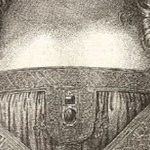
If it’s not over in opera until the fat lady sings, it’s not over in art attributions until the paint dries and the provenance settles. In art historical disputes over the origins (provenances) or conditions (restorations) of art, the weight of academic study and curatorial politics has assumed a greater importance than the dwindling creative/technical expertise of living artists. That this imbalanced dynamic is culturally destabilising, can perfectly be seen in the Leonardo Salvator Mundi Saga. Following a scholar’s recent re-attribution of the Louvre Abu Dhabi Salvator Mundi to Leonardo’s follower, Bernardino Luini, dedicated supporters of the $450million painting are re-writing its provenance in the wake of a second scholar’s newly discovered documents. The painting itself has not been seen since it was sold at Christie’s, New York, on 15 November 2017 and it is not clear when it might be seen again – the Louvre Abu Dhabi indefinitely postponed its planned launch of the painting a day ahead of a visit by the French Foreign Minister, Jean-Yves Le Drian, to mark the announcement of the museum’s programme of events for the next year.
The first question here is stark: Is the picture that was sold for nearly half a billion dollars an entirely autograph painting by Leonardo or a dressed-up school work? The second question is: Had a proper art historical case been made for this painting before it was exhibited in 2011 at the National Gallery as a Leonardo? In our view, the latter had not happened, partly because no attempt had been made, and partly because on a reading of the available historical evidence, the Leonardo case could not be made. On the former question, the Vienna Times reported scholarly concerns on 17 September 2018 (“What Happened With the 450 Million Dollars Painting”):
“Is there anything wrong with the painting that was auctioned at the Christie’s New York in November 2017 for the world record price of 450 million dollars? Experts suspect that the image of Christ had been doctored before sale. When it was exhibited at the National Gallery London in 2011, there were some doubts: the pedantic Leonardo would never have painted the folds of the robe behind the glass ball, ignoring the refraction of the light. At the 2017 auction, the wrinkles suddenly looked ‘right’. In the magazine ‘Art’ the German specialist Prof. Frank Zöllner (62) [The author of the catalogue raisonné Leonardo da Vinci – the Complete Paintings and Drawings] wrote about Leonardo: ‘The question arises whether the restorers responded with a modification of the folds to the objections of the critics.’ So, a manipulation to seduce connoisseurs and drive up the price? Zöllner: ‘An absurdity, if that happened.'”
On the pre-sale re-restoration, see Dalya Alberge – “Auctioneers Christie’s admit Leonardo Da Vinci painting which became world’s most expensive artwork when it sold for £340m has been retouched in last five years” – and our: “The $450m New York Leonardo Salvator Mundi Part II: It Restores, It Sells, therefore It Is.”
WHAT HAPPENED?
From the first this work has been soaked in mystery. Professor Martin Kemp discloses in his latest book Living with Leonardo: Fifty Years of Sanity and Insanity in the Art World and Beyond that it: “crossed Robert’s [Robert Simon] path in 2005 when it came up for sale at a regional auction house in Louisiana. Robert and his fellow New York art dealer Alexander Parrish, who had also noticed it, thought it might be a bit better than it superficially looked – without imagining that it might be the original. They decided to bid by proxy, and met with success, apparently acquiring it for less than $10,000, which at the time would have seemed like quite a high price.” “Apparently”? For how much? How had it been listed? Who sold it? When? Where? Many have searched and no one has found answers but this serially redone as-if-from-nowhere work has been sold twice already – with a different face of Christ each time – for a total of over half a billion dollars, first in a private sale by Sotheby’s in 2013, reportedly for $75-80 million to the owner of a string of free ports who immediately sold it on to a Russian oligarch for $127 million, and then, famously, by Christie’s, New York, for $450million in 2017. Did that initial opacity pass freely through the National Gallery and into the art market food chain? It might seem so: when the painting was taken to the National Gallery for a private viewing by a select group of experts, “All of the witnesses were sworn to confidentiality”, Kemp has disclosed, “and the painting travelled back to New York with Robert. It was becoming a Leonardo.” The invitation to view, appraise and perhaps authenticate flattered: “We are only inviting two or three scholars.”
Kemp believes that the National Gallery had not included another Leonardo attributed work he supports (the so-called “La Bella Principessa” drawing) in the 2011 Leonardo show because the curators did not accept its attribution and he now feels that that rejection had highlighted: “the rationale for the inclusion of the Salvator Mundi. Was it on the market? Would exhibiting it mean that the National Gallery was tacitly involved in a huge act of commercial promotion? It seemed highly likely that it was also ‘in the trade’. All I knew at this stage was that it was being represented by Robert Simon. He told me that it was in the hands of a ‘good owner’ who intended to do the right thing by it, and I did not inquire further. I was keen to consider the painting in its own right, not in relation to its ownership. I speculated, of course, that Robert might have a financial interest, perhaps a share in its ownership; and I assumed he was gaining some kind of legitimate income from his work on the picture’s behalf. But the gallery was assured that the painting was not actively on the market. Understandably keen to exhibit, they were happy to accept this assurance.”
Above, Fig. 1: Part of the Louvre Abu Dhabi Salvator Mundi painting (as shown on television) when it arrived in 2005 (still sticky from a previous restoration) at the New York studio of the restorer Dianne Dwyer Modestini.
Above, Fig. 2: Left, the screen grab of the 2005 state; centre, the picture as exhibited as an autograph Leonardo painting in 2011-12 at the National Gallery ; right, the picture as sold at Christie’s, New York, in November 2017 after further and recent restoration repainting.
Above, Fig. 3: Left, the head as in 2011-12 when at the National Gallery; right, the head in 2017 when sold at Christie’s, New York.
Above, Fig. 4: Left, the face as in 2011-12 at the National Gallery; right, the face as sold st Christie’s, New York, in 2017.
Above, Fig. 5: Top, the eyes after cleaning but before any repainting; left, the face, as in 2011-12; right, the face, as in 2017.
Above, Fig. 6: Far left, the face, as in 2005; left, the face as 2007 after the panel had been repaired and cleaned; centre, the painting in 2008 when taken to London for a private viewing at the National Gallery; right, the face as exhibited at the National Gallery in 2011-12; far right, the face as when sold at Christie’s, New York, in 2017.
GROWING THE PROVENANCE
We had warned ahead of the picture’s 15 November 2017 sale that the provenances compiled by the National Gallery in 2011 and Christie’s, New York, in 2017, were inflated and overly-reliant on the unpublished researches of one of the first consortium of owners (see “Problems with the New York Leonardo Salvator Mundi Part I: Provenance and Presentation”):
“…this work, now unequivocally described as a fully autograph Leonardo painting that is the artistic equal of the Mona Lisa, first materialised in 1900 when bought as by Leonardo’s follower, Bernardino Luini (- it was later taken to be a copy after Boltraffio). That purchase, and what followed immediately afterwards remained in the realm of verifiable facts until the painting went missing [after 1958] before reappearing in 2005. What was suggested to have happened before 1900 is speculation and/or contention. The first reference to such a Leonardo subject is in 1651. Christie’s provides the following provenance:
“(Possibly) Commissioned after 1500 by King Louis XII of France (1462-1515) and his wife, Anne of Brittany (1477-1514), following the conquest of Milan and Genoa, and possibly by descent to
Henrietta Maria of France (1609-1669), by whom possibly brought to England in 1625 upon her marriage to King Charles I of England (1600-1649), Greenwich;
Commonwealth Sale, as ‘A peece of Christ done by Leonardo at 30- 00- 00’, presented, 23 October 1651, as part of the Sixth Dividend to
Captain John Stone (1620-1667), leader of the Sixth Dividend of creditors, until 1660, when it was returned with other works upon the Restoration to
King Charles II of England (1630-1685), Whitehall, and probably by inheritance to his brother King James II of England (1633-1701), Whitehall, from which probably removed by
Catherine Sedley, Countess of Dorchester (1657-1717), or her future son-in-law, John Sheffield, 1st Duke of Buckingham and Normanby (1648-1721), and probably by descent to his illegitimate son
Sir Charles Herbert Sheffield, 1st Bt. (c. 1706-1774); John Prestage, London, 24 February 1763, lot 53, as ‘L. Da. Vinci A head of our Saviour’ (£2.10).
Sir [John] Charles Robinson (1824-1913), as Bernardino Luini; by whom sold in 1900 to
Sir Francis Cook, 1st Bt. (1817-1901), Doughty House, Richmond, and by descent through
Sir Frederick [Lucas] Cook, 2nd Bt. (1844-1920), Doughty House, Richmond, and
Sir Herbert [Frederick] Cook, 3rd Bt. (1868-1939), Doughty House, Richmond, as ‘Free copy after Boltraffio’ and later ‘Milanese School’, to
Sir Francis [Ferdinand Maurice] Cook, 4th Bt. (1907-1978); his sale, Sotheby’s, London, 25 June 1958, lot 40, as ‘Boltraffio’ (£45 to Kuntz).
Private collection, United States.
Robert Simon, New York.
Private sale, Sotheby’s, New York.
Acquired from the above by the present owner
Pre-Lot Text
Property from a Private European Collection
“Thus, from a claimed execution either before or after 1500 (the supporters are divided on a possible position within Leonardo’s oeuvre) it is said to have passed through four centuries via a ‘(Possibly) Commissioned’; ‘Possibly by descent’; ‘by whom possibly brought to England’; ‘probably by inheritance’; ‘from which probably removed’; ‘and probably by descent’ to 1900. It then took a further 111 years for this work to gain accreditation as a Leonardo when it was included in the National Gallery’s special exhibition Leonardo, Painter at the Court of Milan after a long and highly problematic restoration.” Emphases added.
On 2 February 2018, in “The $450m New York Leonardo Salvator Mundi Part II: It Restores, It Sells, therefore It Is”, we held the National Gallery’s 2011 provenance to have been similarly problematic:
“This Leonardo ascription has been made on almost no published scholarship. It rests on a largely unstated and, therefore, unexamined art critical case. Apart from the restorer’s report and the National Gallery exhibition catalogue’s entry by its curator, Luke Syson, almost nothing, so far as we know, has been published in support of this Leonardo. Christie’s lot essay appealed to the authority of the unpublished researches of one of the original owners, Dr Robert Simon, a New York art dealer, and to [the restorer] Diane Dwyer Modestini’s and Syson’s accounts when they, too, both acknowledged indebtedness to the researches of Simon. After twelve years, serial restorations and two sales at a combined total of over half a billion dollars, those researches have yet to be published… Luke Syson writes:
“‘The re-emergence of this picture, cleaned and restored to reveal an autograph work by Leonardo, therefore comes as an extraordinary surprise’ but, he adds, of Wenceslaus Hollar’s engraved testimony: ‘None of this, of course, is evidence for the picture’s autograph status. After all, the pictures by pupils copying Leonardo’s design may sometimes have been rather good, and one such might easily have been owned by Henrietta Maria.’ Quite so, and in view of Jacques Franck’s account [that Leonardo had not painted a prototype Salvator Mundi because he was otherwise engaged and devolving painting to his studio – see below] … that very possibility, as advanced by Ludwig Heydenreich, is the first mountain that any autograph Leonardo Salvator Mundi aspirant must be seen to have scaled. It is now six years since Syson alerted us that ‘This discussion anticipates the more detailed publication of this picture by Robert Simon and others’ but he gave little indication of any corroborative evidence being to hand. It would sometimes seem that Simon’s researches on the New York candidate echo or adapt the extensive researches earlier conducted by Joanne Snow-Smith in her support of the unsuccessful Paris candidate, the so-called de Ganay Salvator Mundi. If Syson should prove to have been a dutiful student of Simon we might be in for a daisy-chain of hypotheses in which awkward and peculiar features are advanced as material corroborations with rhetorical flourishes. Syson ends his account thusly:
“’Snow-Smith has shown that King Louis XII and his consort, Anne of Brittany, were particularly devoted to Christ as Salvator Mundi, and that they could connect this cult with the Mandylion of Edessa twice-over we now see. Given the date – around 1500 – of Leonardo’s preparatory drawings [only two sheets of drapery studies, one of which is thought not to be entirely autograph], the style of the picture and its association with a French princess [Charles I’s queen, Henrietta Maria], Louis and Anne become the most likely patrons for Leonardo’s Salvator Mundi, probably commissioning the work soon after the conquest of Milan and Genoa. This would therefore be one of the French commissions mentioned by Fra Pietro da Novellara. And it was perhaps to accommodate their wishes that Leonardo based Christ’s features, the set of the eyes, the heavy lower lids, and especially his smoothly arched eyebrows [sic] down into a long nose, on the Christ of the Mandylion of Edessa.’”
“How can you extract a ‘would therefore be’ from a ‘could’, a ‘most likely’, and a ‘probably’? In lieu of a single hard shiny fact, we are offered a forest of fancies, maybes, perhaps’s and scholarly borrowings.” Emphases added.
THE FRA PIETRO DA NOVELLARA CONNECTION
When Luke Syson claimed that the now-Louvre Abu Dhabi Salvator Mundi had “therefore been” one of the French commissions by King Louis XII and his consort mentioned by Fra Pietro da Novellara he risked readers confounding his “therefore” with a proof rather than a contention. In a footnote, Syson cites paintings (of only recent provenances) that “must also” have derived from this Royal commission. One, the Young Christ by Marco d’Oggiono in the Galleria Borghese, Rome, is discussed below at Fig. 14. On the precise testimony of Fra Pietro da Novellara, see Jacques Franck, below.
ALL CHANGE
When the Leonardo scholar Matthew Landrus recently contended that most of the upgraded Salvator Mundi was painted by Leonardo’s assistant, Bernardino Luini (the very artist under whose name the secure provenance began in 1900 – see “Leonardo scholar challenges attribution of $450m painting” and “Salvator Mundi: Why Bernardinino Luini should be back in the frame”) he was disparaged by his former teacher, Martin Kemp, at the Edinburgh Festival, and on CNN, who reported:
“Others are in less doubt. Curator of Italian Paintings at London’s National Gallery [sic], Martin Kemp, sent the following statement to CNN Style by email: ‘The book I am publishing in 2019 with Robert Simon and Margaret Dalivalle (…) will present a conclusive body of evidence that the Salvator Mundi is a masterpiece by Leonardo. In the meantime I am not addressing ill-founded assertions that would attract no attention were it not for the sale price.’”
Kemp’s disinclination to address “ill-founded assertions that would attract no attention were it not for the sale price” marked a change of policy and showed a touch of humbug. Last year, immediately ahead of the sale that produced the astronomical price of the Salvator Mundi, Kemp engaged polemically with those who rejected the picture’s Leonardo attribution: “I was approached by the auctioneers to confirm my research and agreed to record a video interview to combat the misinformation appearing in the press – providing I was not drawn into the actual sale process.” As for the long-forthcoming Book That Will Answer All Doubters, its co-authors failed to meet a Yale University Press deadline to publish in time for the 2011-12 National Gallery Leonardo show, in part, Kemp now discloses, because “I was unconvinced that all the authors actually had anything to say.”
THE JEREMY WOOD WALPOLE SOCIETY FINDINGS
Certain discoveries in Jeremy Wood’s Walpole Society article “Buying and Selling Art in Venice, London and Antwerp… c.1637-52” have thrown the earlier Salvator Mundi provenances of the National Gallery and Christie’s, New York, into question. Because so much credence is (rightly) attached to documentation, the sudden discovery of a parallel never-seen but documented ghost painting has undermined official accounts of the Louvre Abu Dhabi picture’s history. Within a single country at the same historical moment there are now two records of a Leonardo painting in the Collection of Charles I and two records of a Leonardo Salvator Mundi painting in the (nearby) Hamilton collection. With the Charles I collection, the first record is in the 1649 inventory of Charles I’s possessions drawn up in the year of his death. It is not of a Christ as Salvator Mundi but was recorded simply as ‘A peece of Christ done by Leonardo’ when sold in 1651. It tells us that Charles I had had a painting of that description but not when or how it had been acquired. The second and later record of 1666, as disclosed in Martin Kemp’s new book, is a work in the numbered list of the “King’s Closet” in Whitehall and “featured as number 311: ‘Leonard De Vince O.r Savio.r w.th a gloabe in one hand & holding up y.e other’.” Today, thanks to Wood’s researches those two records are balanced by the discovery that a ‘Christ with a globe in his hande done by Leonardus Vinsett’ was in the Chelsea home of James, 3rd Marquis, later 1st Duke of Hamilton, between 1638 and 1641. A second record further testifies to a Salvator Mundi in the Hamilton collection in 1643, as is discussed below.
The four records of two Salvator Mundis attributed to Leonardo in two important collections might be taken to show that two Leonardo Salvator Mundis co-existed in England at that time. But records of two Leonardo Christs cannot safely be taken to confirm that two Leonardo paintings of Christ were present in England. Nor need it mean that one painting was a Leonardo and the other not – they might both have been misattributed. Max Friedlander warned that “The inventories of princely galleries – such as those of Margaret of Austria, Vicereine of the Netherlands, or of King Charles I of England…are to be utilized sceptically and to be taken seriously only to the extent that facts derived from style criticism do not contradict them.”
LEONARDO HAD NO TIME TO PAINT
In part the destabilisation stems from an emerging contrast between the unexpected abundance of records in mid-seventeenth century England of an attributed Leonardo picture and the complete absence in early sixteenth century Italy of any record or mention of a Leonardo Salvator Mundi. Not only is there no documentary record of Leonardo ever having painted a Salvator Mundi prototype, in material/visual terms, there are no characteristically faithful copies of the kind executed from such autograph Leonardo paintings as the Mona Lisa and The Virgin and St. Anne. The day before the 15 November 2017 sale at Christie’s, New York, we contrasted that marked absence of copies with the plethora of variants (more than twenty) of a Leonardesque Salvator Mundi – all of which seemingly derive from little more than a couple of drapery studies that have been attributed to Leonardo. This might all indicate, as Heydenreich had concluded after a most exhaustive study, that while Leonardo – a notoriously fastidious and slow artist – had made drawings for his school, he had not painted a Salvator Mundi. We reported then that Jacques Franck, the expert of Leonardo’s painting techniques and a restoration adviser to the Louvre, had noted that the logistics of Leonardo’s life at the time were known to have made painting all but impossible:
“By 1500 onwards, the period in which the painted panel is said to have been executed, for want of time Leonardo produced few works. Fra Pietro da Novellara, who visited his studio in April 1501, reported: ‘His mathematical researches have so much distracted him that he can’t stand the brush’, and, he added, ‘Two of his pupils make copies to which he adds some touches from time to time’. In 1501, he was commissioned to produce a ‘Madonna of the Yarnwinder’ by Florimond Robertet (the French King Louis XII’s secretary) at the time when he was already creating both the major group ‘The Virgin and Child with Saint Anne’ and the phenomenally accomplished ‘Mona Lisa’. Both panels were seen during their executions in October 1503 by Agostino Vespucci, an assistant of Machiavelli at the Signoria in Florence but he, too, made no reference to a Salvator Mundi. Giorgio Vasari says of the ‘Mona Lisa’s’ execution that Leonardo, as a meticulous and slow-working painter had ‘toiled over it for four years’. Between May and August 1502 until early 1503 Leonardo was committed with Cesare Borgia as an architect and general engineer in the Marches and Romagna. He was then fully employed by the City of Florence during the Summer of 1503 as a military architect and, two or three months later, he worked fully on the commission of a huge mural (the now destroyed ‘Battle of Anghiari’) until late May 1506, before travelling between Florence and Milan up to mid 1508, because of his appointment as painter and engineer to the French King while serving Charles II d’Amboise, the new governor of Milan. Because of such taxing commitments – and all of the above were in addition to his intense scientific researches and literary activities – Leonardo increasingly resorted to workshop productions from 1500 onwards. The ‘Salvator Mundi’ must, of necessity, be thought to be one of those works and, given the preceding it is very likely that a fully original version never existed.”
That was then. Franck was speaking from memory. He has now revisited the source and adds:
“Novellara’s text says (letter to Isabella d’Este of 14 April 1501): “…if he could free himself from his obligation to His Majesty the King of France without disgrace, as he hopes to do within a month at the most, he would be ever so ready to serve your Excellency more than anyone else in the world” (“…se si potea spiccare da la maestà del Re di Franza senza sua disgrazia, como sperava, a la più longa fra meso uno, servirebbe più presto Vostra Excellentia che persona al mondo”). In the two letters written by Fra Pietro to Isabella on the 3rd and 14th April 1501, this is the only mention regarding Leonardo’s commitment with the French King. No mention that the “obligation to the King” in question is a painting. The other French commission described very precisely by Isabella’s emissary in Florence is the small devotional Madonna painted for Florimond Robertet, the King’s secretary (the Madonna of the Yarnwinder). But it wasn’t a royal commission. Another painting described in this famous correspondence is the Saint Anne in its preliminary graphic stage (cartoon): Novellara does not say who commissioned it. In other words, no hint about a Salvator Mundi, even as a possibility, to be connected to Louis XII and Anne of Brittany in Novellara’s above-mentioned letters.”
AN ATTEMPTED PROVENANCE SWITCH
The response of the supporters of the Abu Dhabi painting to Jeremy Wood’s disclosure of twin records of a rival candidate painting of a Christ with a globe in the Hamilton collection is concerning. Margaret Dalivalle, a former Martin Kemp student who has been conducting provenance research for some years on the Abu Dhabi picture, seems to have been the first properly to spot the potentially game-changing significance of Wood’s research findings. Alison Cole, the editor of the Art Newspaper, reported on 30 August (- “Leonardo’s Salvator Mundi: expert uncovers ‘exciting’ new evidence”) that Dalivalle finds Wood’s discovery of the Hamilton picture “exciting” and says “I immediately recognised the significance of one item hanging in the Lower Gallery: ‘Christ: with a globe in his hande done by Leonardus Vinsett’”.
However, before any open scholarly discussions and evaluations of the two now-rival recorded candidates have taken place, Dalivalle has placed this reading on that most significant finding:
“The painting was in a collection closely, almost incestuously, related to the Royal Collection; the king, according to a document of 18 October 1638, expressly wished to have the pick of paintings bought by Hamilton in Venice, threatening the imposition of customs duty, and the king and queen’s predilection for Leonardo is documented. Therefore, I consider there is a strong possibility that this painting was seen at Chelsea House and chosen by the king at some point between 1638 and 1641, finding its way to the queen’s apartments at Greenwich.”
Thus, the Hamilton picture would now find itself located in the royal collection as an earlier incarnation of what is held to be the Abu Dhabi Leonardo picture. In the absence of any visual records such a switch might be thought plausible on circumstantial grounds but the suggestion is made against the testimony of another Wood document that makes clear that the painting could not have been purloined by Charles I between 1638 and 1641.
THE WOOD/HAMILTON DOCUMENTS
Pace Dalivalle’s reading of the earlier document, Wood discloses that in 1643 Hamilton’s collection was crated in order to be sent to Scotland. The move was blocked in Parliament but one case contained a “Christ Holding up his two fingers.” A Christ with two fingers held up in blessing testifies no less to a Christ as Salvator Mundi than does a Christ with a globe. That the picture was in Hamilton’s possession as late as 1643 makes a subsequent transfer to the royal collection greatly less likely: the following year the Queen (Henrietta Maria) and the copyist Wenceslaus Hollar both fled to Antwerp. Was Charles I seizing paintings at that turbulent moment – even assuming that the Hamilton pictures had been un-crated? In any event, we have a doubly confirmed Hamilton Salvator Mundi in 1643 – just six years before the first record of a Leonardo in the Charles I collection. Either two attributed Leonardos ran in parallel or the Hamilton picture was snatched for the royal collection shortly before the execution of Charles I. Because there is no record of a switch between 1643 and 1649 does not, of course, mean that it could not have taken place but much hangs on the question.
While leaving the question open, Alison Cole has pointed out (re Hollar’s 1650 copy of a Salvator Mundi) that there is another possibility:
“Wood and Dalivalle have also discussed other possible hypotheses… After James Hamilton’s execution in 1649, his brother, the 2nd Duke, transported a large portion of his collection to the Netherlands to be sold. Could Hamilton’s Salvator Mundi have been part of this consignment, and could this explain the “how and the why” Hollar etched it “from the original” in Antwerp at that precise time? (Indeed, in 1649 and 1650, Hollar made a number of etchings after Italian paintings that were available to him in the original.)”
That would be to say: the twice-recorded Hamilton Salvator Mundi then stayed in the collection after 1643 until it was sent to Antwerp to be sold in 1649, the year of Charles I’s execution. This possibility is being dismissed: Cole further reports that Dalivalle places this hypothesis among what she terms the “red herrings” to be addressed in her contribution to the long-forthcoming (now Oxford University Press book) Leonardo’s Salvator Mundi and the Collecting of Leonardo in the Stuart Courts that she is co-authoring with Robert Simon and Martin Kemp. That dismissal is premature and question-begging. It also offers a degree of protection to the now-challenged claim that the Abu Dhabi picture had been copied in 1650 by Wenceslaus Hollar – see below.
THE END OF THE FRENCH ROYAL CONNECTIONS IN THE SALVATOR MUNDI PROVENANCE
For the Louvre Abu Dhabi picture’s supporters, situating the Hamilton picture within the royal collection would compensate for the loss of the painting’s supposed French royal origins in the official provenances. Margaret Dalivalle, in talking to the Art Newspaper , has now disclosed that:
“I have found no evidence that the Salvator Mundi was brought by Henrietta Maria from France; it belonged to her [only] by dint of the fact that it was recorded in a property of her jointure in 1649.”
As seen, it has not been established that the Hamilton Salvator Mundi had entered the royal collection at all. The previously suggested arrival of the painting at court with Henrietta Maria in 1625 had comprised the lynchpin of the Abu Dhabi painting’s 2011 and 2017 provenances – those supposed initial double royal connections were flaunted in Christie’s 2017 global marketing pitch (see – The Leonardo Salvator Mundi Saga: Three Developments).
In the 2011-12 National Gallery exhibition catalogue Luke Syson said (of the copyist Wenceslaus Hollar) “The several connections with the Queen suggest that the Salvator Mundi is likely to have come to England when she married Charles in 1625, and was originally the property of the French Royal family; several of the best copies have a French provenance.” Emphases added. There were multiple problems with that account. First, the above described absences of records in Italy. Second, the nature of the visual testimony of the Hollar copy, as discussed below. Third, the now Dalivalle-confirmed absence of any evidence that Henrietta Maria had previously owned and brought a Leonardo Salvator Mundi with her from France when she married Charles I in 1625. In consequence, the opening sequence of Christie’s 2017 provenance below evaporates:
“(Possibly) Commissioned after 1500 by King Louis XII of France (1462-1515) and his wife, Anne of Brittany (1477-1514), following the conquest of Milan and Genoa, and possibly by descent to Henrietta Maria of France (1609-1669), by whom possibly brought to England in 1625 upon her marriage to King Charles I of England (1600-1649)…
Without the previously implied royal pedigree the open question of when or whether the Hamilton painting entered the royal collection becomes pressing, because, as Martin Kemp ackowledges, despite all Dalivalle’s researches, nothing links the Abu Dhabi Salvator Mundi painting to anything beyond the painting’s entry into the Cook collection in 1900:
“We could not be absolutely sure that Charles’s Leonardo was the same as ‘Robert’s’ [Robert Simon and others’] Leonardo, rather than one of the copies, but it seemed highly likely. Margaret was subsequently able to track the picture back to the beautiful Queen’s House in Greenwich, where it was in one of the ‘closets’ of Queen Henrieta Maria…she was also able to track its later history though not yet as far as the Cook collection.”
The Greenwich record was dated 1666 when Henrieta Maria had fled England in 1644. Whichever picture was then present, it could not have been copied by Hollar in his 1650 etching because he and Henrietta Maria were then in Antwerp (and perhaps later, on one account, in France), and for reasons given it was unlikely to have been the Abu Dhabi picture. In truth, we have no idea which of several possible paintings was recorded by Hollar.
Without a secure Hollar connection, the Abu Dhabi Salvator Mundi’s provenance begins only at 1900, four centuries after its supposed execution. The pre-1900 history which Dalivalle has failed to establish is itself highly problematic. It is not known from whom, where or when the picture had been acquired by Sir Charles Robinson who bought the work as a Bernardino Luino for the Cook Collection. We have been informed (as has Robert Simon) that an English fossil-hunter, Thomas Hawkins (1810-89), seems to have donated a “Leonardo Salvator Mundi” in 1848 to a church in Birmingham. That church was closed down in 1895, at which date its collection was presumably disbursed. Had Robinson bought the Abu Dhabi picture from that church? Or, were there two claimed Leonardo Salvator Mundi versions then at large in England? Or three – the whereabouts of a third version formerly in the Worsey and Yarborough Collections is presently unknown…
The Cook collection picture’s provenance ran into the ground in 1958 when sold by Sotheby’s for £45. Between 1900 and 1958 no one thought the New York, now Abu Dhabi Salvator Mundi to be a Leonardo. Christie’s 2017 sale provenance ended: “Kuntz, Private Collection USA”. Kemp suggests that this might have been a punning play on the German word for art, and Sotheby’s have no additional information on Kuntz. That trail should not be given up lightly.
Wiki has an entry on a US artist Roger Edward Kuntz, a talented painter who wavered between abstraction and representation and died in 1975. In the early 50s he and his wife travelled for four months in Europe so that he could visit museums. They had a daughter in 1951. If Kuntz, an artist with a “pensive, thoughtfully naturalistic sensibility” made another European trip in 1958, might he have had £45 (at that date about a month’s wage for an unskilled worker in Britain) to spare on an old Italian painting? Roger Kuntz died in 1975 but was succeeded by his wife and daughter. If not that particular Kuntz family, what of others in the United States? As previously reported, our colleague Alexa Tzarnas has identified a Kuntz family in Louisiana who used to be avid collectors of paintings, antiques and historical documents. Rosemund E. and Emile Kuntz had two sons, one of whom donated a majority of their collection to Tulane University in New Orleans. Given that we do not know the identity of the 2005 vendor or the venue of the sale and given the still sticky varnish then present on the New York/Abu Dhabi Salvator Mundi, it could be useful to establish the identity of the previous owner who might well have information on previous restorations and photo-records of the painting from 1958 onwards.
THE WENCESLAUS HOLLAR 1650 ETCHING OF THE LEONARDO SALVATOR MUNDI – AND THREE PROPOSED PAINTINGS THAT MIGHT HAVE PROVIDED THE MODEL
Above, Fig. 7: The Wenceslaus Hollar etching which carries in (Latin) the following inscription: “Leonardo da Vinci painted the original from which Wenceslaus Hollar etched [this copy] in 1650 Anno Domini”
The Hollar copy (above) is being treated today as if unquestionably a record of the painting in the collection of Charles I but certain difficulties with this assumed relationship were acknowledged by Luke Syson:
“Hollar must have made a drawing of Leonardo’s painting while he was still in England, when it still belonged to the King and Queen. This drawing then formed the basis of the print, an image that had come to have additional associations for the Catholic Henrietta Maria.” Emphases added.
Against Syson’s suggestion that Hollar had made a drawing before 1644 and taken it with him to Antwerp, keeping it for at least six years before making an etching from it in 1650, we return to the Alison Cole/Jeremy Wood hypothesis that the Hamilton Salvator Mundi had been among the large proportion of the collection sent to Antwerp to be sold in 1649. On this proposed account Hollar would have had no need to work from a six or more years old drawing at a time when he was making copies of other Italian paintings in Antwerp. The inscription on the etching itself suggests that it was made from the painting itself rather than from memory and an old drawing:
“Leonardo da Vinci painted the original from which Wenceslaus Hollar etched [this copy] in 1650 Anno Domini”.
Before looking at the etching itself in relation to rival paintings with a view to formulating some “style criticisms”, there is a third candidate Salvator Mundi painting to be considered. That is the so-called “de Ganay Salvator Mundi” which painting was presented in 1978 and 1982 as the original Leonardo Salvator Mundi by the art historian Joanne Snow-Smith (with, it was posthumously stated, the endorsement of Ludwig Heydenreich). Its claims merit consideration if for no other reason than that aspects of Snow-Smith’s account have been incorporated in the Simon/Syson/Christie’s/Kemp accounts – and most especially her claim of French royal origins for the painting. Moreover, the de Ganay and the Abu Dhabi versions are the two Salvator Mundi paintings that offer the most credible “fits” with the 1650 image produced by the accomplished draughtsman/copyist Wenceslaus Hollar. As will be seen, neither version achieves a full match but they depart from the Hollar record in different ways.
In support of her attribution Joanne Snow-Smith suggested this chronology:
“1506 – Leonardo’s second Milanese period begins upon return to Milan at invitation of Louis XII. Active at the court of Charles d’Amboise, the French governor of Milan;
1507 – Louis XII in Milan with Jean Perréal, his court painter. Leonardo appointed painter and engineer to the King;
c. 1507-08 – Commission for the Salvator Mundi given to Leonardo by Louis XII;
c. 1510 – Preliminary drawings in red chalk on red-prepared paper for a Salvator Mundi, now at Windsor Royal Library, begun;
1510-13 – Salvator Mundi in Leonardo’s studio in Milan. Copies made by pupils in various stages of completion;
1513, Spring – Salvator Mundi completed by Leonardo by order of Louis XII. Given to French general for delivery to Louis XII in France;
[…] 1514 – January 9, Anne of Brittany, beloved wife of Louis XII, dies at Blois. The King presents Leonardo’s Salvator Mundi to a Franciscan convent of the Order of Saint Claire in Nantes as votive funerary offering for her soul. Painting remains cloistered until late 19th-early 20th century…”
In support of her claim of a French-owned painting as the subject of Hollar’s etching, Snow-Smith imagined a trip along the Loire by Henrietta Maria:
“There were along the course of the Loire convents of the Order…and making such a trip may well have been suggested to Henrietta Maria by…further impetus for a journey to Nantes would have been supplied by the fact that her mother, Marie de’ Medici, had in 1626 laid the cornerstone of the convent there. It is suggested that Henrietta Maria requested Hollar to accompany her in the role of court etcher. There is no question but that his sense of duty to the family he loved so well would have induced his acceptance. Whether they stayed in Nantes in the convent of the Visitation or of the Calvairiennes need not concern us. Suffice it to say that in either place she would have heard of the Salvator Mundi by Leonardo cloistered in the Clairician convent in that city…and it would certainly be understandable that she…would have wished Hollar to copy for her a painting in which the kindness and love of the ultimate justice were expressed with such strength, tenderness and pathos…” Emphases added.
Even if we discount Snow-Smith’s imaginary journey, Hollar’s presence in France in 1650 is credible – his etchings were published in Paris. Given Hollar’s close connections with Henrietta there are thus two locations in which he might have etched the Salvator Mundi – Antwerp or Nantes. In Antwerp, he might conceivably, on Syson’s account, have made it from a drawing made in London six or more years earlier if a salvator Mundi had entered the royal collection before 1644, or from the Hamilton Salvator Mundi; or, in Nantes from the de Ganay Salvator Mundi.
With the Abu Dhabi Leonardo attribution the etching’s testimony is double edged: there are, for sure, clear general correspondences – as there are with the de Ganay version – but Hollar’s 1650 recording of painting of a Christ as Salvator Mundi is different in significant stylistic respects from the Louvre Abu Dhabi picture. Greatly compounding the problem today of plausibly attaching rival documentary records and accounts to the sole etched copy, is the fact that the Abu Dhabi painting has itself borne rival appearances since it emerged in 2005 – and has existed in two distinct states in the last five years. As seen at Fig. 6 above, those appearances are: the painting as it was when it first appeared in 2005 still sticky from some previous treatment; as it was in 2007 after being cleaned and repaired; as it was in 2008 when part-restored and first taken to London for appraisal by a select group of Leonardo experts; as it was when further repainted and taken back to London in 2011 to be included in the National Gallery Leonardo exhibition; and, as it was when yet further restored by Christie’s ahead of the November 2017 sale.
This shifting appearance poses an acute problem for supporters: with which state/version of the Abu Dhabi picture might the Hollar etching be considered to show a better correspondence? Is it that seen when exhibited at the National Gallery in 2011-12, as below left at Fig. 8? Or is it that seen at Christie’s, New York, in 2017, as below right at Fig. 8? If the latter, had Christie’s requested the original restorer to work further on the painting to that end?
“STYLE CRITICISMS” AND CERTAIN VISUAL DISPROOFS
Above, Fig. 8: Top, Leonardo’s face of St. Anne (on the Louvre’s The Virgin and St Anne with Child), before cleaning, left; after cleaning, right; above the Louvre Abu Dhabi face of Christ, left, as exibited at the National Gallery in 2011-12, and, right, as when sold at Christie’s, New York, in 2017
In the double comparison above we see the destructive and reconstructive faces of picture restoration. At the top, pictoral values are depleted by cleaning (“abraded” is the commonly encountered official euphemism). In the before and after comparison of the Salvator Mundi we see the superimposition of a more marketable state by repainting (officially, “retouching”) an earlier National Gallery endorsed appearance. The extent of this pictorial transformation is only demonstrable because the long 2007-2017 restoration was temporarily halted to allow the painting to rub shoulders with Leonardo and others at the National Gallery in 2011-12.
Above, Fig. 9: Left, the de Ganay Salvator Mundi; centre, the Wenceslaus Hollar etched copy; right, the Abu Dhabi Salvator Mundi.
While both above paintings depart from the Hollar copy, they do so differently. Such variations speak against the Abu Dhabi painting being an original autograph prototype for all others. In one respect, Hollar comes close to recording a unique feature of the Abu Dhabi picture – the closely cropped composition around the hand holding the orb in the bottom right-hand corner of the composition – see Fig. 11. Against that local similarity, the Abu Dhabi picture departs from Hollar (and all other painted versions) with its aberrantly wide, chipmunk-like face. In every other version, Christ has a long narrow face that tapers downward from the widest point at about the level of the eyes. Uniquely, the Abu Dhabi face is widest at a level a little above the mouth. It also lacks the pronounced beard that was recorded by Hollar and is widely encountered among the variants. Such icongraphic deviations make it inconceivable that the Abu Dhabi picture was recorded by Hollar in 1650.
Above, Fig. 10: Top, left, the 1650 Hollar etching; top, right the Louvre Abu Dhabi Salvator Mundi, as it was when exhibited at the National Gallery in 2011-12. Above, left, a portrait of Henrietta Maria by van Dyck; above right, a copy by Hollar of a similar van Dyck portrait of Henrietta Maria.
When comparing etchings to paintings allowances have to be made for restoration injuries and falsifications to the latter and for the fact that copyists do not make “photographically” accurate facsimiles. Nonetheless, claims that Hollar’s copy was made from the Abu Dhabi painting are insupportable. In his 2011 catalogue entry, Luke Syson acknowledged that “the fit” between the print and the painting was not a complete one:
“It has always seemed likely that Leonardo painted a picture of Christ as the Saviour of the World. In 1650 the celebrated printmaker Wenceslaus Hollar signed an etching of Christ raising his right hand in blessing, holding a transparent orb in his left, with a nimbus of light behind his head: the image was taken he states, from a painting by Leonardo. Though Hollar was generally well-informed, this would not be enough on its own to prove that an autograph picture by Leonardo had once existed…Though Hollar’s Christ is very slightly stouter and broader, the two images coincide almost exactly. The draperies are just a little simplified and there is no glow of light around Christ’s head. Otherwise the newly discovered painting has the same…etc.”
Hollar recorded three sources of light in the picture he copied, not the single ineffectual one encountered in the Abu Dhabi painting. Hollar’s overall disposition of tonal values is greatly more vivacious and lucid. Light falling on Christ from above left creates a consistent shift from the (viewer’s) brightly lit left side of Christ to his shaded right side. Variations of shading on the drapery at Christ’s left shoulder cause the figure to turn away from the viewer and recede into shadow. Christ, emits his own illumination. So does the globe as light accumulates around its circumference. The inner fold on the drapery of Christ’s raised arm casts a shadow on the tunic’s folds. In Hollar a clear, plastically expressive distinction exists between the arm’s draperies and the tunic. Throughout, Hollar recorded a progressive disposition of lights and darks to establish form and space. Although the above Hollar van Dyck copy is not taken from the adjacent van Dyck painting it demonstrates how faithfully Hollar captured Henrietta Maria’s mouth’s upturned corners. Had he made his copy from the Abu Dhabi picture, would he have turned the corners of Christ’s mouth upwards? On the superiority of the print over the painting in 2011, see below. But first, hear Leonardo on his lights and shades:
“The primary purpose of the painter is to make a plane surface display a body in relief, detached from the plane, and he who in that art most surpasses others deserves most praise, and this concern, which is the crown of the science of painting, comes about from the use of shadows and lights, or, if you wish, brightness and darkness. Therefore whoever avoids shadows avoids what is the glory of the art for noble minds, but gains glory with the ignorant public, who want nothing in painting but the beauty of colour, altogether forgetting the beauty and marvel of depicting a relief on what in reality is a plane surface.”
Above, Fig. 11: Left, a detail of Hollar’s 1650 etching; right, a detail of the Abu Dhabi Salvator Mundi as it was when offered for sale by Christie’s, New York, in November 2017.
It strikes again how greatly more vivacious and lucid is the etched copy than the Abu Dhabi painting. It might be objected that painters work on a larger scale and have greatly more pictorial weapons at their disposal than the tones of etchers who must say everything with monochromatic drawing and shading. But, as seen, Leonardo embraced such pictorial self-restraint as the most precious tool in the painter’s box.
We mentioned the coincidence of design and composition in this section of the painting: the knuckles of the hand rest in both cases on the bottom of the composition and the protruding thumb seems equally constrained. Those coincidences notwithstanding, even in this section the differences are legion. In the painting the thumb is cropped at the picture’s edge – and not because the picture was trimmed. The panel had been set in its frame and only then prepared for painting, as a build-up of priming and paint along the edge testifies. Whoever painted this picture was careless with its design. It is possible that the artist had transferred a cartoon onto a too-small painting and ran out of space along the right-hand edge. This Salvator Mundi figure is not just cropped above the waist as are a number of Leonardo figures, it is also severely cropped on both sides. Such a design would not be shocking in our age of photography but it was unprecedented in Leonardo’s own finished work. While there are similarities in this corner, they are confined to the design alone and not to the content within.
Uniquely, in Abu Dhabi picture the visible palm of the globe-supporting hand is massive and anatomically indeterminate. Professor Kemp holds that this unclarity is a pentimento and, hence, a token of authenticity. But the hand was drawn differently in all other versions, including Hollar’s. Everywhere else it is optically compressed towards the circumference of the globe. Why would every school work have thus made Leonardo’s clumsily drawn effort more optically sophisticated? Why did everyone else “correct” the drawing of the thumb by placing it on a diagonal, not horizontal, axis? The prevalent top left down lighting caused three reflections in a diagonal row on the surface of the globe Hollar copied. The globe itself (necessarily one of glass on that scale, not of polished rock crystal, as Kemp insists) is radiant in Hollar: dark at its centre and with light accumulating around its circumference. Kemp remarks that he has “been asked on more than one occasion why the drapery behind the sphere is so little affected by what is in effect a large magnifying lens.” He answers that Leonardo would not have concerned himself with such natural phenomena out of respect for “decorum – that is to say pictorial good manners”. It is a stylish answer but it ignores a point I had made when the National Gallery exhibition opened (“Leonardo viewed in a curious light”, letter, The Times, 12 November 2011). Namely, that in Hollar’s copy “the folds of the drapery on Christ’s left shoulder are shown to be bent when viewed through the glass sphere.” Kemp’s ex cathedra pronouncement collides with the artistic/material facts of a work of art. This is not a question of what Leonardo would or would not have done. It is a question of what Hollar did when copying a painting he believed to be a Leonardo. As previously published and shown below, in Hollar the sweeping curve of a fold on the shoulder drapery is seen to be deflected inside the globe – and a shift of direction in a drawn image cannot be gainsaid: if a convex fold of drapery becomes concave while seen through a glass orb, that is a graphic fact, not a possibly, a perhaps, a likely or maybe. If Hollar had been copying the Abu Dhabi painting, why would he have rendered a sophisticated optical phenomenon that was not present in the painting before him?
Above, Fig. 12: Left, an illustration of a rock crystal sphere in Martin Kemp’s book Living with Leonardo; right, the globe in the now lost Salvator Mundi that was formerly in the Worsey and Yarborough Collections, England.
Kemp writes that the most satisfactory facet of his own research concerned his hunch the globe was made of rock crystal. He looked at specimens of crystal spheres – all small – and realised that large crystal spheres would “exhibit both inclusions and jagged cleavage planes, compromising the ‘purity’ for which the best crystal is prized.” On the abnormally large hand seen through the globe, he writes:
“I had toyed with the idea that the double image of the of the heel of Christ’s right hand [sic] visible through the sphere might be the result of the double refraction characteristic of rock crystal; but the optics would not work. The apparent doubling is almost certainly another pentimento.”
The above crystal sphere Kemp examined at Oxford University’s Museum of Natural History was under two inches wide and therefore “quite large as such spheres go”. Reproducing the lighting direction in the Abu Dhabi picture had confirmed that there should have been (as there is in Hollar) a shiny highlight in the upper left:
“He is unlikely to have left this out, and it seemed likely that the raised area of white pigment had been abraded off at some point in the painting’s chequered history.”
Above, Fig. 13: In the top row diagrams we see, left, how, in Hollar, the globe’s reflected lights are aligned with the directional lighting and not as found in the 2017 state of the Abu Dhabi picture on the right. We see on the left (black dotted line) how the sweeping curved fold of drapery is deflected when viewed through the globe. While Kemp says that the original properly placed highlight on the globe must have been abraded off, he offers no explanation for the three randomly placed, unaligned “reflections” that emerged during the cleaning. If they were not added during the past restoration they must have been painted out previously. As seen in the television screen-grab at Fig. 1, there was no trace left in place of any impastoed white reflections when the painting was presented for restoration in 2005. One correspondent (Dr. Stefaan Missinne) has suggested that the three present lights were a depiction of a cluster of stars seen in the Southern hemisphere that had been noted in Italy in 1503. If these now miraculously recovered lights had been integral to the Abu Dhabi painting all along, they too would indicate that Hollar had made his 1650 copy from some other painting. Curiously, an alignment of lights like that seen in Hollar is present in the now lost Salvator Mundi that was formerly in the Worsey and Yarborough Collection in England (as seen above at Fig. 12).
Our glass sphere shown above is also no more than two inches in diameter. In the lower image above it rests on the photocopied sheet of diagrams that is shown here above, top. The white space between the two copied images on the sheet appears as two curving lines when viewed through the globe. We can see here how the differing degrees of refraction depend on the position within the globe. The curvature is least pronounced at the globe’s centre and increases as it approaches the circumference. The deflection on the drapery that was recorded in Hollar’s etching is consistent the distortions in evidence in the glass sphere above.
Above, Fig. 14: Left and centre, The Young Christ by Marco d’Oggiono in the Galleria Borghese, Rome, as seen before and after restoration; right, Marco d’Oggiono’s The Young Christ in the Fundación Lázaro Galdianiano, Madrid.
Luke Syson cites the Galleria Borghese picture above left and centre as a work of about 1500 that is clearly derived from the Abu Dhabi painting. The Madrid Young Christ picture, above right, was included in the National Gallery’s 2011-12 Leonardo in Milan exhibition as a newly attributed work of Marco d’Oggiono. Unlike the Abu Dhabi picture, its whereabouts in the 20th century are known. Indeed, its history is confined to that century. A work in oils on beech, its literature begins in 1910 as “circle of Leonardo” (Meier-Graef) and in 1932 it was elevated to Ambrogio de Predis by Berenson. More recently, in 1981, it was moved to “pseudo-Boltraffio” by Romano. In 1985 the “pseudo-” was dropped by Ballarin. In 1985 Marani (who has been said to support the Abu Dhabi picture) re-attached the “pseudo-”. In 1990 Baudequin gave it to Marco d’Oggiono but the following year Brown preferred Ambrogio de Predis and was supported in this by Ruiz Manero in 1996 and by Fiorio in 2000. In 2004 Saguar Quer gave it unreservedly to Boltraffio – and with “a detailed provenance” which, presumably, had not gone further back than 1910. In 2005-6 Marani suggested “a Milanese artist close to Leonardo”. In 2006-07 Danieli settled for “a Lombard painter close to Boltraffio”. (In art historical circles, “Pseudo-“ is sometimes used as polite way of saying “not kosher”.)
In the National Gallery’s 2011-12 exhibition catalogue this work is dated to c. 1490-01 and assigned to Marco d’Oggiono by Antonio Mazzotta who notes that “this is a [Leonardo] pupil’s skilful combination of workshop models and techniques, with such a commitment to ‘academic’ rules and his master’s ideas, that the pupil here seems to be acting, in the words of William Suida, ‘as Leonardo’s right hand’.” Mazzotta points out that this work has previously been given to Boltraffio – “a hypothesis explicable in the light of its high quality and of Marco’s close working relationship with him in the 1490s. Indeed, there are many features here that evoke Boltraffio’s work: the lighting and structure of the head, hair and neck are similar to his Madonna of the Rose; the swathe of drapery over the shoulder and concertina folds of the shirt recall his early drapery studies…”
Mazzotta is somewhat back-handed in his support: while Marco’s “greyish skin tones” are similar to Boltraffio’s, the latter is more elegant and controlled. “The rather too prominent eyes are typical of Marco d’Oggiono: the sfumato modelling is applied like make-up, though the eyelids remain both flat and puffy. As a result, Marco loses control of Christ’s expression, which is at the same time melancholic and slightly gormless, an expression that strongly resembles that of the sitter for the Archinto Portrait…” The latter, a National Gallery painting in oil on walnut, was included in the 2011-12 exhibition as Marco d’Oggiono. Its literature began with Morelli in 1880 – “inadvertently by Amrogio de Predis” and at the same time “as by Bernardino dei Conti”, the latter ascription being re-affirmed by Morelli five years later…The literature ended with Syson in 2004 as “attributed to the Master of the Pala Sforzesca”.
Within this moveable feast of attribution, Marco d’Oggiono’s Madrid and Rome “Young Christs” might yet be taken as a benchmark indication of the painterly skills found in Leonardo’s studio between c. 1490 and c. 1500. Both of these school works (or pseudo-school works) reflect Leonardo’s own long-standing aversion to frontal or profile figures. Leonardo was an arch repudiator of archaistic (and, in anticipation, 20th century Modernist) affirmations of the picture plane within a painting. The planar picture surface was no more than a necessary convenience for Leonardo’s compulsion to display bodies in relief and detached from the plane. That he must have been party to the plethora of archaistic Salvator Mundis is not disputed and many see his hand in parts of the Louvre Abu Dhabi painting. Had he gone so far as to have painted an entire fully-realised autograph departure from his very hard won accomplishments it would have constituted a pictorial reversal of noteworthy surprise. Not only has there been no whisper of such an upheaval, nothing survives of any contribution other than the two sheets of drawn studies shown below.
Above, Fig. 15: The two sheets of drapery studies attributed to Leonardo and taken as preparatory studies for the Leonardesque Salvator Mundis. The main study for the costume seems taken from a garment suspended on a hanger, not worn by a person. That flattening arrangement seems to have transported itself to the Abu Dhabi Salvator Mundi. In the Hollar copy the concertina folds form groups that swell and catch the light accordingly. It is striking that greater variation of lighting is present in the studio work shown at Fig. 16, below, than in the now much-restored Louvre Abu Dhabi painting.
Above, Fig. 16: Top, a detail of the c. 1490 Spanish “Young Christ” of Marco d’Oggiono; above, a comparable detail from the Abu Dhabi painting.
Martin Kemp, who has championed both of recently attributed works in which Leonardo is claimed to have embraced the picture plane (- the Abu Dhabi painting and the profile drawing he dubbed “La Bella Principessa”), suggests that the Salvator Mundi appealed to its first buyer, the Russian oligarch Dimitry Rybolovlev, because “he had earlier collected Eastern Orthodox icons, and it is not difficult to see how the typically hieratic, frontal presentation of holy figures in Russian devotional images would have resonated powerfully with the traditional composition and spiritual power of the Salvator Mundi.” When addressing the painting’s spatially disjointed parts, he offers a quasi-photographic rationale:
“I wondered why Christ’s soft-focus features contrasted so strongly with the precise definition of his right hand. Was it simply a question of condition? It was true that the face was quite abraded; but even the best-preserved parts, such as his left eye, seemed blurred. Or was it was photographers call the depth of field problem? If a camera lens is physically or digitally focussed on a form at a certain depth in a scene, objects closer or further away will be out of sharp focus – increasingly so as they are more distant from the focussed zone.
“Depth of field is in photography is an anachronistic concept when looking at a Renaissance painting. However… [Leonardo] explored the reasons why vision worked less than perfectly under different circumstances. He stated that something would not be seen well if much too close, and it would lose clarity as it moved further away (though he did not have any sense that the lens of the eye focuses our vision). He realized that there was an optimum distance at which some something would be seen most sharply. Christ’s hands are at that distance. The softening of Christ’s more distant facial features works to define depth in an image that is otherwise very shallow, and serves brilliantly to evoke the otherness of Christ’s gaze.”
Kemp, presumably, is talking about the painting as when sold last year, not as it was when exhibited at the National Gallery in 2011. His “vari-focal” thesis addresses neither the evidence of Hollar’s copy nor the transformation by restoration the painting underwent from 2006 to 2017. On Kemp’s schema the tip of the nose would be in sharper focus than any other part of the face. In truth the most obtrusively sharp distinction encountered on this inconsistently rendered face remains the emphatic and anatomically ill-drawn crease above the true left eyelid at the brow. Where Kemp talks of the “softened” “otherness” of Christ’s gaze, he does not address the fact that the irises in Hollar eyes were not dreamily forward-looking but cast rightwards almost as if looking over his raised blessing fingers. There is no hint of an overhanging upper lip in Hollar, his lower lip protrudes. Throughout the etching, light falls even-handedly so as to illuminate by light and shade the three-dimensional forms of the figure. A full range of tones renders the blessing hand “emphatic” but it is no more so than the forms of the face. In fact there is a parity of graphic force between the hand, the face and the orb and the only retiring passage falls between, in the treatment of the costume. But even in that recorded quiet zone if we look at the Leonardesque concertina folds in the two comparative details above, who would say that the Louvre Abu Dhabi displays superior artistry?
Above, Fig. 17: Top, a detail, of Leonardo’s La belle ferronnière of about 1493-1494; above, a detail of the Louvre Abu Dhabi Leonardo Salvator Mundi which is generally dated by its supporters as c. 1500. For Kemp it is taken as c. 1504-1507, having been painted between the Mona Lisa of c. 1503-1516 and the St. John the Baptist of 1513-1516. Viewing drapery seen in the earlier Leonardo La belle ferronnière, could anyone hold that the Salvator Mundi drapery above showed superior painting technique or a more vividly tangible body?
Above, Fig. 18: Top, the Abu Dhabi Salvator Mundi detail; above, a detail of the Mona Lisa. Quality aside, what would explain the manifest differences of age in the two details? Why has the paint cracked so markedly in one work and retained such a youthful bloom in the other?
Above, Fig. 19: A detail, top, of a copy of Leonardo’s (then-unfinished) Mona Lisa that has been attributed to his assistant Salai; above the detail of the Louvre Abu Dhabi Salvator Mundi. Although the flesh passages in the two works are comparably smooth, bland and unblemished, could anyone claim that the handling of the hair, the knot patterning and the drapery folds in the Salvator Mundi is superior to that seen in the copy above?
More detailed examinations of parts of the Louvre Abu Dhabi Salvator Mundi painting will be carried in future posts.
Past posts, in chronological order, were:
23 October 2017 – Leonardo, Salvator Mundi, and an “unusual lapse”
14 November 2017 – Problems with the New York Leonardo Salvator Mundi Part I: Provenance and Presentation
02 February 2018 – The $450m New York Leonardo Salvator Mundi Part II: It Restores, It Sells, therefore It Is
12 February 2018 – A day in the life of the new Louvre Abu Dhabi Annexe’s pricey new Leonardo Salvator Mundi
27 February 2018 – Nouveau riche? Welcome to the Club!
11 March 2018 – The Reception of the First Version of the Leonardo Salvator Mundi
Michael Daley, 18 September 2018
“Leonardo scholar challenges attribution of $450m painting”
Dalya Alberge reports in the Guardian that a Leonardo scholar, Matthew Landrus, believes most of the upgraded Salvator Mundi was painted by a Leonardo assistant, Bernardino Luini.
THE LUINI CONNECTION
In her Guardian article, “Leonardo scholar challenges attribution of $450m painting”, Dalya Alberge further reports that the upgraded version of the Salvator Mundi that Matthew Landrus has de-attributed to Leonardo’s assistant, Bernardino Luini, is the very painting that was attributed to Luini in 1900, when acquired by Sir Charles Robinson for the Cook collection.
Above, Fig. 1: Left, the Salvator Mundi that was bought for $450m as a Leonardo for the Louvre Abu Dhabi in November 2017 as it was seen in 2007 when only part-repainted and about to be taken to the National Gallery, London, for a viewing by a small group of Leonardo scholars who are said to have been sworn to secrecy. (For the many subsequent changes to the painting see our “The $450m New York Leonardo Salvator Mundi Part II: It Restores, It Sells, therefore It Is” and Figs. 4 to 6 below.) Above, right: A detail of the National Gallery’s Luini Christ among the Doctors.
BIG CLAIMS ON INCOMPLETE EVIDENCE
Even after being sold twice (in 2013 and 2017) for a total of more than half a billion dollars, the painting’s 118 year long journey from a Luini to a Leonardo and now back to Luini again, remains a mystery: no one has disclosed when, from whom and where the painting is said to have been bought in 2005. Professor Martin Kemp recently disclosed that the work was bought for the original consortium of owners “by proxy”. Long-promised technical reports and accounts of the provenance have yet to appear and keep receding into the future. These lacunae notwithstanding, the painting is scheduled to be launched at the Louvre Abu Dhabi in September, and also to be included in a major Leonardo exhibition at the Paris Louvre in 2019.
THE ROLE OF LEONARDO’S ASSISTANTS IN THE LOUVRE ABU DHABI SALVATOR MUNDI
As Dalya Alberge reports, a number of Leonardo scholars have contested the present Leonardo attribution and held the work to be largely a studio production that was only part-painted by Leonardo himself. Frank Zöllner, a German art historian at the University of Leipzig and author of the catalogue raisonné Leonardo da Vinci – the Complete Paintings and Drawings, believes it to be either the work of a later Leonardo follower or a “high-quality product of Leonardo’s workshop”. Carmen Bambach, of the Metropolitan Museum of Art, holds it to have been largely the work of Leonardo’s assistant Giovanni Antonio Boltraffio. One scholar, Jacques Franck, suggested in a 29 November 2011 interview in the Journal des Arts that an attribution to either Luini or Leonardo’s late assistant (and effective ‘office manager’) Gian Giacomo Caprotti, called Salai or Salaino seemed plausible and persuasive. More recently, in January 2018, he tipped to Salai as the author because of strong similarities revealed by penetrating technical imaging examinations – see Figs. 2 and 3 below and “Salvator Mundi LES DESSOUS DE LA VENTE DU SIECLE”.
Above, Fig. 2: Left, an infra-red reflectogram of the Louvre Abu Dhabi Salvator Mundi; above, right, an infra-red reflectogram of Salai’s Head of Christ, signed and dated 1511, Pinacoteca Ambrosiana (Milan).
Above, Fig. 3: An infra-red reflectogram detail of the Louvre Abu Dhabi Salvator Mundi. Jacques Franck writes: “This close-up view of the Fig. 2, left, document, reveals in the Saviour’s face, neck and head, the same typical underlying sketching-out technique using very thick dark lines to define the preliminary contours and modelling that are seen in Fig. 2, right. None of this underlying graphic/roughing out process is ever encountered in original Leonardo painting where the graphic/painterly stages are more subtle.”
CHANGING FACES: FOUR STAGES OF DEVELOPMENT IN THE LOUVRE ABU DHABI SALVATOR MUNDI
ABOVE, FIG.4: From the left, Face 1 – The former Cook collection Salvator Mundi when presented in 2005 (– when still “sticky” from a recent restoration) to the New York restorer, Dianne Dwyer Modestini.
Face 2: The former Cook collection painting after the panel had been repaired and the painting had been stripped down.
Face 3: The former Cook collection Salvator Mundi after several stages of repainting and as exhibited as a Leonardo at the National Gallery’s 2011-2012 Leonardo da Vinci, Painter at the Court of Milan exhibition.
Face 4: The face after yet further (- and initially undisclosed) repainting by Dianne Dwyer Modestini at Christie’s, New York, ahead of the 2017 sale – as was first published by Dalya Alberge in her Mail Online revelation: “Auctioneers Christie’s admit Leonardo Da Vinci painting which became world’s most expensive artwork when it sold for £340m has been retouched in last five years”.
Above, Fig. 5: Left, the former Cook collection painting’s face as in 2005; right, the face, as transformed over twelve years by Modestini, when presented for sale at Christie’s, New York, in November 2017.
Alberge’s current Guardian article, “Leonardo scholar challenges attribution of $450m painting” has gone viral – see for example: CNN’s “Leonardo’s $450M painting may not be all Leonardo’s, says scholar”, and the ABC (Spain) “Crecen las dudas sobre la autoría del «Salvator Mundi» de Leonardo”.
In the CNN report, it is said that:
“Others are in less doubt. Curator of Italian Paintings at London’s National Gallery, Martin Kemp, sent the following statement to CNN Style by email: ‘The book I am publishing in 2019 with Robert Simon and Margaret Dalivalle (…) will present a conclusive body of evidence that the Salvator Mundi is a masterpiece by Leonardo. In the meantime I am not addressing ill-founded assertions that would attract no attention were it not for the sale price.’”
We make the following observations. Although Professor Martin Kemp is not a curator at the National Gallery he does seem to have been considered at one point as a possible co-curator of the National Gallery’s 2011-2012 Leonardo exhibition, which, in the event, was curated solely by the Gallery’s own then curator, Luke Syson, who is now at the Metropolitan Museum of Art. Syson drew heavily for his 2011 catalogue entry on the painting on the researches of one of the owners of the Salvator Mundi, the New York art dealer, Robert Simon: “This discussion anticipates the more detailed publication of this picture by Robert Simon and others. I am grateful to Robert Simon for making available his research and that of Dianne Dwyer Modestini, Nica Gutman Rieppi and (for the picture’s provenance) Margaret Dalivalle, all to be presented in a forthcoming book.” That book has now been coming for some time. First promised by the National Gallery in 2011, it was more recently promised for 2017, and then for this year, and now, for next year – and possibly in time for inclusion in the catalogue of the Paris Louvre’s planned major 2019 Leonardo exhibition?
Professor Kemp also promised a conclusive body of evidence for his attribution to Leonardo of the drawing he dubbed “La Bella Principessa”. In his 2012 book Leonardo’s Lost Princess, Peter Silverman, the owner of “La Bella Principessa”, wrote: “Martin believed that the fingerprints [compiled by the now discredited fingerprints expert Peter Paul Biro], though not conclusive on their own, added an important piece to the puzzle. He wrote to me, ‘This is yet one more component in what is as consistent a body of evidence as I have ever seen. I will be happy to emphasize that we have something as close to an open and shut case as is ever likely with an attribution of a previously unknown work to a major master. As you know, I was hugely skeptical at first, as one needs to be in the Leonardo jungle, but now I have not the slightest flicker of doubt that we are a dealing with a work of great beauty and originality that contributes something special to Leonardo’s oeuvre. It deserves to be in the public domain.’” In the event, the “La Bella Principessa” drawing did not enter the public domain. Unlike the Salvator Mundi, which sold for $450m, it was not included in the National Gallery’s 2011-2012 Leonardo exhibition and it presently remains, so far as we know, unsold, in a Swiss free port.
Kemp’s present lofty disinclination to address “ill-founded assertions that would attract no attention were it not for the sale price” marks a change of policy. Last year, immediately ahead of the sale that produced the astronomical price of the Salvator Mundi, Kemp was happy to engage polemically with those who rejected the Salvator Mundi’s Leonardo attribution. As he has recently disclosed: “I was approached by the auctioneers to confirm my research and agreed to record a video interview to combat the misinformation appearing in the press – providing I was not drawn into the actual sale process.”
SCHOLARS’ NEED FOR FULL AND DETAILED REPORTS AND FOR OPEN DEBATES
Above, Fig. 6: Left, the small-scale published (infra-red) technical image of the Salvator Mundi; centre, the painting as exhibited in 2011-2012 as a Leonardo at the National Gallery; right, the painting as presented for sale at Christie’s, New York, in 2017.
Much remains to be examined with this restoration-transformed but still, effectively, unpublished work where the promised reports on technical examinations and provenance seem perpetually trapped in the post like Billy Bunter’s postal order. Note in Fig. 6 above, for example, the radical changes made to the true left shoulder draperies; to the orb and the sole of the hand that holds it; and, above all, to the face. We must hope that the painting’s new owners will encourage the old 2005 consortium of owners to publish their privately commissioned researches as soon as possible. In general terms, it would be a much better thing if new and elevating attributions were once more published by single scholars, taking full responsibility in a scholarly publication, so that the case for a work’s re-attribution might be examined widely and discussed openly on a fully informative account and presentation of technical evidence and history of provenance. The recent tendency for owners to hold and selectively part-release researches during promotional campaigns of advocacy is not conducive to best scholarly practice.
Michael Daley, Director, 9 August 2018
Coming next:
Professor Martin Kemp and ArtWatch – Part 1: Twenty-four years of abuse on photo-testimony
In Memoriam: Tom Wolfe (1930 – 2018)
The journalist and writer Tom Wolfe died on 14 May aged 88. He is survived by his wife Sheila (Berger) Wolfe, a graphic designer and former art director of Harper’s Magazine, and their two children, Alexandra Wolfe, a reporter for The Wall Street Journal, and Tommy Wolfe, a sculptor and furniture designer.
The New York Times reports Tom Wolfe’s least-forgiven and most-wounding foray. In 1970 he mocked what he termed New York’s “radical-chic”. This had been prompted by a fund-raising party given for the Black Panthers by Leonard Bernstein, the conductor of the New York Philharmonic, and his wife, the Chilean actress Felicia Montealegre, in their 13-room Park Avenue penthouse. The guests were the Bernstein’s rich liberal and mostly famous friends. How very remarkably on-target that attack was – and how infectiously well and fast that chic travelled. At that period, across the pond in London, well-meaning pre-eminent thespians like Vanessa Redgrave rattled the revolutionists’ tin under the noses of artists like R. B. Kitaj. As the designer of UK New Left publications – first The Black Dwarf and then Idiot International – we, along with Jean Genet and a Parisian Leftist called Castro, attended a dinner given in the marble-floored, art-rich (Mondrians, Bellmers…) Paris apartment of the novelist, polemicist and publisher of L’Idiot International, Jean-Edern Hallier and his Italian heiress wife, Anna. The guests of honour were a group of visiting Black Panthers, lead by (the beautiful) Connie Matthews, who would later be killed in a police shoot-out in the United States. The books in the Halliers apartment had been rebound in white leather, with gold-tooled lettering and they were displayed on shelves made of polished black lignum vitae, the hardest, densest wood that makes the best truncheons, the most wind-resistant cricket balls and that is used as bearings for ships propeller shafts. This apartment, with its live-in servants was not, however, where “the real” Jean-Edern Hallier lived. He once told me that his true self was to be found in a small, occasionally used bed-sit furnished only with a single bed and a Che poster.
Above, Tom Wolfe as photographed in New York in 1968 by Sam Falk for The New York Times
Best known for his first novel, The Bonfire of the Vanities, Wolfe blew the whistle on pretentious ideas-led, art critics-sanctioned contemporary art in The Painted Word which was excerpted in Harpers Magazine. Incensed art world players responded with scurrilous/puerile abuse. One victim accused Wolfe of having written his devolution – i. e. reverse-evolution – of modern art (“In the beginning we got rid of nineteenth-century storybook realism. Then we got rid of representational objects. Then we got rid of the third dimension altogether and got really flat – Abstract Expressionism. Then we got rid of airiness, brushstrokes, most of the paint, and the last viruses of drawing and complicated designs”…) without ever “getting away from his typewriter and into the thick of his subject”. Not many people know this, but Tom Wolfe took classes at the Art Students League in New York with the painter, Frank Mason, the scourge of art-destroying picture restorers (and a founder member of ArtWatch International) who had blown the whistle in New York on the restoration of Michelangelo’s Sistine Chapel ceiling. At a memorial service on 18 October 2009, Wolfe delivered this tribute to Frank Mason who had died aged 88 on 16 June 2009:
“I’m not sure how many people here have seen Tom Stoppard’s wonderful play, Artist Descending the Staircase. Well, in that play one of the characters turns to the audience and says, ‘Imagination plus lack of skill, gives us no-hands art.’ Andy Warhol showing photographs of commercial products to his elves, and ping-pong shots from amusement arcades of famous people. Or, Jeff Koons, who sends photographs of himself slogging at it with an Italian prostitute of some fame, and sends these photographs off to elves in Switzerland who then convert the photographs into three-dimensional ceramic objects. Or, Richard Serra, who orders ten-foot high raw core tin steel walls from the foundry and has unionized elves to transport them to open spaces and prop them up. Or, Richard Prince, a self-elf who takes photographs of photographs and sells them for stunning sums to culturally anxious hedge fund managers.
“Now I have to confess that those examples were supplied by me. But, what Tom Stoppard has his character actually say is, ‘Imagination plus lack of skill, gives us modern art.’ So there has to be a corollary to that, and I think the corollary would be: imagination plus real skill gives us Michelangelo, Bernini, Tissot and Titian. And, Frank was known in his youth as the rebirth of Titian, the comparison was made consummate of Frank Mason and Titian. And both Titian and Tissot loved the deepest perspective a painting could possibly effect and one of my favorite Frank Mason paintings is of – I think it might be the Italian restaurant below his apartment on Broome Street – and it is of a group of people, many, many people, and no person in the background is neglected at all. Every head that appears in a Frank Mason painting is developed and is an individual who is distinct from every other. But, what particularly surprised me was that in the vast, vast deep Titianesque, Tissot-like perspective of that painting is the carving on wood work at the very back of the room. These are details that the naked eye can probably not see beyond six feet. In this painting they are about sixty feet away. What he did with them was absolutely marvelous, I can’t think of another painter who could do it better, perhaps not even Tissot or Titian.
“There’s also . . . his skill went across every possible category – still life, which, in a way, is the opposite of Titianesque painting of deep perspective. Earlier, before the [memorial] programme started on the screen here was Frank’s Silver Pitcher. A still life with the silver pitcher in the middle of it – and that silver pitcher is so much more real than an actual silver pitcher you just want to grab it and drink some of that New York tap water. You know, New York tap water is some of the best water in the country. It’s better than anything that comes in a bottle, I assure you. Now Frank was much more than a great artist. And to say that somebody is much more than a great artist (particularly John Varriano brought it out) is saying a great deal. Frank is what I think of as a life force. You know, Darwin once appeared before a class of students at a university in England, and you know the young will ask questions that the old do not dare ask. And he would explain how life had begun out of a cell and all that is before us came from that tiny origin. So one of the students says, ‘Well, where was it?’ And Darwin says, ‘Where was what?’ ‘The cell? Where was it?’ And he said, ‘Well I don’t know. It was probably in a warm pool of water somewhere’. And then another student said, ‘Yes, so then how did it get there?’ And he said, ‘Well, I don’t know where, and I don’t know if it’s terribly important.’ And then another student said, ‘Why does it want to divide? Why does it want to reproduce? Why?’ At this point Darwin reflected and said, ‘To tell the truth, no one knows where the life force comes from and perhaps no one will ever know. If they do it will be hundreds of years from now before we learn where the life force comes from. Isn’t it enough that I brought you all these plants and all these animals? How much do you want from me?’
“But, this life force – it is not a metaphor, it’s a concept. I always thought when I first came to New York my ambition as a youngster was to work in a newspaper in New York. It took me many years to get here but I finally did it. Unfortunately, my image of New York City had gone from books written in the 1920s and 1930s about people like Ben Hecht. So I was waiting to see Mark Twain walking up Broadway in a white linen suit. I was waiting to see Walter Winchell who at that time was on the radio saying, ‘Good evening Mr. and Mrs. America and all the ships at sea. Let’s go to press.’ To me that voice of Walter Winchill, that was that excitement, that earnestness, that was New York. Or, Henry Luce the great creator of Time magazine threatening to throw Harold Ross out the window of his apartment because Ross had run a profile of Luce in the form of a parody of the famous Time magazine style, particularly its inverted rhetoric. And the piece ended, ‘where it will all end knows not.’
“All of this to me was, this excitement, this was New York. So, when I arrived all I saw was men in stingy rim hats with the rims about this wide, crowns right down on top of their heads. And they had their chins hooked in their collarbones, scuffling down the street and they were muttering, ‘Aw Hell’. That’s what was actually here. But then, well incidentally at least they had hats.
“125-30 years ago, men – in the English-speaking world anyway – wore tall stiff hats known as toppers. That began to change, by 1900 they began to shrink a bit and get dents down the middle or in the sides. By the time I came to New York it was the stingy brim hats. But, at least they had them. Back in the 19th century women had these little pieces of cloth with lace around them called kerchiefs. Today, the men wear the kerchiefs – they’re known as baseball caps – while the women have all the testosterone. Look at the great party hats you see everywhere in fashion today. But I did find a flip side. People here, Clay Felker, who was my editor at New York magazine, Roger Straus – an indomitable publisher – and I finally began to realize that every age is the same, every age has had the mass equivalent of the guy shuffling along the sidewalk in the stingy brim hat. What has made New York exciting, what has given it the reputation of excitement, what makes it exciting today is really a relative handful of people who are motors. They’re motors in a ship that goes hurtling at an unbelievable speed, making reckless turns and we’re all invited to jump on board for the ride. And that’s what living in New York means, either they enjoy the ride or they just get out. And Frank Mason was one of those motors, extraordinary.
“But, I happened to have the privilege of seeing Frank work – I saw him giving instruction at the Art Students League. I can’t describe it quite as well as John [Varriano] did or as Peace [Sullivan] did, but I saw it and I saw this congestion of not only human beings, but easels – when you see easel fights and they go ‘- there’s room!’ Everyone trying to get into that room and to get into a position to see the model, which was in deep perspective way over there. It’s an astonishing spectacle.
“I also had the privilege of participating in some of those Tuesday night sessions on Broome Street. You know Frank and Anne moved to Broome Street I think 20 years before you had all these, ‘You have to live down there, you have to live below Houston Street or you weren’t real.’ These sessions were held in that great studio and apartment. And Frank was very indulgent with me because the only thing I cared about was getting the hands right. To this day that’s the first thing I look at in a painting – the hands, all the rest is not as – is secondary. Frank could do, absolutely, hands that you wanted to shake and you want to look up into those eyes. This sort of spirit is so rare, so precious – and everyone [speaking] today has described it accurately – the booming voice, the laughter. I never saw Frank in anything but a mood of enthusiasm and love of life. So, I made a rather rash prediction in 1976 that by the year 2020 what Frank Mason prophesized would have come true.
“Frank at one point said that modernism is dying a slow death. Not far away from that we will climb the mountain once again, because you cannot kill genius. And, today it’s almost 2010. I don’t see the art world, as we call the little village that controls prestige, I don’t see it calming down very much. I think it’s really more frantic than ever – ‘No-Hands’ Art sweeps the art village.
“Tenure art sweeps the art village. ‘Tenure Art’ is conceptual art that is happening which cannot possibly be bought or collected. But, one thing for the artist is to be hired by the faculty of a university, hang on for ten years and you’ve got tenure. You’ve got a salary until the end of your days and then a great pension plan. ‘No-Hands Art’ and ‘Tenure Art’. So, we’ve only got ten years, folks. But, I think now is the time to do it. Frank Mason was the beginning of a neo-Renaissance. A Renaissance – is a rebirth. A neo-Renaissance is a rebirth of what should not have died the first time. So I leave here with the sense that I – I’m paying homage to Frank Mason. And that I also feel that some-how, all of us – me with my hands and you with the rest of the things that you do – can bring Frank’s prediction alive. I leave here with tremendous hope.”
Today, there are only two years left for that predicted expiration of modernism and, on the face of it, all the signs are that means have been found to buoy its markets indefinitely. But, then, there are jitters that might yet prove portents: culturally anxious chump oligarchs now queue in such numbers to buy Koons’ balloons on the never-never that even that artist’s legion of elves cannot keep pace with the orders. A restorer who part-painted a half-billion dollars Salvator Mundi recently donated the brushes she had used to Columbia Museum of Art to help the museum’s mission to celebrate outstanding artistic creativity. Roll up! Roll-up! “Own a piece of art history!” the museum urged, “These seven paint brushes were used to restore Leonardo’s Salvator Mundi, which set a new record for the price of a work of art when it sold for $450 million in 2017.” The brushes found no taker – no one met the Ebay reserve of $1,000. At Columbia university, as Artnet reports, disgruntled students in the visual arts MFA program are demanding a refund for the current school year’s ($63,961) tuition fees, in part because the buildings are disintegrating; in part because too many tenured professors have gone on sabbaticals at the same time; in part because the students have not been able to work with—or even meet—some of the notable artists whose reputations drew them to the school in the first place. (See “Columbia University MFAs Share Stories of Dysfunctional Studios and Overworked Faculty”.) In the UK, a superannuated Lecturer in Fine Art at the University of Lincoln dismissed the teaching of life drawing as “a deeply conservative and reactionary position” in the November/December 2017 Jackdaw magazine. A “Curator of Interpretation” at the Tate has explained that anything dragged into a gallery can be considered to be fine art providing only that the dragger-in is an art school-accredited person. Anything can be art except art. Such cultural lunacy must end sometime.
Above, the brushes that helped paint the $450m Salvator Mundi, as presented and offered for sale on Ebay. Below, a corner of Frank Mason’s Broome Street studio and a detail of his hurtling life-celebrating painting “Before the Storm, Nova Scotia”.
Above: Frank Mason in his studio; some of the plaster casts he had saved from destruction in a New York art school; and, his “Little Italy” mural, to which Tom Wolfe referred.
Anne Mason writes of Tom Wolfe’s death: “I hadn’t heard. Lovely person. We ran into Tom and Shiela on 5th Ave one night. Frank said, ‘What are you doing tonight?’ Tom answered, ‘Looking for you.’ A gentleman through and through. He was in Frank’s class at the ASL for a short while. Frank was so pleased to have him there. Don’t know if you knew that Frank painted Shiela’s portrait? It was a Christmas surprise for Tom. Nice memory. She carried it off. He had no idea. Thanks for telling me.”
Our thanks to Anne, and Frank and Tom Wolfe.
Michael Daley, 16 May 2018
Rodin and ancient Greek art – a personal view of a magnificent show
Last night we were bidden, as Sir Roy Strong might have put it, to the opening and reception of the joint British Museum and Rodin Museum exhibition “Rodin and the art of Greece”.
It proved an extraordinary and privileging occasion that was close to our heart in very many respects. Guests were ushered into a corner of the Great Court for drinks and canapés. In that dwarfing space the buzz of expectation among the small standing groups resembled a Royal Opera House opening of Verdi’s Un ballo in maschera. The company was illustrious. Among the many VIPs, journalistic aristocracy was present in Sir Simon Jenkins of the Guardian and Lord Gnome of Private Eye. The Two Greatest Living British Sculptors were represented by Sir Anthony Gormley R. A. (who sported some Palestinian headwear around his neck). The British Museum’s new director, Hartwig Fischer, opened the speeches well and graciously. The man from the generous sponsors, Bank of America, Merrill Lynch, followed and the French Ambassador opened the exhibition itself with certain ironical asides about the virtues of European cooperation. And we then poured into the exhibition.
As others have already indicated, this show, the combined product of a great dedicated artists’ museum and a great “universal” encyclopaedic museum, is simply stupendous. On entry, the shock of the space and its fabulous contents was also operatic: a beautifully lit elegantly constructed chip-board “set” snakes down the centre of the otherwise soul-less and dispiriting Lord Rogers’ black box, which, thankfully on this occasion, has been opened to disclose a courtyard. The continuous low plinth carries the larger, show-stopping sculptures and creates subsidiary spaces that house drawings and smaller works. Sparks fly between the works on display. The labels are good and the catalogue is exemplary. If the essential message of this engagement of a giant of modernism (Rodin) with a legendary classical artist (Phidias) – that to advance we must look back – seems subversively reactionary in today’s art world, so much the worse for us. But for this artist, the timing feels optimal: Modernism is a spent and disintegrating force. Its void is filling with assorted non-artistic activisms and relativisms.
The show is welcome in other respects. It springs from the strengths of museum curators working to their departmental briefs, in this case that of Ian Jenkins, a very fine classical scholar, who himself, as it happens, has carved stone. Even before the show opened Jenkins was creating sparks of his own. He had noticed a distinct echo in Rodin’s “Thinker” of a convention for mourning figures in Greek classical art. Yesterday (24 April), a sculptor took issue with this suggestion in a letter to the Times (see below) claiming a likelier source to be present in Michelangelo’s sculpture and paintings.
Certainly, Rodin’s awareness of and indebtedness to Michelangelo (who once said that he was never less alone than when alone with his own thoughts) was immense and, as David Breuer-Weil points out, there are strong figural resemblances. Nonetheless, Jenkins’ point was phrased with precision and he had elaborated it with striking eloquence on yesterday’s Radio 4 Today programme – this itself being a most welcome development: we have rather forgotten in recent years that museums are their curators. In the two cited Michelangelos the Lorenzo de’ Medici figure is thoughtful but imperious and unperturbed. His back is straight and his shoulders are held high. A forefinger touches his nose and lips but it has no structural function. In the painted prophet Jeremiah from the Sistine Chapel ceiling, while the figure slumps the lower legs are decorously crossed and bear little weight. It so happens, this is a figure with which we have engaged in the past and it is carried on the back of the current ArtWatch UK members’ Journal:
As seen in the Jeremiah detail we had adapted for a newspaper illustration (above), the head rests heavily on the hand which grips the lower face and entirely conceals the mouth – perhaps this near-universal indicator of thought stems from the source of speech being taken out of commission? There is a vital difference between the Thinker and the Jeremiah. In the former, the head rests heavily on the hand but the forearm/hand serves only as a prop or buttress. Indeed, the entire figure is a dynamic portrayal of weight, as we noted in graphic shorthand last night in the diagram below right. Even the legs are involved in buttressing the entire slumping figure who grips the very earth with his toes (photo. by promentary.net.au). Crucially, the hand does not engage directly or expressively with the face other than insofar as the upward buttressing force of the knuckles distorts the upper lip.
The face itself (above) is not simply thoughtful or absorbed but mournful, desolate. This head is as heavy as the heart within the figure. Jenkins seems vindicated on his observation. For artists and, particularly for sculptors, this show is, more than an invitation, a command to stop, look and draw. The British Museum has sensed as much and will be making drawing materials available to visitors. For our part, we would urge them not to be bashful and to seize the opportunity to draw unselfconsciously and purposively. Drawings are best seen not as a species of self-expression but as straightforward explanations. Draw to explain that which seems interesting significant or distinctive in a particular figure. There are no right answers here, just nice observations worthy of being made. Drawing regularly disciplines thinking and sharpens looking. (Degas once told a woman she had a beautifully drawn head. Draughtsmen know exactly what he meant.) Last night we snatched some drawings of the backs of figures, as below with Iris from the Parthenon whose flowing animalistic energy directly inspired Rodin to make an even more dynamically eroticised bronze.
RODIN’S METHOD ENCAPSULATED
We would especially urge all visitors to take careful note of a little showcase at the far end of the gallery (next to a demonstration of plaster piece/mould casting). In it are two small modelled figures that constitute a summation of Rodin’s sculptural insights. The models were made to explain/demonstrate the differences between classical sculpture and Michelangelo’s figures. We wrote of Rodin’s understanding of differing figural conventions four years ago in the Jackdaw magazine.
The quoted Rodin comments in the article above came from the 1912 English version of Paul Gsell’s Art by Auguste Rodin. We supplement them here with a fuller account from the horse’s mouth:
“One Saturday evening Rodin said to me ‘Come and see me tomorrow morning at Meudon. We will talk of Phidias and of Michael Angelo and I will model statuettes for you on the principles of both. In that way you will quickly grasp the essential differences of the two inspirations, or, to express it better, the opposed characteristics which divide them’…Rolling balls of clay on the table, he began rapidly to model a figure talking at the same time. ‘This first figure will be founded on the conception of Phidias. When I pronounce that name I am really thinking of all Greek sculpture, which found its highest expression in Phidias.’
“The clay figure was taking shape. Rodin’s hands came and went, adding bits of clay; gathering it with in his large palms, with swift accurate movements; then the thumb and the fingers took part, turning a leg with a single pressure, rounding a hip, sloping a shoulder, turning the head, and all with incredible swiftness, almost as if he were performing a conjuring trick. Occasionally the master stopped a moment to consider his work, reflected, decided, and then rapidly executed his idea…Rodin’s statuette grew into life. It was full of rhythm, one hand on the hip, the other arm falling gracefully at her side and the head bent. ‘I am not [f]atuous enough believe that this quick sketch is as beautiful as an antique,’ the master said, laughing, ‘but don’t you find it gives you a dim idea of it? […]Well, then, let us examine and see from what this resemblance arises. My statuette offers, from head to feet, four planes which are alternatively opposed. The plane of the shoulders and chest leads to the left shoulder – the plane of the lower half of the body leads towards the right side – the plane of the knees leads again towards the left knee, for the knee of the right leg, which is bent, comes ahead of the other – and finally, the foot of this same right leg is back of the left foot. So, I repeat, you can note four directions in my figure which produce a very gentle undulation through the whole body.
‘This impression of tranquil charm is equally given by the balance of the figure. A plumb-line through the middle of the neck would fall on the inner ankle bone of the left foot, which bears all the weight of the body. The other leg, on the contrary, is free – only its toes touch the ground and so furnish a supplementary support; it could be lifted without disturbing the equilibrium. The pose is full of abandon and of grace.
‘There is another thing to notice. The upper part of the torso leans to the side of the leg which supports the body. The left shoulder is, thus, at a lower level than the other. But, as opposed to it, the left hip, which supports the whole pose, is raised and salient. So, on this side of the body, the shoulder is nearer the hip, while on the other side the right shoulder, which is raised, is separated from the right hip, which is lowered. This recalls the movement of an accordion which, closes on one side and opens on the other…Now look at my statuette in profile. It is bent backwards; the back is hollowed and the chest is slightly expanded. In a word, the figure is convex and has the form of a letter C. This form helps it to catch the light, which is distributed softly over the torso and the limbs and so adds to the general charm…Now translate this technical system into spiritual terms; you will then recognise that antique art signifies contentment, calm, grace, balance and reason…And now, by the way, an important truth. When the planes of a figure are well placed, with decision and intelligence, all is done, so to speak; the whole effect is obtained; the refinements which come after might please the spectator but they are almost superfluous. This science of the planes is common to all great epochs; it is almost ignored today.’”
And then, Gsell noted, Rodin turned to Michelangelo: “‘Now! Follow my explanation. Here, instead of four planes, you have only two; one for the upper half of the statuette and the other, opposed, for the lower half. This gives at once a sense of violence and constraint – and the result is a striking contrast to the calm of the antiques. Both legs are bent, and consequently the weight of the body is divided between the two instead of being borne exclusively by one. So there is no repose here, but work for both lower limbs…Nor is the torso less animated. Instead of resting quietly, as in the antique, on the most prominent hip, it, on the contrary, raises the shoulder on the same side so as to continue the movement of the hip. Now, note that the concentration of effort places the two limbs one against the other, and the two arms, one against the body and the other against the head. In this way there is no space left between the limbs and the body. You see none of those openings which, resulting from the freedom with which the arms and legs were placed, gave lightness to Greek sculpture. The art of Michelangelo created statues all of a size in a block. He said himself that only those statues were good which could be rolled from the top of a mountain without breaking; and in his opinion all that was broken off in such a fall was superfluous
‘His figures surely seem to be carved to meet this test; but it is certain not a single antique could have stood it; the greatest works of Phidias, of Praxiteles, of Polycletes, of Scopas and of Lysippus would have reached the foot of the hill in pieces. And this proves how a formula which may be profoundly true for one artistic school may be false for another.
‘A last important characteristic of my statuette is that it is in the form of a console; the knees constitute the lower protuberance; the retreating chest represents the concavity, the bent head the upper jutment of the console. The torso is thus arched forward instead of backward as in antique art. It is that which produces here such deep shadows in the hollow chest and beneath the legs. To sum it up, the greatest genius of modern times has celebrated the epic of shadow, while the ancients celebrated that of light. And if we now seek the spiritual significance of the technique of Michael Angelo, as we did that of the Greeks, we shall find that his sculpture expressed restless energy, the will to act without hope of success – in fine, the martyrdom of the creature tormented by unrealisable aspirations…To tell the truth, Michael Angelo does not, as is often contended, hold a unique place in art. He is the culmination of all Gothic thought…He is manifestly the descendant of the thirteenth and fourteenth centuries. You constantly find in the sculpture of the Middle Ages this form of the console to which I drew your attention. There you find this same restriction of the chest, these limbs glued to the body, and this attitude of effort. There you find above all a melancholy which regards life as a transitory thing to which you must not cling.’”
Clearly, Rodin would have no shortage of ideas if invited to deliver the Reith Lectures. We think we understand what political point Gormley wishes to make with his neckwear. The point of his sculptures is less apparent, as we complained in a letter to the Daily Telegraph (12 March 2008):
This Rodin/Phidias show has not been cost-free in terms of disruption and the further cleaning of the Parthenon sculptures but, leaving such aside, it is the most sculpturally engaging and instructive we have seen since the great 1972 Royal Academy and Victoria and Albert Museum exhibition “The Age of Neo-Classicism”.
ArtWatch has no politics and, as mentioned, this is an entirely personal response to an exhibition but, nonetheless, we would respectfully point out to the French Ambassador that that earlier wonderful internationally cooperative Neo-classicism show – the fourteenth exhibition of the Council of Europe – was mounted two years before Britain voted to join what was presented to its electorate as a common market in goods. Culturally-speaking we were all Europeans then and we will remain so after Britain has exited the grand project (some believe great folly) that is the European Union. In or out of that organisation, Britain and France will continue to play roles in pan-European culture, just as did the two sculptors below, one being French, one British, whose work was included in the 1972 exhibition. The Briton, Flaxman, had earlier echoed the ancient convention of mourning that Ian Jenkins has so well spotted in Rodin. Art is a universal and welcoming, all-inclusive language. We should keep politics out of it at all costs.
Michael Daley, 25 April 2018
The Leonardo Salvator Mundi Saga: Three Developments

“The more I read it, the more it looks probable.”
Above, Salvator Mundi, the painting attributed to Leonardo da Vinci and sold at auction in 2017 for $450 million. Photo: Drew Angerer/Getty Images – as published on 2 April 2018 in Buffalo News
The sensational Mail Online story (“EXCLUSIVE: The world’s most expensive painting cost $450 MILLION because two Arab princes bid against each other by mistake and wouldn’t back down (but settled by swapping it for a yacht”) discussed here in this News & Notices post, has been questioned or disparaged by a number of commentators but not directly challenged by Christie’s, so far as we know. On March 30 Bendor Grosvenor wrote (“Who underbid the Salvator Mundi?):
“I’m sceptical about this version of events. First, the source seems determined to prove mainly that the picture is somehow ‘not worth’ what it made – the figure of $80m is mentioned – when there were other underbidders up to the $200m level. Second, I’ve been told that the underbidder to $400m was not from the Middle East, from a source who would know.”
Had Grosvenor’s source been correct and the Mail’s story, thus, been seriously misleading, one would expect Christie’s’ lawyers to have demanded either changes to the online article or its removal. Grosvenor’s seeming partisanship on the Salvator Mundi case takes two forms. As well as knocking the knockers, he hypes his brother-auctioneers’ hype, as, on November 12 2017 (“Leonardo’s ‘Salvator Mundi’ to be sold at Christie’s”):
“I love this video of people seeing Leonardo’s Salvator Mundi. Christie’s say 20,000 have been to see the painting on its world tour. I’ve been impressed by how Christie’s have marketed the picture – in fact, I’d say that they’ve taken marketing Old Masters to a whole new level. A well deserved AHN pat on the back to all involved. The sale is on Wednesday 15th November. Anyone care to make a prediction?”
On November 16, the day after the $450m sale, Grosvenor was ecstatically supportive (“’Salvator Mundi’ – the most expensive artwork ever sold at auction”):
“Christie’s just did something that re-writes the history of auctioneering. They took a big gamble with their brand, their strategy to sell the picture, and not to mention the reputations of their leadership team, and they pulled it off. They marketed the picture brilliantly – the best piece of art marketing I’ve ever seen. Above all, they had absolute faith in the picture. AHN congratulates them all.”
Pace Grosvenor and his sources, questions on Christie’s marketing of the Salvator Mundi persist. The whispering campaign against the Mail’s disclosures has not worked. In this weekend’s Financial Times the author Melanie Gerlis closed her art market column with the item below:
As things stand, no one has disproved the Mail’s suggestion that the (disputed) Leonardo Salvator Mundi has been swapped for a luxury yacht. In her book Art as Investment, Gerlis noted that because the “worth and price are known to only a few” in an art market that is underpinned by a lack of “verifiable and meaningful data”, those looking to art purely as a secure investment “might first consider looking elsewhere.”
With the Salvator Mundi, some 13 years after its emergence, we still do not know when, where and by whom the painting was bought. There have been many conflicting accounts on the work’s ownership (see below). In the April 6 Antiques and Arts Weekly, the New York dealer Dr Robert Simon was asked: “Can you say where you found Leonardo’s ‘Salvator Mundi’?” He replied:
“Alex and I acquired the painting at an estate auction in the United States, but we’ve never divulged the location of the auction. We were not permitted to, according to the terms of the confidentiality agreement we signed at the time we sold the painting.”
The sale was conducted privately in 2013 through Sotheby’s when it was acquired by the “Freeport King”, Yves Bouvier, who was acting as an agent for the Russian oligarch Dmitry Rybolovlev. Did Sotheby’s insist that the origin of the picture not be disclosed? Or Bouvier? Whomever – the enforced confidentiality clause was made eight years after the claimed discovery/acquisition in 2005. However constricting the terms of the 2013 sale agreement might have been, they could hardly account for the non-disclosure of the owners’ identities for the previous eight years – including the time the picture spent in the National Gallery. When the Salvator Mundi was about to enter the Gallery’s big Leonardo show in 2011 as an autograph Leonardo, the Sunday Times reported:
“Its ownership is a closely guarded secret. Robert Simon, a New York art dealer, is representing the owner, or owners – the official line is it is a ‘consortium’.”
Why, then, did the National Gallery agree to participate in this secrecy on the ownership of a painting whose (contested) Leonardo ascription had been supported by the gallery’s own director; by one of its curators; and, by one of its trustees?
Another of the scholar-supporters of this upgraded Leonardo is Professor Martin Kemp. In 2011 Kemp told the Sunday Times how he had been invited to view the work by the National Gallery (“there’s something it’s worth you coming in to look at”, was how Kemp put it). Kemp described entering the National Gallery’s conservation studios and joining “a little group of people, including some Leonardo scholars from Italy and America, and Robert Simon.” Robert Simon had been accompanied on that trip by the Salvator Mundi’s restorer, Dianne Dwyer Modestini. In 2012 Modestini would deliver a paper on the picture’s (then) two restoration campaigns at a conference held in the National Gallery.
FRESH CLAIMS
On April 6 Buffalo News reported that Dianne Modestini was to speak on April 9 in the Burchfield Penney Art Center at SUNY Buffalo State and was about to make two new claims.
First, that she and her late husband, the restorer Mario Modestini, had entertained no doubts that this was an autograph Leonardo painting: “We were completely convinced and we felt that we could justify this to anyone without sounding like idiots.” This goes further than Modestini’s 2012 paper: “…when I first saw it I never imagined what would transpire with this lovely but damaged painting on panel…I wasn’t aware of a lost, much-copied Salvator Mundi by Leonardo and I was perplexed. I showed the painting to my then 98 year old husband, Mario…He looked at it for a long time and said, ‘It is by a very great artist, a generation after Leonardo’.”
Second, that no technical evidence had emerged to confirm authorship by Leonardo. Modestini reportedly said that what made her so sure was not “the discovery of any single clue attributable to the master’s style or any technical element of the painting that could be traced to his hand, but rather the quality of the painting”. There was “no under-drawing for example, that was Leonardo’s drawing style, or anything like that. The pigments are the pigments that any one of his contemporaries could have used, and did.” This attribution was entirely a matter of judgment: “the quality of the painting, the sort of old-fashioned connoisseurship and skills, which art historians have always used to make an attribution, were in the end the telling factor for us.”
Those present at her lecture might have learnt why a painting that had so soon revealed itself as an autograph Leonardo to two experienced restorers and in which “apart from the discrete losses, the flesh tones of the face retain their entire structure, including the final scumbles and glazes” had needed a third campaign of restoration with substantial repainting of the face, some time between 2016 (when the Qataris reportedly turned down a private offer of the painting for $80m) and the spectacular $450m sale at Christie’s on 15 November 2017 amidst modern works, not old masters.
A NEW BOOK – FURTHER COMPLICATIONS
Above: left, Peter Silverman, the owner of the drawing “La Bella Principessa”; right, Professor Martin Kemp, author of the 2010 book “La Bella Principessa” – The Story of the New Masterpiece by Leonardo da Vinci. Photo: as published in Martin Kemp’s Living With Leonardo
Professor Martin Kemp has published a new book (Living with Leonardo – Fifty Years of Sanity and Insanity in the Art World and Beyond) in which he pays a back-handed compliment to ArtWatch in his second chapter: “Theirs has been the most sustained and fully researched of the hostile polemics”. Elsewhere he launches a series of slurs against three named ArtWatch UK contributors and officers in defence of his own support for two recently attributed Leonardos, the Salvator Mundi painting, and the mixed media drawing on vellum glued onto oak, that he dubbed “La Bella Principessa”. The slurs will be refuted, but we note here that Kemp has now provided a fuller, and apparently verbatim, account of the National Gallery’s invitation to him to view the Salvator Mundi:
“On 5 March 2008, my birthday, an email arrived, announcing the appearance of a new Leonardo – a painting rather than a drawing […It] came from a well known source: Nicholas Penny, then director of the National Gallery in London.
“I would like to invite you to examine a damaged old painting of Christ as Salvator Mundi which is in private hands in New York. Now it has been cleaned, Luke Syson and I, together with our colleagues in both paintings and drawings in the Met, are convinced that it is Leonardo’s original version, although some of us consider that there may be [parts? – Kemp’s parenthesis] which are by the workshop. We hope to have the painting in the National Gallery sometime later in March or in April so that it can be examined next to our version of the Virgin of the Rocks. The best preserved passages in the Salvator Mundi panel are very similar to parts of the latter painting. Would you be free to come to London at any time in this period? We are only inviting two or three scholars.”
The following observations on that stage of the Salvator Mundi’s Leonardo accreditation might be made:
1) The method of inviting successive select groups of scholars to see and appraise the painting in the prior knowledge of others’ support for the new attribution might be thought to have fallen short of the National Gallery’s own practices. When Nicholas Penny, as a curator at the National Gallery, proposed the Northumberland version of Raphael’s Madonna of the Pinks as the original painted prototype of the very many versions, he first published a thorough and well-received scholarly article in the Burlington Magazine, and later invited a group of some thirty Raphael scholars to discuss the matter during a day-long symposium at the National Gallery.
2) With this Salvator Mundi upgrade, none of the fifteen or so invited experts has published a case for the attribution. Robert Simon has yet to publish the researches to which both Modestini’s restoration report and Luke Syson’s exhibition catalogue entry were indebted. It is not clear whether Modestini was present when the painting was examined at the National Gallery. Kemp writes in his new book:
“No one in this assembly was openly expressing doubt that Leonardo was responsible for the painting, although the possibility of participation by an assistant or two was generally acknowledged. I sensed that Carmen [Bambach, of the Metropolitan Museum drawings] was the most reserved about the painting’s overall quality. A general discussion followed. Robert Simon, the custodian of the picture (whom I later learnt was its co-owner), outlined something of its history and its restoration. He seemed sincere, straightforward and judiciously restrained, as proved to be the case in all our subsequent contacts…”
Carmen Bambach rejected the Leonardo attribution in a 2012 Apollo review of the National Gallery exhibition and gave the painting to Leonardo’s student Boltraffio. Ironically, the Times reported on 9 April 2017 that Kemp has now demoted the Hermitage Museum’s Litta Madonna (which was included as a Leonardo in the National Gallery’s 2011-12 exhibition) from Leonardo to Boltraffio.
3) After seeing the Salvator Mundi next to the National Gallery’s version of Leonardo’s Virgin of the Rocks (which is to say, its second version), Dianne Modestini was inspired to change the appearance of the former:
“There were actually two stages of the current restoration. In 2008 when it went to London to be studied by several Leonardo experts, there was less retouching. I hadn’t replaced the glazes on the orb, finished the eyes, suppressed the pentimenti on the thumb and stole, and several other small details but, chiefly, the painting still had the mud-coloured modern background that was close in tone to the hair. Two years later I was troubled by the way the background encroached upon the head, trapping it in the same plane as the background. Having seen the richness of the well-preserved browns and blacks in the London Virgin of the Rocks and based on fragments of the black background which had not been covered up by the repainting, I suggested to the owners that it might be worthwhile to try to recover the original background and finish the complete restoration.”
Thus, Modestini had intervened radically on the painting shortly before it was included in the National Gallery’s major 2011-12 Leonardo exhibition and two years after it was appraised by selected Leonardo scholars at the National Gallery.
4) Restoration campaigns, like wars, are easy to start. In 2012 Modestini acknowledged an ambition to finish a “complete restoration”, after seeing the National Gallery’s restored Virgin of the Rocks. Permission, she recalled, was granted to strip and repaint the entire background:
“The initial cleaning [i. e. paint and varnish removal] was promising especially where the verdigris had preserved the original layers. Unfortunately, in the upper parts of the background, the paint had been scraped down to the ground and in some cases the wood itself. Whether or not I would have begun had I known, is a moot point. Since the putty and overpaint were quite thick I had no choice but to remove them completely. I repainted the large missing areas in the upper part of the painting with ivory black and a little cadmium light red, followed by a glaze of rich warm brown, then more black and vermilion. Between stages I distressed and then retouched the new paint to make it look antique. The new colour then freed the head, which had been trapped in the muddy background, so close in tone to the hair, and made a different, altogether more powerful image.”
5) “Restorations”, which might more accurately be described as “stripped and painted re-presentations commissioned by owners”, are rarely straightforward and unproblematic. Modestini made her decisions in the sincere belief that the London Virgin of the Rocks is an entirely autograph Leonardo painting and therefore a reliable guide to her own interventions on the Salvator Mundi. However, that Leonardo attribution has only been widely thought to be the case since the painting’s recent restoration. Kenneth Clark, when director of the National Gallery thought otherwise. In 1944 he said of the head of the picture’s angel: “This is one part of our Virgin of the Rocks where the evidence of Leonardo’s hand seems undeniable, not only in the full, simple modelling, but in the drawing of the hair. The curls around the shoulder have exactly the same movement as Leonardo’s drawings of swirling water. Beautiful as it is, this angel lacks the enchantment of the lighter, more Gothic angel in the Paris version…” Of the head of the Virgin, Clark wrote:
“…It is uncertain how much of this replica [of the first, Louvre, Virgin of the Rocks] he [Leonardo] executed with his own hand, and this head of the Virgin is the most difficult part of the problem. It is too heavy and lifeless for Leonardo and the actual type is un-Leonardesque; yet it is painted in exactly the same technique as the angel’s head in the same picture; and that is so perfect that Leonardo must surely have had a hand in it. Both show curious marks of palm and thumb…made when the paint was wet, and no doubt covered by glazes long since removed. This perhaps is a clue to the problem. A pupil did the main work of drawing and modelling, and before the paint was dry Leonardo put in the finishing touches. Most of these have been removed from the Virgin’s face but remain in the angel’s, where perhaps they were always more numerous.”
Above, top: The head of the Virgin in the National Gallery’s (second) version of Leonardo da Vinci’s The Virgin of the Rocks, as published in 1944 in Kenneth Clark’s One Hundred Details from Pictures in the National Gallery. Above, the Head of the Virgin as published in the 1990 re-issue of Clark’s “Details” book and, therefore, after its post-war restoration by Helmut Ruhemann but before its more recent re-restoration by Larry Keith (in which the mouth of the Angel was altered, on Luke Syson’s advice, as discussed here in “Something Not Quite Right About Leonardo’s Mouth ~ The Rise and Rise of Cosmetically Altered Art”).
Above, the face in the accredited Leonardo da Vinci Salvator Mundi, as exhibited, left, in the National Gallery in 2011-12, and, right, as when sold at Christie’s in November 2017.
In 1990 the National Gallery remarked that “as a result of” the picture’s 1949 restoration “the differences between the heads are perhaps less apparent”. That being so, either one face had received new glazing or the other had lost original glazing. For Kemp, a crucial technical proof of Leonardo’s authorship of the Salvator Mundi is the fact that technical examinations had disclosed that “As is generally the case with Leonardo, infrared rays delivered the most striking results. It was good to be able to see that the artist had pressed his hand in to the tacky paint above Christ’s left eye – which we have seen to be characteristic of Leonardo’s technique.”
THE UNDERSTANDING TODAY ON THE SALVATOR MUNDI’S OWNERSHIP BETWEEN 2005 AND 2013
In his seventh chapter (“The Saviour”) Kemp twice discusses the ownership of the Salvator Mundi. He does so first with regard to the exclusion from the National Gallery’s 2011-12 exhibition of the “La Bella Principessa” drawing (– whose Leonardo ascription he has energetically advocated):
“This episode highlighted the rationale for the inclusion of the Salvator Mundi. Was it on the market? Would exhibiting it mean that the National Gallery was tacitly involved in a huge act of commercial promotion? It seemed highly likely that it was also ‘in the trade’ [like the ‘La Bella Principessa’]. All I knew at this stage [2011] was that it was being represented by Robert Simon. He told me that it was in the hands of a ‘good owner’ who intended to do the right thing by it, and I did not inquire any further.”
So, it would seem that the National Gallery had not disclosed the identity of the owner/owners to the scholars it invited to appraise the painting. Kemp continued:
“I was keen to consider the painting in its own right, not in relation to its ownership. I speculated, of course, that Robert might have a financial interest, perhaps a share in its ownership; and I assumed that he was gaining some kind of legitimate income from his work on the picture’s behalf. But the gallery was assured that the work was not on the market. Understandably keen to exhibit it, they were happy to accept this assurance…Might the Salvator have been less well regarded if its messy sale [in 2013, privately through Sotheby’s] to Bouvier [for $80m – $68m in cash and a Picasso valued at $12m, according to Georgina Adam in her “Dark Side of the Boom” book] and its resale [to Dimitry Rybolovlev for $127.5m] had been apparent before its public debut [at the National Gallery in 2011-12]? It has turned out to be a substantial mess. In November 2016, an article in The New York Times reported the latest developments: three ‘art traders’ (Robert Simon, Warren Adelson and Alexander Parrish) were disconcerted to find that painting was ‘flipped’ by Bouvier for $47.5m more than their selling price. Was Sotheby’s a knowing party to the the resale? The auction house claimed that it was not, taking pre-emptive legal action to block any law suit by the ‘traders’….It was however a great surprise to find that the Salvator was to be sold at Christie’s in New York on 15 November 2017 at a mega-auction of celebrity works from the modern era. The auctioneers sent the painting on a glamorous marketing tour of Hong Kong, San Francisco and London. I was approached by the auctioneers to confirm my research and agreed to record a video interview to combat the misinformation appearing in the press – providing I was not drawn into the actual sale process.”
Where would we be without a free and vigilant press? Where, precisely, is the $450m Salvator Mundi today?
Michael Daley, 10 April 2018
In Celebration: Paul Anthony Harford, Draughtsman
Recent sickening art world tendencies seem to be crescendoing and calling for some antidote; for some demonstration and reminder of how artistic scruple diligence dedication and humanity might trump the mightiest, most meretriciously hyped, art market-buoyed artefacts and no-talent productions that are currently feted in venerable museums and country piles.
A stunning distinctive show is currently running (until 22 April) at the Focal Point Gallery in Southend-on-Sea. It is accompanied by a modest thoughtful catalogue that celebrates a monumental achievement. An elegant, matter-of-fact foreword by the gallery’s director, Joe Hill, announces an utterly autograph voice and a most haunting corpus of pencil-drawn works (- some examples or details of which are shown below):
“‘Other Voices, Other Rooms’ is an exhibition publication dedicated to the work of Paul Anthony Harford.
“Harford lived and made drawings in Southend-on-Sea and Weymouth, before passing away at the age of 73 in Leigh-on-Sea in 2016. Harford produced hundreds of meticulous, large-scale drawings throughout his lifetime. His remarkable work delicately interrogates the everyday and the commonplace against the background of the faded British seaside.
“Harford attended Byam Shaw School of Art in London as mature student, following this he moved his young family to Southend-on-Sea after a chance advertisement for a seafront flat caught his attention. He secured a job cleaning windows in Southend’s High Street before eventually earning a new position, riding the electric cream and green pier trains to clean the arcades at the end of the pier where he witnessed the devastating fire of 1976.
“His drawings are rooted in his lived experience and shed light on his unique viewpoint of the British seaside town. Often putting himself at the centre of the work, Harford’s drawings disclose some of the underlying truths prevalent in these places. Later in life Harford depicts the seaside as a complex refuge, a site where addictive behaviours are acted out and the typically unseen realities of aspiration and decline are laid bare.
Harford had no real in interest in gaining recognition for his work and so never sought opportunities to exhibit. His emotional connection to the drawings made him unable to contemplate parting with or showing them. They were all kept, stacked several layers deep around the walls of his attic studio.
Unfortunately, I never had the pleasure of meeting Paul before he passed away. I came to know about the work through his family. Since this moment, I have tried to know this character through the illustrated world he had created. The series identifies a seaside life removed from the conventional picture of the bustling Victorian seafront. The draw of these towns as a place of refuge and solace is an all too familiar tale to all us seaside dwellers.
“I would especially like to thank Elsa Harford for her vision, enthusiasm and support throughout this project and her two sons Paul and Stefan Harford for lending the work for the exhibition.”
Michael Daley, 2 April 2018
Startling disclosures on the re-re-restored Leonardo Salvator Mundi
One of the many mysteries surrounding the sale of the Modestini Leonardo Salvator Mundi that fetched $450m at Christie’s on 17 November 2017 was the identity of the under-bidder who staked $370m. The Daily Mail would seem to have the answer:
“EXCLUSIVE: The world’s most expensive painting cost $450 MILLION because two Arab princes bid against each other by mistake and wouldn’t back down (but settled by swapping it for a yacht)
• Leonardo Da Vinci’s ‘Salvator Mundi’ sold at an auction last November for a record-breaking $405.3million
• It was later revealed the painting’s buyer was Saudi Prince Bader bin Abdullah
• Palace insiders said the purchase was on behalf of the country’s crown prince Mohammed Bin Salman, whose regime was criticized for the purchase
• De-facto United Arab Emirates ruler Mohammed Bin Zayed also sent a representative to bid on the painting at the Christie’s New York auction
• Neither knew the other was bidding, instead they both feared losing the auction to reps from the Qatari ruling family – fierce rivals of UAE and Saudi Arabia
• Qatar’s ruling family was offered the painting just a year earlier for $80 million
• Salman’s $450 million purchase was condemned by critics of his regime
• After facing criticism, he struck a deal with his Emirati counterpart to swap the painting for a superyacht also worth $450 million”
The Mail’s remarkable account rather makes monkeys out of those cheer-leading art market commentators who took the record price achieved by Christie’s as if a confirmation of the (untenable) attribution. See the whole account here:
The Royal Academy, having unsuccessfully requested the Dianne Dwyer Modestini Mark III Version of the painting for its (magnificent) Charles I Collection exhibition the day after the sale, may have had a close escape. Curators at the Louvre, who bagged the painting for their planned big Leonardo anniversary exhibition next year, might now be given pause for thought. The Mail article shows the $450m Salvator Mundi not as it was sold in 2017 but as it was exhibited in 2011 at the National Gallery in its Modestini Mark II version. Professor Martin Kemp necessarily reproduced the Modestini Mark II version in the 2011 edition of his book Leonardo but he continues to reproduce that now obliterated version in his new memoir Living with Leonardo – Fifty Years of Sanity and Insanity in the Art World and Beyond which goes on sale tomorrow.
To see the Mark II state of the painting, as in 2011, click on our: The Reception of the First Version of the Leonardo Salvator Mundi . To see the Modestini Marks II and III versions together, click on: The $450m New York Leonardo Salvator Mundi Part II: It Restores, It Sells, therefore It Is. To see the extent of the changes between 2011 and 2017, click on The “Salvator Mundi” attributed to Leonardo da Vinci, from the authentication in 2011/12 to the sale in 2017, on which site Dr Martin Pracher (- who first spotted the post-2011 re-restoration) shows a number of details in gif formats that will enable even the most aesthetically disadvantaged viewer to appreciate the scale of the transformation this attributed Leonardo had undergone without any acknowledgement by Christie’s before its now-legendary – if not notorious – 17 November 2017 sale.
Michael Daley, 29 March 2018
IN THEIR OWN WORDS: No. 3 [11 March 2018] – The Reception of the First Version of the Leonardo Salvator Mundi
Mounting concerns over transparency in art world deals are throwing back-dated light on the Salvator Mundi’s reception in its first-restored incarnation when included in the 2011 National Gallery exhibition Leonardo da Vinci: Painter at the Court of Milan.
THE SALVATOR MUNDI’S FIRST PUBLIC OUTING IN 2011
Above, top, the Sunday Times magazine cover of 9 October 2011. Above, the face of Christ in the Salvator Mundi as seen after repainting in 2011, left; above, right, the face of Christ in the Salvator Mundi as seen in November 2017 after further repainting between 2012 and 2017.
In the 9 October 2011 Sunday Times (“LEONARDO? CONVINCE ME”), Kathy Brewis wrote:
“For a few weeks in London you will be able to see the Salvator Mundi (Saviour of the World) up close. It might be your only chance. Much of the painting’s history remains obscure. Its ownership is a closely guarded secret. Robert Simon, a New York art dealer, is representing the owner or owners – the official line is it is a ‘consortium’. Why all the secrecy? ‘It’s just privacy and security’, says Simon, ‘One doesn’t want people knocking on the door.’
“…He showed it to Mina Gregori, a retired professor at Florence University, who was stunned: ‘I believe it’s by Leonardo.’ Then he showed it to Nick Penny, who had just been appointed director of the National Gallery. ‘He understood it in a nanosecond. He said that one of his ambitions was for the gallery to be a venue for scholarly inquiry and research and that he’d like the painting to be brought to London so it could be compared with the Virgin of the Rocks.’ It was Penny who told him [Simon]: ‘You need a consensus…’
“Since Robert Simon went public with the discovery, he has received many emails from Leonardo fanatics. ‘There’s the serious obsession and there’s the lunatic one – people for whom Leonardo is a source of fantasy. The paintings are not knowable,’ he muses. ‘Every one of them presents a problem and a challenge.’ Even at this stage? ‘Art historians are a prickly, competitive lot. I wouldn’t be surprised if someone stuck their hand up and said “I don’t believe it”’. Could the experts be wrong? ‘They could be wrong about anything. But as much as I believe anything in this world, I believe this is by Leonardo.’”
Above, and top left, the Salvator Mundi as exhibited in 2011 at the National Gallery’s big Leonardo exhibition.
Kathy Brewis continued:
“…Frank Zöllner of Leipzig University [- and author of the Leonardo catalogue raisonné] is a rare dissenter: he thinks the proportions of the nose (‘too long’ for such a perfectionist as Leonardo) make it more likely to have been painted by a talented follower. The rest are convinced, if a little jealous that they didn’t unearth it themselves. ‘People in the art world get sniffy about dealers,’ says Bendor Grosvenor, director of the London fine-art dealership Philip Mould. ‘But if it wasn’t for the trade, discoveries like this wouldn’t be made. Specialist dealers are the ones who are prepared to buy a dirty picture, roll their sleeves up and get stuck in to seeing what it is.’
“Is it wise for the National Gallery to put it on show so soon after its authentication? ‘They are taking a risk,’ says Grosvenor, ‘and I can’t applaud them enough for it. Connoisseurship is a nebulous discipline. There can never be absolute 100% proof. You have to accept there’s an element of doubt and go with it.’”
Note – On 5 March 2018 Grosvenor declared himself an ex-dealer on his blog Art History News: “Now, portraiture can be a hard sell – I know this from having spent over a decade actually selling portraits, in my former life as a dealer.” This did not come as an absolute bolt out of the blue: although he remains a director of the Scottish auctioneers Lyon and Turnbull Limited, last year Grosvenor briefly closed down his website following certain professional criticisms, commenting as he did so: “at the same time AHN also makes me a significant number of, well, ‘enemies’ is not too strong a term. Every walk of life has its Salieris, but in the art market there are an awful lot of them.”
Kathy Brewis continued with a discussion on the Salvator Mundi’s owners:
“Luke Syson, the show’s curator is one of the few people who know who owns the picture. ‘We couldn’t exhibit it otherwise. It’s not being wafted to us in a brown envelope.’”
Ben Hoyle reported the Salvator Mundi’s owners’ plans in the Times of 12 November 2011 (“It’s kind of scary – I wrapped it in a bin liner and jumped into a taxi with it”):
“‘Everyone involved recognises the importance of it as a work of art. Doing the right thing has been very important and will continue to be,’ Mr Simon says. If that means selling it for half the price they could attract, to ensure that it stays on public view, then they would prefer to do that.”
In the event the picture was sold privately by Sotheby’s in 2013 to a Swiss businessman, Yves Bouvier, who is known as the “Freeport King” (and who, among many commercial interests, owns an art conservation and authentication service), for appreciably less than the sums of $150-200m being talked about in 2011 (when the owners reportedly had turned down a $100m offer). The original consortium and Robert Simon received $80m for the Salvator Mundi from Bouvier who resold it for $127.5m to the Russian billionaire Dmitry Rybolovlev.
To this day we do not know who owned the Salvator Mundi before 2005 or between 2005 and 2013. From whomever and by whomever it was bought in 2005, the painting’s reception as an attributed Leonardo in 2011 was very far from uniformly rapturous. In addition to the dissenting scholars we cited on 14 November 2017 (see THE CRITICAL RECEPTION OF THE NEW YORK SALVATOR MUNDI), a number of newspaper art critics were un-persuaded.
In the 13 November 2011 Sunday Telegraph (“The genius of Leonardo”), Andrew Graham-Dixon wrote:
“…The picture is certainly Leonardesque. But is it by Leonardo? That is the considerably-more-than-million-dollar question for the consortium of art dealers who acquired the work a few years ago for an undisclosed sum. If the attribution holds up they can expect to reap £125m as a reward for their good judgement.
“Leonardo da Vinci: Painter at the Court of Milan is a breathtaking and truly remarkable exhibition which brings together around half of the surviving 15 or so surviving paintings by the famously dilatory artist of the Italian Renaissance…Two works in particular appear destined to come under scholarly fire.
“Although it gets the thumbs up from the National Gallery’s curator, [Luke] Syson, there will certainly be those who question the new Christ. The picture undeniably displays a number of the painter’s characteristic devices and mannerisms, but there are other aspects of it that seem foreign to Leonardo himself.
“He was prized by his contemporaries as one of the most innovative and forceful painters of emotion, yet the face of this Christ seems peculiarly inert. Taken individually, its elements are convincing enough, but viewed as a whole its expression seems to lack a certain subtle Leonardo magic: the spark of inner life and feeling…”
Even after the picture had been re-done-over by the restorer, Diane Modestini, ahead of the 15 November 2017 sale, the Sunday Times’ art critic, Waldemar Januszczak, responded with less tact than Graham-Dixon (“The Miracle of da Vinci: Turning a £45 Oddity into a £341m Old Master”, 19 November 2017):
“…To call the Salvator Mundi untypical is massively to understate the case. It resembles nothing else Leonardo painted
“The claim by Loic Gouzer, chairman of contemporary art at Christie’s in New York, that the record-breaking Jesus bears ‘a patent compositional likeness’ to the Mona Lisa had me laughing out loud. Yes, it shows the upper half of a figure in a frame. But that is the only compositional likeness the Salvator Mundi shares with the Mona Lisa…
“The next time I saw the painting was in 2011 when the big Leonardo exhibition was opened in London. Full of magnificent loans – the Lady With an Ermine, from Poland; the Virgin of the Rocks from the Louvre – it really was a once-in-a-lifetime event. And there on the wall was the recently rediscovered Salvator Mundi looking just as strange and sci-fi as I remembered it.
“At the time it was owned by a consortium of art dealers who had bought it in an American estate sale for $10,000 as a work by a follower of Leonardo. The dealers had it comprehensively cleaned and repainted. The National Gallery, eager to give its show a boost, announced it as the first new Leonardo discovered in 100 years. Wow…
“Soon after its London unveiling it was sold on to the Russian Billionaire, Dmitry Rybolovlev, for a reputed £98m. It was Rybolovlev who sold it again in New York last week.
“How did Leonardo’s sci-fi Christ, who looks as if he belongs on the cover on one of L Ron Hubbard’s scientology textbooks, end up costing all those shekels? It was mostly due to the wicked brilliance of Christie’s.
“Not only did the auction house tour the picture noisily to Hong Kong, and London before the New York sale, drumming up interest among the newly rich, but its hype department was also in full swing on this one. Finding a new Leonardo, boomed Gouzer, ‘is rarer than finding a new planet’. It’s ‘the greatest discovery of the century’ repeated the Christie’s chorus.
Above, Patrick Chappatte’s take on the Salvator Mundi sale/attribution for the New York Times. Below, Patrick Blower’s incorporation of the Labour Party leader, Jeremy Corbyn, for the Daily Telegraph:
Waldemar Januszczak continued:
“In recent years modern art has been where the money goes. A new generation of mega-rich collectors who know a lot about luxury brands but not much about art, have piled into the market and sent prices soaring.
“Earlier this year a quickly splattered Jean-Michel Basquiat of a face shaped like a skull sold in New York for an astonishing £85m. By putting the Leonardo in such a context, Christie’s circumnavigated the knowledgeable world of the Old Master collector and headed straight for the dumb f**** with the money.
“There are various ways to understand events in New York on Wednesday night [of 15 November 2017].
“You can see them as evidence of Leonardo’s treasured and mythic status in art. You can see them as testimony to the power of attribution. Or you can see them as proof that we live in a mad world that has lost sense of true value and in which obscenely rich people waste obscene amounts of money on the obscene acquisition of trophy art. Going, going, gone.”
SUPPORT AND DISSENT
It so happens that the scholar who first attributed the Salvator Mundi to Leonardo, Professor Mina Gregori, was also the first scholar to attribute the proposed Leonardo drawing that was dubbed “La Bella Principessa” by Professor Martin Kemp. However, “La Bella Principessa” was not included in the National Gallery’s Leonardo exhibition and, seven years later, it remains unsold. Although we know precisely why the dissenting scholars rejected the Salvator Mundi attribution (- they published their views in the scholarly press), we have virtually no information of who said what and in what order among the consensus of scholars listed by Christie’s (see Problems with the New York Leonardo Salvator Mundi Part I: Provenance and Presentation).
SECRET DEALS – AND THE ARTS CLUB
Since we began warning on this site in 2014 of the threat to market confidence posed by the art world’s toxic attributions and specifically called for increased transparency through a statutory requirement that vendors should disclose all that is known and recorded about the provenance and the restoration treatments of works of art (“As things stand, it can be safer to buy a second-hand car than an old master painting” – “Art crime”, ArtWatch UK letter, the Times, 13 August 2014), secret deals have come under increasingly intense investigation. In her 2017 book Dark Side of the Art Boom, Georgina Adam wrote:
“At its base, the Bouvier/Rybolovlev dispute was about the nature of their business conducted within a market that has always thrived on secret backroom deals. By keeping vendors and buyers apart – they may never know who the other is – and insisting on discretion, agents, dealers, advisors can use this anonymity to their advantage. Various reasons can be put forward, from the need for security to the desire to avoid family quarrels or the taxman, to the risk of someone else bagging the work for sale. In the Bouvier/Rybolovlev case, one of Bouvier’s emails about a Magritte, said: ‘I must carry out this [negotiation] with the greatest discretion to avoid drawing attention to the painting and its owner; the risk is that we could lose it at auction.”
In this weekend’s Financial Times (10/11 March 2018 – “Laundering Picasso: British dealer among accused in $50m case”), Melanie Gerlis cites the emergence of another highly embarrassing series of documents:
“Potential shenanigans involving art are in the spotlight once again. London art dealer Matthew Green is among defendants in the case against Beaufort Securities, three other corporations and five other individuals, accused by the US Department of Justice of a multiyear $50m-plus securities fraud and scheme to launder money, partly through the sale of a £6.7m painting by Picasso.
“The indictment alleges that Green, described as the owner of Mayfair Fine Art Limited, met last month with an investment manager from Beaufort Securities (now declared insolvent), as well as a property developer and an undercover federal agent masquerading as a client of the brokerage firm. At this meeting held around February 5, the court papers say that the agent-client was told he could ‘purchase a painting from Green using the proceeds of the stock manipulation deals and later sell the painting to “clean the money”’…The papers describe the art business as ‘the only market that is unregulated’”.
“The papers also say that Green – who had allegedly asked for a 5 per cent profit on the transaction, ‘so that he would not be asked why he was in the money laundering business’”. [Green] sent a message via What’sApp to the Beaufort Securities manager that read: ‘[O]bviously because of the nature of this transaction we need to preserve a certain amount of anonymity which [the undercover agent] and I discussed and clarified at the Arts Club!’”
UNDERCHARGING FOR CURRENT MARKET PRACTICES
The Art Market Monitor blogger, Marion Manneker, made this observation in his (5 March) comments on the trial:
“Green doesn’t seem to know that the price for laundering money is much higher than 5% which definitely isn’t worth the risk if it gets you indicted after being in business all of three months. Worse still, Green and his partners don’t seem to be the swiftest criminals. They boasted that the art market is unregulated but then created a scheme that seems to have had little to do with the art market itself.
“The art sale is only one of several money-laundering venues that the person was offered. Offshore banks and real estate deals figure prominently in the indictment. What’s more, Green’s scheme could have been conducted in just about any commercial transaction. And, since the payment for the Picasso was due March 6, 2018, we’ll never know if Green was actually capable of pulling off the sale at the price he claims or would have survived any kind of audit.”
OLD HABITS DIE HARD?
Manneker’s comments on the cut-price scale of Matthew Green’s alleged laundering service charges recalls certain comments of Kenneth Clark who recognized that his appointment as director of the National Gallery at a very tender age owed much to the fact, as he wrote in his 1977 memoir Another Part of the Wood, that:
“[T]he ideal candidate for the post was disqualified. This was a Finnish art-historian named Tancred Borenius. He was a good scholar, a pleasant companion and a passionate upholder of the concept of the monarchy. He would have made an ideal courtier. Unfortunately, he was known to have followed the continental practice, described above, of taking payments for certificates of authenticity; and what was worse, quite small payments (known as ‘smackers under the table’); if he had taken large payments like a few scholars on the continent, no one would have objected.”
Michael Daley, 11 March 2018
UPDATE, 12 March 2018. On 11 March, a Sunday Telegraph supplement (“Arts, Antiques and Collectibles”) carried a “Promotional feature” – “Managing Risk When Buying and Selling Art” – for the law firm Constantine / Cannon. In offering the firm’s services, the article began:
“TRADING IN ART has traditionally been done on a handshake, but this is changing. You would not buy or sell a house without relying on a lawyer to prepare the contract, would you? The same goes with art, and now buyers and sellers are increasingly turning to lawyers to help them manage the risks associated with expensive works. The art market used to function like a club of like-minded people, but that’s no longer the case. The market now is truly global, and it has become less transparent in the process…”
IN THEIR OWN WORDS: No. 1 – Civilisations and Burrell Loans
It’s official: the BBC remake of Kenneth Clark’s highly acclaimed television series Civilisation is an intellectually incoherent artistically obtuse “right-on” mish-mash. It is official: Glasgow is repeatedly dicing with Burrell’s bequeathed art for financial peanuts and supposed profile enhancement.
NICE PICTURES, POOR WORDS
Above, top, Kenneth Clark shooting on the still-acclaimed 1969 series Civilisation; above, Simon Schama fronting the scathingly-received 2018 multi-voiced Civilisations outside Itimad-ud-Daulah’s Tomb in Agra, Uttar Pradesh.
“…By adding a single pluralising letter to the classic BBC art history series Civilisation (1969), the programme makers of Civilisations opened up the tantalising possibility of producing a new TV series that didn’t simply match its singular predecessor, but was much better.
“You can see the sense in the idea. Instead of an old-fashioned, patriarchal, white, western, male view of human cultures and creativity, why not make a show that acknowledges there are different civilisations and different views, which can be put across by different presenters? (In this case, three TV-ready, scarf-wearing academics: Mary Beard, David Olusoga and Simon Schama.) …from the programmes I have seen, Civilisations is more confused and confusing than a drunk driver negotiating Spaghetti Junction in the rush hour.
Above left, Aphrodite of Menophantos, Praxiteles, (4th Century BCE), Palazzo Massimo alle Terme, Rome; above, right, Hand Stencils found in the Cave of El Castillo in Spain.
“The series starts with Schama – who has ‘always felt at home in the past’ – showing us library footage of an Islamic State wrecking crew in Mosul destroying ancient art and artefacts.
“He tells us the grisly story of how they brutally murdered the 82-year-old Syrian scholar Khaled al-Asaad for withholding information from them as to the whereabouts of the antiquities under his curatorial care in Palmyra.
“‘The record of human history brims over with the rage to destroy,’ the historian tells us with his passion dial turned up all the way to 11 (it rarely dips below 10).
“There is no mention made of similarly barbaric acts that have taken place over millennia – on occasion perpetrated by a civilisation much closer to home – or an explanation as to the cultural rationale behind the actions of those wielding the sledgehammers in this instance.
“…Music swells, titles roll, and we’re off – back to the beginning and the caves of South Africa, where we are shown a 77,000-year-old block of red ochre with the ‘oldest deliberately decorative [human] marks ever discovered’.
“This is ‘the beginning of culture’, Schama tells us, but he doesn’t dwell. Moments later we’re travelling through time and space like Doctor Who in a sci-fi remake of Treasure Hunt, touching down around 40,000 years later in northern Spain to visit El Castillo Cave.
“Here, both the programme and the presenter start to settle down and enjoy what they’ve brought us to see: cave paintings and hand stencils.
“Apparently similar images have been found ‘as far apart as Indonesia and Patagonia’, which is interesting. But then frustrating as no explanation is forthcoming to enlighten us as to why that might be.
“We are told: ‘These hand stencils do what nearly all art that would follow would aspire to. Firstly, they want to be seen by others. And then they want to endure beyond the life of the maker.’
“Really? Was that actually the motivation behind our stencil-making ancestor? Was he or she honestly most concerned with artistic ego and posterity? Were the painted hands even intended as art? Could they not have been a functional way-finding device or a ritualistic mark or part of a magical spell?
“…These are patchwork programmes with rambling narratives that promise much but deliver little in way of fresh insight or surprising connections.
Above, Mary Beard fronting Civilisations at the Colossi of Memnon in Luxor, Egypt.
“Mary Beard’s episode, How Do We Look, is particularly disappointing because the premise is so enticing, as is the prospect of one of our foremost thinkers on matters cultural giving us a new perspective.
Sadly, other than a couple of memorable TV moments when Beard encounters an ancient statue for the first time, we are offered little to excite our imaginations.
We don’t get the alluded-to update on Clark’s Eurocentric views or on John Berger’s Walter Benjamin-inspired Ways of Seeing series.
There is no substantial new polemic with which to wrestle. Instead we are served a tepid dish of the blindingly obvious (art isn’t just about the created object but also about how we perceive it), and the downright silly (an ancient story about a young man who supposedly ejaculated on a nude sculpture of Aphrodite thousands of years ago, which Beard describes with great theatricality as rape – ‘don’t forget Aphrodite [the stone statue] never consented’).
Above, David Olusoga fronting Civilisations with Gauguin’s Where Do We Come From? What Are We? Where Are We Going? at the Museum of Fine Arts, Boston.
“David Olusoga is altogether more measured and less mannered than his fellow presenters. His two films – one exploring the meeting of cultures between the 15th and 18th Centuries, the other looking at the enlightenment and industrialisation – benefit from his inquisitive nature and relaxed style.
“If the scripts in the series are far from being literary masterpieces, the camerawork is of the highest quality throughout – although there are too many stylised shots of out-of-focus presenters with their backs to us.
“But when trained on art and artefacts, the new technology and techniques at the 21st Century TV director’s disposal provide us with plenty of delicious visual treats (the images from Simon Schama’s trip to Petra are stunning).
“Ultimately though, Civilisations feels like a series made by committee: a terrific-sounding idea on paper that I suspect was a lot harder to realise in practice.
“The result is a well-intentioned, well-funded series that has top TV talent in all departments but which ended up being less than the sum of its parts. A case of too many cooks, maybe?”
– Will Gompertz, the BBC’s art editor (Will Gompertz review: Civilisations on BBC Two 3 March 2018).
NICE PICTURES, NEEDLESS MULTIPLE RISKS
Above, Edgar Degas, The Rehearsal (1874) CSG CIC Glasgow Museums Collection
“Fascinating details about a tour of the Burrell Collection’s late 19th-century French paintings have been revealed. Financial data on touring exhibitions is normally highly secret, but the Burrell’s data has been recorded in a report for a Glasgow City Council meeting on Thursday (8 March). This meeting is expected to approve the exhibition loans.
“A group of 58 works is being lent to the Musée Cantini in Marseille, which reopens on 18 May after refurbishment. The council report values the 47 paintings and 11 works on paper at £180.7m. The pictures include Degas’s The Rehearsal (around 1874) and Cézanne’s The Château of Médan (around 1880).
“Although the Japanese tour will be larger, with 55 paintings and 25 works on paper (including seven non-Burrell works from Glasgow’s Kelvingrove Art Gallery and Museum), the value of the loans will be lower: £141.8m.
“What is even more interesting [is] the complex financial details of the deal. No fee is being paid by the Musée Cantini, but a sponsor is assisting the Burrell. It will contribute €100,000 towards the exhibition costs and €50,000 towards the Burrell’s refurbishment costs. The Art Newspaper understands that the sponsor is likely to be the London-based financial advisors Rothschild & Co and its new Marseille banking partner, Rothschild Martin Maurel.
“The Japanese tour, which will go to five venues from this October to January 2020, is being financed on a different basis. Each venue is paying a hire fee of £30,000, plus £1 per visitor after the first 100,000. If, for the sake of argument, each venue attracts 150,000 visitors, then the full total from Japan would be £400,000 (plus €50,000 for the French venue).
“When the tour idea was first considered, five years ago, the Burrell hoped to raise many millions from a touring exhibition, but this target has proved much too ambitious. James Robinson, the director of the Burrell Renaissance project, says that ‘profile raising for the Burrell and for Glasgow is just as important as the funding’.
“The Burrell Collection… building is now in need of a fundamental refurbishment. The cost of the refurbishment project is estimated at £66m, which means that the touring shows may bring in around 1% of the total. Glasgow City Council is to provide up to half the £66m and the Heritage Lottery Fund has awarded £15m, with contributions from other donors.
“Under the terms of Burrell, who died in 1958, his works could not be lent abroad because he was concerned about transport risks. In 2014 the Burrell trustees obtained special approval from the Scottish Parliament to enable them to lend abroad. The collection’s works by Degas are currently on loan to London’s National Gallery, until 7 May.
“The Burrell Collection closed for refurbishment in October 2016 and is due to reopen in late 2020.”
– Martin Bailey, “Revealed: the profits of staging a touring exhibition”, The Art Newspaper, 5 March 2018
Above, Cézanne, Château de Médan (1880) CSG CIC Glasgow Museums Collection
Michael Daley, 5 March 2018
Coda: For our earlier words on the overturning of the terms of Burrell’s bequest, see:
“Protecting the Burrell Collection ~ A Blast against Risk-Deniers”;
Nouveau riche? Welcome to the Club!
Our previous news/notice – “A day in the life of the new Louvre Abu Dhabi Annexe’s pricey new Leonardo Salvator Mundi” – was pegged on Georgina Adam’s Financial Times interview with Christie’s CEO, Guillame Cerutti.
In today’s Art Market Monitor blog, Marion Maneker defends Georgina Adam’s book, The Dark side of the Boom: The Excesses of the Art Market in the 21st Century, against a review in The New Republic:
“Unfortunately, [Rachel] Wetzler’s idea of a critique is to somehow fault Adam for not belabouring the obvious context of her book:
‘But while Adams paints a detailed and convincingly dire picture of the art world’s excesses, she never fully probes its implications. Perhaps ironically, its central weakness is her narrow focus on the activities of the art market itself: Her book largely brackets an exploration of the art market from the broader context of rising income inequality, economic exploitation, and staggering concentrations of wealth in the hands of the very few, all of which have enabled activity at the its upper reaches to continue unabated despite global downturns in other financial sectors. According to the sociologist Olav Velthuis, the art market ultimately benefits from an unequal distribution of wealth, as newly minted billionaires turn to blockbuster art purchases as a means of announcing their arrival…’”
Maneker dismisses the general charge as “both obvious and silly” but sows confusion with a claim that the rich “have many ways to announce their arrival” other than by social climbing. While that, too, may be self-evident it distracts from the force and precision of Adam’s analysis of certain shortcomings within the art market’s own institutions. When speaking of an apparent art world unwillingness to eliminate decades-long fraudulent practices – even after the most revelatory scandals – Georgina Adam (p. 191-2) pinpoints specific failures:
“What is surprising is the lack of impact the art market scandals have actually had, as lawyer Donn Zaretsky told me:
‘I haven’t seen much change after Knoedler [’s great Fakes Scandal]…I still see people doing deals on a handshake. The fact is the art market is a market but also a social world. If people are buying Tribeca real estate they will do the necessary research, bring in the lawyers, stitch up the contracts, and yet if they buy a picture for $3m they will hardly do anything.
‘It’s all part of this social world, meeting the artist, going to the parties. And buying art is an entrée to this world. You need to understand this in order to understand why these things happen, and why the art market will be so hard to regulate.’”
Marion Maneker’s Art Market Monitor blog of 22 February linked to a discussion between Glenn Fuhrmann and Lary Gagosian and noted that: “in this interview, one can see some indications of how deeply Gagosian’s success is tied to his ability to create among his clientele the sense of belonging to an exclusive club.”
There exist further three-way relationships between dealers, auction houses and collectors. Gagosian reportedly underwrote the recent $450m sale at Christie’s of the Salvator Mundi with a $100m guarantee to buy. This is said to have been in exchange for a $60m guarantee from the Salvator Mundi’s vendor to buy – in the very same auction of modern art – a Gagosian-owned Warhol of Leonardo’s Last Supper.
Michael Daley, 27 February 2018
A day in the life of the new Louvre Abu Dhabi Annexe’s pricey new Leonardo Salvator Mundi
On February 10th the Financial Times carried an interview – “The king of King Street” – with Guillame Cerutti, the French-born and École Nationale d’Administration-educated CEO of the (French-owned) British auction house, Christie’s, by Georgina Adam.
On the same day as the interview by Georgina Adam, author of Dark Side of the Boom: The Excesses Of The Art Market In The 21st Century, the French Prime Minister, Edouard Philippe, toured the Louvre Abu Dhabi Museum on Saadiyat island in the Emirati capital, to launch the French-Emirati “Year of Cultural Dialogue” in the company of Shiekh Hamed bin Zayed Al Nahyan, CEO of Abu Dhabi Investment Authority (see Figs. 4 and 5).
Above, Fig. 1: Christie’s CEO Guillame Cerutti, as photographed by Anna Huix for the FT, 10 February 2018.
Georgina Adam asked Christie’s CEO if he had been surprised by the price of the Salvator Mundi sold at Christie’s, New York, on 17 November 2017 for $450 million (as an entirely autograph Leonardo da Vinci painting):
“He pauses. ‘Yes, because before the sale it was difficult to ask anyone to predict that level. But at the same time our major clients are looking for trophies. They want quality and rarity in any field. This painting had both aspects, it ticked all the boxes.’”
On 11 December 2017 money.cnn reported that Abu Dhabi’s Department of Culture and Tourism had confirmed that it had purchased what was the most expensive painting in the world for the Louvre Abu Dhabi, the museum’s first outpost outside France, but it had declined to comment on the owner. The New York Times had reported (“Mystery Buyer of $450 Million ‘Salvator Mundi’ Was a Saudi Prince”) that the man behind the purchase was a little-known Saudi prince named Bader bin Abdullah bin Farhan al-Saud, an associate of Crown Prince Mohammed bin Salman. Saudi Arabia, through its embassy in Washington, subsequently said that the prince was acting as a middleman for the United Arab Emirates, a key ally in the region: “His Highness Prince Badr, as a friendly supporter of the Louvre Abu Dhabi, attended its opening ceremony on November 8th and was subsequently asked by the Abu Dhabi Department of Culture and Tourism to act as an intermediary purchaser for the piece.”
When Adam asked about the Salvator Mundi painting’s condition Guillame Cerutti responded:
“There were questions on that, we didn’t hide anything. It is 500 years old and the condition reflected that – but we were transparent about this. It is a beautiful painting, and the day after the sale, the Louvre requested it for an exhibition in 2019.”
In Christie’s pre-sale essay “Salvator Mundi – The rediscovery of a masterpiece: Chronology, conservation, and authentication” the painting was said to have been discovered in 2005 “masquerading as a copy” in a “regional auction” in the United States. The curiously anthropomorphised notion of an inanimate artefact seeking to deceive, might no less appropriately be applied today to a damaged and covertly re-restored painting that still lacks a secure provenance. The essay’s account of the work’s “conservation” revealed that in 2007 “A comprehensive restoration of the Salvator Mundi is undertaken by Dianne Dwyer Modestini, Senior Research fellow and Conservator of the Kress Program in Paintings Conservation at the Conservation Center of the Institute of Fine Arts, New York University.” Modestini was said to have concluded that: “the important parts of the painting are remarkably well-preserved, and close to their original condition”.
Above, Figs. 2 and 3: showing the new Louvre Abu Dhabi Leonardo Salvator Mundi when exhibited in 2011-12 as an entirely autograph Leonardo in the National Gallery’s Leonardo da Vinci ~ Painter at the Court of Milan exhibition, left; and then, right, as offered for sale by Christie’s, New York, on 15 November 2017.
In its pre-sale lot essay on the painting, Christie’s acknowledged an “initial phase of the conservation” that ran from 2005 to 2007, and that the entire conservation programme had been brought to completion in 2010 before the painting was included as “The newly discovered Leonardo masterpiece, dating from around 1500” in the National Gallery’s major Leonardo exhibition of 2011-12. The essay notes that the painting had been acquired from “an American estate”. At no point before the November 2017 sale, so far as we know, had Christie’s acknowledged the further extensive campaign of restoration that we have shown to have occurred between 2012, when the picture returned from London to New York, and the November 2017 sale where it fetched $450 million and caused some commentators to fear that an important and vital market might be “on the edge of becoming seriously troubling” – see: “The $450m New York Leonardo Salvator Mundi Part II: It Restores, It Sells, therefore It Is”.
Notwithstanding Mr Cerutti’s FT interview, we still do not know when – or to what purpose – restoration was resumed after the National Gallery Leonardo exhibition but, as we have reported, a Christie’s spokeswoman confirmed to the Daily Mail in December 2017 that Dianne Modestini, had worked on the painting “Prior to its presentation for sale at Christie’s”. (See “Auctioneers Christie’s admit Leonardo da Vinci painting which became world’s most expensive artwork when it sold for £340m has been retouched in the last five years”.)
In today’s Guardian (Financial, p. 32, “A switch is flipped and renaissance is suddenly fragile”), Larry Elliot attributes the Salvator Mundi’s gasp-inducing record high price to an “obvious” explanation: “Rock-bottom interest rates and Quantitative Easing have driven up the prices of assets sought by the already well-off. It has been the classic case of too much money chasing too few goods.” Georgina Adam noted that Guillaume Cerutti “quickly points out that in 2017 Christie’s sold seven of the top 10 lots at auction – including the Leonardo”. Cerutti might arguably be seen as one who has fuelled as well as benefitted from the current boom by having shut down Christie’s lower-value operation in South Kensington and cut-back that in Amsterdam so as to direct resources to Asia and Los Angeles.
Above, Figs. 4 and 5: Top, French Prime Minister, Edouard Philippe (right), tours the Louvre Abu Dhabi Museum on February 10, 2018, on Saadiyat island in the Emirati capital, to launch the French-Emirati “Year of Cultural Dialogue”. Above, the French Prime Minister Edouard Philippe (centre) poses with Shiekh Hamed bin Zayed Al Nahyan (right), CEO of Abu Dhabi Investment Authority, during inauguration of BNP paribas Abu Dhabi Global market Branch on February 10, 2018, as photographed by Karim Sahib for AFP and featured in Art Daily’s The Best Photos of the Day on February 11, 2018.
Michael Daley, 12 February 2018
The $450m New York Leonardo Salvator Mundi Part II: It Restores, It Sells, therefore It Is
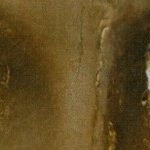
ITEM 1: “Thomas Campbell, former director of the Metropolitan Museum of Art, held that while the price was ‘eye-popping, it should come as no surprise in a market where speculation, marketing and branding have displaced connoisseurship as the metrics of value’. Todd Levin, an art adviser, told the New York Times: ‘This was a thumping epic triumph of branding and desire over connoisseurship and reality.’” – The Guardian 16 November 2017
ITEM 2: “The freakish sale of the Leonardo work – or, according to the detractors, the remains of a historic picture very partially by Leonardo and very largely by the hand of skilled restorers – caused not only incredulity and amazement but also a sort of stunned revulsion. This, some people felt, was just too mad. It was perhaps the first inkling that a market that is undeniably exciting and exhilarating might be on the edge of becoming seriously troubling.” – “The $400m question”, Jan Dalley, the Financial Times, 9/10 December 2017
ITEM 3: “Questions about Salvator Mundi’s authenticity, quality, and physical state were no match for the drive to possess this singular trophy. The acquisition also uniquely encapsulated art’s evolving role in the manufacture of soft-power and negotiation of geopolitics.” – “The Year in Visual Culture”, an Artsy editorial, 22 December 2017 [emphasis added]
ITEM 4: “As Christie’s aggressively marketed Leonardo da Vinci’s Salvator Mundi before the work sold for an astonishing $450m last November, the art world raged anew with questions about the painting’s attribution– even though London’s National Gallery had largely settled the debate by including the work in its 2011-12 Leonardo show.” – Judith H. Dobrzynski, The Art Newspaper, January 2018 [emphasis added].
ITEM 5: “The painting Salvator Mundi will be shown at The National Gallery, London, exhibition: “Leonardo da Vinci: Painter of the Court of Milan” from 9 November 2011 – 5 February 2012.
Leonardo is known [sic] to have painted the Salvator Mundi – an image of Christ holding a globe, with his right hand raised in blessing. The version in a private collection in New York was shown after cleaning to the Director of the National Gallery and to the Curator of the exhibition as well as to other scholars in the field. We felt that it would be of great interest to include this painting in the exhibition as a new discovery. It will be presented as the work of Leonardo, and this will obviously be an important opportunity to test this new attribution by direct comparison with works universally accepted as Leonardo’s. A separate press release on the Salvator Mundi is issued by the owner.” – A National Gallery press statement, July 2011
ITEM 6: “By 1500 onwards, the period in which the painted panel is said to have been executed, for want of time, Leonardo produced few works. Fra Pietro da Novellara, who visited his studio in April 1501, reported: ‘His mathematical researches have so much distracted him that he can’t stand the brush’, and, he added, ‘Two of his pupils make copies to which he adds some touches from time to time’. In 1501, he was commissioned to produce a Madonna of the Yarnwinder by Florimond Robertet (the French King Louis XII’s secretary) at the time when he was already creating both the major group The Virgin and Child with Saint Anne’ and the phenomenally accomplished Mona Lisa. Both panels were seen during their executions in October 1503 by Agostino Vespucci, an assistant of Machiavelli at the Signoria in Florence but he, too, made no reference to a Salvator Mundi. Giorgio Vasari says of the Mona Lisa’s execution that Leonardo, as a meticulous and slow-working painter had ‘toiled over it for four years’. Between May and August 1502 until early 1503 Leonardo was committed with Cesare Borgia as an architect and general engineer in the Marches and Romagna. He was then fully employed by the City of Florence during the Summer of 1503 as a military architect and, two or three months later, he worked fully on the commission of a huge mural (the now destroyed Battle of Anghiari) until late May 1506, before travelling between Florence and Milan up to mid 1508, because of his appointment as painter and engineer to the French King while serving Charles II d’Amboise, the new governor of Milan. Because of such taxing commitments – and all of the above were in addition to his intense scientific researches and literary activities – Leonardo increasingly resorted to workshop productions from 1500 onwards. The Salvator Mundi must, of necessity, be thought to be one of those works and, given the preceding it is very likely that a fully original version never existed.” – Jacques Franck, “Problems with the New York Leonardo Salvator Mundi Part I: Provenance and Presentation”, 14 November 2017
ITEM 7: “The Board asked to be reminded of the Gallery’s policy on display of loan paintings which were or had been for sale. The Deputy Director confirmed that the Gallery would not display on long term loan any painting which was known to be for sale. In relation to exhibition loans, the Gallery would weigh up the advantage to the exhibition in including it: the benefit to the public in seeing the work and its contribution to the argument and scholarship of the exhibition as a whole. The work would be included solely on its own merits. The argument for the inclusion of such a work would usually be presented in the exhibition catalogue.” – Minutes of the National Gallery Board of Trustees – July 2011
ITEM 8: “One scholar [invited to see the Salvator Mundi] said that the consortium had turned down an offer of $100m for the painting. ‘I was told they’re asking $200m for it’” – Milton Esterow, “UPDATED: A Long Lost Leonardo” ARTnews, August 2011
“It’s a historic moment: we’ll wait”, said Christie’s Global President and auctioneer, Jussi Pylkkänen, when bidding dried on the New York Salvator Mundi at the 15 November 2017 sale of modern art. It was certainly unprecedented. In the excitement no one noticed (or divulged) that what smashed records and had sleeper-hunting dealers swooning over prospective $1billion privately-owned Leonardo studio works was not the last Leonardo in private hands, let alone Leonardo’s male “Mona Lisa”, as Christie’s claimed, but, rather, a switch in which a twice-restored and substantially repainted work (Fig. 1, below left), which no expert between 1900 and 2007 had ever thought a Leonardo, was re-presented in a further cosmetically-restored and modernised form – “Every generation finds its own Leonardo”, it has been remarked. (See Fig. 1, below right). To put it another way, what fetched nearly half a billion dollars was the third state of an intermittent twelve-year long twenty-first century restoration-in-progress during which the restorer had first re-restored her own restoration after looking at the Virgin of the Rocks in the National Gallery, and then re-restored it again at some undisclosed point or points between February 2012 and November 2017.
A RESTORATION SWITCH
Above, Fig. 1: The attributed New York Leonardo Salvator Mundi as exhibited at the National Gallery in 2011-12, left; and, right, as sold by Christie’s New York on 15 November 2017. The picture above right is not the same as that above left. (To see how the two halves of the face are now disconnected, see Fig.17 below.) So when; on whose authorisation; and, on what rationale was the one eclipsed by the other? The Salvator Mundi returned to New York in 2012 from the National Gallery and was sold the following year for $80m to a Russian collector’s agent. Had it been re-restored before that 2013 sale? Or while in Russia? Or when at Christie’s prior to its 15 November 2017 sale?
The first two restoration campaigns between 2005 and 2010 were said to have recovered a Leonardo but we do not know who first thought or said this. We do know that before 2007 none of the parties involved in the upgrading attribution thought the picture a Leonardo – not the then owners (a consortium with two identified members); not the restorer, Dianne Dwyer Modestini; not the restorer’s husband, [the now late] Mario Modestini. Mario, a man with an experienced Leonardo eye who had been commended by Berenson to clean the Kress pictures, who had attributed the Ginevra de Benci to Leonardo, who had reputedly brought a restoration-wrecked Rubens back from the dead, and who had wept for half an hour after seeing the National Gallery’s restoration-ruined pictures, thought the painting by a great artist a generation after Leonardo. In 2012 Frank Zöllner, the author of Leonardo’s catalogue raisonné (who had not been consulted on the new work’s authorship) saw the restored picture’s sfumato as being closer to a talented Leonardo pupil of the 1520s than to Leonardo himself. Zöllner further felt that the very extensive restoration of this “badly damaged painting” had made any assessment of the original condition extremely difficult.
Christie’s spoke of an unusually broad consensus of expert support but the group consulted was small – approximately fifteen compared with the thirty invited to appraise the version of the Madonna of the Pinks that was upgraded to Raphael after a National Gallery symposium and a major scholarly article in the Burlington Magazine (February 1992). With this Salvator Mundi upgrade, none of the invited experts has published a case for the attribution but the ascription was endorsed by the National Gallery and the picture was included in its major 2011-12 “Leonardo da Vinci: Painter at the Court of Milan” exhibition as “a work in which Leonardo set out to make his divine inspiration obvious to all”.
What had the undisclosed subsequent third restoration hoped to achieve – a better-than divinely inspired Leonardo? If an institutionally-celebrated Leonardo can be improved by a restorer, is the restorer a better artist than Leonardo – or a medium through whom he still paints? A question that might be considered is: Was the latest re-restoration undertaken to bolster an attribution rejected by four scholars in 2012 when reviewing the National Gallery exhibition, and challenged the year before – without apparent reply – in three Times letters (see Fig. 16 and ITEMS 5 and 7 above).
Above, Fig. 2: Detail – left, the New York Leonardo Salvator Mundi, as at the National Gallery in 2011-12 and, right, as when up for sale at Christie’s New York on 15 November 2017.
Christie’s 2017 lot essay noted a “completion of conservation treatment in 2010” and gave no hint of a post-2012 restoration. Even though the painting had been known since 1900 in England as a Leonardo school work, had been rejected by Bernard Berenson, and had been spurned in Sotheby’s saleroom by Kenneth Clark in 1958 when it fetched £45, the National Gallery gave no hint of any further need for restoration when discussing the painting in its catalogue entry in 2011. Shortly before November 2017 the latest unacknowledged transformation was hiding in plain view in a subliminally brief time-lapse video puff where the painting morphs “miraculously” to a religiose musical accompaniment from its 1913 condition into its most recently restored state. This marketing wizardry can still be seen on the Guardian’s website here.
EVIDENCE OF AN UNDISCLOSED CAMPAIGN OF ALTERATION
Above, Fig. 3: Left, the drapery at the left shoulder of Christ, in 2011-2012 at the National Gallery’s Leonardo exhibition; and, right, in Christie’s 15 November 15, 2018, sale.
In December 2017, Christie’s was presented with photographic evidence assembled by Dr Martin Pracher, a German Lecturer in technical art history, and an assessor of paintings’ condition, that showed changes to the shoulder drapery between 2012 and 2017. A spokeswoman disclosed that the picture’s original (2005-10) restorer, Dianne Modestini, had worked on the painting “Prior to its presentation for sale at Christie’s”. (See “Auctioneers Christie’s admit Leonardo da Vinci painting which became world’s most expensive artwork when it sold for £340m has been retouched in the last five years”.) Specifically: “Modestini partially cleaned the passage of paint in the shoulder and the dark streaks disappeared”. The spokeswoman added: “To imply something incorrect has taken place would itself be incorrect”. The recently “disappeared” folds, it was insisted, were not folds but “dark streaks” that appeared accidentally during the 2005-2010 restoration.
WHEN IS A STREAK NOT A STREAK?
In support of this claim, Christie’s cited part of the restorer’s report – “The Salvator Mundi by Leonardo da Vinci rediscovered History, technique and condition”. The auction house declined to supply the whole report to the Daily Mail even though it had been presented at a National Gallery conference in 2012 and published in 2014 in Leonardo da Vinci’s Technical Practice: Paintings Drawings and Influence, Edited by Michel Menu, Hermann, Paris. This selective presentation of a documentary record was seriously misleading. It was true that Modestini had claimed in her report that the changes were not changes to the forms of the drapery – “the black streaks at the [true] left shoulder of the Salvator Mundi’s blue mantle are not pleats…They are marks caused by the deterioration of the blue pigment made from the semi-precious stone, lapis lazuli…” – but that claim was quite implausible because material decomposition cannot mimic artistic designs and, besides, it was abandoned by Modestini herself in the same report when she acknowledged that the changes were changes to the drapery. The changes, she explained, were unintended consequences of invasive cleaning solvents: “Unexpectedly, the shadows of the folds over the proper left shoulder… became progressively stronger.” [Emphasis added.] Of those shaded folds: “I did not reinforce them… the effect of normal solvents, acetone, mineral spirits and ethyl alcohol mixtures, the initial varnish, and intermediate local varnishes containing ethyl alcohol, reformed the blanching to some degree…”
Photographic evidence published in Modestini’s report offers some credence to her solvent-led explanation (see Figs 5-7) but Christie’s December 2017 response strained credulity further with the extended claim that Modestini’s cleaning solvents, having first made visible what had been invisible, had recently made invisible what they had made visible a decade earlier. We sketch an alternative and more plausible hypothesis.
CHANGED DRAPERY DESIGN
Above, Fig. 4: In this greyscale sequence, we see the shoulder as exhibited at the National Gallery in 2011-12, left; as seen, centre, at Christie’s November 2017 (after Modestini’s only recently acknowledged intervention); and, right, as in an earlier infra-red image.
THE SALVATOR MUNDI ATTRIBUTION PROBLEM
In view of this work’s extraordinary recent conservation history and its extremely poor provenance, there are only two possibilities to entertain:
1) This work was, since its discovery in 1900, an unrecognised autograph Leonardo that had suffered massive restoration injuries and adulterations in the past, all of which, since 2005, have been successfully mitigated/masked/ by a single restorer’s further repairs and repainting, some of which have been recorded and some not.
2) This picture is a school work on which the master (Leonardo) intervened in one or two places and is not, therefore, a finished and entirely autograph Leonardo painted prototype for the group of twenty or so Leonardesque Salvator Mundi versions.
If we are to talk Leonardo da Vinci, we must talk of supreme painterly accomplishment. If we are to talk of an autograph painted protoype by Leonardo we should identify derivations from it in the many other Leonardesque Salvator Mundis and demonstrate a parity of artistic qualities with those encountered in historically recorded bona fide Leonardo paintings. If we are to talk Leonardo on the back of an only very recently upgraded, greatly injured and much restored painting, we must first talk of picture restoration’s methods, consequences and role in attribution upgrades.
WHAT RESTORERS DO (WRONG)
Restorers undo and redo pictures. The first is quasi-archaeological and risks misdiagnosis and abrasive/chemical injuries. The second is reconstructive in a quasi-artistic sense and risks adulteration or falsification.
Restorers strip off what they judge inauthentic and paint-on what they think might recover/simulate lost original and authentic appearances. The former is notoriously if not inherently destructive because restorers bear down with their solvents and scalpels on picture surfaces which carry artists most considered and final adjustments (see comments at Fig. 9). The latter is a fraught, presumptuous ambition that can be exercised with greatly varying levels of skill and artistic/anatomical comprehension (see figs. 10 and 11). Restorers are forever debating the ethics of attempting to reconstruct with their own modern materials the lost original surfaces of paintings. Whatever their outcomes, for good or ill, restorations facilitate attribution upgrades because “restored” works become new, hitherto-unseen works with “out-of-history” states that permit experts to discard previous judgements without professional embarrassment.
THE NEW YORK SALVATOR MUNDI’S CHANGING APPEARANCE
Above, Fig. 5: The drapery at the left shoulder of Christ. First left, as seen in 2005 when the Salvator Mundi was taken by one of its then owners, Robert Simon, an old masters dealer, to Modestini’s studio. Second left, in 2007 when the panel had been repaired and stripped of varnish and repaint. Third left, as exhibited in 2011 at the National Gallery. Right, as sold at Christie’s in November 2017.
In 2012 Dianne Modestini reported the picture’s arrival at her studio in 2005: “I shudder to think what might have been used. There was relatively recent varnish, sticky and uneven, and some crude retouches which may have been done by the owner or a local amateur.”
Above, Fig. 6: In the top, left, row we see the drapery folds as exhibited at the National Gallery in 2011-12 and, right, as when sold at Christie’s in 2017. Anyone might establish the extent of the changes by simply tracing photographs as above, middle row. Recent digital advances have made it possible to “subtract” a former state from a later one and represent the “differences” as dark shapes on a light ground, as above, bottom row, right, in a graphic prepared by Gareth Hawker. That graphic indicates with the clarity of a brass rubbing the location of material that had been added within the confines of the shape of the blue drapery. Moreover, visual appraisals of the 2011 and 2017 states of the painting show that changes had not been confined to the shoulder drapery but were present throughout the painting. In the details shown above, for example, it is apparent that the circumference of the orb has been strengthened by darkening (as is discussed below).
THE FULL TIMELINE
Above, Fig. 7, top row: First left, an engraved copy of 1650 by Wenceslaus Hollar of a Salvator Mundi attributed to Leonardo in the collection of Charles I. Second left, a 1913 photograph of the present Salvator Mundi when in the Cook Collection, England. Third left, the Salvator Mundi as it arrived at Modestini’s studio in 2005. Right, the Salvator Mundi in 2007 after it had been repaired and cleaned.
Above, Fig. 7, bottom row: First left, the Salvator Mundi in 2007 after it had been repaired and cleaned. Second left, the Salvator Mundi in 2008, after its first restoration and when about to be taken to the National Gallery. Third left, when exhibited at the National Gallery in 2011. Right, as when sold at Christie’s in November 2017.
Above, Fig. 8: Top, one of the then owners, Robert Simon, holding the painting at his home the night before taking it to be viewed by a number of Leonardo specialists at the National Gallery, London, in 2008; above, the painting being examined in the National Gallery in 2011. (See “Da Vinci’s ‘Salvator Mundi’ painting took a winding 60-year path from under $200 to a record-breaking $450 million”)
In the sequence above we see the painting near the end of its first stage of restoration in 2008, top, and, below it, at the end of its second stage of restoration in 2011. Here we use the term “restoration” in the specialised sense of restorers who often draw a distinction between cleaning (stripping down) and repainting (which they euphemise “retouching”). In such trade usage the term “restoration” is applied to the post-cleaning repainting, not to the whole treatment. Injuries can occur in both the stripping and the reconstructive stages.
THE TWO PRINCIPAL TYPES OF PICTURE RESTORATION DAMAGE
Above, Fig. 9: The face of St Anne in Leonardo’s The Virgin and Child with St. Anne before restoration, left, and after restoration, right. (See “Another Restored Leonardo, Another Sponsored Celebration – Ferragamo at the Louvre”.)
Restorers exult in liberating paintings from predecessors’ repainting, it being a principal justification for new restorations. The photographically demonstrable cumulative net result of successive restorations is the routine scrubbing away of pictorial heritage. With photo-records of modern paintings which can often be seen in their original untouched conditions, we still encounter the same long-standing patterns of destruction, as here shown with artists like Renoir and Klimt. (See “THE ELEPHANT IN KLIMT’S ROOM” and “Stone-washed Renoirs and the Shock of the Undone”)
WHAT RESTORERS DO AFTER STRIPPING PICTURES DOWN
Because of the decline in traditional art teaching practices the pool of painterly expertise is dwindling and for many restorers today conducting their own repairing stage, after stripping off earlier repairs, can induce panic (a workshop conference was called recently to enable restorers to pool experiences, swap recipes and “learn by looking and listening [in a] welcoming and supportive environment”). For more confident practitioners the occasion can unleash over-reaching quasi-artistic ambitions.
Above, Figs. 10 and 11: However good their intentions, however avowedly “ethical” their professional codes, restorers, like forgers (who are often themselves restorers or ex-restorers), cannot avoid leaving personal imprints and those of their cultural milieus in their repainting. The more ambitious the aspirant, the more deficiencies of artistic reading and anatomical understanding can be imposed on mute works of art. The Louvre Veronese restorer above seemed in thrall to the pneumatic forms and miniaturised features of Botero. That such eccentric aesthetic predilictions should ever have been institutionally authorised might augur badly for the Mona Lisa herself in a Louvre Museum today where curators are binging on radical restorations as they play catch-up with the technological adventurism long-encountered in British and American museums.
MODESTINI’S METHODS ON THE SALVATOR MUNDI
Dianne Dwyer Modestini is a highly skilled and highly regarded restorer who teaches at the prestigious Conservation Center of the Institute of Fine Arts at New York University. She is also refreshingly frank. In her 2012 report on the New York Salvator Mundi, she gives a more detailed account of her actions and the problems she encountered than is commonly recorded in restoration reports. She disclosed that her initial (2005-10) restoration was a two-stage affair. What is at issue here is not one of brutal cleaning or ham-fisted technique but, rather, of very great painterly skill applied on a conviction of authorship that is arguably unsound and in a treatment that may or may not have been entirely of her own making. She discloses, for example, having taken guidance from Luke Syson, the organising curator of the National Gallery’s Leonardo exhibition. Earlier, Syson had instructed a National Gallery restorer to alter the expression of the angel’s mouth in the gallery’s version of Leonardo’s The Virgin of the Rocks by removing a piece of ancient paint that had survived an earlier restoration by a National gallery restorer now notorious for his policy and muscular advocacy of “total Cleaning”. (See: “Something Not Quite Right About Leonardo’s Mouth ~ The Rise and Rise of Cosmetically Altered Art”.)
After the repairing and cleaning stages (2005-2007), Modestini worked for three years with her paint brushes on a picture that she, the owners and an accumulating group of experts increasingly took to be an autograph Leonardo painting. In a television interview she characterised her repainting as an attempt to “help it as much as you could while not in anyway suppressing this extraordinary virtual quality that it had”. Her goal of assisting a badly damaged work was executed slowly with fine brushes and synthetic paint:
“Most of the retouchings were done with dry pigments bound with PVA AYAB. Translucent watercolours, mainly ivory black and raw siena, were used for final glazes and to draw cracks. For the black background both AYAB and Maimeri Colori per restauro were used. Except for the background I mainly used treble 0 sable watercolour brushes in a series of vertical passes until the areas of loss matched the surrounding material.”
Restorers draw fake age cracks onto their own new painting to conceal its whereabouts – or, as they euphemise, to “integrate” it with surviving original paint. Forgers sometimes produce overall fake cracks by this method and sometimes they scratch them into the paint and rub dirt in. With restorers, no less than with forgers, the intention is to deceive the viewer by conferring an air of antiquity and an illusion of unbroken pictorial integrity. When the National Gallery restored Holbein’s The Ambassadors its restorers justified their deceiving false painted cracks on the ground that they had photographed their actions and that the photographs were held in the painting’s dossiers. The then director of the Gallery, Neil MacGregor, defended fresh reconstructive painting but did concede that “recovering the intentions of a long-dead artist is a complex and tentative business”. (See “The New Relativisms and the Death of “Authenticity”.)
Dianne Modestini’s notion of help without suppression is oxymoronic: you help or enhance by applying new paint onto…the surface you have stripped…and, thereby, suppress or amend the values you have revealed – why else would you intervene with paint at all? Conceptually speaking, restorers treat or present this part of their work work as a matter-of-fact mechanical/optical process when what you do is determined by what you think, how you see, how you “read” visual phenomena, how art historically informed you are, and, to an invevitable degree, by the professional circumstances under which you are operating. If you think and are assured that you are working on a Leonardo, how can you do other, in conscience, than steer the picture towards a more satisfactory realisation of your conception of that artist’s work?
There is another specific danger: if you apply lots and lots of paint over a long period you produce a progressively altering painting that is not only based on your own initial assumptions but one that is increasingly being made in accord with your own previously incorporated modifications. By stealth you confer a superimposing material form of your own conception of what the work should be like and should further become. Apart from any guidance that may be being given by others in the studio, this work is otherwise done privately, free from external professionally disinterested appraisal and artistically informed criticism. Modestini disclosed in a television interview that she became greatly attached to the painting and found her eventual separation from it emotionally painful.
On the extent of her retouching, Modestini said that aside from damage resulting “from past cleanings [which] can be seen in some passages where the final modelling is lost…” elsewhere, “apart from the discrete losses, the flesh tones of the face retain their entire layer structure, including the final scumbles and glazes. These passages have not suffered from abrasion; if they had I wouldn’t have been able to reconstruct the losses. The blessing hand is intact.” Thus, the initially declared object of retouching was simply to bring discrete losses up to the values of surviving original paint and, in places, to reconstruct assumed lost final modelling layers. Crucially, the face was said to require no reconstruction or repair of any sort, aside from to certain clear and self-contained losses. On that account, the face as exhibited in 2011 at the National Gallery should have looked (largely) as it had emerged from cleaning by 2007. And, certainly, there should have been no difference between the face as exhibited at the National Gallery in 2011 and as sold at Christies in 2017. This was not the case (see Figs. 17-19). Modestini disclosed in 2012:
“There were actually two stages of the current restoration. In 2008 when it went to London [see Fig. 8] to be studied by several Leonardo experts, there was less retouching. I hadn’t replaced the glazes on the orb, finished the eyes, suppressed the pentimenti on the thumb and stole, and several other small details but, chiefly, the painting still had the mud-coloured modern background that was close in tone to the hair. Two years later I was troubled by the way the background encroached upon the head, trapping it in the same plane as the background. Having seen the richness of the well-preserved browns and blacks in the London Virgin of the Rocks and based on fragments of the black background which had not been covered up by the repainting, I suggested to the owners that it might be worthwhile to try to recover the original background and finish the complete restoration.”
MAKING “A DIFFERENT ALTOGETHER MORE POWERFUL IMAGE”
With her decared ambitions to finish a “complete restoration”, after seeing the National Gallery’s restored Virgin of the Rocks, Modestini begins to take an overarching artistic possession of the painting as a painting. Permission, she recalled, was granted to strip and repaint the entire background:
“The initial cleaning [i. e. paint removal] was promising especially where the verdigris had preserved the original layers. Unfortunately, in the upper parts of the background, the paint had been scraped down to the ground and in some cases the wood itself. Whether or not I would have begun had I known, is a moot point. Since the putty and overpaint were quite thick I had no choice but to remove them completely. I repainted the large missing areas in the upper part of the painting with ivory black and a little cadmium light red, followed by a glaze of rich warm brown, then more black and vermilion. Between stages I distressed and then retouched the new paint to make it look antique. The new colour then freed the head, which had been trapped in the muddy background, so close in tone to the hair, and made a different, altogether more powerful image.”
SO WHY CHANGE THE OVERALL APPEARANCE OF AN ACREDITED LEONARDO?
Above, Fig. 12: In this sequence we see how the face’s distinctive bug-eyed, long thin bent-nosed monkey-like anti-classical appearance on acquisition in 2005 had persisted throughout the 2008 visit to the National Gallery and into the 2011-12 stay in the National Gallery’s Leonardo exhibition.
What might account for the substantial covert post-2012 re-restoration? In the absence of information and reports we must speculate. It can be said that for the credibility of so elevated an ascription as an entirely autograph Leonardo da Vinci it is imperative that a clear “fit” be evident with secure works within Leonardo’s oeuvre. Anything anomalous or discordant becomes a threat that must be explained away by being incorporated as an especially confirming feature within the attributed work’s New Narrative . For example, when Professor Martin Kemp was actively engaged as an advocate of another proposed Leonardo, the mixed media drawing on vellum he dubbed “La Bella Principessa”, he contended that atypical or previously unknown features (including working in a medium “that has not previously been seen”) can safely be taken as a “new facet” of the artist’s engagement with his circumstances. Perhaps. But when a work has been specifically likened to the greatest and most maturely sophisticated works of Leonardo the bar has been set extremely high and the scope for great surprises is reduced. For the owners and professional champions of this Salvator Mundi – a work that was very soon afterwards to be offered to the market – the scholarly rejections that attended the National Gallery exhibition might have seemed disappointing, if not alarming.
Today we see three principal cross-linked concerns with the painting that has recently sported two separate identities – the one displayed at the National Gallery and the one worn for the recent sale. The problems are: the painting’s appearance; its (lack of) provenance; and the (over-heated) means of its promotion and accreditation.
GHOST SCHOLARSHIP
This Leonardo ascription has been made on almost no published scholarship. It rests on a largely unstated and, therefore, unexamined art critical case. Apart from the restorer’s report and the National Gallery exhibition catalogue’s entry by its curator, Luke Syson, almost nothing, so far as we know, has been published in support of this Leonardo. Christie’s lot essay appealed to the authority of the unpublished researches of one of the original owners, Dr Robert Simon, a New York art dealer, and to Modestini’s and Syson’s accounts when they, too, both acknowledged indebtedness to the researches of Simon. After twelve years, serial restorations and two sales at a combined total of over half a billion dollars, those researches have yet to be published. It is impossible to know whether or not weaknesses in the two published accounts derive from or fairly reflect Simon’s still unpublished material but dangers must lurk in an unexamined triangulated loop of research in which much seems to be assumed or borrowed and from which little concrete evidence emerges – and where caveats abound. Luke Syson writes:
“The re-emergence of this picture, cleaned and restored to reveal an autograph work by Leonardo, therefore comes as an extraordinary surprise” but, he adds, of Wenceslaus Hollar’s engraved testimony (see below): “None of this, of course, is evidence for the picture’s autograph status. After all, the pictures by pupils copying Leonardo’s design may sometimes have been rather good, and one such might easily have been owned by Henrietta Maria.” Quite so. And in view of Jacques Franck’s account above (ITEM 6), that very possibility, as advanced by Ludwig Heydenreich, is the first mountain that any “Autograph Leonardo Salvator Mundi” aspirant must be seen to have scaled. It is now six years since Syson alerted us that “This discussion anticipates the more detailed publication of this picture by Robert Simon and others” but he gave little indication of any corroborative evidence being to hand. It would sometimes seem that Simon’s researches on the New York candidate echo or adapt the extensive researches earlier conducted by Joanne Snow-Smith in her support of the unsuccessful Paris candidate, the so-called de Ganay Salvator Mundi (see Fig. 13). If Syson should prove to have been a dutiful student of Simon we might be in for a daisy-chain of hypotheses in which awkward and peculiar features are advanced as material corroborations with rhetrorical flourishes. Syson ends his account thusly:
“Snow-Smith has shown that King Louis XII and his consort, Anne of Brittany, were particularly devoted to Christ as Salvator Mundi, and that they could connect this cult with the Mandylion of Edessa twice-over we now see. Given the date – around 1500 – of Leonardo’s preparatory drawings [only two sheets of drapery studies], the style of the picture and its association with a French princess, Louis and Anne become the most likely patrons for Leonardo’s Salvator Mundi, probably commissioning the work soon after the conquest of Milan and Genoa. This would therefore be one of the French commissions mentioned by Fra Pietro Novellara. And it was perhaps to accommodate their wishes that Leonardo based Christ’s features, the set of the eyes, the heavy lower lids, and especially his smoothly arched eyebrows [sic] down into a long nose, on the Christ of the Mandylion of Edessa.” Emphases added.
How can you extract a “would therefore be” from a “could”, a “most likely”, and a “probably”? In lieu of a single hard shiny fact, we are offered a forest of fancies, maybes, perhaps’s and scholarly borrowings.
THE HOLLAR AND DE GANAY CONNECTIONS
Even if the claimed correspondence between the New York Salvator Mundi and Hollar’s etched copy had been visually compelling – which on many counts it is not – the etching’s ascription to Leonardo would still need treating with caution. Max Friedlandler warned in On Art and Connoisseurship: “The inventories of princely galleries – such as those of Margaret of Austria, Vicereine of the Netherlands, or of King Charles I of England…are to be utilized sceptically and to be taken seriously only to the extent that facts derived from style criticism do not contradict them.” With the New York Salvator Mundi’s countless stylistic incompatibilities, attempts to press a correspondence with the Hollar are quite counter-productive.
Above, Fig. 13: Top row, left, the “de Ganay Salvator Mundi” (the painting had formerly been in the collection of the Marquis de Ganay, Paris); top row, right, the 1650 Hollar etching. Bottom row the New York Salvator Mundi in 2011, left; and in 2017, right.
The de Ganay picture, top left, was proposed in a scholarly article in 1978 and a book of 1982 to be an original Leonardo painted prototype for around twenty Leonardo-like Salvator Mundi paintings. That attribution did not find general favour but the case advanced for it by the scholar Joanne Snow-Smith provided a template for the New York Salvator Mundi. It, too, was said to have been the painting etched by Hollar, above, top right. Its material composition was also said to have passed the technical tests of its day. Its paintwork, too, betrayed no discernable brushwork – in this last respect both of the proposed Leonardo protypes are physically unlike such secure but heavily cracked bona fide Leonardo works as the Mona Lisa and the St. John the Baptist.
While both of the two painted versions shown above, left, are said to have provided the model for Hollar’s etching, in neither case is this plausible. Both have the complicated and rather ugly configuration of drapery folds at the true left shoulder in which a horizontal fold runs below the below the shoulder creating an epaulette-like touch of power-dressing that is not present in Hollar’s copy. The alteration of the New York version’s shoulder drapery thus might be thought to have conferred two stylistic benefits: it makes a closer fit with the Hollar copy and it puts distance between itself and an earlier failed contender as an original painted prototype by Leonardo.
The 2012-17 repainting might be thought to have brought other benefits vis-à-vis the very marked departures from the Hollar seen in the New York Salvator Mundi. In the etching there are two principal sources of light: a strong, top left corner-down natural light source that imparts a pronounced chiaroscuro on the figure (– and even an unremarked cast shadow from the raised arm) and, a source of radiance (“nimbus”) behind Christ’s head. Although the newly imposed uniform blackness of the background is counterproductive in terms of the claimed correspondence with the historic Hollar copy, the recent general beefing-up of tonal contrasts – and particularly so with the foreground arm drapery and the orb – has mitigated to a considerable degree the previous deadening flatness (of which we have complained see: “Mystery over Christ’s orb in $100m Leonardo da Vinci painting”.)
The face in the Hollar is long thin, bearded and tapering, as is that in the de Ganay painting. In contrast, the face in the New York picture emerged from the first restoration with an entirely disqualifying lopsided shape that was markedly wider at the jaw than at the cheekbone and thus combined a chipmunk-like aspect with a monkey nose. The latest post-2012 shading on the face of the New York picture has served to narrow the lit lower face and make the overall aspect more symmetrical. Similarly, Modestini’s widening of the right nostril aperture (see Fig. 19) masks another anatomical solecism in a purportedly hierarchic frontal classical face, which, Modestini assures us was “deliberately adapted by Leonardo from a Byzantine prototype and also used by Giotto in the Peruzzi Altarpiece in Santa Croce, with which he was certainly familiar…” Similarly, too, for Syson the question is re-begged: “the face of Christ – rigid, symmetrical, absolutely frontal – is deliberately archaic. He seems to have been aware of the central panel of a polyptych ascribed to Giotto and his workshop…” Two asserted “deliberatelys” do not a secure fact make. The idea of Leonardo as a backward looking archaistic figure is a notion that finds realisation in only two works: the proposed Leonardo drawing “La Bella Principessa” – which has no history before its emergence in 1996 from the studio of a painter who became a friend of Berenson and a restorer of …Leonardo, among others; and, the recently upgraded New York Salvator Mundi. The argument is circular. If ever Leonardo might have been tempted to do a frontal, backward-looking hierarchic face of Christ it would have been on his triumphantly frontal, wall-asserting mural The Last Supper. Instead, of course, he carved space by playing every head and limb off against the unseen picture plane.
THE PROVENANCE
Without the Hollar connection this Salvator Mundi’s provenance begins only at 1900 four centuries after its supposed execution. The pre-1900 history is problematic. It is not known from whom, where or when the picture had been acquired by Sir Charles Robinson who bought the work as a Bernardino Luino for the Cook Collection. We have been informed that an English fossil-hunter, Thomas Hawkins (1810-89), seems to have donated a “Leonardo Salvator Mundi” in 1848 to a church in Birmingham. That church was closed down in 1895, at which date its collection was presumably disbursed. Had Robinson bought it from that church? Or, were there two claimed Leonardo Salvator Mundi versions then at large in England? To complicate matters, the whereabouts of a third version formerly in the Worsey and Yarborough Collections is presently unknown. So there might have been three Leonardo Salvator Mundi candidates in 19th century England.
The Cook collection picture’s provenance ran into the ground in 1958 when sold by Sotheby’s for £45. Between 1900 and 1958 no one thought the New York Salvator Mundi to be a Leonardo. Christie’s 2017 sale provenance ended: “Kuntz, Private Collection USA”. Sotheby’s have no additional information on Kuntz. Wiki has an entry on a US artist Roger Edward Kuntz, a talented painter who wavered between abstraction and representation and died in 1975. In the early 50s he and his wife travelled for four months in Europe so that he could visit museums. They had a daughter in 1951. If Kuntz, an artist with a “pensive, thoughtfully naturalistic sensibility” made another European trip in 1958, might he have had £45 (at that date about a month’s wage for an unskilled worker in Britain) to spare on an old Italian painting? Roger Kuntz died in 1975 but was succeeded by his wife and daughter. If not that Kuntz family, what of others in the United States? A Kuntz family in Louisiana used to be avid collectors of paintings, antiques and historical documents. Rosemund E. and Emile Kuntz had two sons, one of whom donated a majority of their collection to Tulane University in New Orleans. As things stand we do not know the identity of the vendor in 2005 or the venue of the sale – which might seem odd in the world’s most information-rich country in the twenty-first century. Given the still sticky varnish present on the New York Salvator Mundi in 2005 when the painting was bought for $10,000, it could be useful to establish the identity of the previous owner who would have information on the previous restoration and very possibly photo-records of the painting from 1958 onwards.
THE SALVATOR MUNDI’S APPEARANCE
Above, Fig. 14: Details of the Hollar etching and the 2017 version of the New York Salvator Mundi.
If the removal of the “epaulette” and the rounding off of the shoulder brings the painting a little closer to the etching, the painted orb has become even more at variance. In the Hollar copy the orb accumulates light around its circumference in contrast to the pools of darkness at its centre but that symbolic tonal logic is inverted in the New York painting and the line of three reflected lights on the surface recorded by Hollar contrasts with a triangular configuration which some see as a depiction of stars in the southern hemisphere but which again, is nowhere else encountered. As if oblivious of all this conflicting testimony, Syson writes of the New York painting’s orb: “This perfect sphere is seen both to contain and transmit the light of the world.” And again, against visual evidence he writes: “Moreover, Christ’s hand remains miraculously undistorted. Leonardo has therefore created an object that would be understood as a piece of divine craftsmanship, but still be his own invention. Never did he make the connection between his own creativity and God’s more explicit.”
A key part of the case advanced for the New York version is that it contains a number of pentimenti. Luke Syson writes “There is, for example a major pentiment in the thumb of Christ’s proper right hand, and other, lesser adjustments of the contours elsewhere (such as in the palm of the left hand seen through the transparent orb).” Syson contends that such are typical of Leonardo and would be surprising “in a copy of an existing design”. He fails to explain why, had this painting provided a fully realised painted prototype for all the other versions (as opposed to having provided studies and possibly a cartoon, as other have concluded), no other version depicted the hand holding the orb in the manner of the New York picture – as we discussed in Part I and will examine further in Part III. No other version shows as much of the palm of the hand and all show what little is seen of the hand and the thumb itself to be on a rising diagonal (see Fig. 15), as does the Hollar copy. Perhaps Robert Simon has assembled in his researches an explanation for how it came about that Leonardo painted a hand, as presently in the New York version, and how, then, when Hollar copied it a century and a half later, he opted to make it both smaller and rotated from its horizontal axis to a diagonal one? Modestini describes the collective thinking/handling of one of the other changes of position:
“A pentimento of the thumb [on the blessing hand] appeared as soon as the varnish was removed. It had been covered over by successive layers of background paint and, when these were scraped off, was itself damaged in the process. It was never a complete thumb, only the bright pink underpaint, rather amorphous because of the damage. Normally I like to see pentimenti, sometimes veiling them slightly if they are too prominent and disturb the image. In this case I tried various solutions, including: reconstructing it, after which it was too assertive; toning it down with dark translucent glazes; pushing it back with scumbles containing green to subdue the bright pink. It never looked right and interfered with the well-preserved hand. I was greatly relieved when Luke Syson agreed that, under the circumstances, it could be completely suppressed.”
Above, Fig. 15: In the top row above we see how greatly more commanding and authoritative is the design and sculptural massing of forms in the small etched copy by Hollar than in the much larger New York painting. It is inconceivable that Hollar, if copying the New York picture, would have changed so many aspects of the design and so greatly intensified the overall theatre of lighting and form-evoking shading. In the Hollar we see the central drapery ridge descending from the shoulder in a convex sweep before entering the orb’s circumference and then abruptly inverting from convexity to concavity – which aspect it maintains throughout its passage within the orb until, on exiting, it immediately reverts to convexity. In the centre of our own glass “orb” (which lies on the surface) in the lower picture we see how the narrow parallel white division between the two photocopied diagrams at first disappears from view and then reappears, within the orb curving outward slightly on one side and more dramatically so on the other before beginning to converge at the approach the circumference. If the New York painting were a Leonardo that had been copied by Hollar, how likely would it be that the latter copyist took the liberty of making a more complex and scientifically astute optic within the orb than was present on the painting he believed to be by Leonardo?
Above, Fig. 16: Left, two ArtWatch letters to the Times on the orb; right, Professor Martin Kemp’s endorsement of the Salvator Mundi’s Leonardo attribution, as set out in the 2011 edition of book Leonardo. His illustration, being that of the 2011 state, is now obsolescent. His dating (c. 1504-07) places the picture chronologically (and therefore stylistically) between the Mona Lisa and the St John the Baptist. In an earlier entry in his book’s “Gallery”, Kemp also endorses the mixed media drawing on vellum glued onto an oak panel which he dubbed “La Bella Principessa (Portrait of Bianca Sforza?)” – see Fig. 20. He dates that proposed Leonardo at c. 1495-6 in tandem with the beginning of Leonardo’s Last Supper. He states as fact that this drawing had been cut from the Warsaw copy of the Sforziada produced for Galeazzo Sanseverino. He and the owner of the drawing each made a trip to Warsaw with a National Geographic crew to locate the spot in the codex from which the sheet was cut. They both found the spot, or rather, two different spots. Kasia Pisarek established that neither could have been the case because the book had been bound with five double stitch holes, when the drawing has only three single holes. (See “Fake or Fortune: Hypotheses, Claims and Immutable Facts”)
Above, Fig. 17: In this split image above we see the 2011 face on the left, and the 2017 face on the right. We can see the extent to which Modestini has intensified all the values present in her first version: she has lightened her lights and darkened her darks and warmed the hue of the cheeks. This rouging of the flesh is at variance with the face of the Mona Lisa. In effect, Modestini has treated her own 2011 second-state painted restoration as if it were an etcher’s proof and worked afresh on the plate before pulling a new, further worked-up state with intensified pictorial vivacity. In doing so she demonstrates a painterly expertise that is rare among restorers today and a sophisticated pictorial sensibility. However it is one, as shown below, deployed to arbitrary and ahistorical purposes.
Above, Fig. 18: In the top row detail of St. Anne, we see how a major bona fide Leonardo in the Louvre has borne the commonplace “reductive” pictorial material-shedding brunt of radical restorations. Restorers, when challenged on their sculpturally flattening modernist impositions, invariably insist that what critics lament as losses were no more than dirt, disfiguration and arbitrary alien accretions. Curators should know better and for the longest time in the 20th century those at the Louvre did do so. In the bottom progression we see how Modestini avoided one picture restoration affliction only to effect another by imposing a ceaselessly-evolving painterly elaboration which comes to constitute a series of variations on a theme.
Fig. 19, above: As mentioned, when considering great artists the primary evaluation must always be one of artistic quality. In Part III we examine the New York Leonardo Salvator Mundi with regard to the great bona fide Leonardo works to which it has been likened. Here, above, we show a close-up of Christ’s (changing) face as seen in 2012 left, and 2017, right. Above it we show the eyes as in 2007 when cleaned but not yet repainted. The attentive viewer will see how Modestini has variously changed the expression of Christ by: raising the right-hand side of the parting line of the lips; by de-fluffing some of the beard on the left upper mouth; and, by further adjusting the misaligned eyes. There is as yet no published record or account of the reasons for making these changes. As seen, Syson saw in the (2011) eyes of this Salvator Mundi Leonardo’s accommodation with the wishes of certain historical figures with whom no connection has been established. We do have Modestini’s account of the induced appearance of the eyes, as they were seen in the 2011-12 National Gallery exhibition:
“Since both eyes have been abraded, the left one to a greater degree than the right, the ambiguity between abrasion and highlight made the restoration extremely difficult and I redid it a number of times. As little as possible was done to the left eye. No attempt was made, for example, to emphasize the pupil which is reasonably well preserved in the right eye. Carefully following the remnants of original, which contain a line of drawing to place the lower lid, resulted in eyes of slightly different size; the left is smaller than the right. Imposing a more logical or definite shape caused the eyes to completely change character.”
Above, Fig.20: Left, the cover of Joanne Snow-Smith’s 1982 book THE SALVATOR MUNDI OF LEONARDO DA VINCI; Centre, the cover of the owner’s account of his (so far vain) quest to authenticate the “La Bella Principessa” drawing; Right a poster for a talk given by one the original owners of the New York Salvator Mundi at the 2014 Annual Brunch for Friends of the Uffizi Gallery.
Michael Daley, 2 February 2018
Problems with the New York Leonardo Salvator Mundi Part I: Provenance and Presentation

The Art Newspaper reports that questions of authenticity, provenance and attribution constitute the greatest risks to the art market according to 83% of wealth managers and 81% of art professionals (“Ultra-rich will spend $2.7 trillion on art by 2026 says Deloitte”).
Above, Figs. 1 & 2: ArtWatch UK members’ Journal No.31 and its lead article. For membership details please contact Helen Hulson at hahulson@gmail.com .
In our current Journal (above) we carry a report on the crisis triggered by the collapsing numbers of scholars who possess specialised expertise in particular artists and fields, and on whose authority and powers of appraisal the art market relies. Scholarly shortcomings are also evident in a widespread disinclination to conduct rigorous, visually comparative interrogations of restored and/or attributed works – perhaps out of deference to institutionally-powerful picture restorers who nowadays call themselves Technical Art Historians. Some museum curators openly farm out responsibility for attributions…to private collectors. At elevated scholarly levels the highest ascriptions are sometimes attached to what are only the best surviving versions of lost works.
TELL-TALE CROPPING
The late Sir Denis Mahon supported as original and authentic a version of Annibale Carracci’s Venus, Adonis and Cupid, of c. 1588-90 until the Prado restored its own version and declared it the authentic original. Mahon saw vindication in an instantly switched allegiance:
“When I first wrote about this composition, some fifty years ago, my observations on style and chronology were based not on the Prado painting, since this was as yet unknown, but on the excellent early copy in the Kunsthistorisches Museum in Vienna and on the preparatory drawings for the figure of Adonis in the Uffizi. When the Prado painting was first published in 1965, by Pérez Sánchez, it was gratifying to realize that, although all those of us who concerned ourselves with Emilian painting had mistakenly assumed that the Vienna picture was Annibale’s original, one’s intuitions about the importance of the work and where it fitted in the artist’s evolution were confirmed.”
So that was alright then? No. Sir Denis was parading methodological laxity. Even before the Prado picture emerged, he should have appreciated that an old engraved copy testified that the original work was larger and compositionally richer than the cropped version he was espousing. Cropped digits and limbs are so commonly encountered in copies as to constitute attribution alarm bells. They are found (as we showed in “Art’s Toxic Assets and a Crisis of Connoisseurship”) in works given to Caravaggio, Rubens and Leonardo. Just as the thumb on Christ’s left hand in the New York Salvator Mundi is inexplicably cropped (- and nowhere addressed), so are Samson’s toes in the National Gallery’s Rubens Samson and Delilah and so are the legs and part buttocks of a slain infant in the Old Masters world record-beating Lord Thomson Rubens Massacre of the Innocents. In the National Gallery’s (second) version of Leonardo’s Madonna of the Rocks, the foot of the infant Baptist runs off the painting whereas it falls comfortably within the edge of the composition in the unquestionably autograph first version in the Louvre. It is being claimed that the New York Salvator Mundi (Fig. 3) is the prototype original for all other versions when it is in fact the only version to carry a cropped thumb (see Fig. 4). Did every other artist ignore/correct a mismanaged painted prototype composition by Leonardo?
Above, Figs. 3 and 4: Top, the New York Salvator Mundi which, since 2011 has been attributed to Leonardo (photo. courtesy of Christie’s); Above, details left, of the so-called de Ganay Salvator Mundi; centre, of the Detroit Institute Giampietrino Salvator Mundi; and, right, of the New York, Leonardo Salvator Mundi.
Above, Fig. 5: Left, the proposed but rejected de Ganay Leonardo Salvator Mundi; right, the New York Leonardo Salvator Mundi.
THE HISTORICAL CONTEXT OF THE NEW YORK SALVATOR MUNDI
The New York Salvator Mundi is billed as a miraculous once-in-a-century discovery when it is the second such claimant drawn from a pool of more than twenty clearly Leonardo-derived and sometimes partially Leonardo-assisted Salvator Mundis. In 1978 and 1982 Joanne Snow-Smith, with the support of the Leonardo scholar Ludwig Heydenreich, proposed that the de Ganay Salvator Mundi (above, left) was the original autograph Leonardo prototype for all other variants.
Earlier, Heydenreich had concluded on the evidence of the various treatments seen in this group – which included the then lost, now New York Salvator Mundi – that Leonardo had more likely executed designs or a cartoon to inform his assistants and associates than to have executed a finished painted panel.
THE LEONARDO SALVATOR MUNDI FIELD
Although the quality here is very poor we reproduce below at Figs. 6–10 all of the reproduced images included in Heydenreich’s neglected but, as Frank Zöllner holds, “enduringly significant” 1964 study “Leonardo’s ‘Salvator Mundi’”. The initial images set the scene and context of the subject, others are examples of the score or more Salvator Mundi works now associated with Leonardo.
Above, Fig. 10: This image is crucial to the attribution, being the two (Windsor Castle) drapery studies that comprise the entire extant material evidence for Leonardo’s involvement in the genesis of the large associated group of Salvator Mundi works. Characteristic Leonardo drapery fold motifs in the two studies recur in varying ways in many but not in all of the associated works. These two sheets provide a small base for a claimed Leonardo attribution for a particular painting. At the heart of this present (contested) Leonardo Salvator Mundi attribution is, therefore, the question of whether Leonardo provided further designs, studies, cartoons and some painterly assistance to his students (as Heydenreich held and Frank Zöllner now holds), or whether Leonardo painted a prototype painting which provided the basis for all of the many variant Salvator Mundis. What is for sure is that there exists no study by Leonardo for an otherwise out-of-character fully frontal view of Christ’s face, or for the distinctive and recurrent hand/orb motif.
This quest for an autograph prototype Leonardo painting might seem moot or vain: not only do the two drapery studies comprise the only accepted Leonardo material that might be associated with the group, but within the Leonardo literature there is no documentary record of the artist ever having been involved in such a painting project. The first record of a work of this subject by the (attributed) hand of Leonardo occurs only in the 17th century in England.
THE OPPORTUNITY FOR LEONARDO TO PAINT A SALVATOR MUNDI
That there should be no more than a couple of drapery studies and absolutely no mention of Leonardo’s involvement on such a painting fits with records that do exist of his activities at the post-1500 period. Jacques Franck, the expert of Leonardo’s painting techniques and a restoration adviser to the Louvre, notes that:
“By 1500 onwards, the period in which the painted panel is said to have been executed, for want of time Leonardo produced few works. Fra Pietro da Novellara, who visited his studio in April 1501, reported: ‘His mathematical researches have so much distracted him that he can’t stand the brush’, and, he added, ‘Two of his pupils make copies to which he adds some touches from time to time’. In 1501, he was commissioned to produce a ‘Madonna of the Yarnwinder’ by Florimond Robertet (the French King Louis XII’s secretary) at the time when he was already creating both the major group ‘The Virgin and Child with Saint Anne’ and the phenomenally accomplished ‘Mona Lisa’. Both panels were seen during their executions in October 1503 by Agostino Vespucci, an assistant of Machiavelli at the Signoria in Florence but he, too, made no reference to a Salvator Mundi. Giorgio Vasari says of the ‘Mona Lisa’s’ execution that Leonardo, as a meticulous and slow-working painter had ‘toiled over it for four years’. Between May and August 1502 until early 1503 Leonardo was committed with Cesare Borgia as an architect and general engineer in the Marches and Romagna. He was then fully employed by the City of Florence during the Summer of 1503 as a military architect and, two or three months later, he worked fully on the commission of a huge mural (the now destroyed ‘Battle of Anghiari’) until late May 1506, before travelling between Florence and Milan up to mid 1508, because of his appointment as painter and engineer to the French King while serving Charles II d’Amboise, the new governor of Milan. Because of such taxing commitments – and all of the above were in addition to his intense scientific researches and literary activities – Leonardo increasingly resorted to workshop productions from 1500 onwards. The ‘Salvator Mundi’ must, of necessity, be thought to be one of those works and, given the preceding it is very likely that a fully original version never existed.”
THE CRITICAL RECEPTION OF THE NEW YORK SALVATOR MUNDI
Christie’s lists a broad group of international scholars and experts to whom the painting had been shown at various points between 2007 and 2010, which is to say only after “the initial phase of conservation” had been completed between 2005 and 2007. It says also that there exists a “broad consensus that the Salvator Mundi was painted by Leonardo da Vinci, and that it is the single original painting from which the many copies and student versions depend” with most placing it in the later 1490s while some date it slightly later and believe it to have been painted over a number of years. The following experts are listed:
Mina Gregori, Nicholas Penny, Carmen Bambach, Andrea Beyer, Keith Christiansen, Everett Fahy, Michael Gallagher (restorer), David Allan Brown, Maria Teresa Fiorio, Martin Kemp, Pietro Marani, Luke Syson and David Ekserdjian.
However, of the thirteen, one, Carmen Bambach, can hardly be considered a supporter of an autograph Leonardo attribution. In a review in Apollo, February 2012 (“Seeking the universal painter”) she wrote:
“The attribution of the Salvator Mundi…is an important addition to the scholarship, but requires a more qualified description, for its severely damaged original painting surface exhibits a large proportion of recent integration [i. e. new, superimposed painting]. In the present reviewer’s opinion, having studied and followed the picture during its conservation treatment, and seeing it in context in the [National Gallery’s 2011-12 major Leonardo] exhibition, much of the original surface may be by Boltraffio, but with passages done by Leonardo himself, namely Christ’s proper right blessing hand, portions of the sleeve, his left hand and the crystal orb he holds.”
Of the remaining twelve, how many have written publicly in support of an unreserved Leonardo attribution? We recently asked one of those listed if he supported the Leonardo attribution unreservedly but have yet to receive a reply. One seeming casualty of the (heavy) promotion of the Salvator Mundi as the last chance to buy a Leonardo is the mixed media drawing on vellum known as “La Bella Principessa”. Is that work no longer on the market? Its Leonardo ascription was supported by two of those listed in support of the Salvator Mundi – Mina Gregori and Martin Kemp, but then, two listed supporters of the New York painting, David Ekserdjian and Pietro Marani, have roundly rejected the “La Bella Principessa” – as presumably also did Luke Syson and Nicholas Penny when the work was excluded from the National Gallery’s 2011-12 Leonardo exhibition to the annoyance of its owner and its scholarly advocates.
In addition, there is a glaring absentee on the Christie’s list – the author of the catalogue raisonné Leonardo da Vinci – the Complete Paintings and Drawings, Frank Zöllner. In the revised 2017 edition of his book, Zöllner says in his entry on the New York Salvator Mundi that while it surpasses the other known versions in terms of quality, nonetheless, it:
“also exhibits a number of weaknesses. The flesh tones of the blessing hand, for example, appear pallid and waxen as in a number of workshop paintings. Christ’s ringlets also seem to me too schematic in their execution, the larger drapery folds too undifferentiated, especially on the right-hand side. They do not begin to bear comparison with the Mona Lisa, for example. It is therefore not surprising that a number of reviewers of the London Leonardo exhibition initially adopted a sceptical stance…(Bambach 2012; Hope 2012; Robertson 2012; Zöllner 2012). In view of the arguments put forward to date and the above-mentioned weaknesses, we might sooner see the Salvator Mundi as a high-quality product of Leonardo’s workshop, painted only after 1507, on whose execution Leonardo was substantially involved. It will probably only be possible to arrive at a more informed verdict on this question after the results of the painting’s technical analyses have been published in full (Dalivalle/Kemp/Simon 2017).”
In his book’s revised 2017 preface, Zöllner writes:
“With regard to Leonardo da Vinci’s oeuvre, finally, the most sensational discovery to date has been the Salvator Mundi… The painting of Christ making the sign of the blessing has been known to art historians [only] since the start of the 20th century but subsequently disappeared from view. In 2005 it appeared on the art market and in 2011 was presented to the public in a spectacular exhibition in London (Syson/Keith 2011); since then its attribution to Leonardo da Vinci has been the subject of heated debate. This attribution is controversial primarily on two grounds. Firstly, the badly damaged painting had to undergo very extensive restoration, which makes its original quality extremely difficult to assess. Secondly, the Salvator Mundi in its present state exhibits a strongly developed sfumato technique that corresponds more closely to the manner of a talented Leonardo pupil active in the 1520s than to the style of the master himself. The way in which the painting was placed on the market also gave rise to concern.”
The long-promised delivery of the Dalivalle/Kemp/Simon technical accounts has now retreated to 2018 – seven years after the work was exhibited as a Leonardo in London and five years after it was first sold (for $80m) as a Leonardo. In 2012, Charles Hope wrote (New York Review):
“Much more suspect, however, is a recently cleaned painting of Christ as Salvator Mundi from a private collection. This was recorded in a print of the mid-seventeenth century, and the composition is known in other versions. But even making allowances for its extremely poor state of preservation, it is a curiously unimpressive composition and it is hard to believe that Leonardo himself was responsible for anything so dull.”
As shown below, the print (Fig. 11a) mentioned by Hope is crucial to the New York Salvator Mundi enjoying any provenance prior to 1900.
A HEAVILY-HYPED SALE AND THE NEW YORK SALVATOR MUNDI’S SCANT PROVENANCE
A sleeper-hunting dealer/blogger has written: “I’ve been impressed by how Christie’s have marketed the picture – in fact, I’d say that they’ve taken marketing Old Masters to a whole new level. A well deserved AHN pat on the back to all involved.” Christie’s, New York, is offering the work it describes as “The Last da Vinci” on November 15 2017 in a sale of contemporary art:
“Salvator Mundi is a painting of the most iconic figure in the world by the most important artist of all time,” says Loic Gouzer, Chairman of Post-War and Contemporary Art, “The opportunity to bring this masterpiece to the market is an honour that comes around once in a lifetime. Despite being created approximately 500 years ago, the work of Leonardo is just as influential to the art that is being created today as it was in the 15th and 16th centuries. We felt that offering this painting within the context of our Post-War and Contemporary Evening Sale is a testament to the enduring relevance of this picture.”
Few will likely be persuaded that Leonardo exerts as much influence on today’s artists as on those of his own times, and some might feel that removing the work from the context of an old masters sale will be helpful to its chances, given its heavily damaged condition and its very recently and substantially reconstructed twenty-first century appearance. There are other problems. The first concerns provenance, where the facts come late and are grafted onto a daisy-chain of hypotheses, claims and assumptions.
As mentioned, this work, now unequivocally described as a fully autograph Leonardo painting that is the artistic equal of the Mona Lisa, first materialised in 1900 when bought as by Leonardo’s follower, Bernardino Luini (- it was later taken to be a copy of a copy by Boltraffio). That purchase and what followed immediately afterwards are in the realm of verifiable facts until the painting went missing before reappearing in 2005. What is suggested to have happened before 1900 is speculation and/or contention. The first reference to such a Leonardo subject is in 1651. Christie’s provides the following provenance:
“(Possibly) Commissioned after 1500 by King Louis XII of France (1462-1515) and his wife, Anne of Brittany (1477-1514), following the conquest of Milan and Genoa, and possibly by descent to
Henrietta Maria of France (1609-1669), by whom possibly brought to England in 1625 upon her marriage to King Charles I of England (1600-1649), Greenwich;
Commonwealth Sale, as ‘A peece of Christ done by Leonardo at 30- 00- 00’, presented, 23 October 1651, as part of the Sixth Dividend to
Captain John Stone (1620-1667), leader of the Sixth Dividend of creditors, until 1660, when it was returned with other works upon the Restoration to
King Charles II of England (1630-1685), Whitehall, and probably by inheritance to his brother
King James II of England (1633-1701), Whitehall, from which probably removed by
Catherine Sedley, Countess of Dorchester (1657-1717), or her future son-in-law, John Sheffield, 1st Duke of Buckingham and Normanby (1648-1721), and probably by descent to his illegitimate son
Sir Charles Herbert Sheffield, 1st Bt. (c. 1706-1774); John Prestage, London, 24 February 1763, lot 53, as ‘L. Da. Vinci A head of our Saviour’ (£2.10).
Sir [John] Charles Robinson (1824-1913), as Bernardino Luini; by whom sold in 1900 to
Sir Francis Cook, 1st Bt. (1817-1901), Doughty House, Richmond, and by descent through
Sir Frederick [Lucas] Cook, 2nd Bt. (1844-1920), Doughty House, Richmond, and
Sir Herbert [Frederick] Cook, 3rd Bt. (1868-1939), Doughty House, Richmond, as ‘Free copy after Boltraffio’ and later ‘Milanese School’, to
Sir Francis [Ferdinand Maurice] Cook, 4th Bt. (1907-1978); his sale, Sotheby’s, London, 25 June 1958, lot 40, as ‘Boltraffio’ (£45 to Kuntz).
Private collection, United States.
Robert Simon, New York.
Private sale; Sotheby’s, New York.
Acquired from the above by the present owner
Pre-Lot Text
Property from a Private European Collection”
Thus, from a claimed execution either before or after 1500 (the supporters are divided on a possible position within Leonardo’s oeuvre) it is said to have passed through four centuries via a “(Possibly) Commissioned”; “Possibly by descent”; “by whom possibly brought to England”; “probably by inheritance”; “from which probably removed”; “and probably by descent” to 1900. It then took a further 111 years for this work to gain accreditation as a Leonardo when it was included in the National Gallery’s special exhibition “Leonardo, Painter at the Court of Milan” after a long and highly problematic restoration.
THE HOLLAR RECORD
Above Fig. 11: Left, the Hollar copy declared by the engraver to be of a Leonardo; right, the New York Salvator Mundi
The 2011-12 London National Gallery Leonardo show catalogue entry on the New York Salvator Mundi was written by the (then) National Gallery curator Luke Syson, who acknowledges indebtedness to “the more detailed publication of this picture by Robert Simon [the then owner] and others…to be presented in a forthcoming book.” At first, Syson is dismissive of the seventeenth century engraved copy by Hollar which had been cited in 1978 and 1982 in support of the de Ganay version (Fig. 5a) on the grounds that the copyist, Wenceslaus Hollar, “might very well have been copying a copy.” Indeed. However, two paragraphs later Hollar commands centre stage:
“The re-emergence of this picture, cleaned and restored to reveal an autograph work by Leonardo, therefore comes as an extraordinary surprise. Though Hollar’s Christ is very slightly stouter and broader, the two images coincide almost exactly…There can be no doubt that this is the picture copied by Hollar.”
The general extent to which the Hollar copy fits the present New York Leonardo Salvator Mundi is (as seen above) is considerable, as Syson notes, but then, so too is the number of ways in which it departs from that record. Both will be examined in Part II.
Michael Daley, 14 November 2017


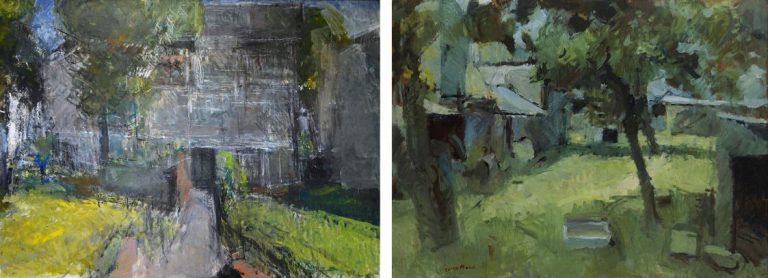
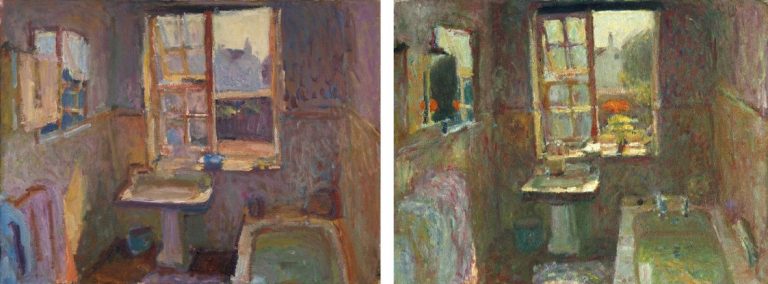
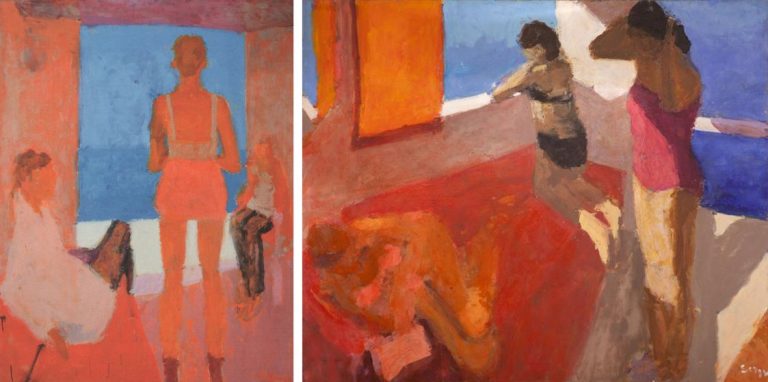


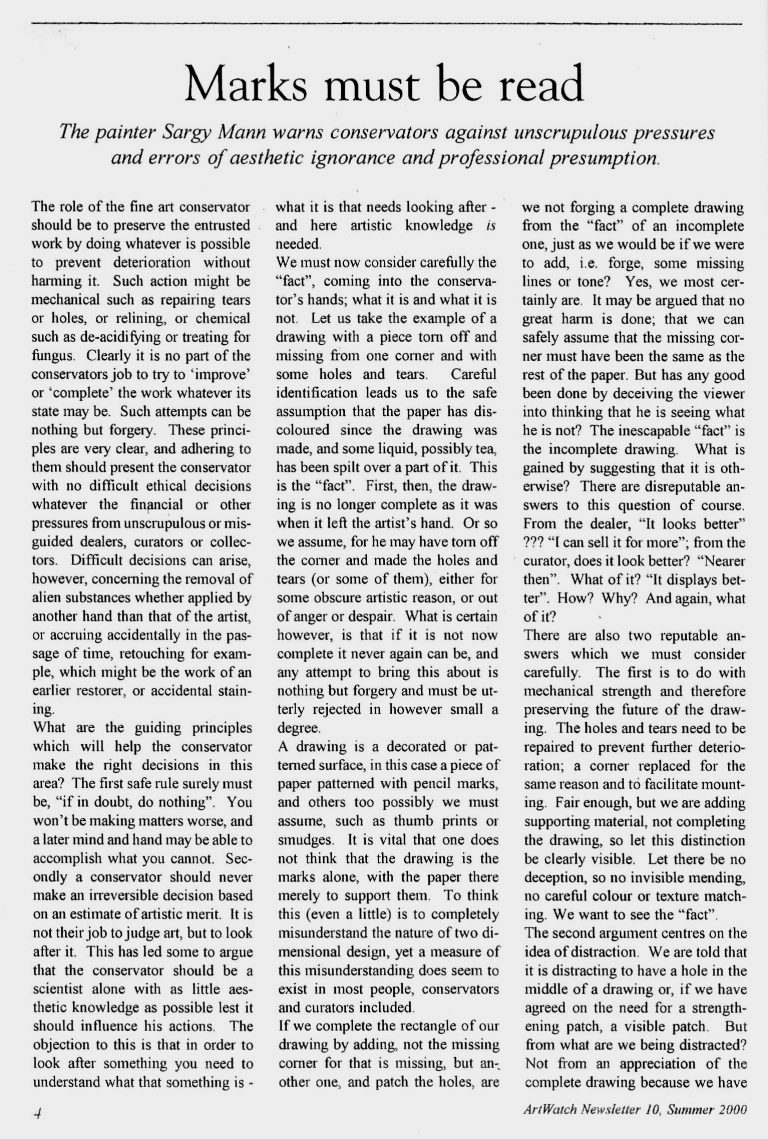

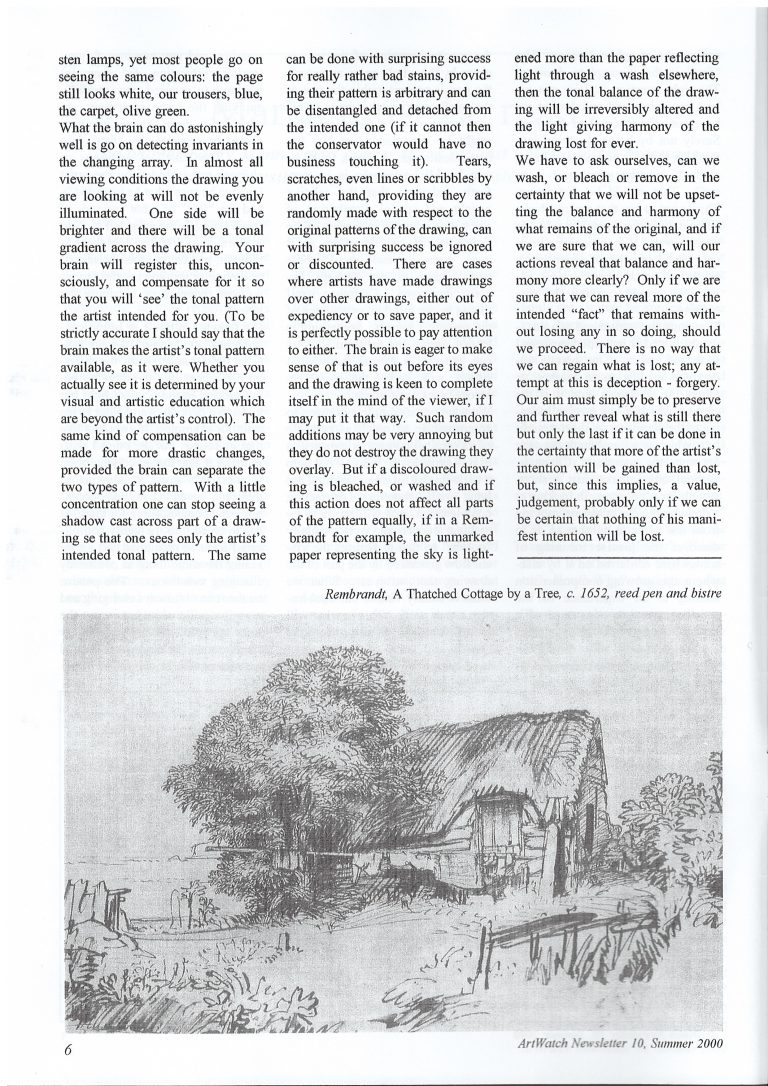
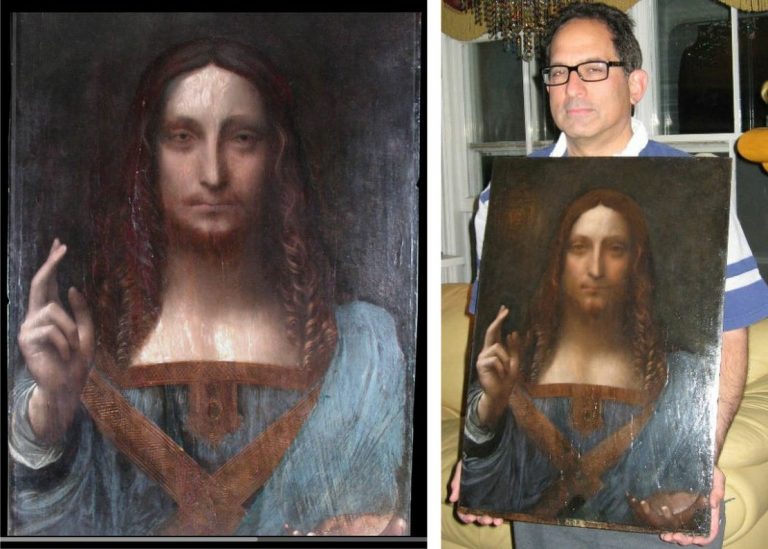
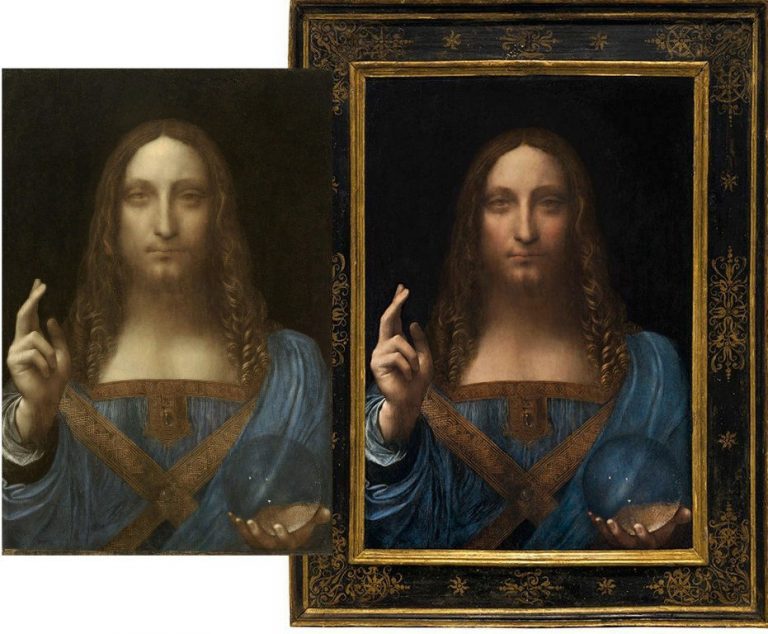
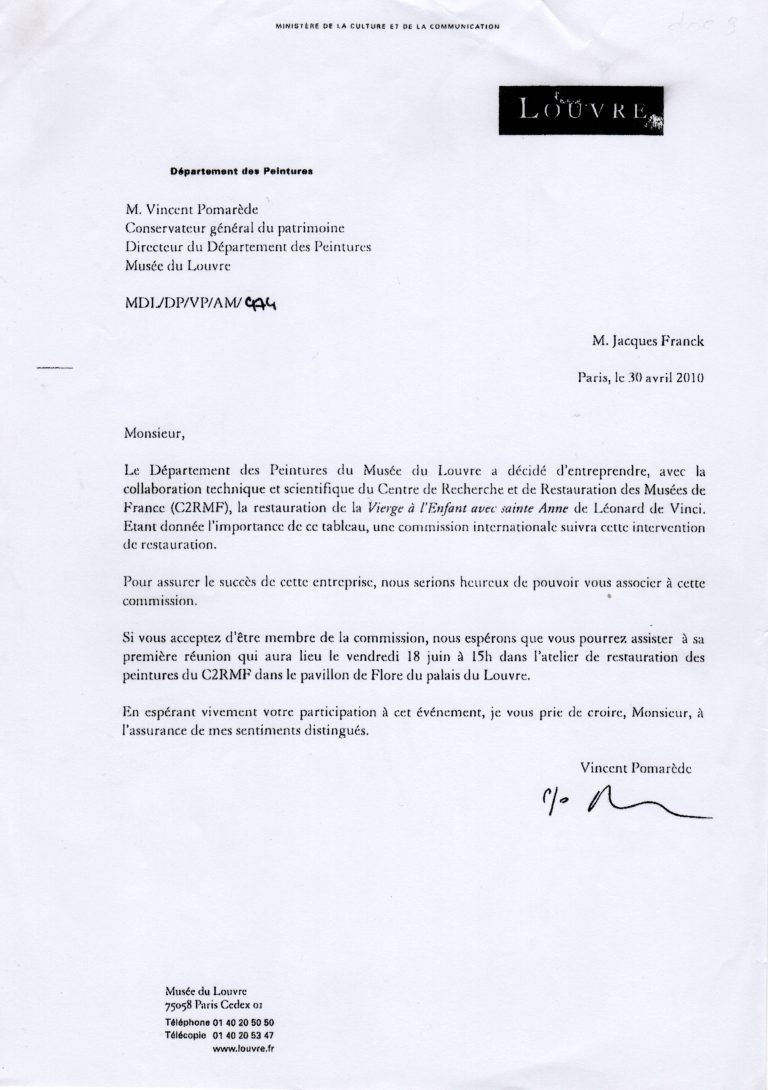


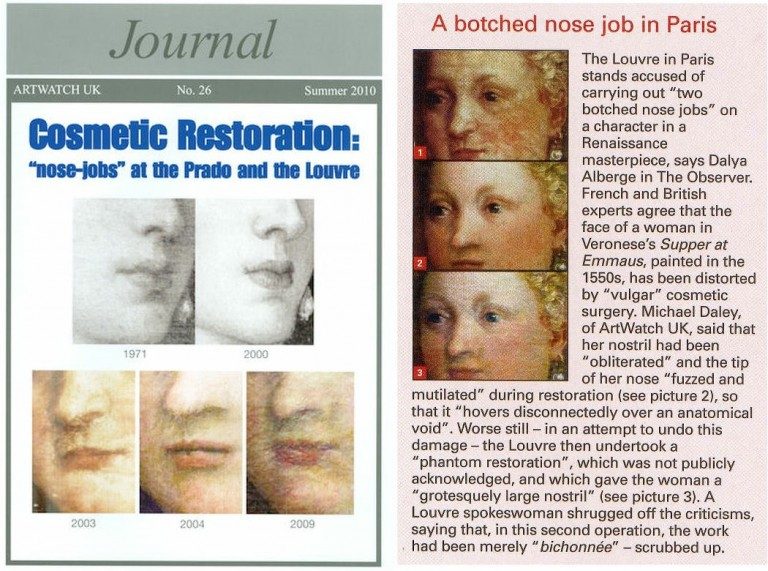
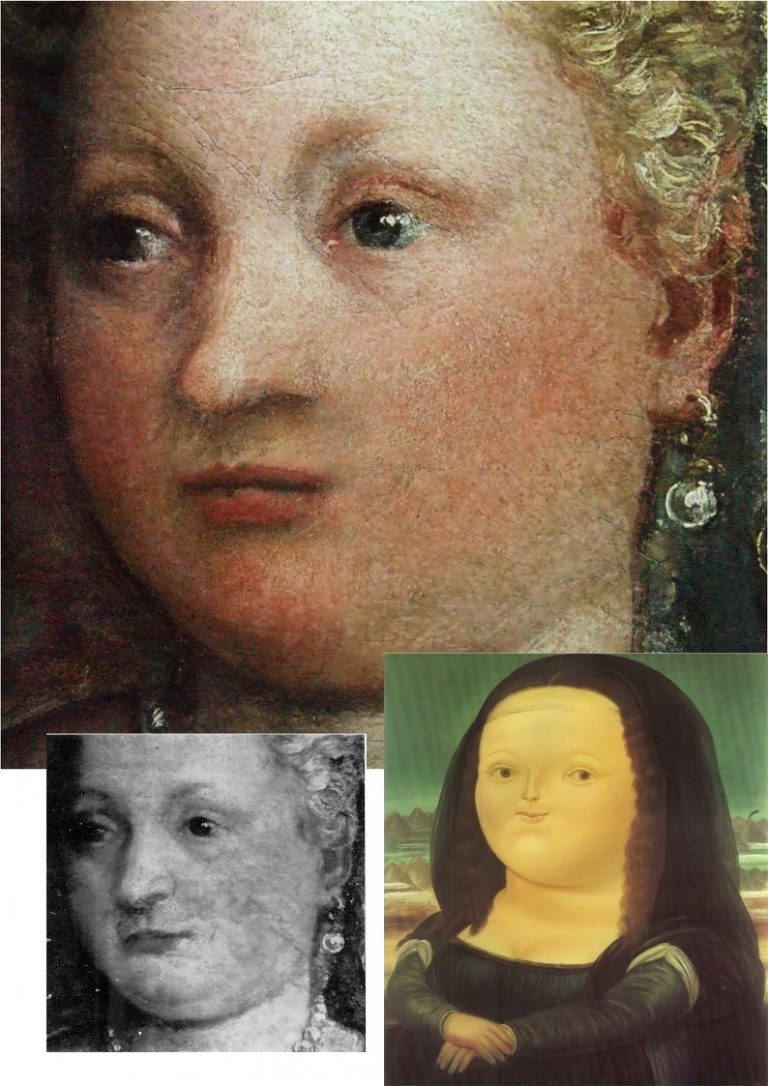

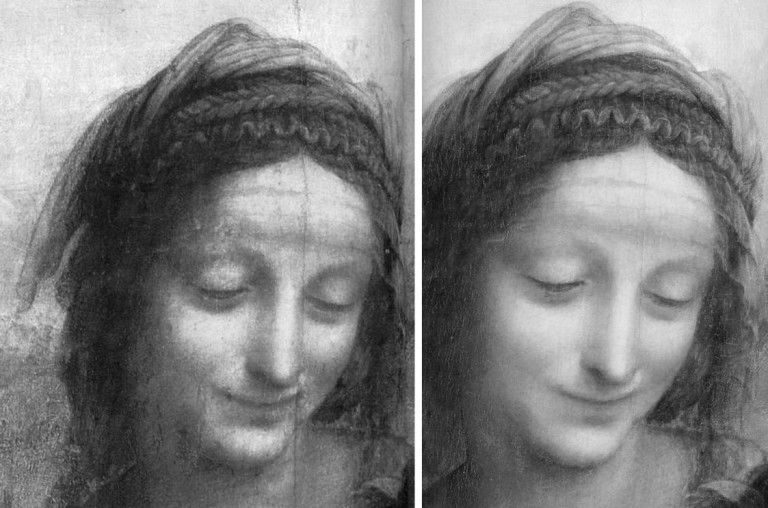
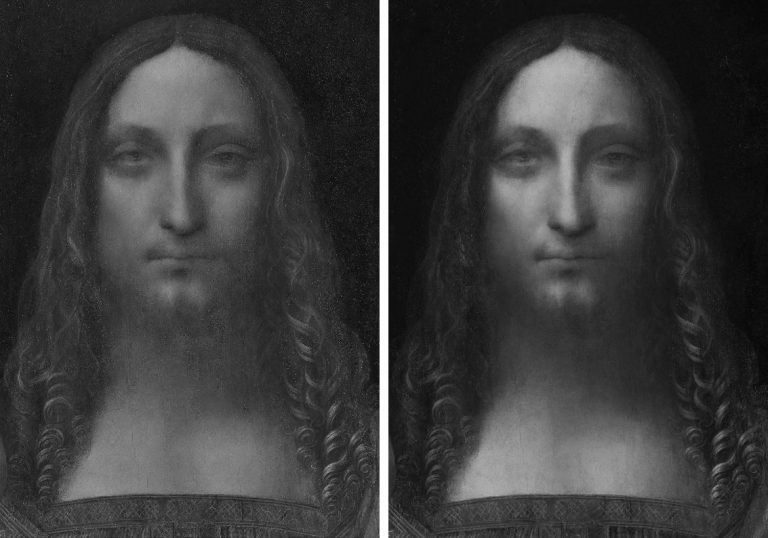


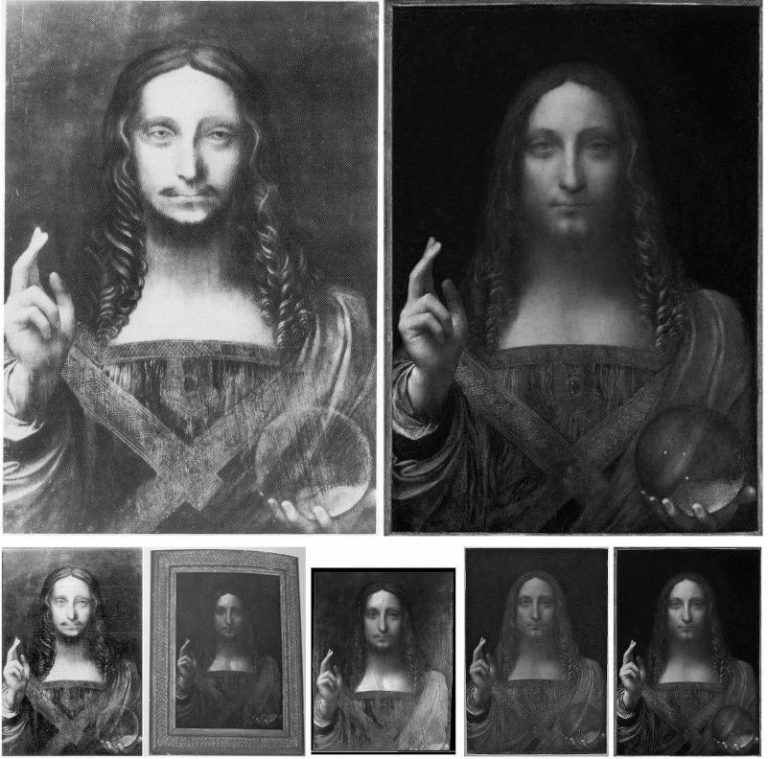


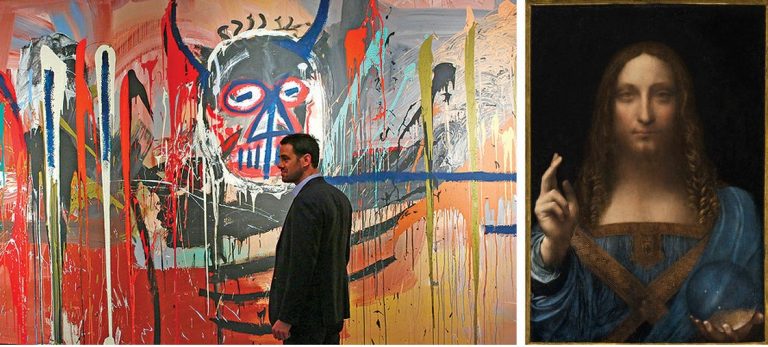


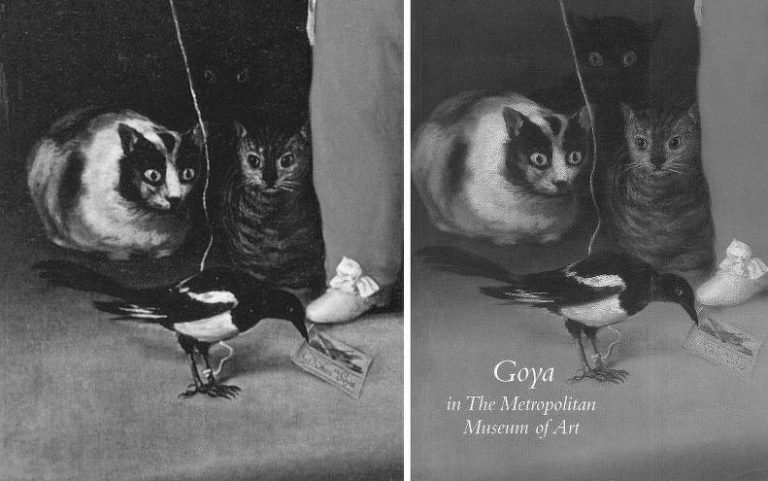
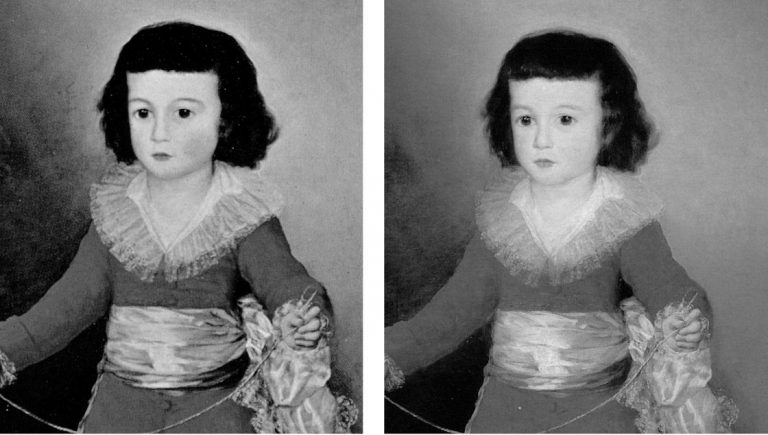
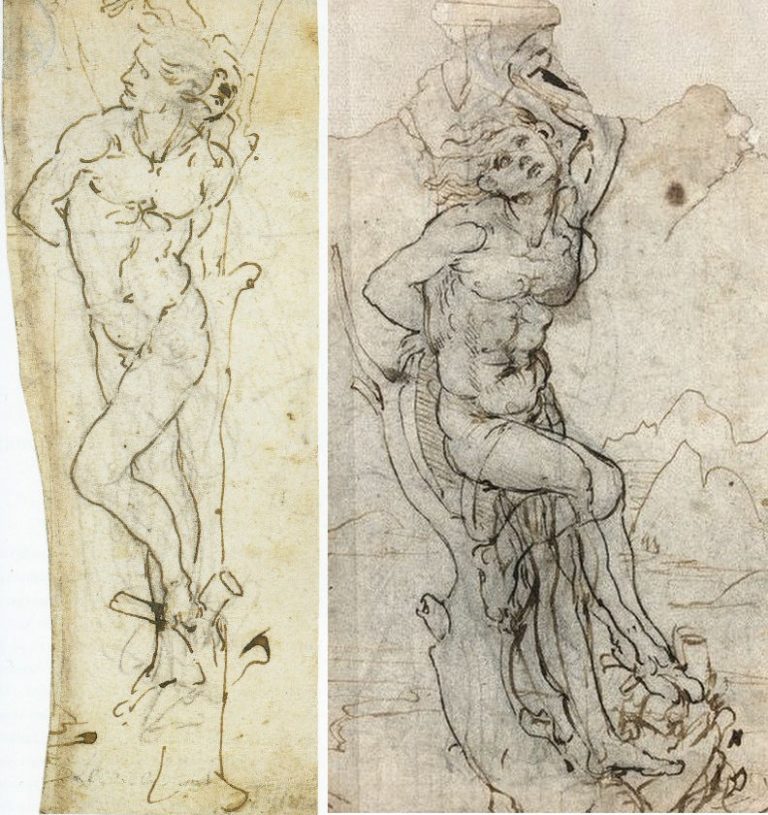
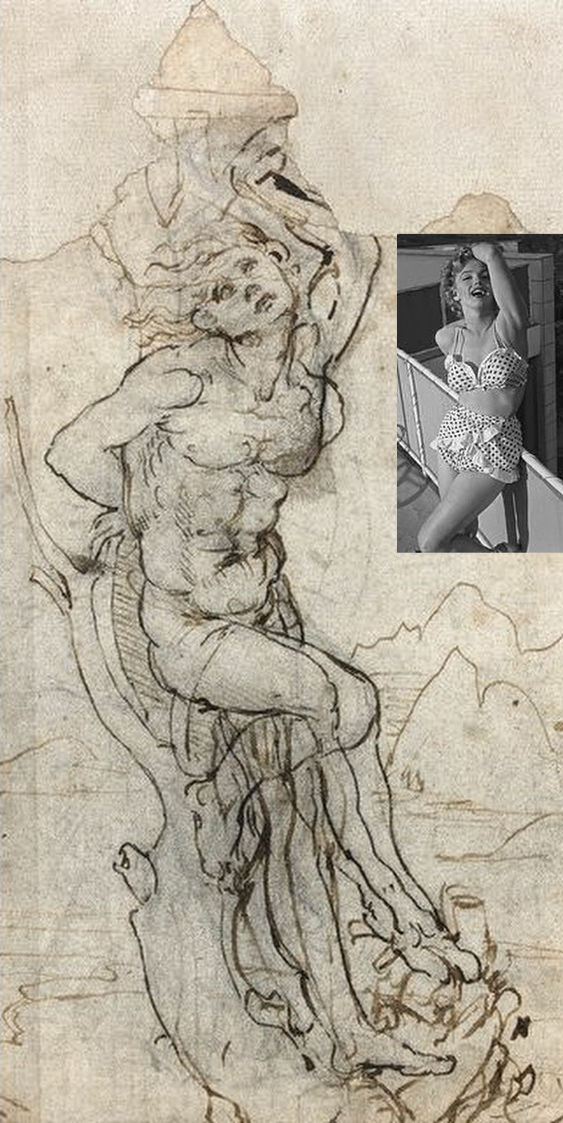
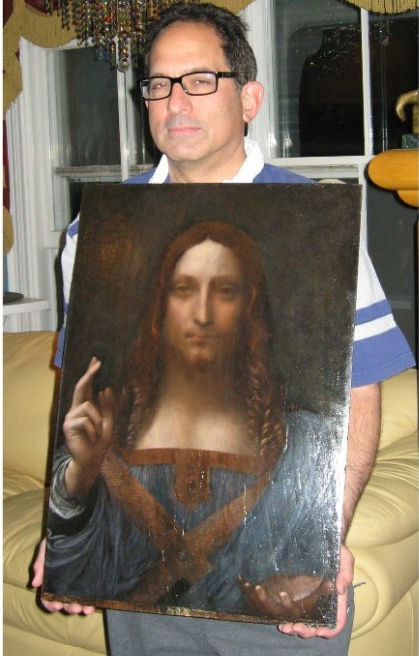

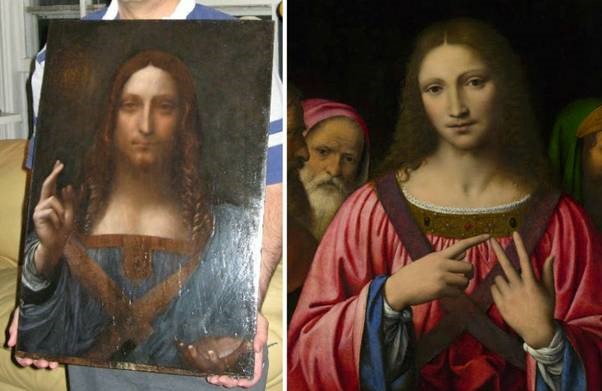
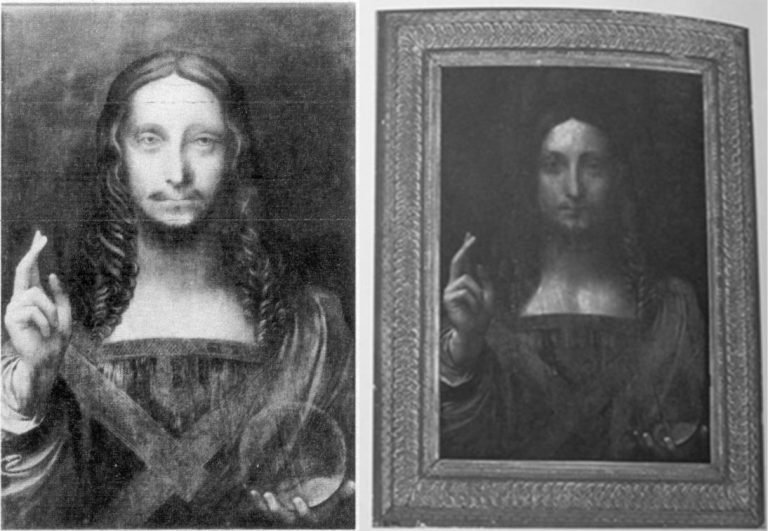
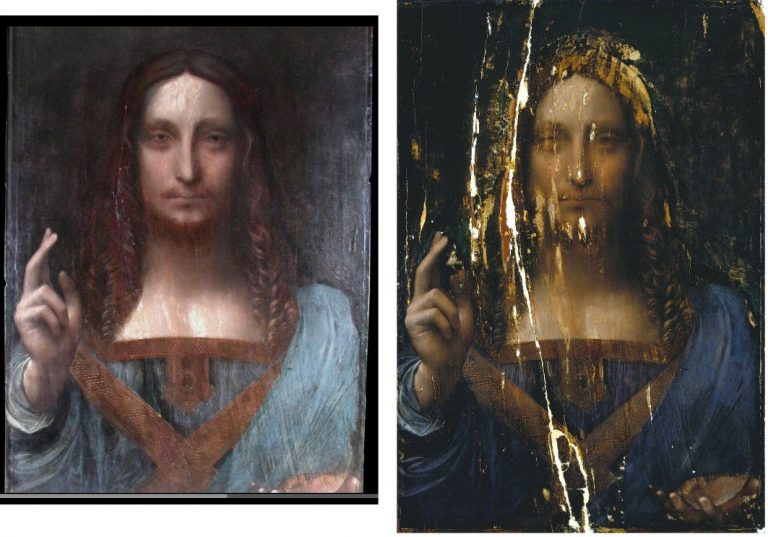
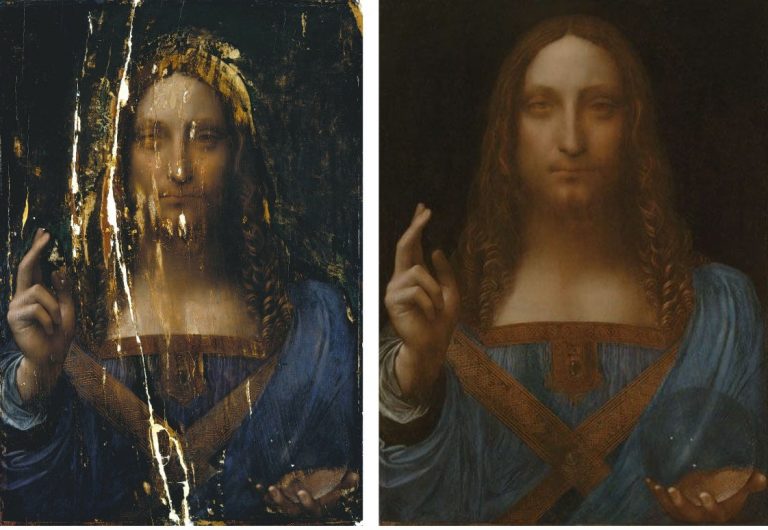
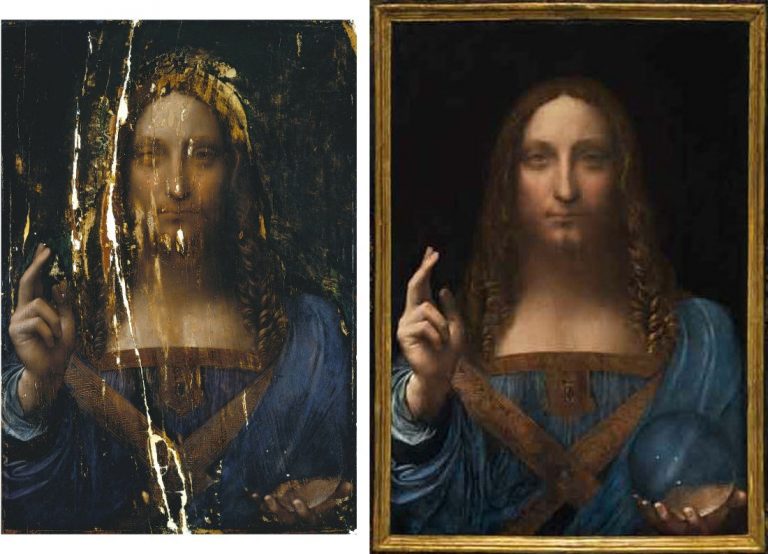
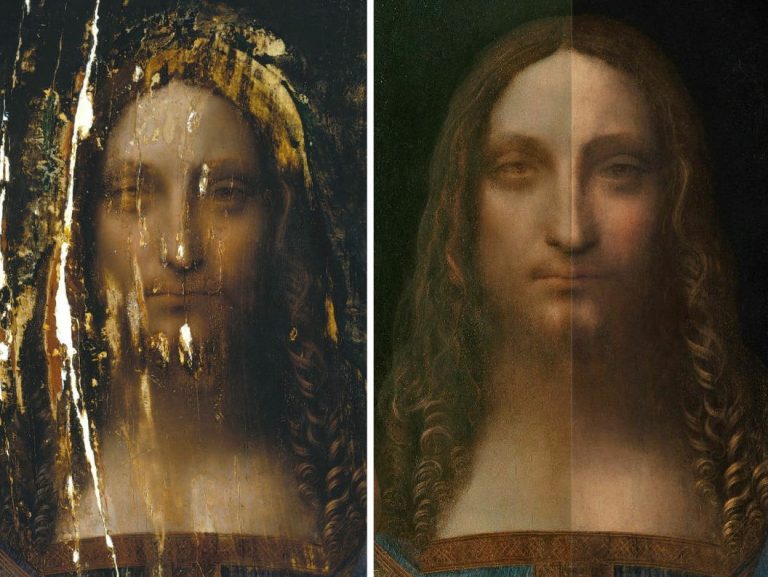







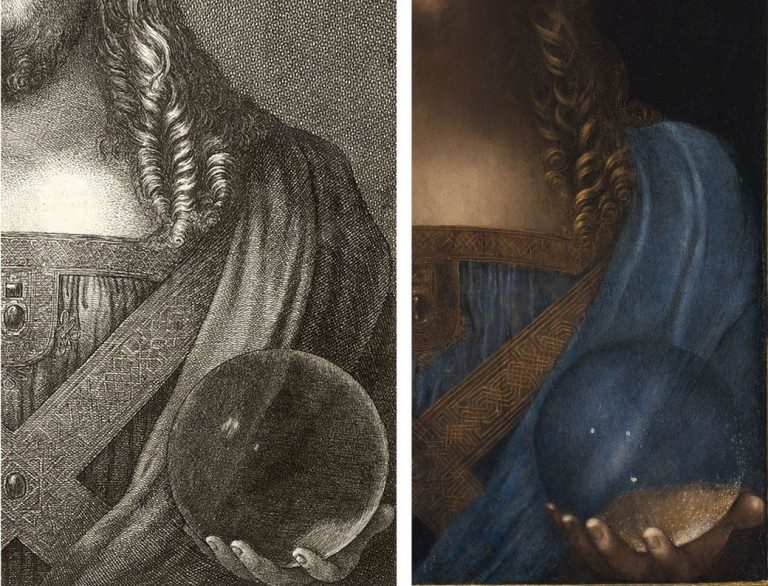
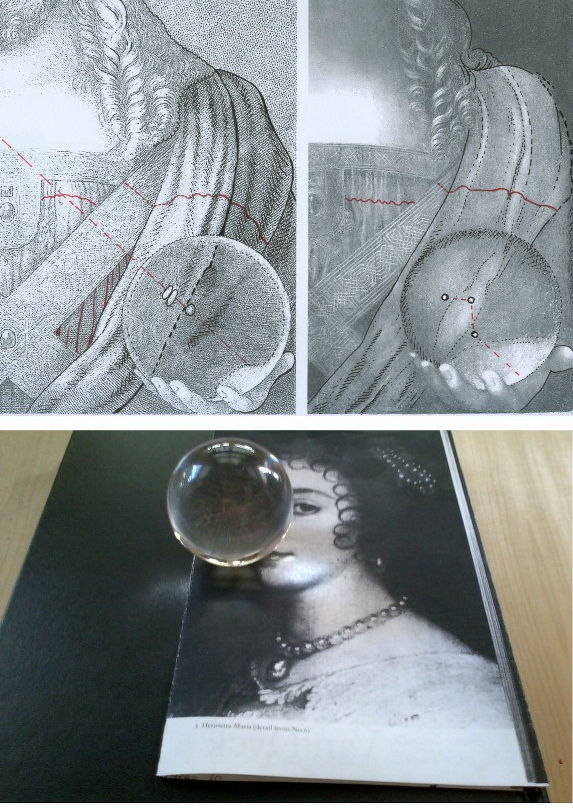
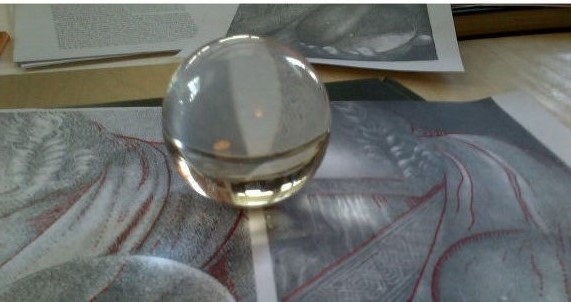
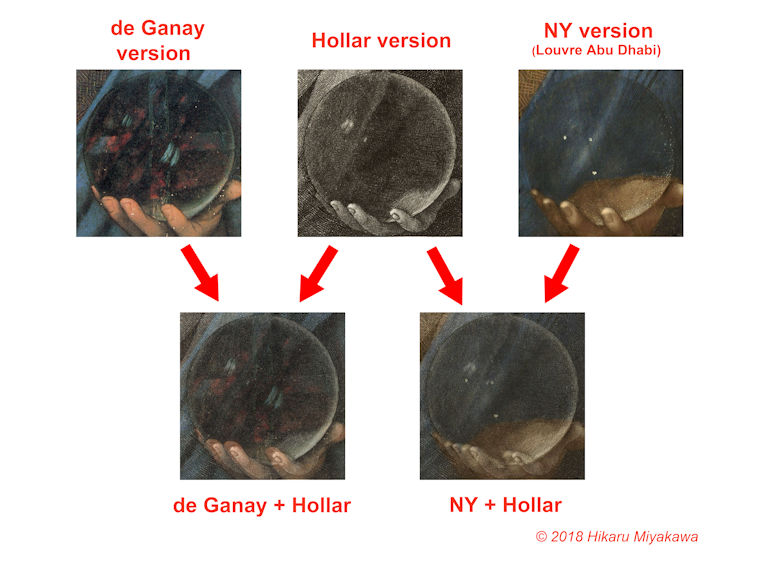
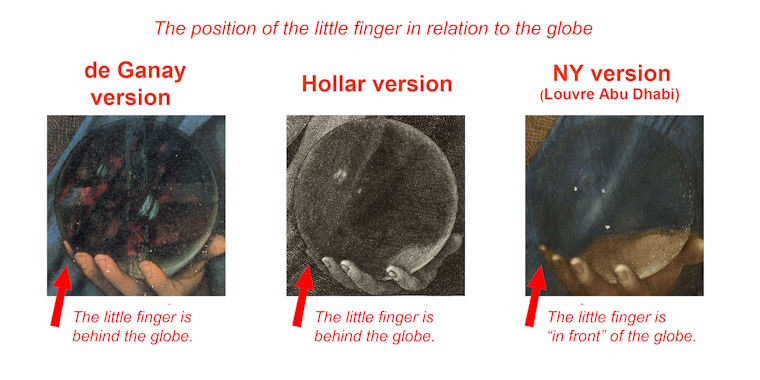





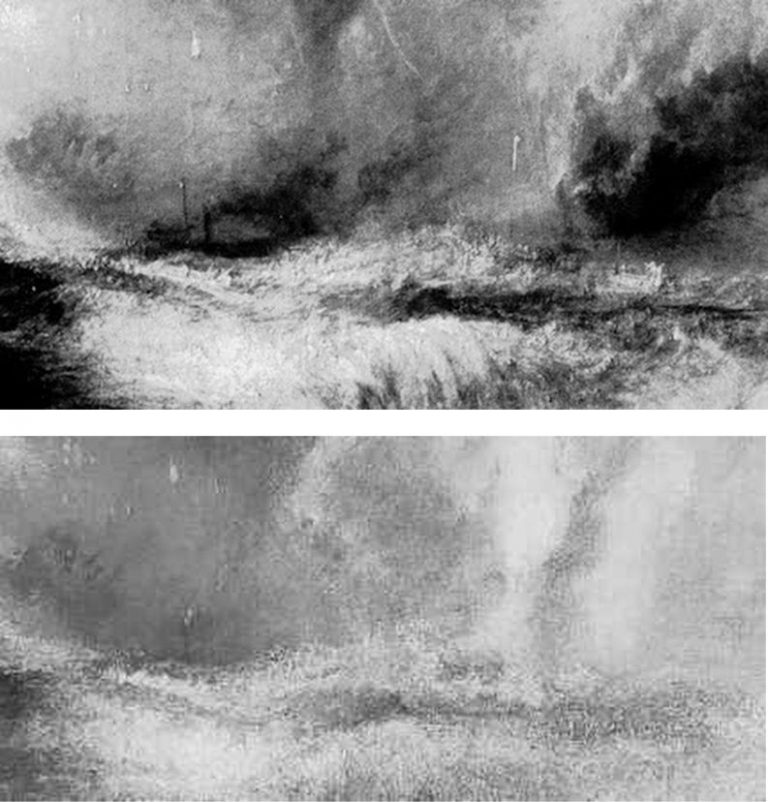
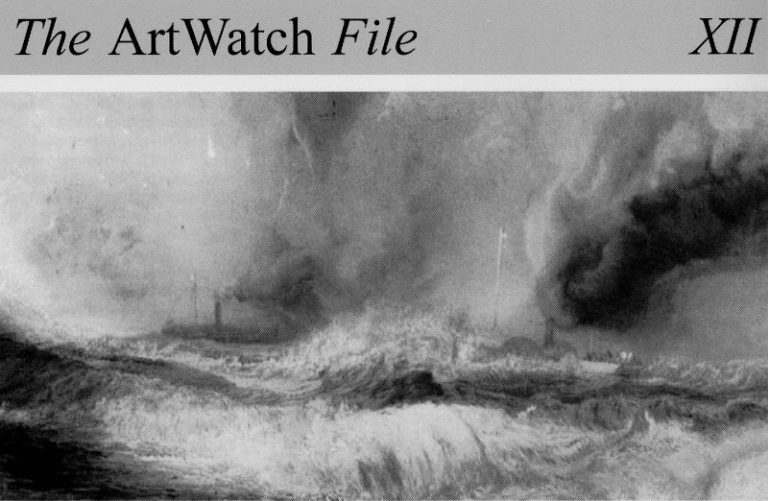

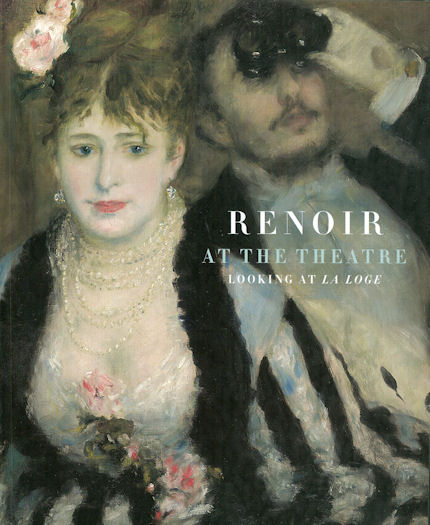

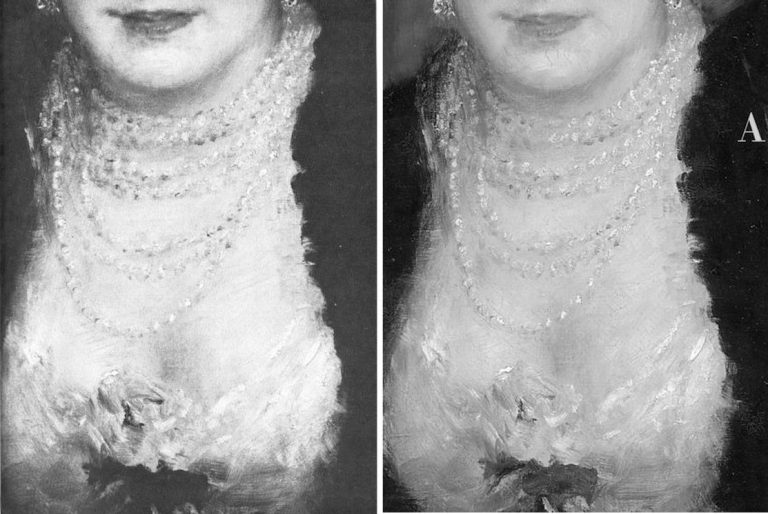

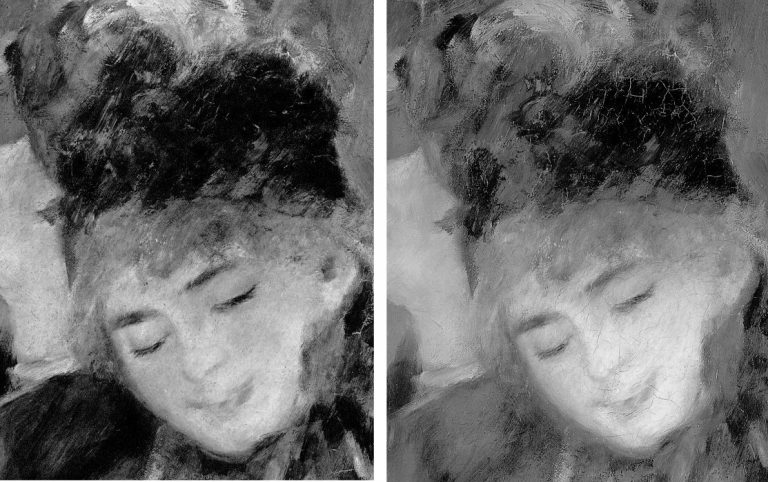
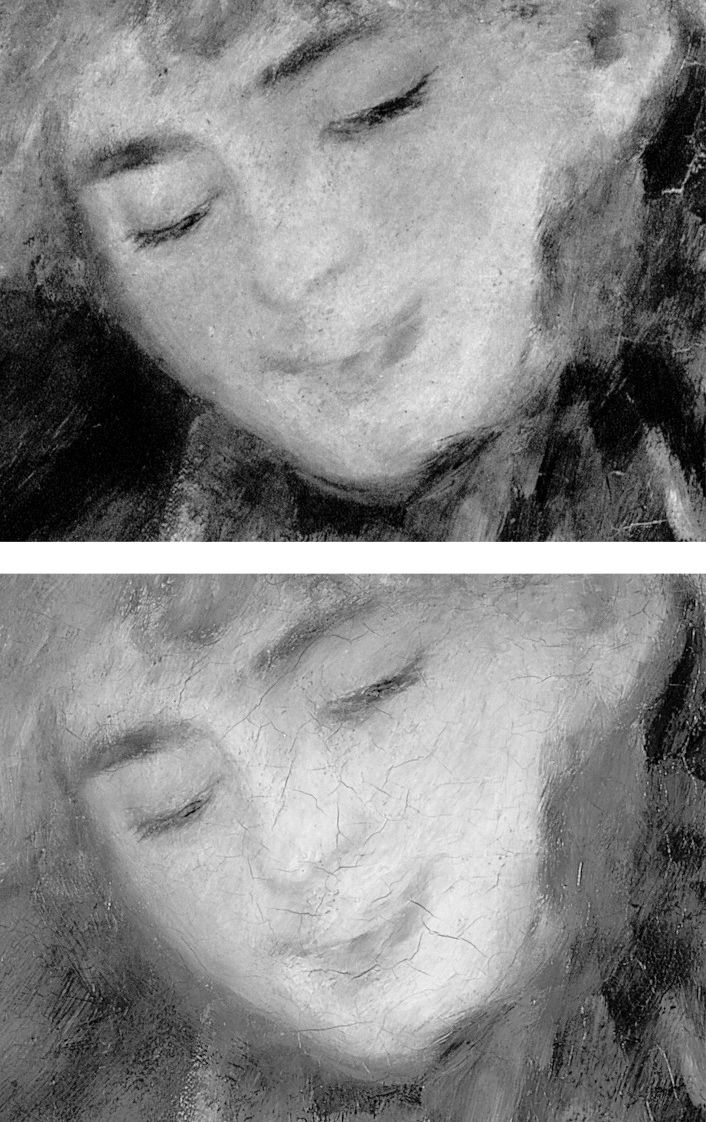

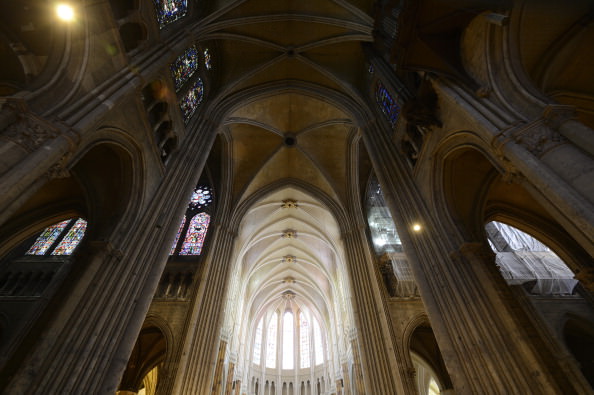
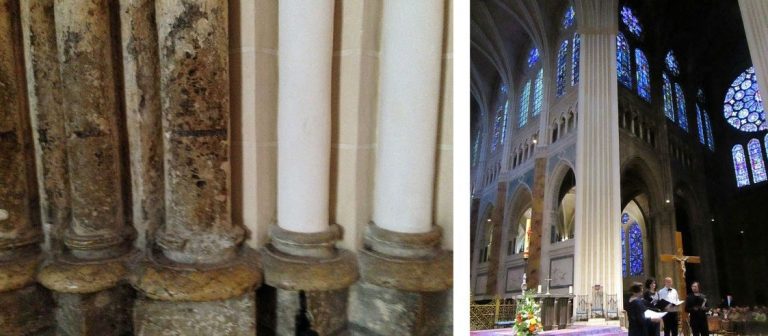
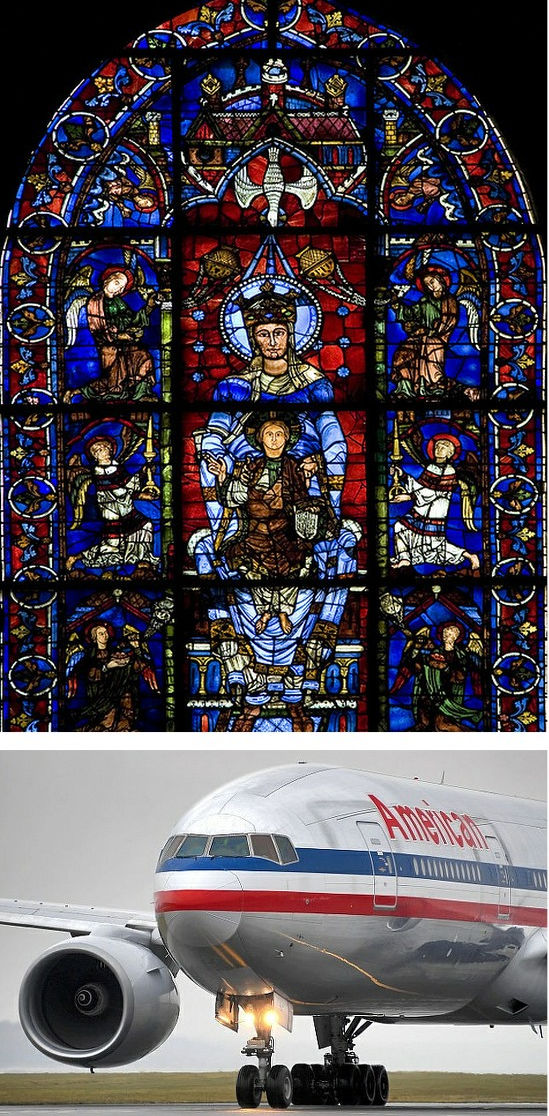
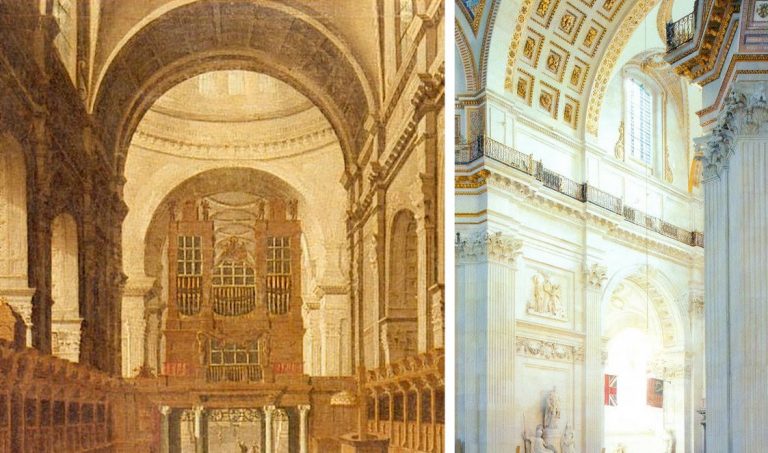
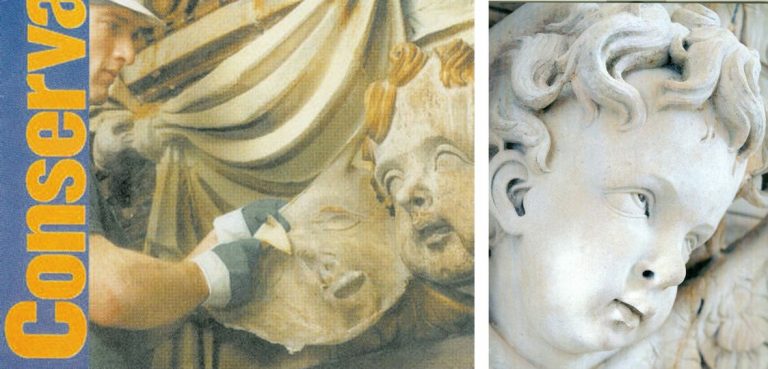
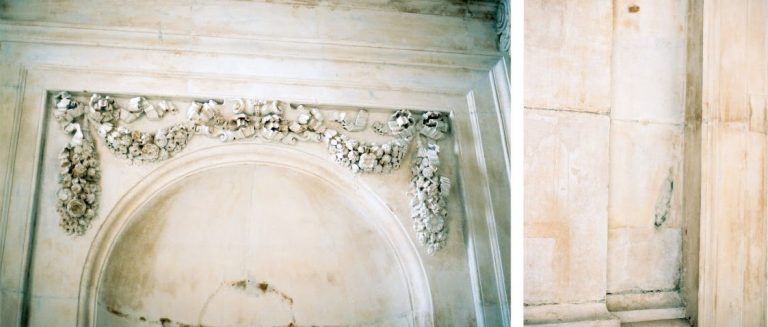

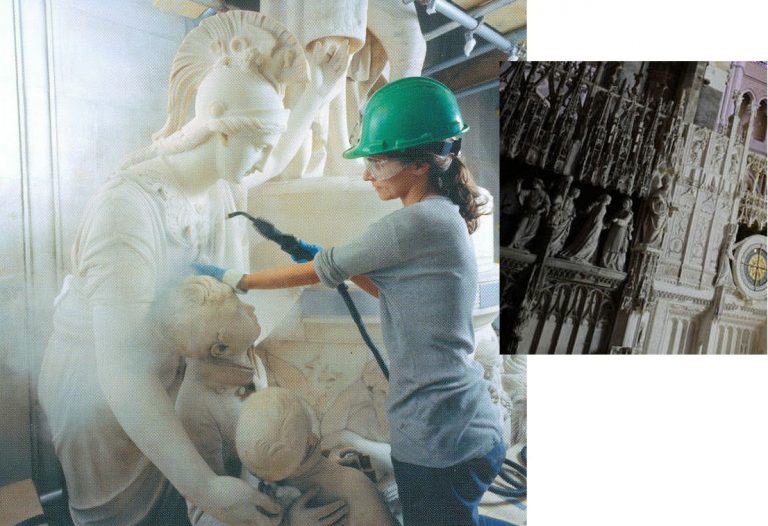
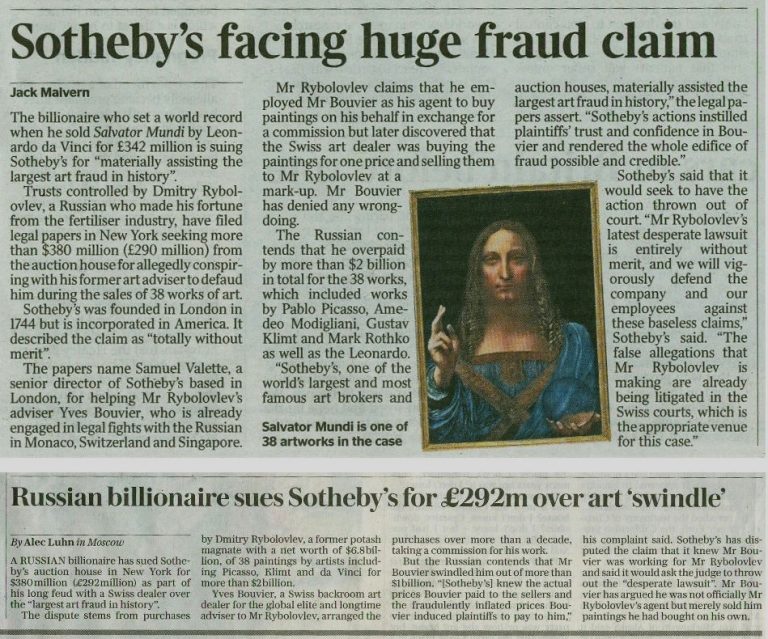
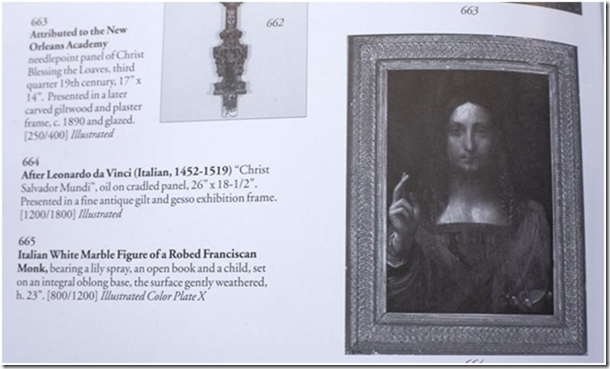
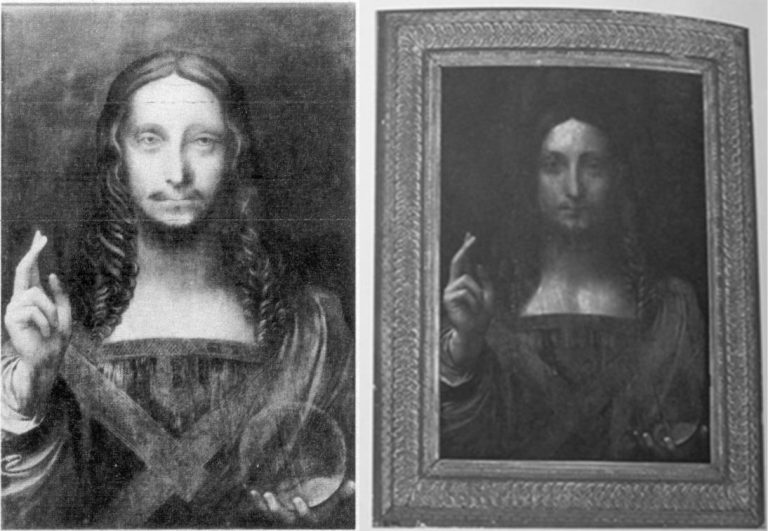
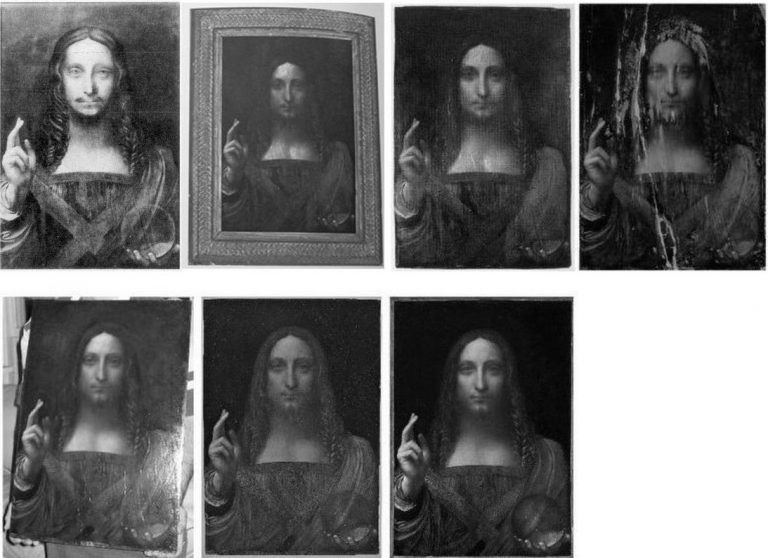

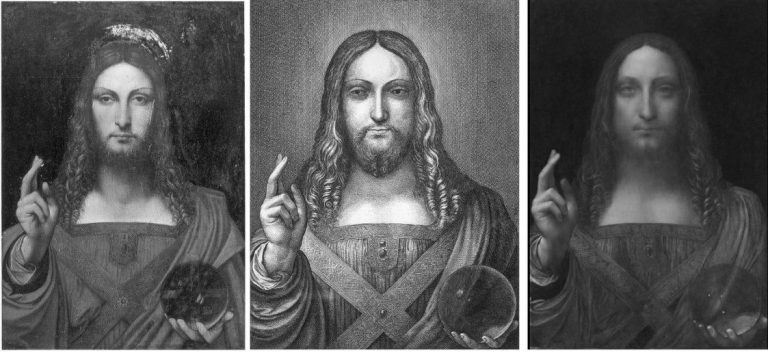

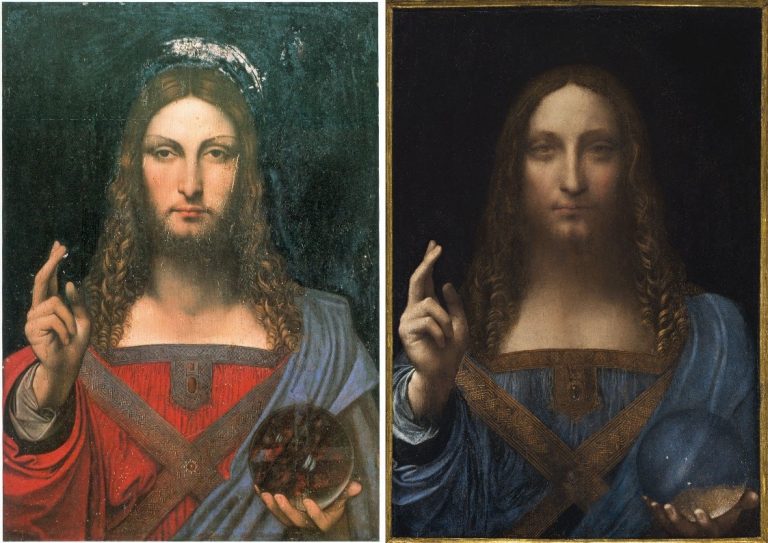
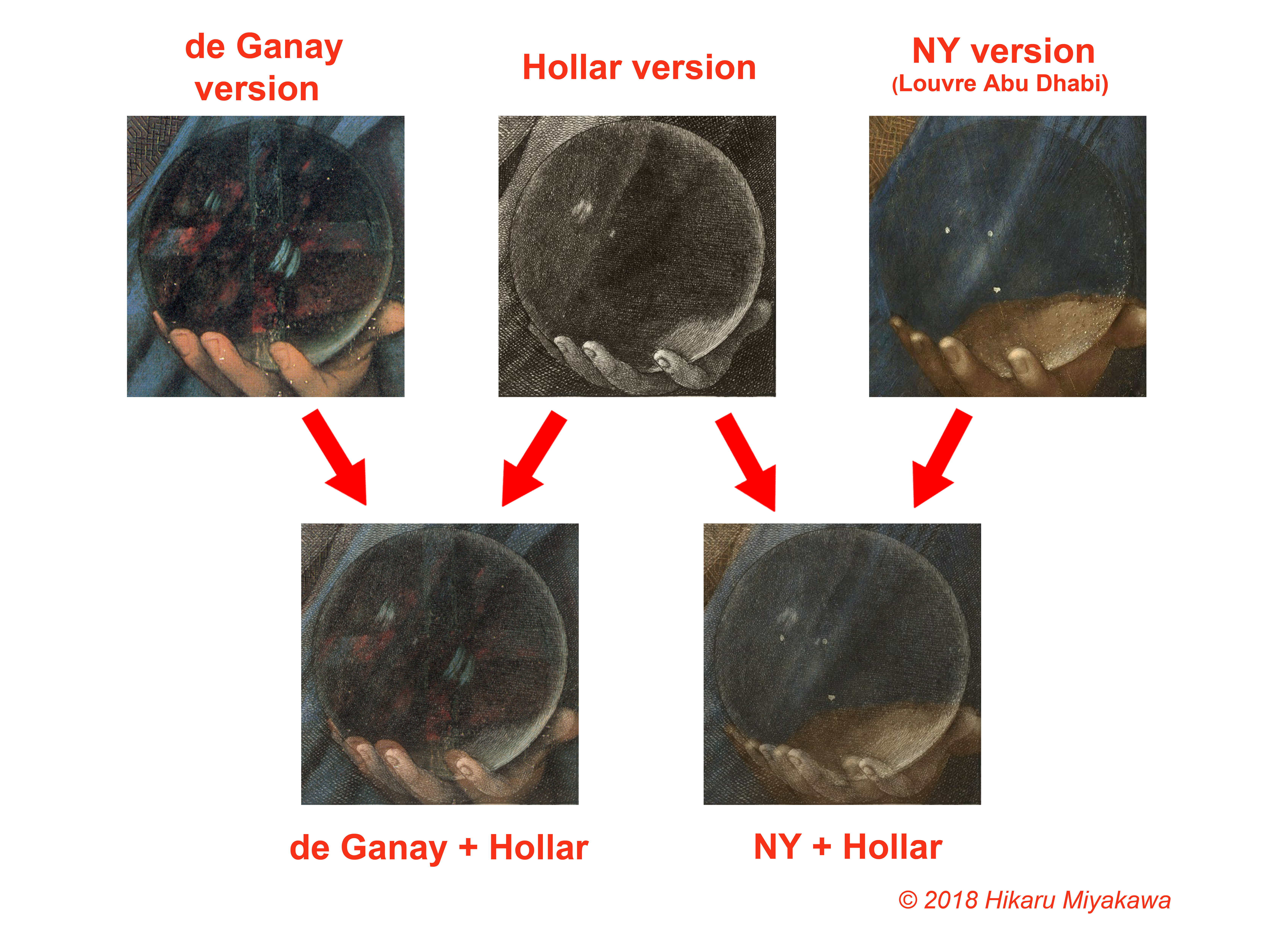


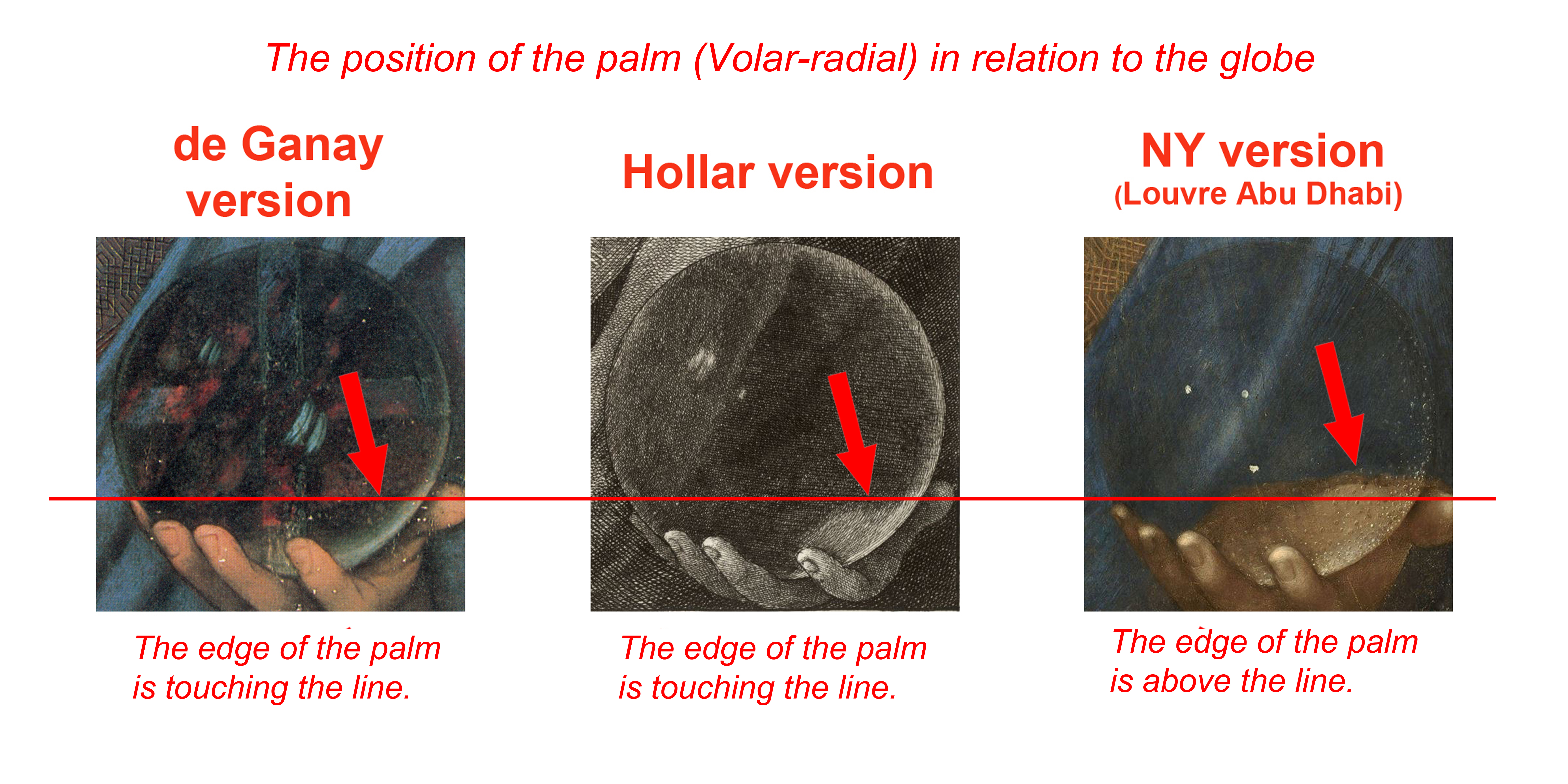
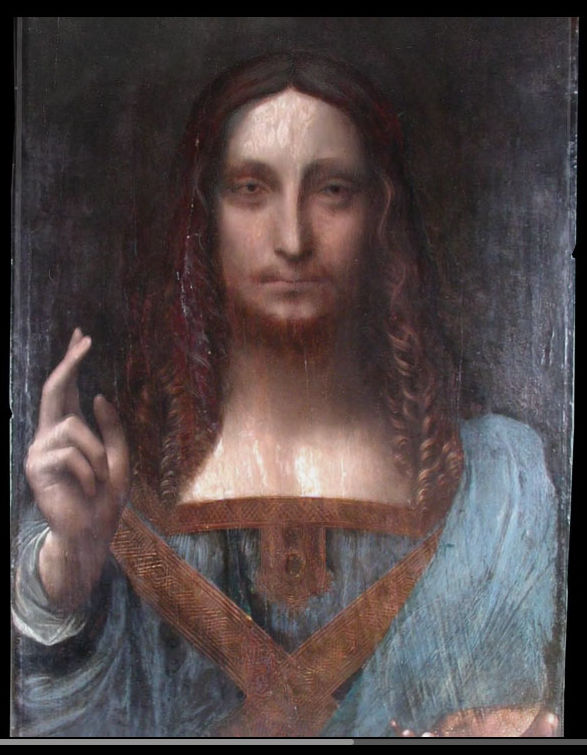



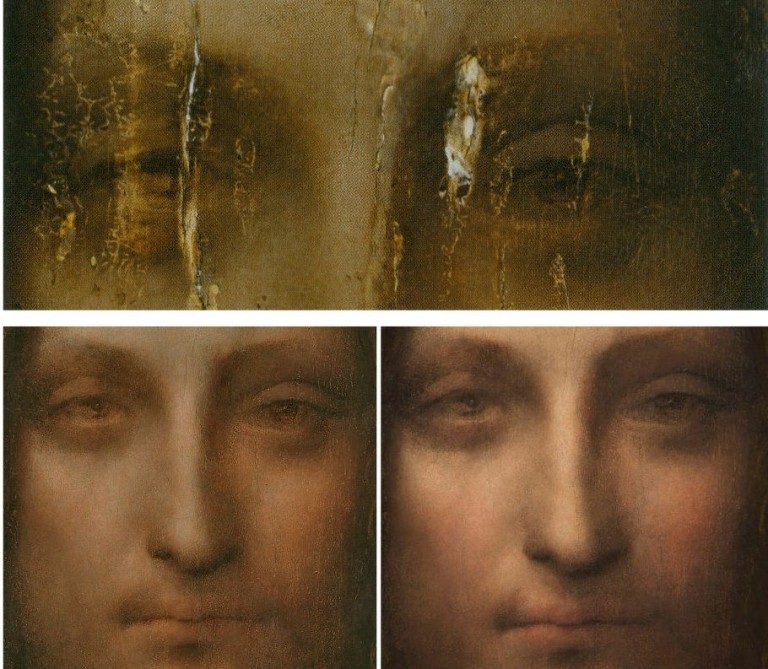
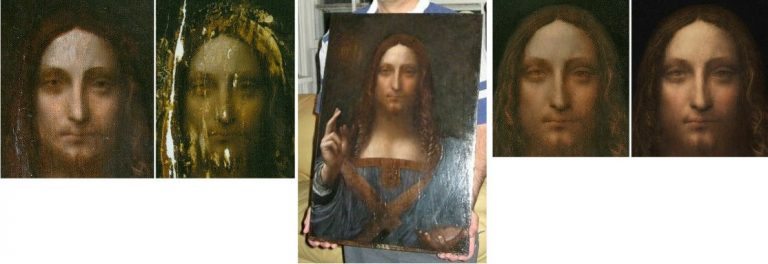
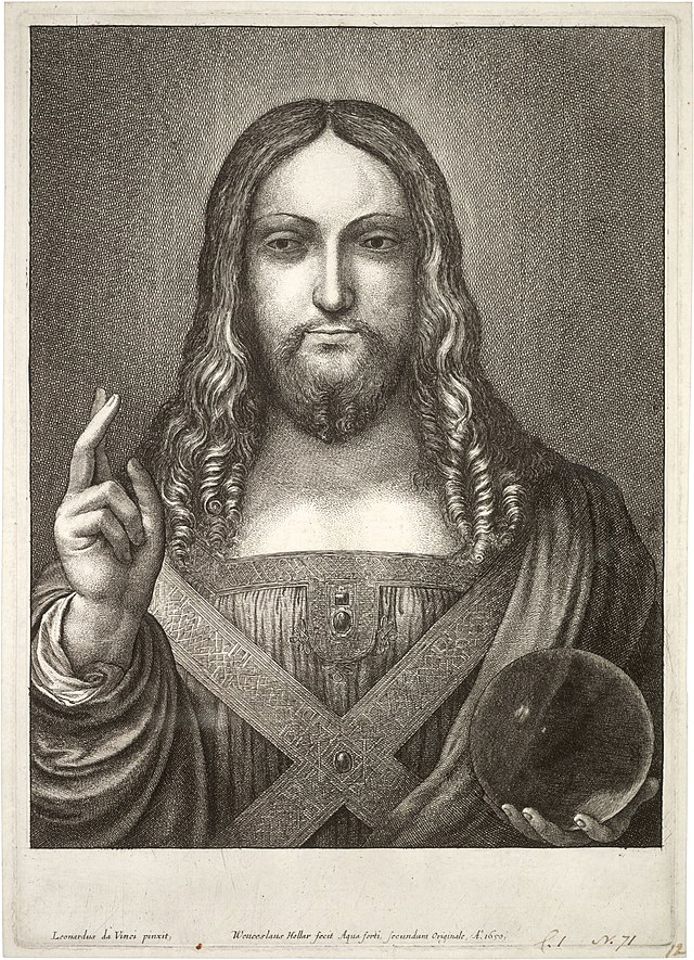

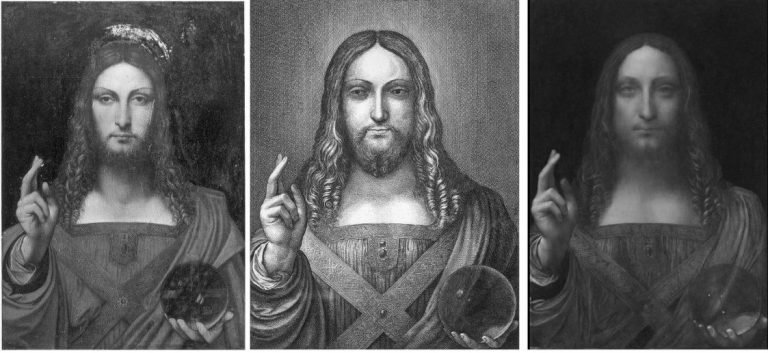
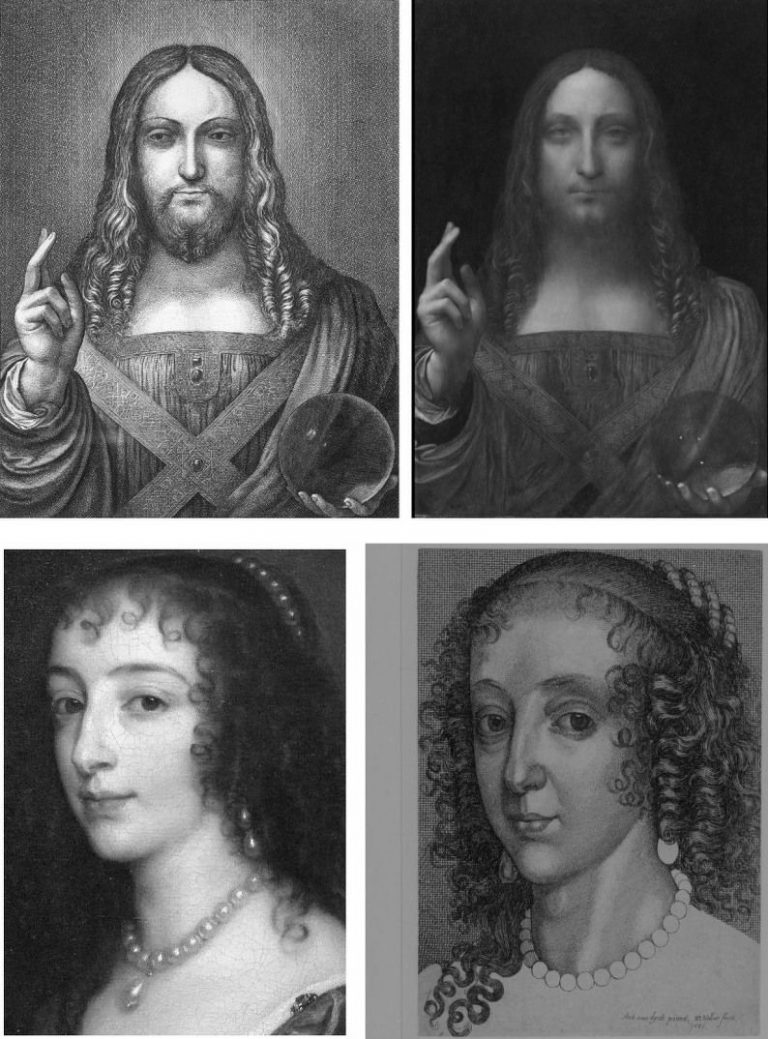
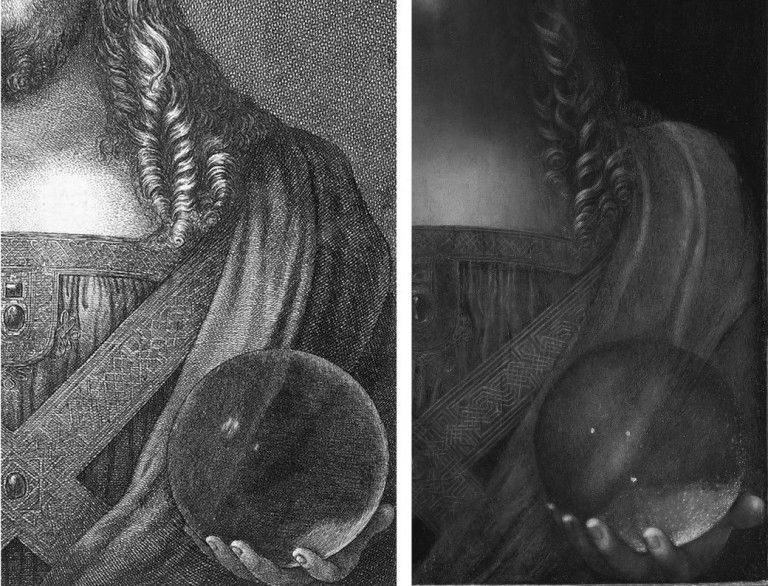
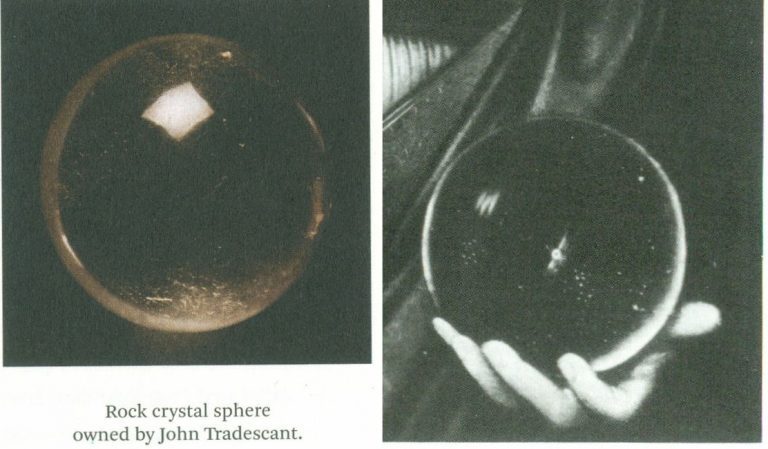
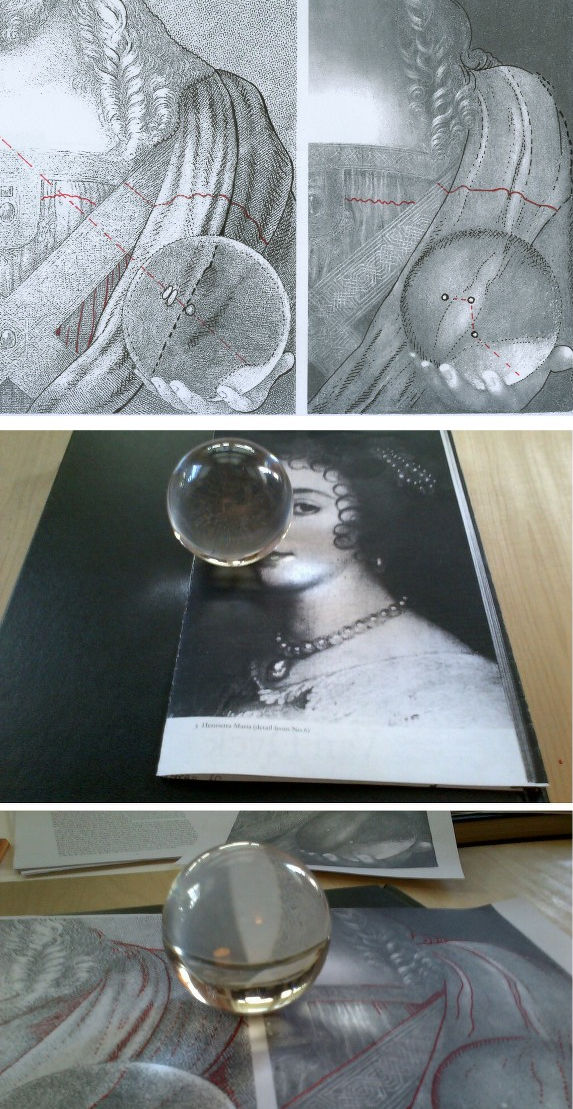
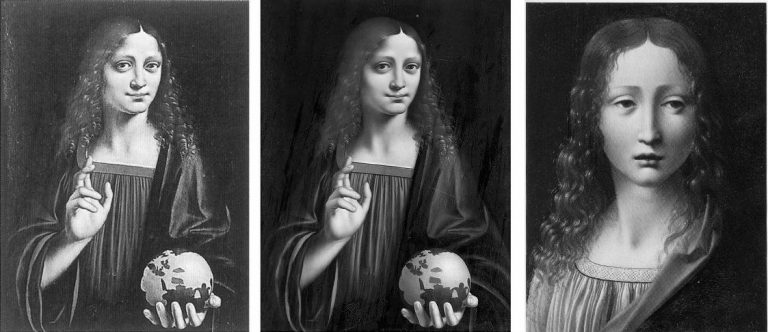
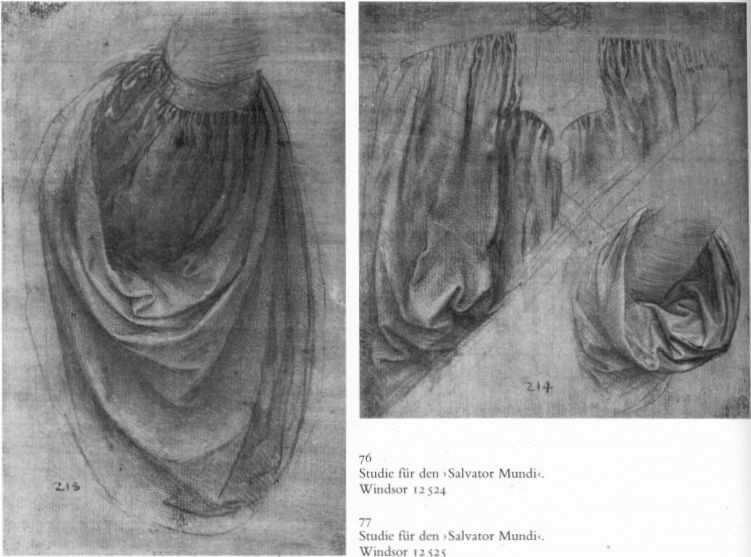
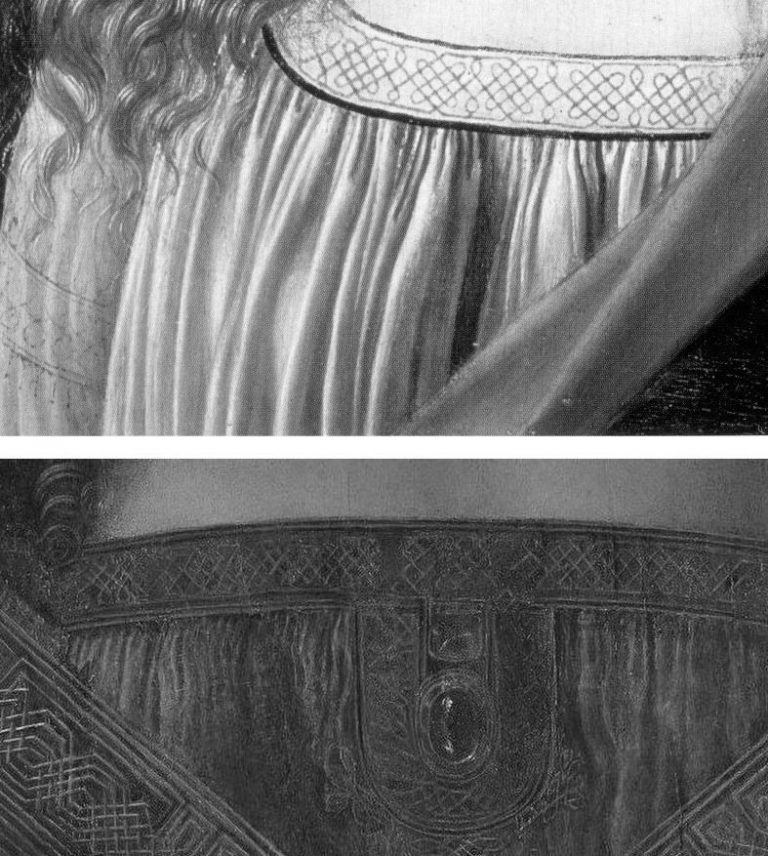
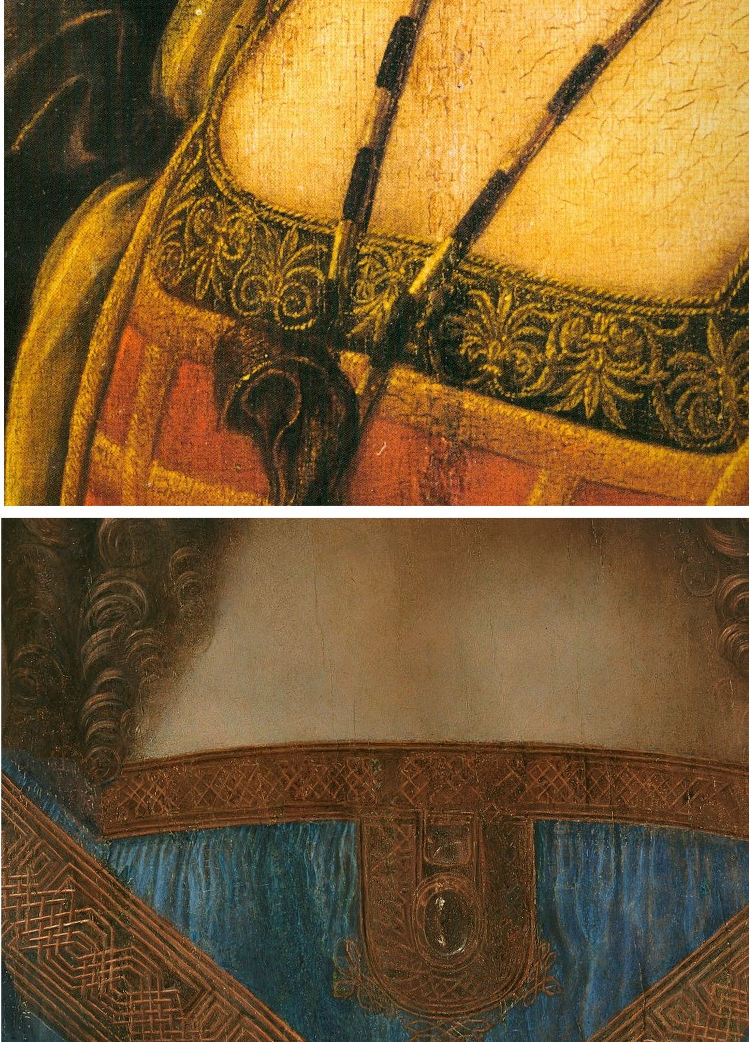
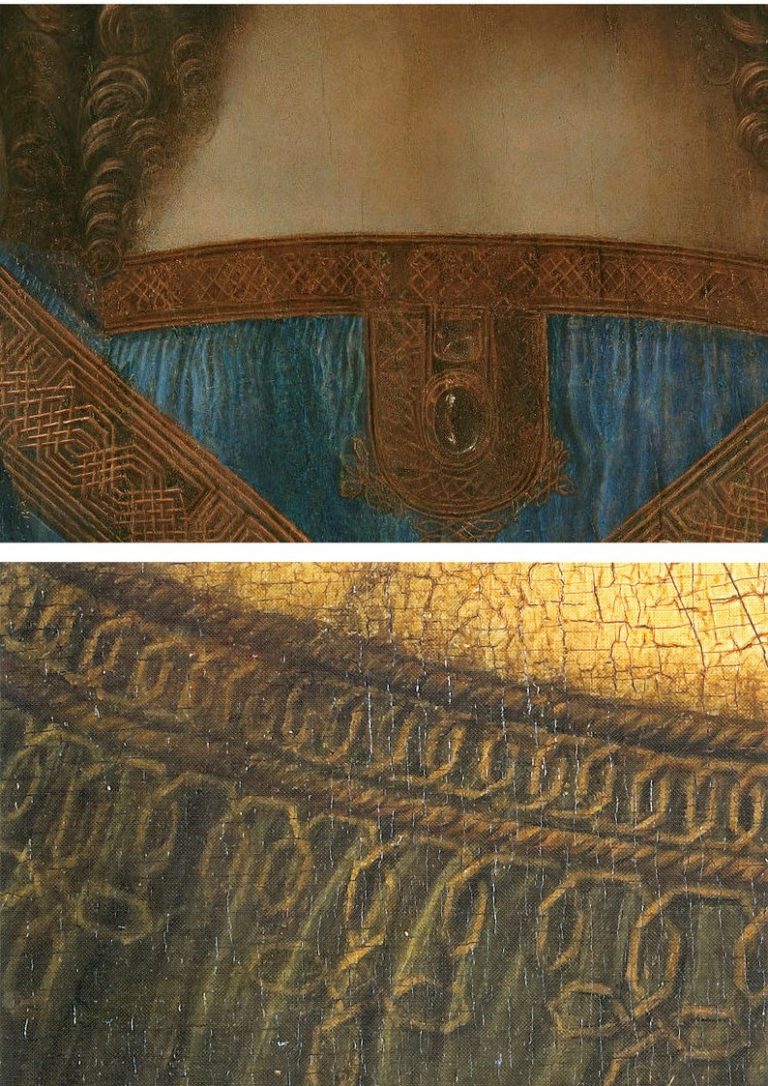








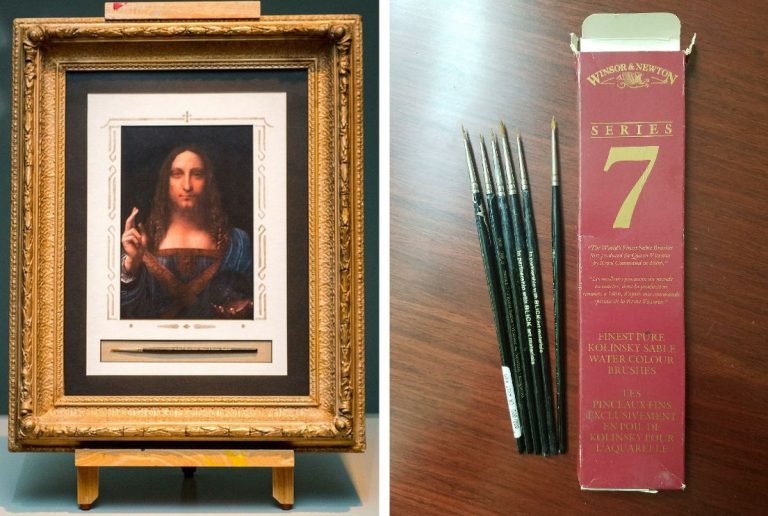
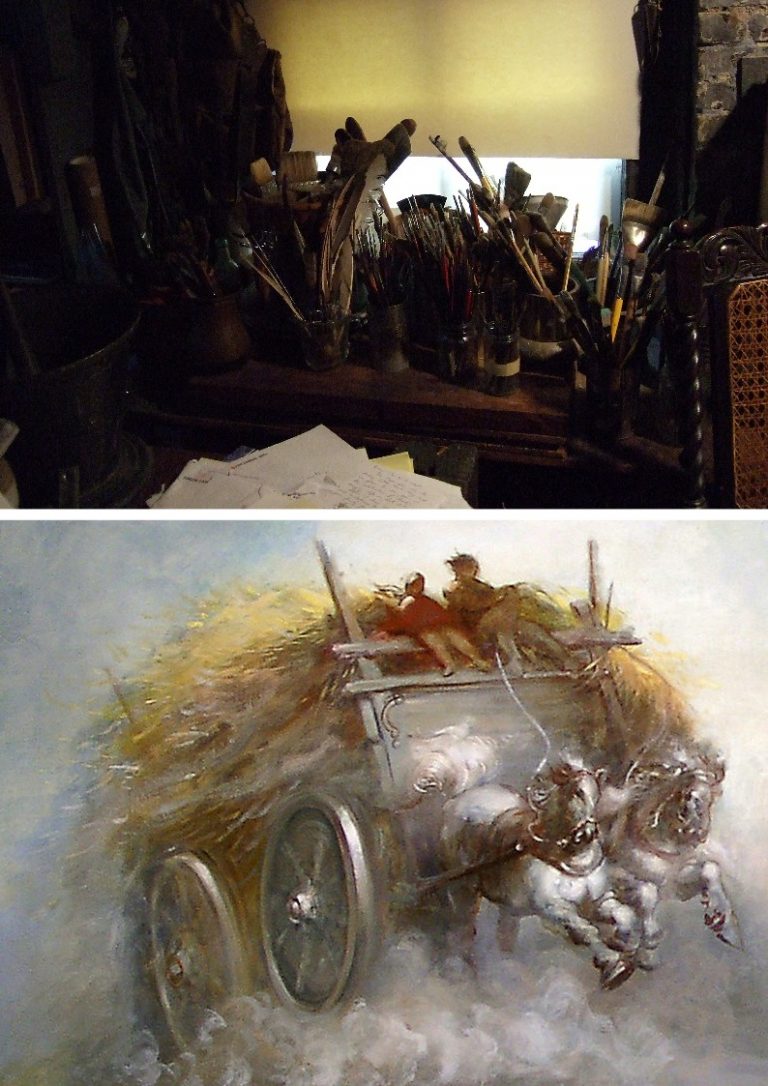
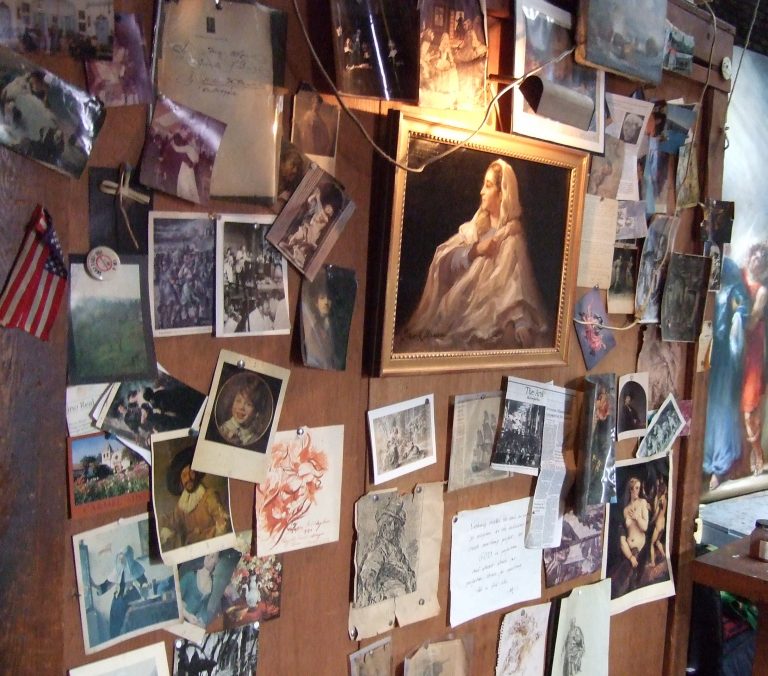
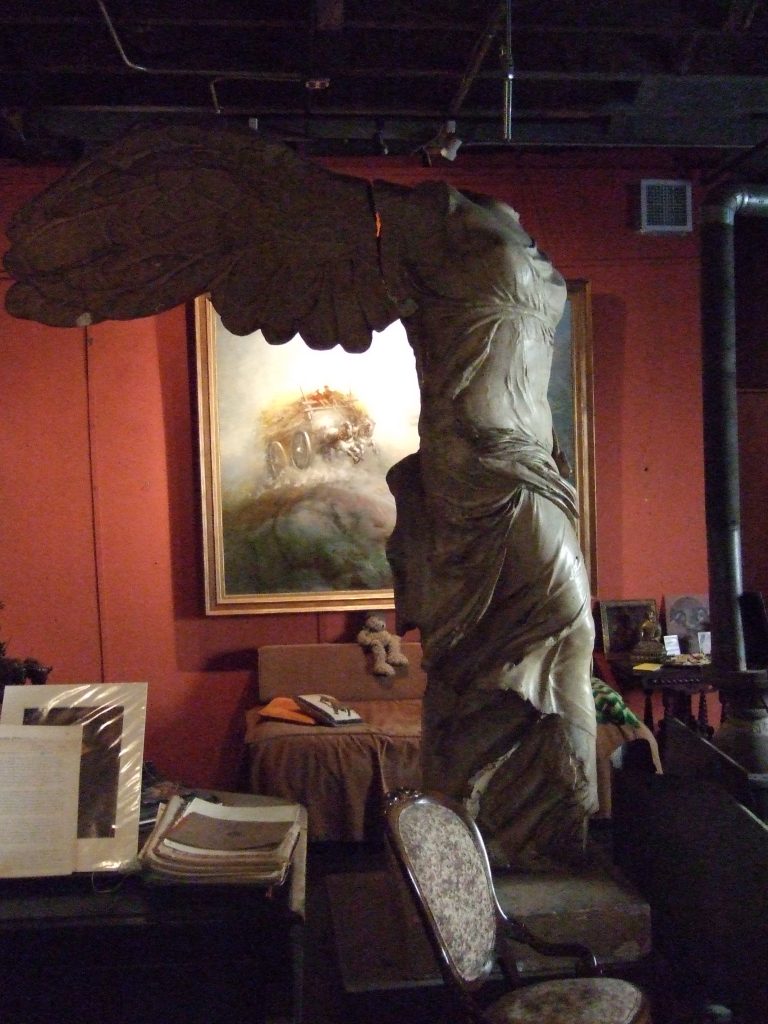
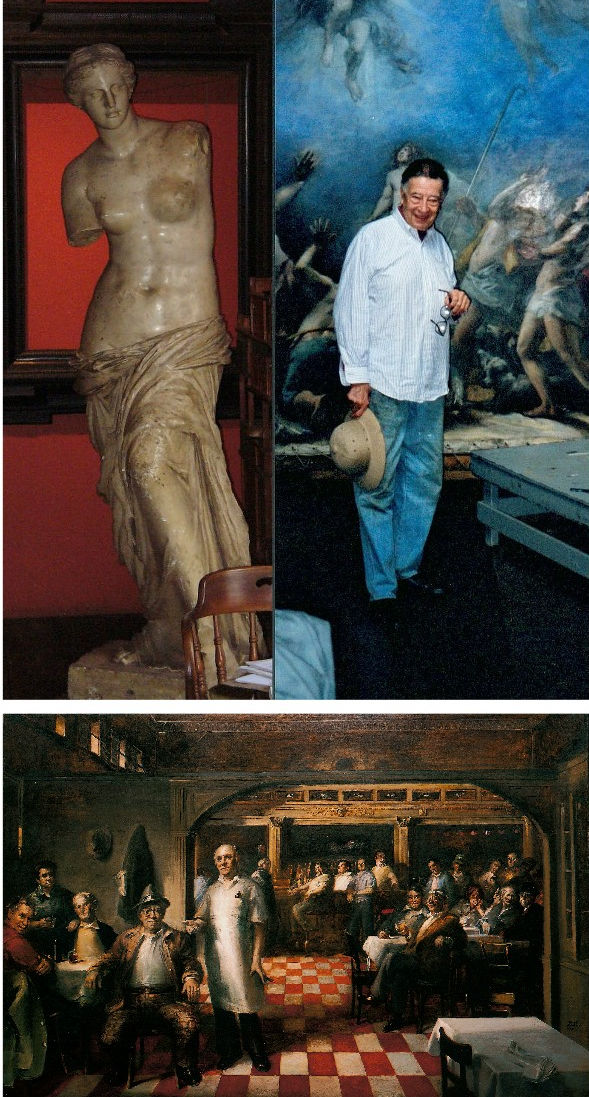
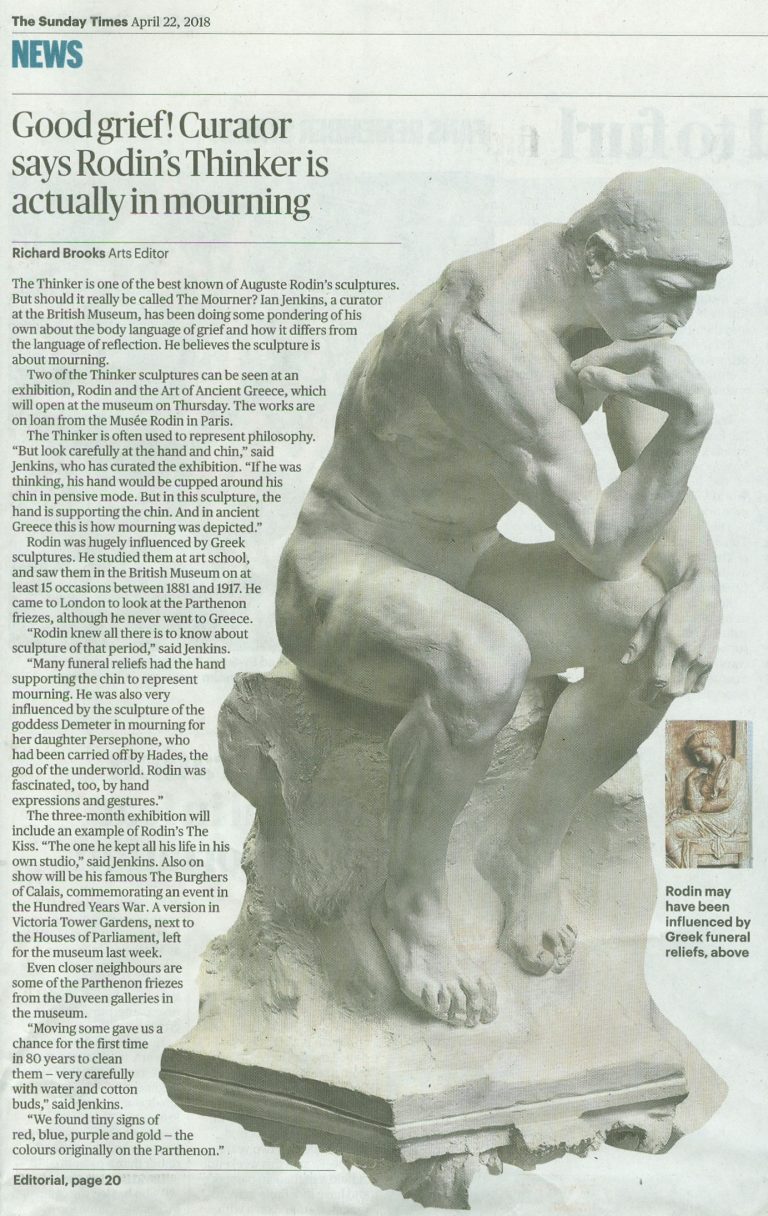
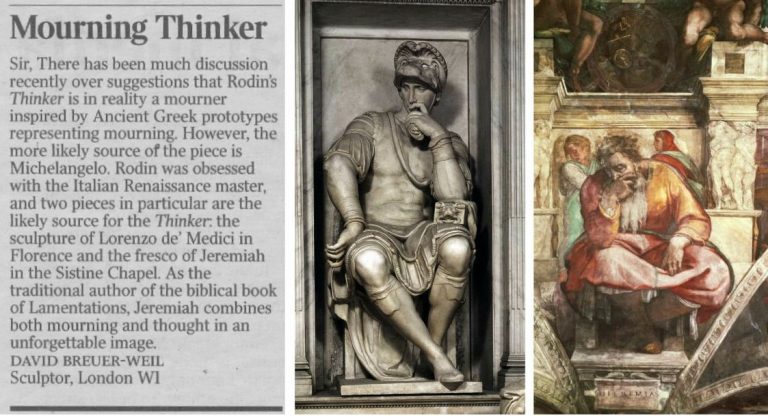



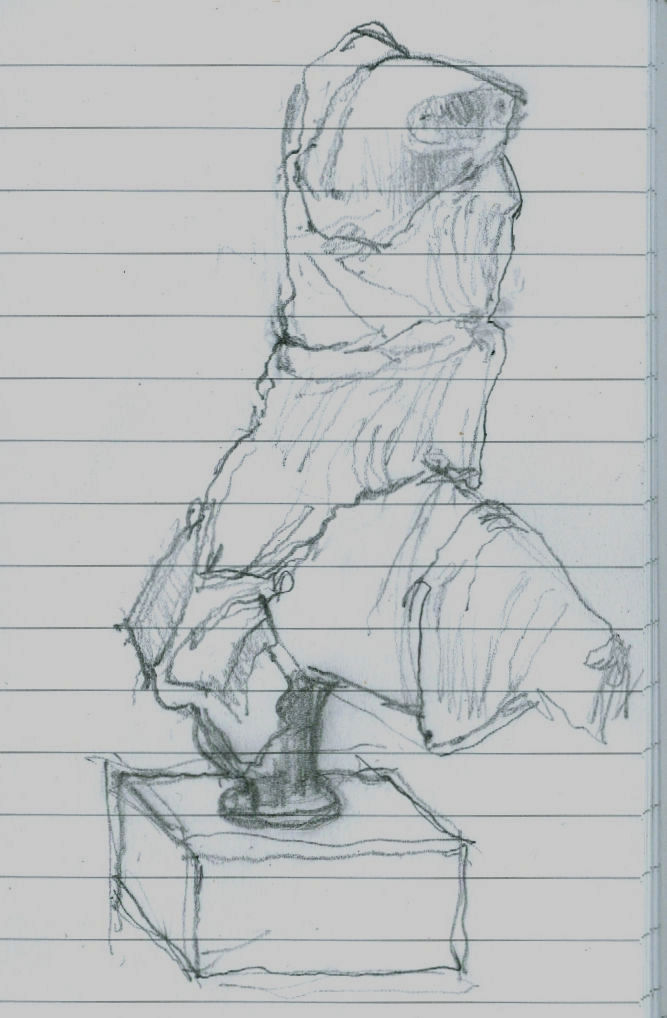
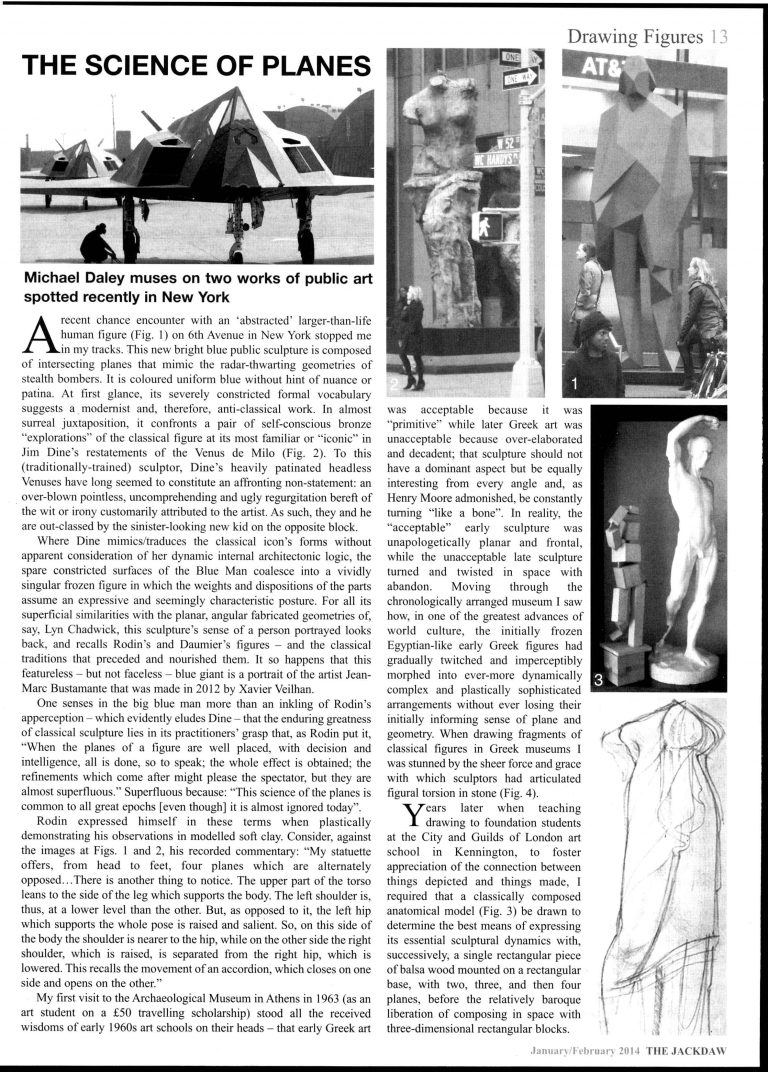
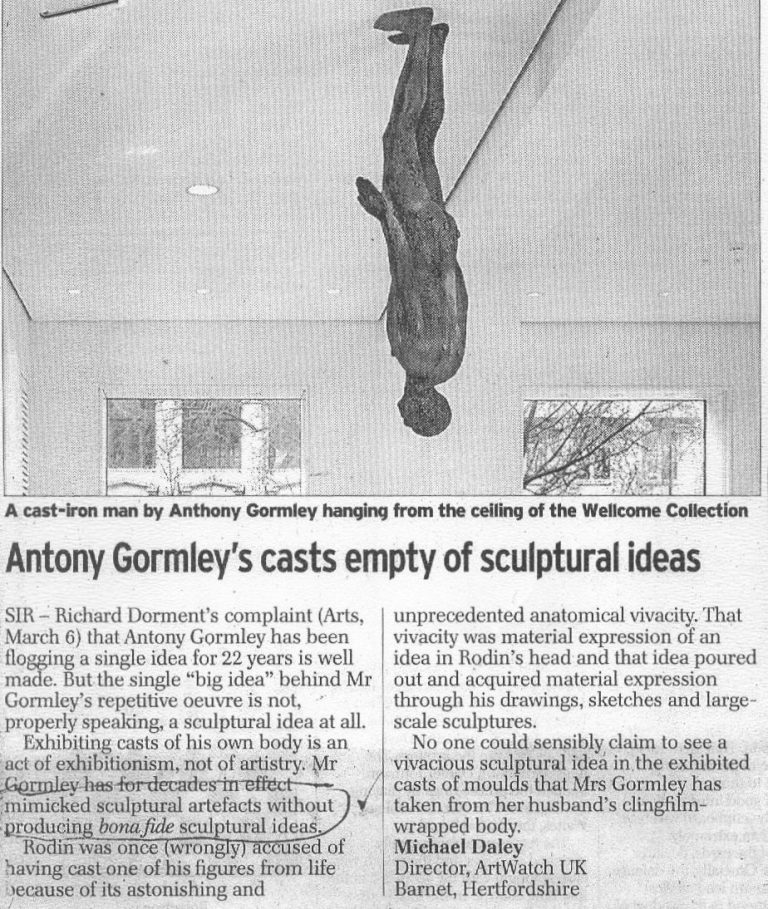


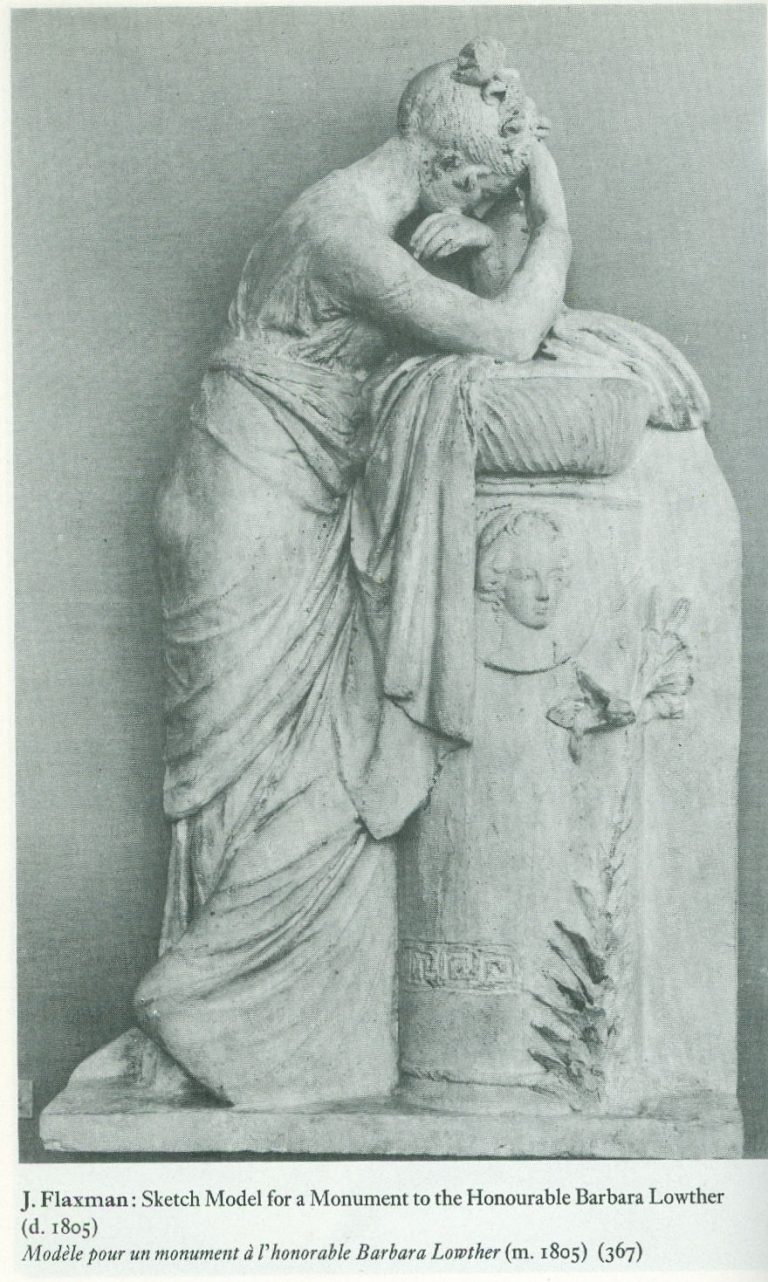
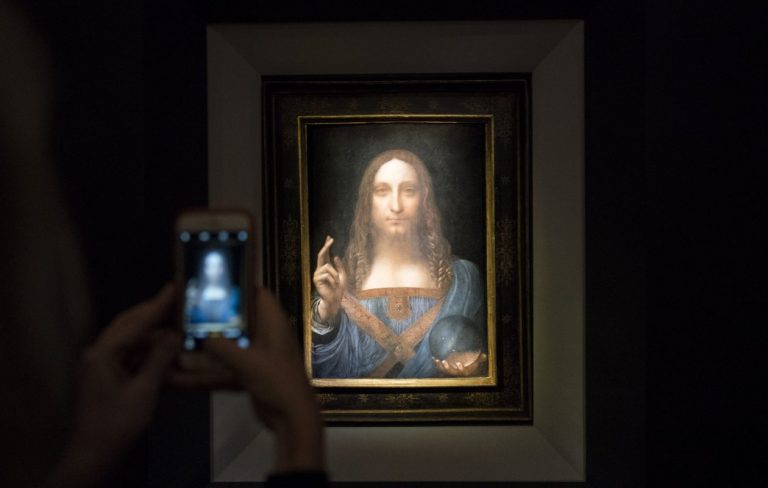


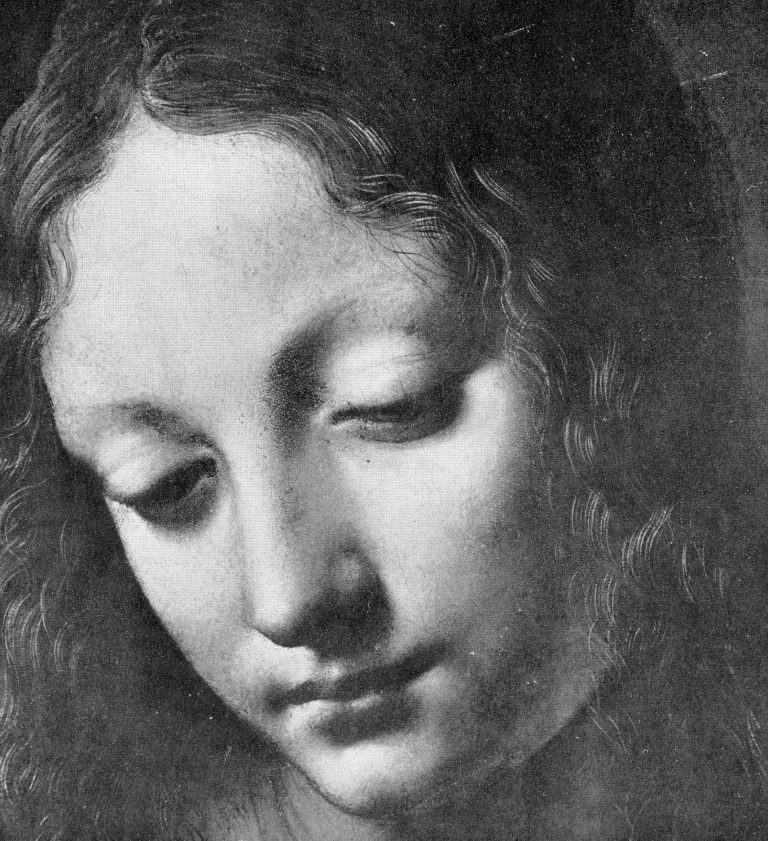
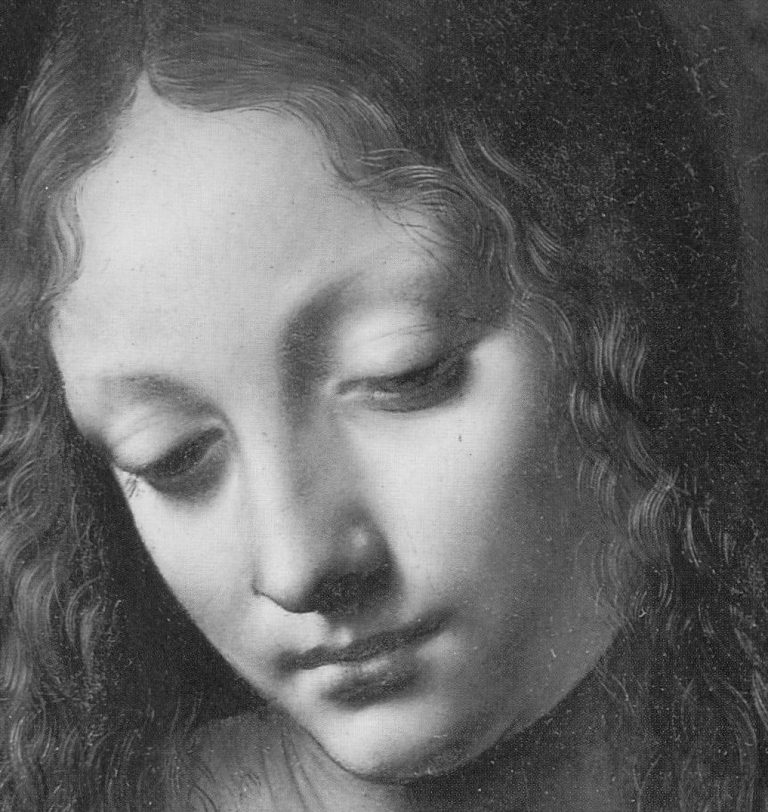

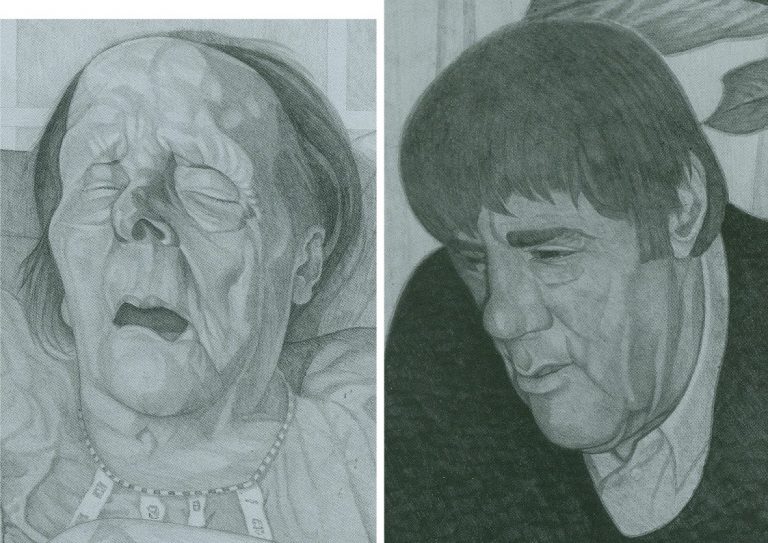
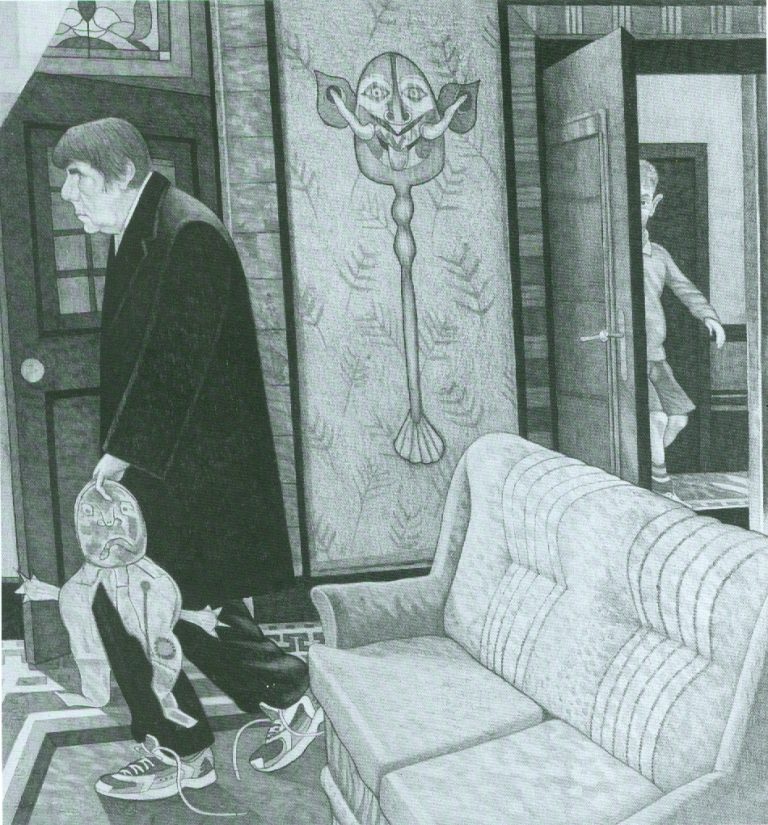
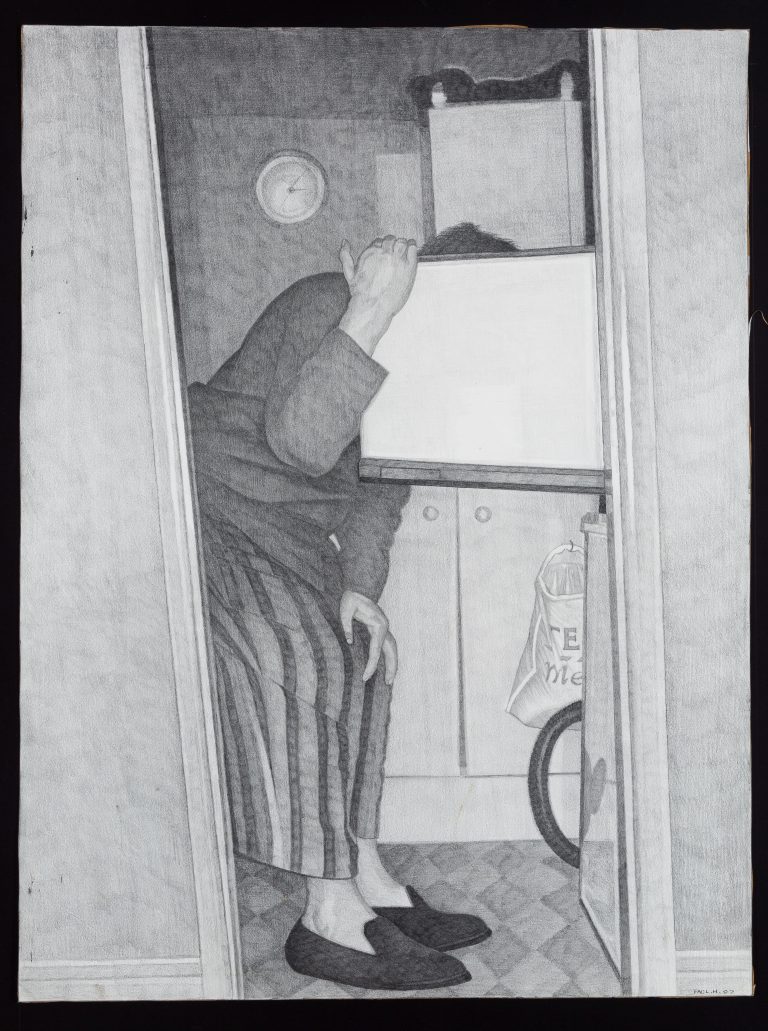


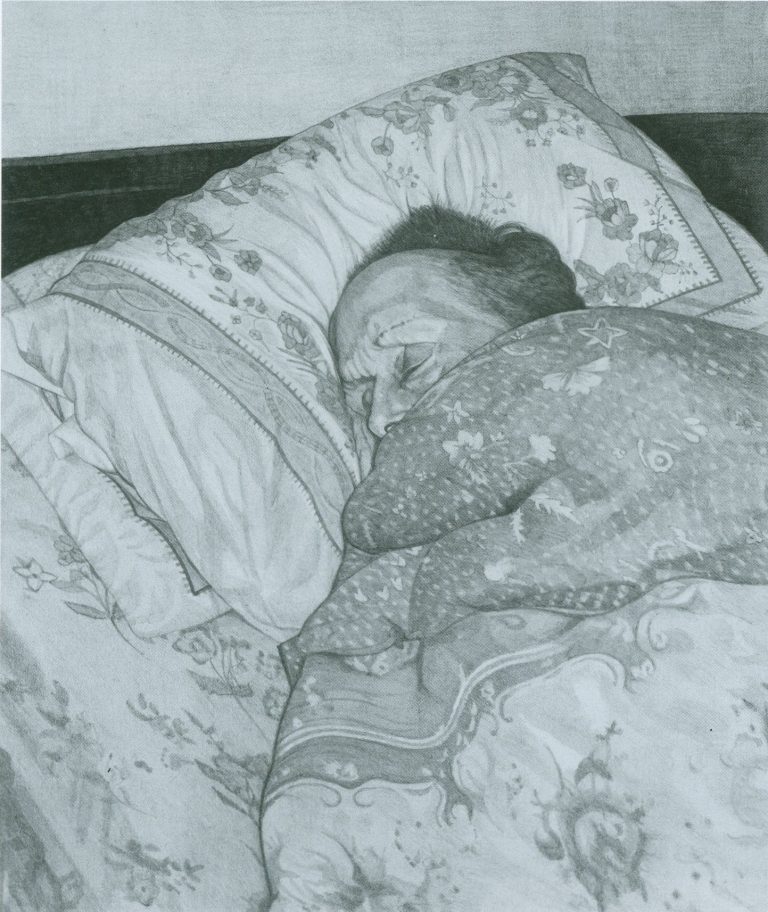

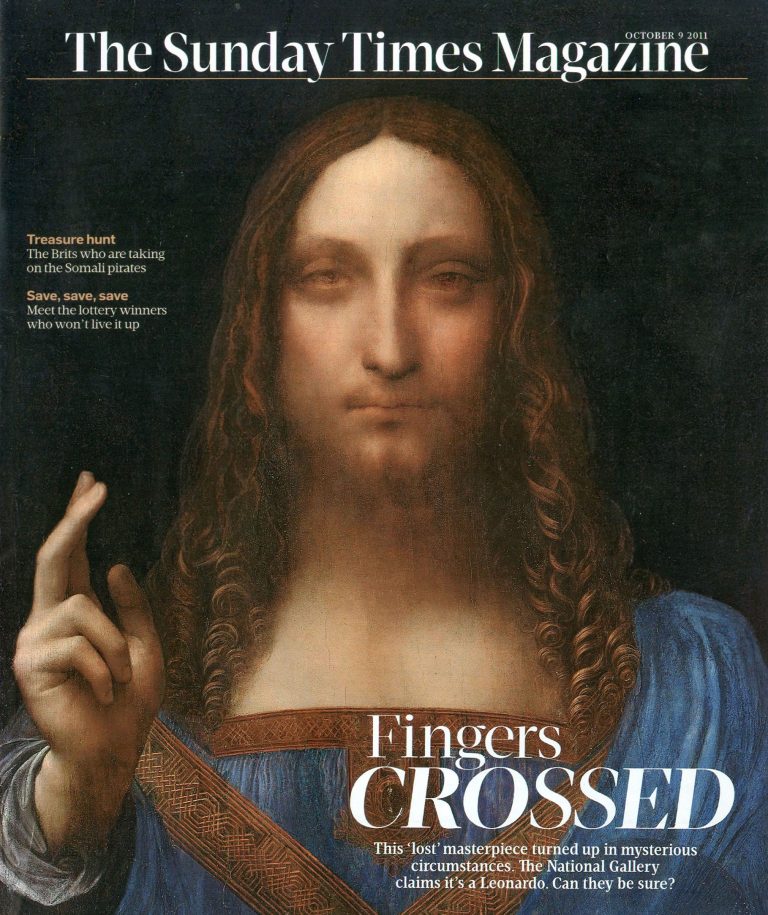
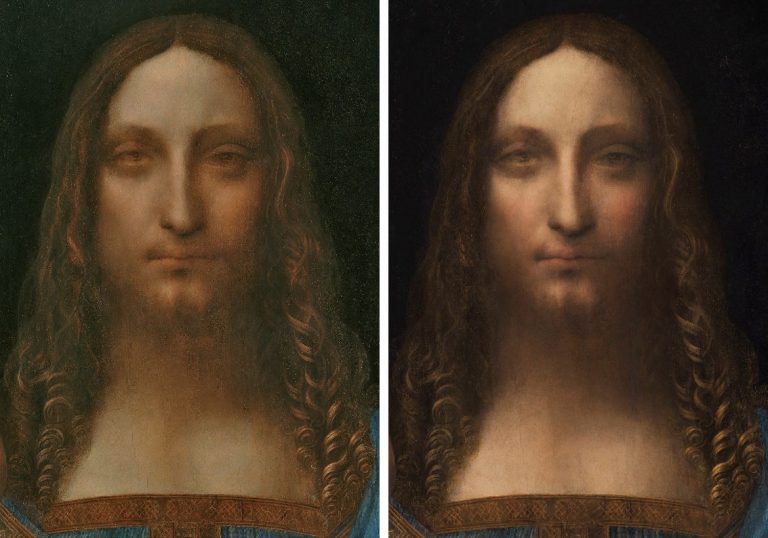


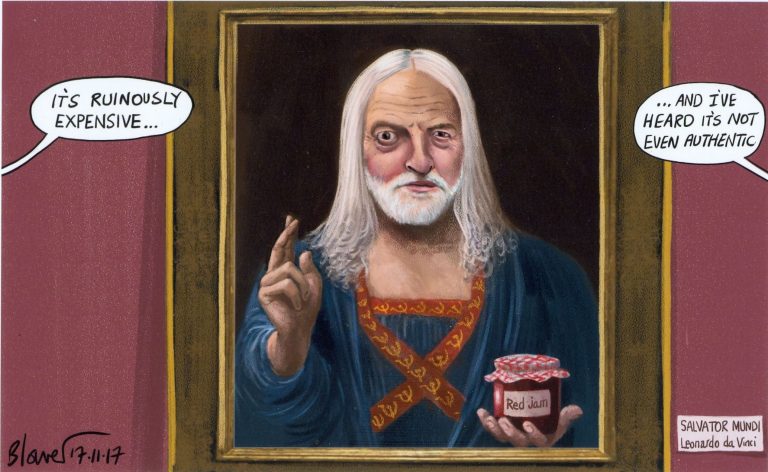


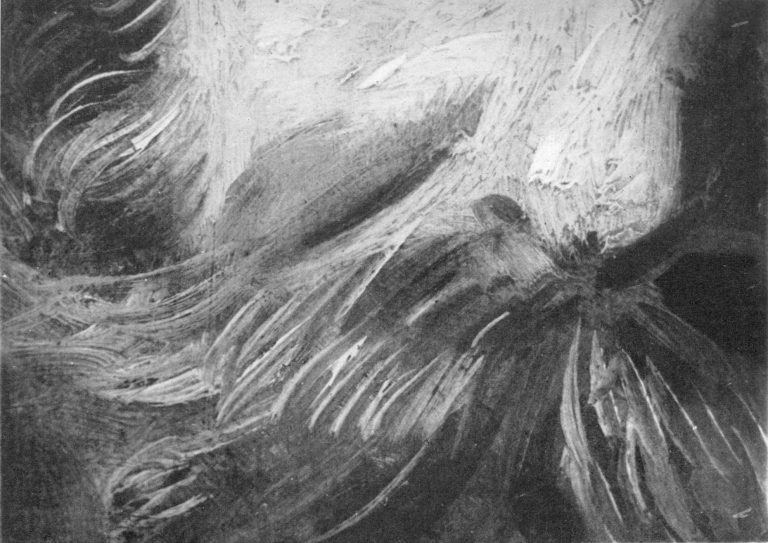

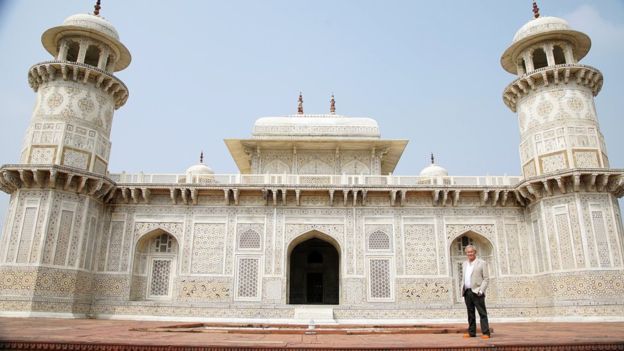
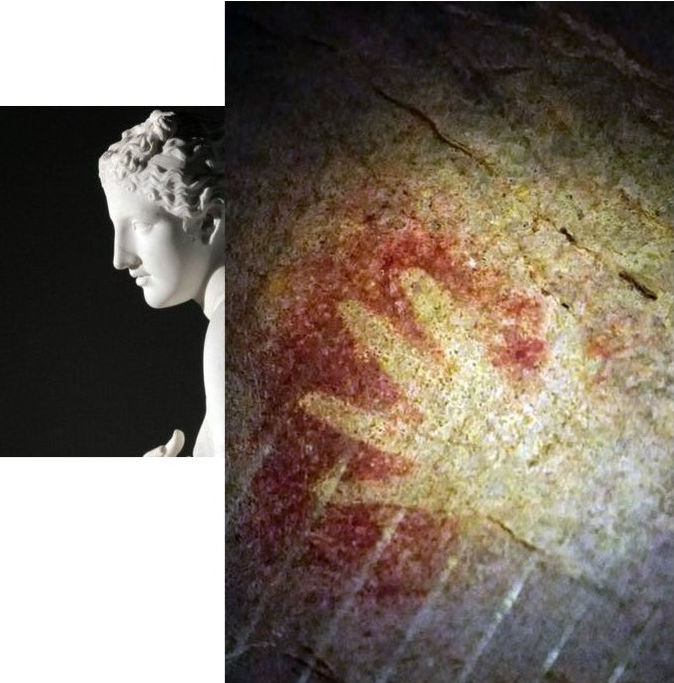
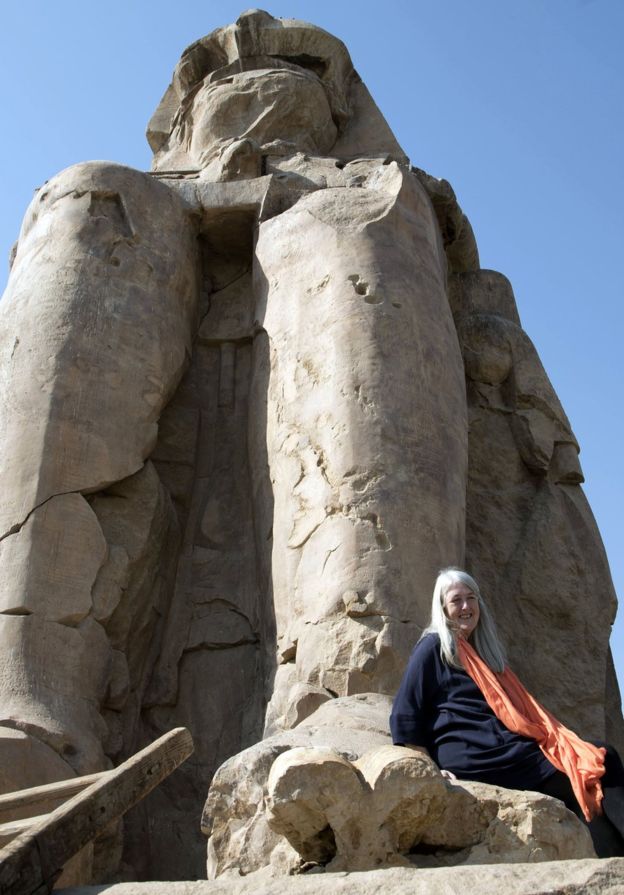
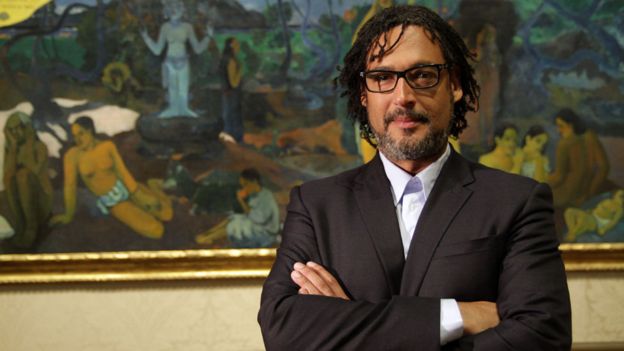
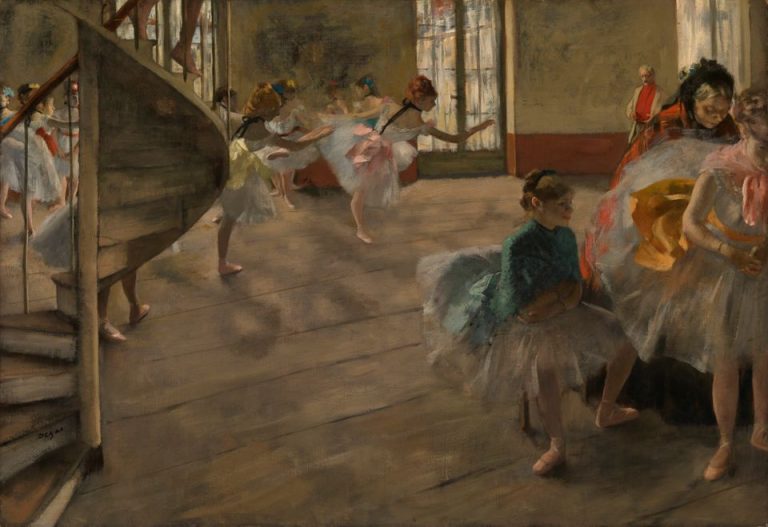

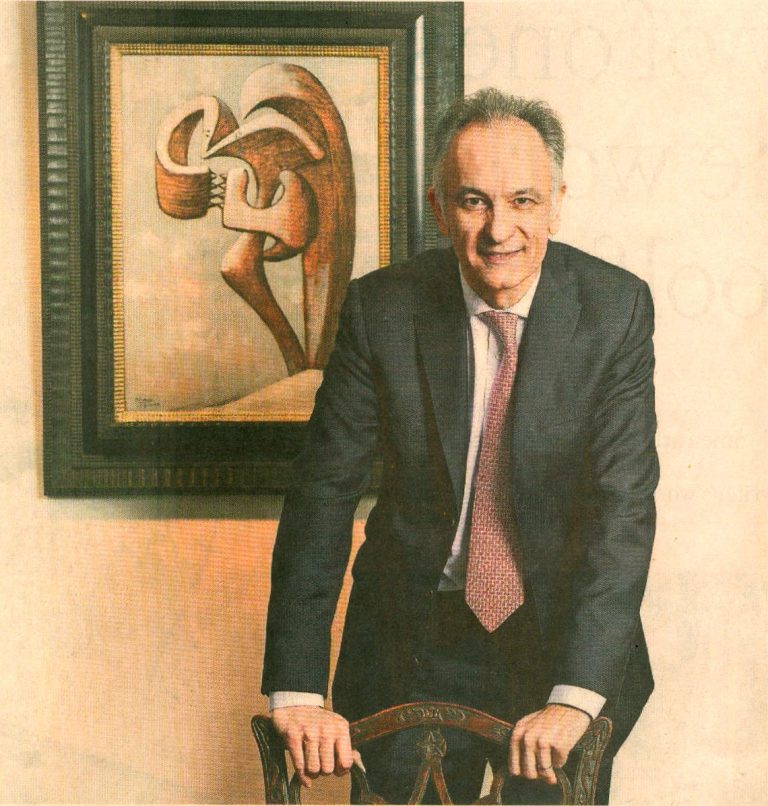
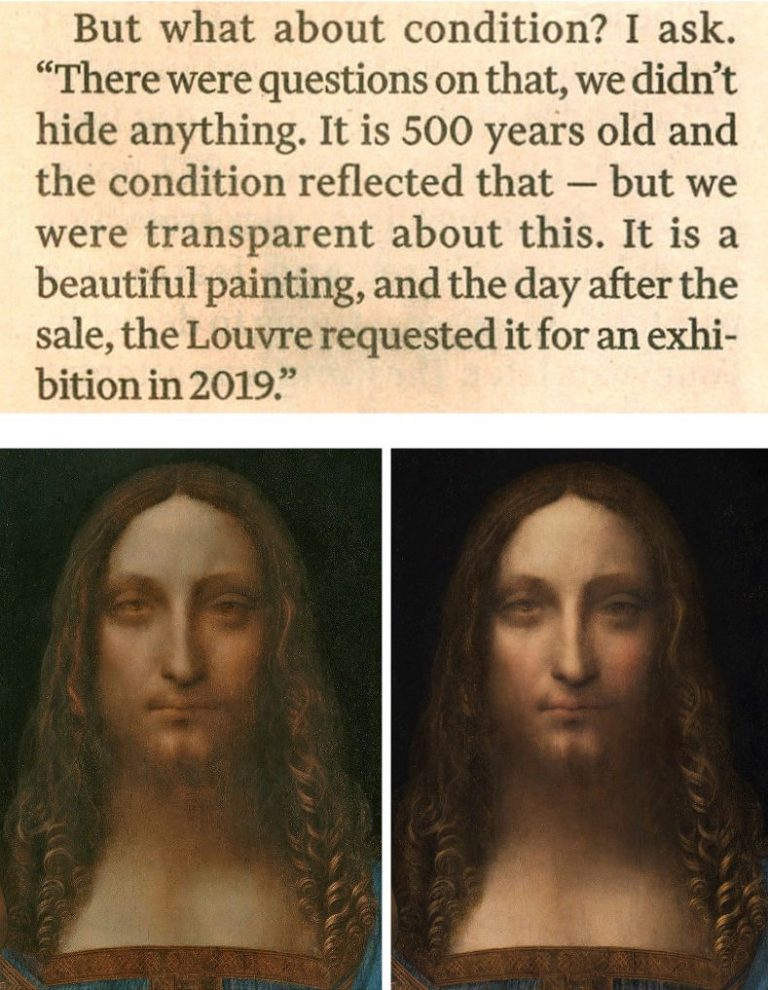
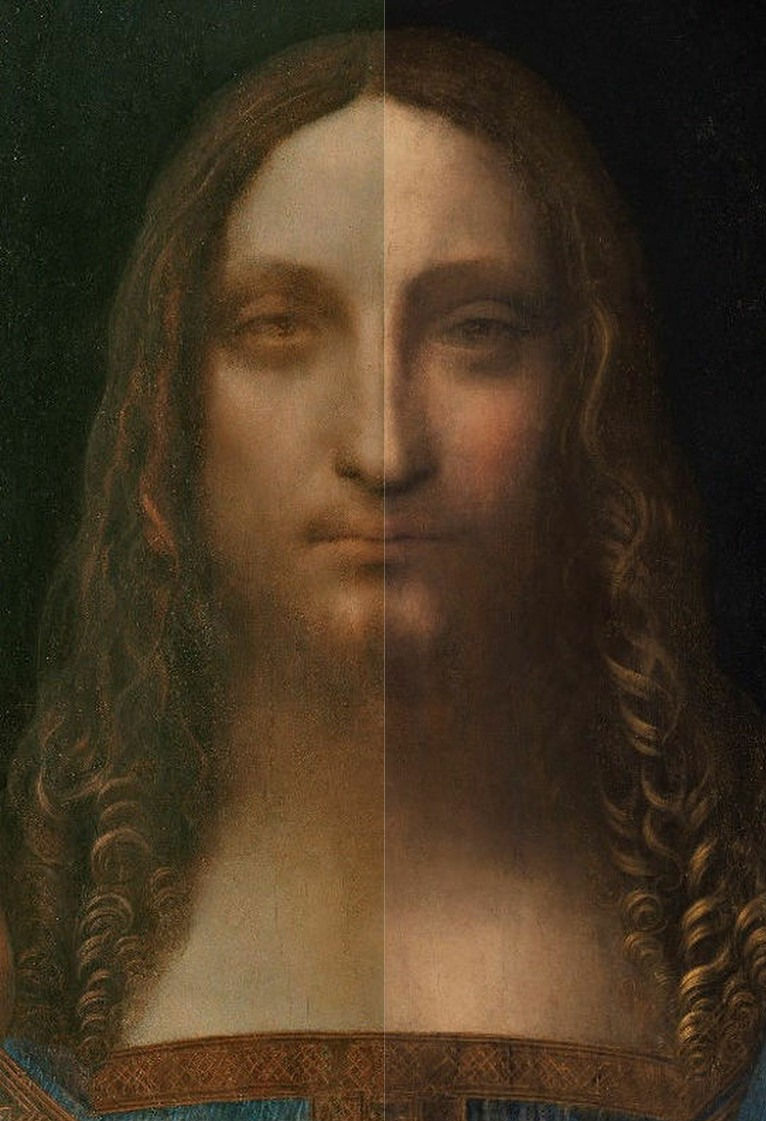
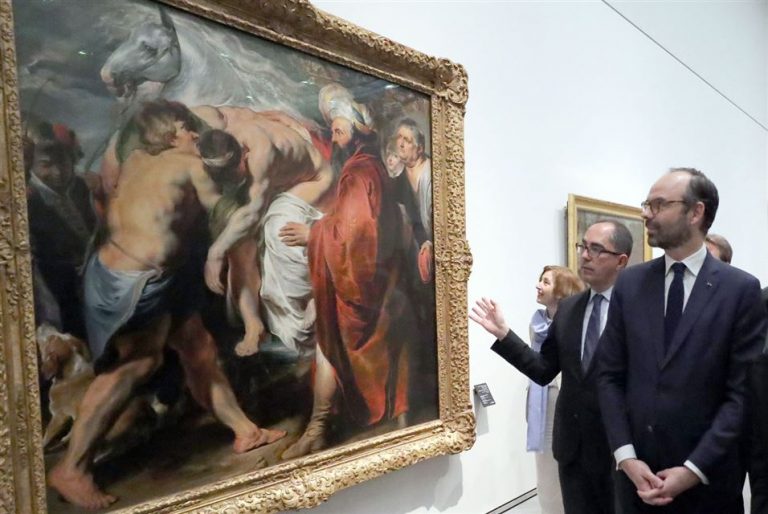



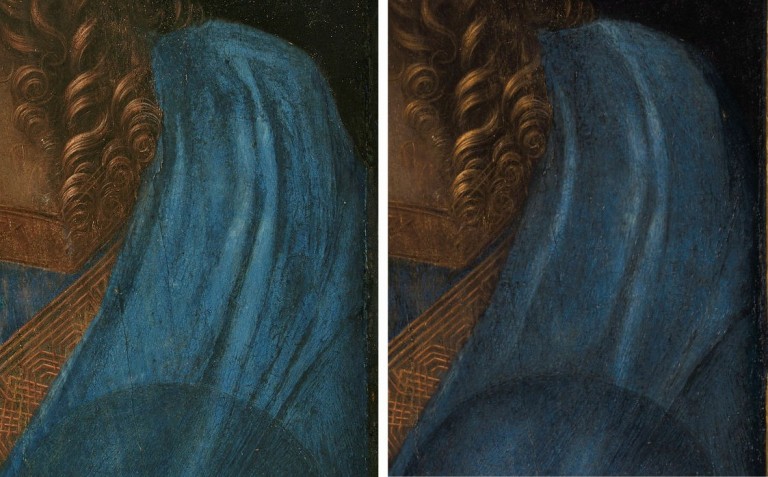
![06 [6] three shoulders (3)](http://artwatch.org.uk/wp-content/uploads/2018/02/06-6-three-shoulders-3-768x388.jpg)
![05 [5] three shoulders (2)](http://artwatch.org.uk/wp-content/uploads/2018/02/05-5-three-shoulders-2-768x322.jpg)
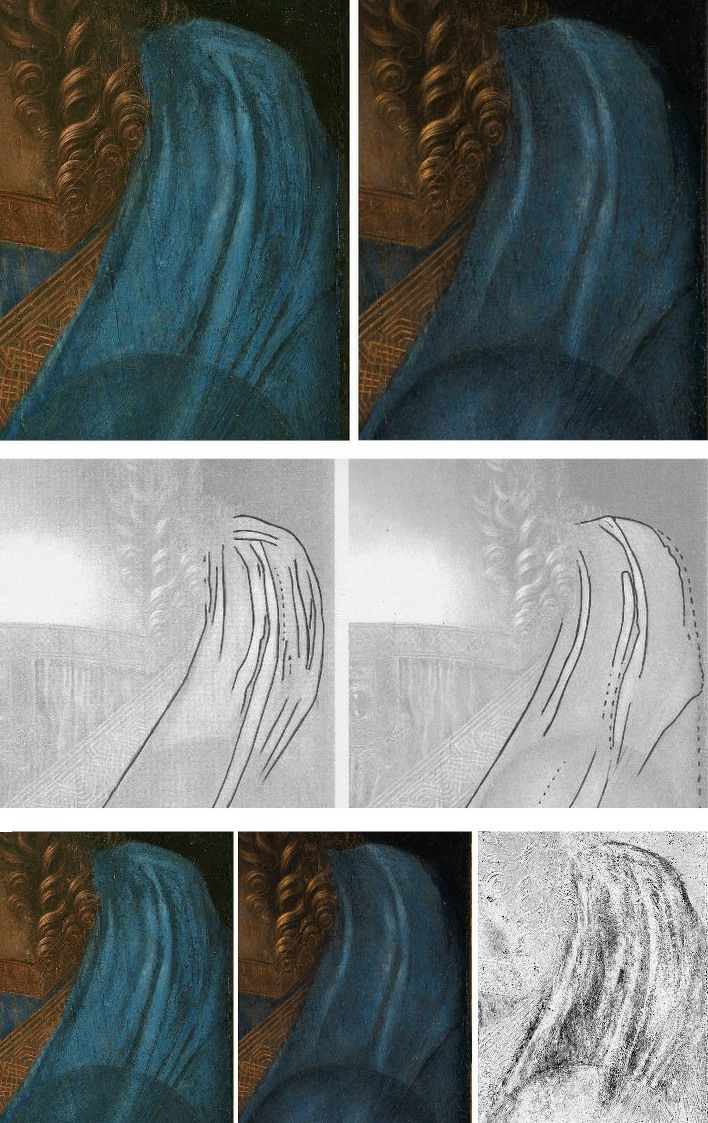

![08 [7] first london outing](http://artwatch.org.uk/wp-content/uploads/2018/02/08-7-first-london-outing-768x1086.jpg)

![010 [8] nose jobs](http://artwatch.org.uk/wp-content/uploads/2018/02/010-8-nose-jobs-768x571.jpg)
![11 [9] zzNew Fig. 2](http://artwatch.org.uk/wp-content/uploads/2018/02/11-9-zzNew-Fig.-2-768x1086.jpg)
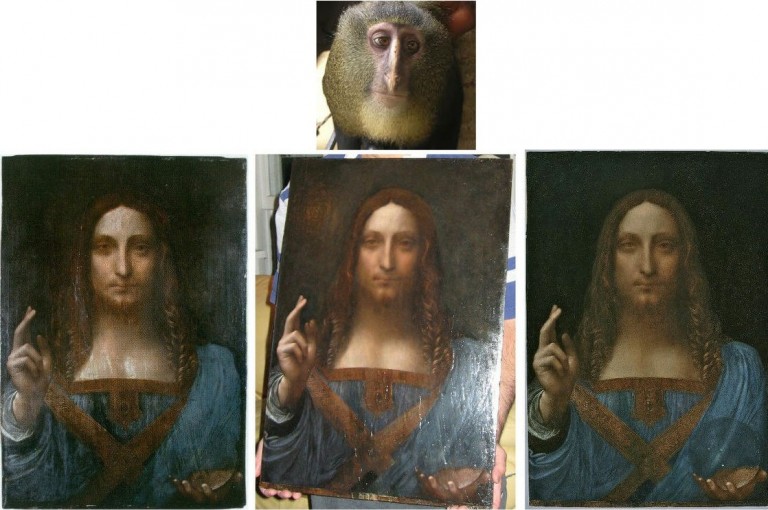
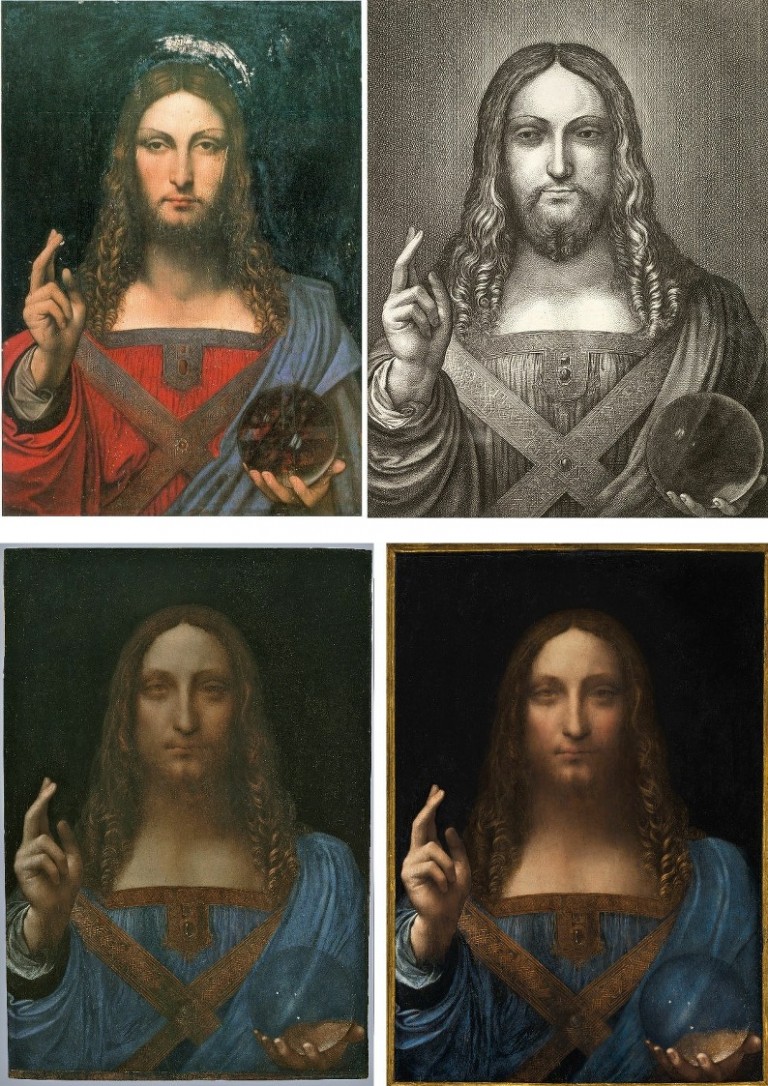
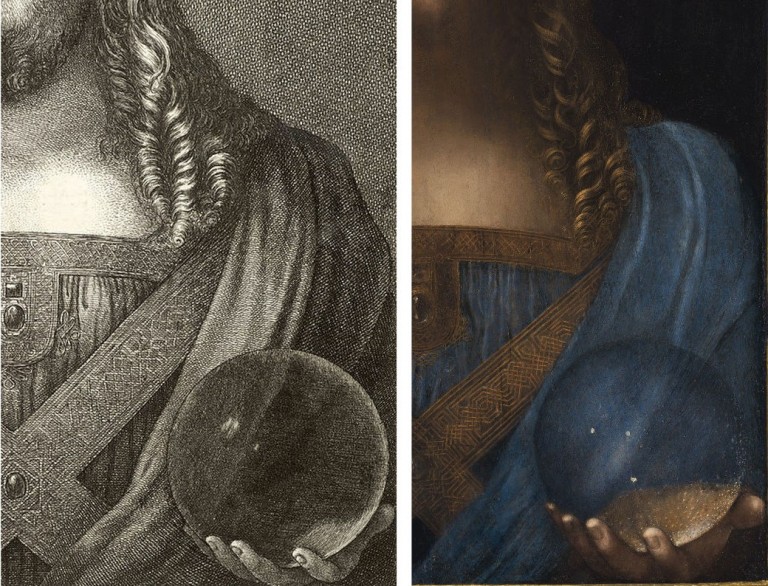
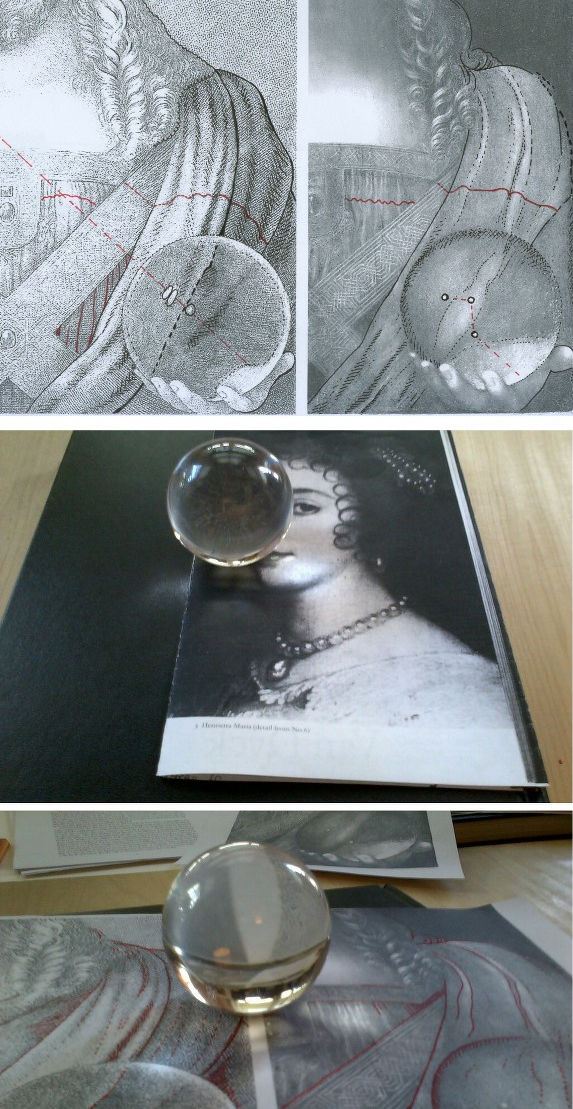

![017 [10] split](http://artwatch.org.uk/wp-content/uploads/2018/02/017-10-split-700x1024.jpg)
